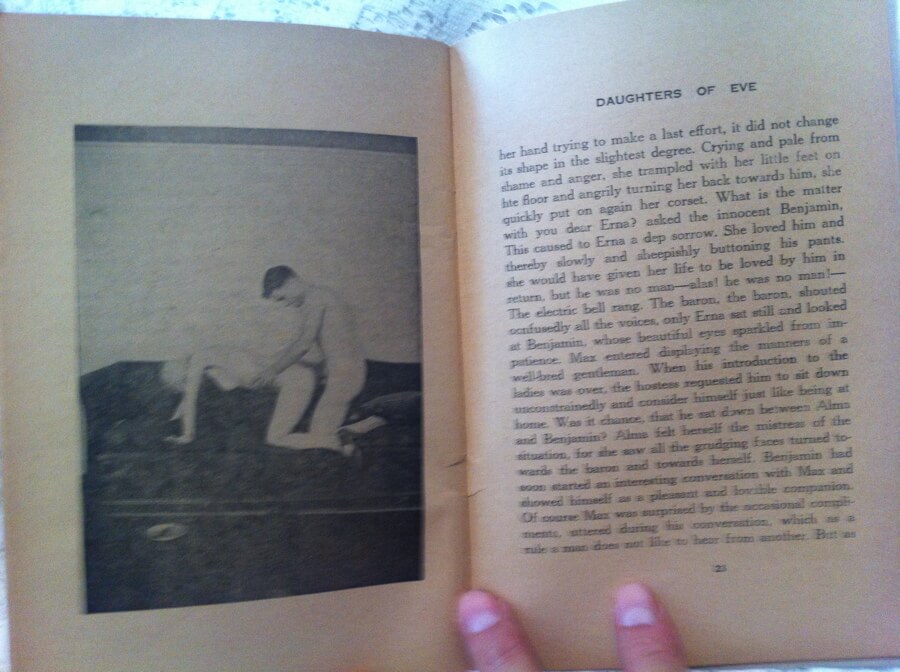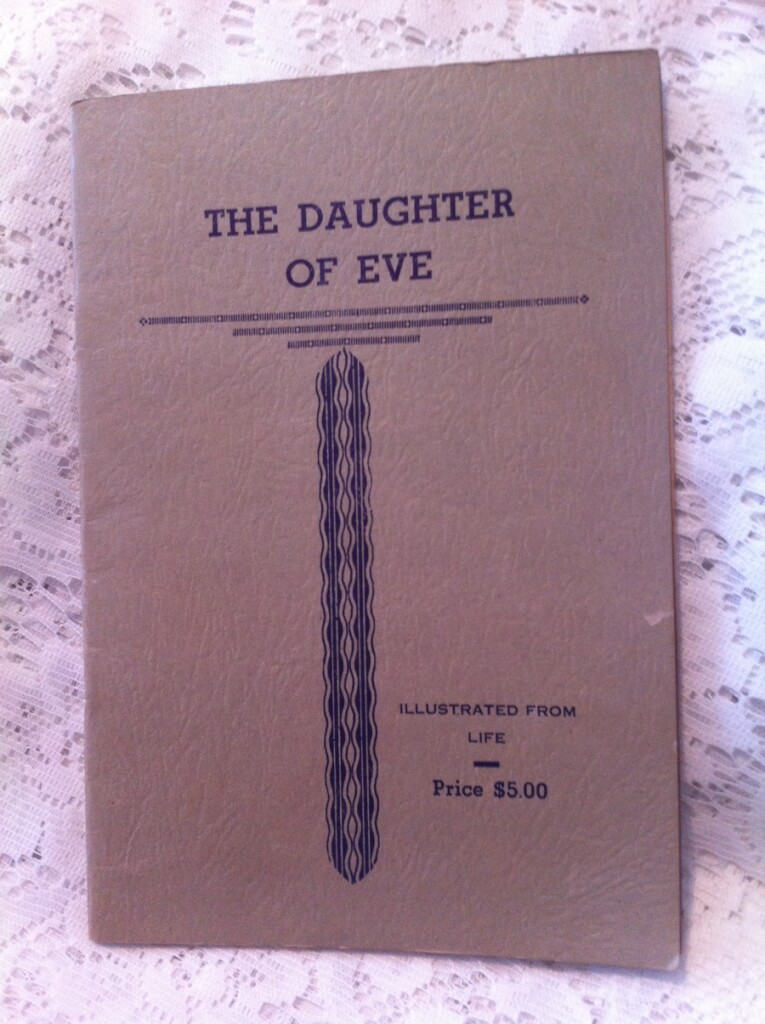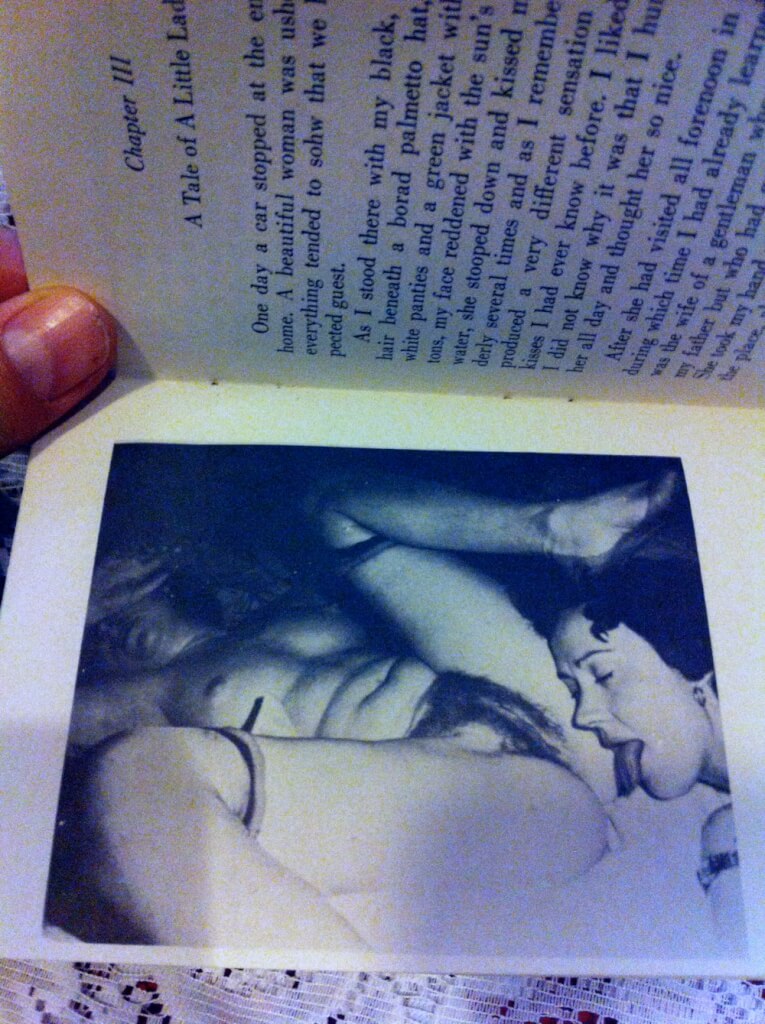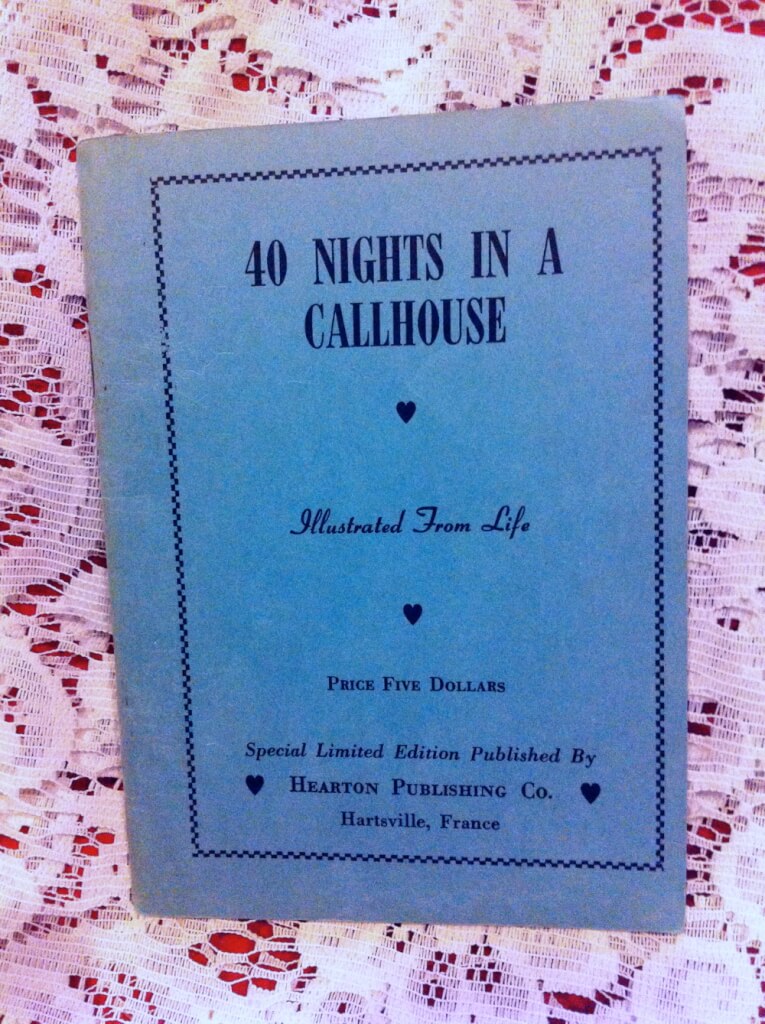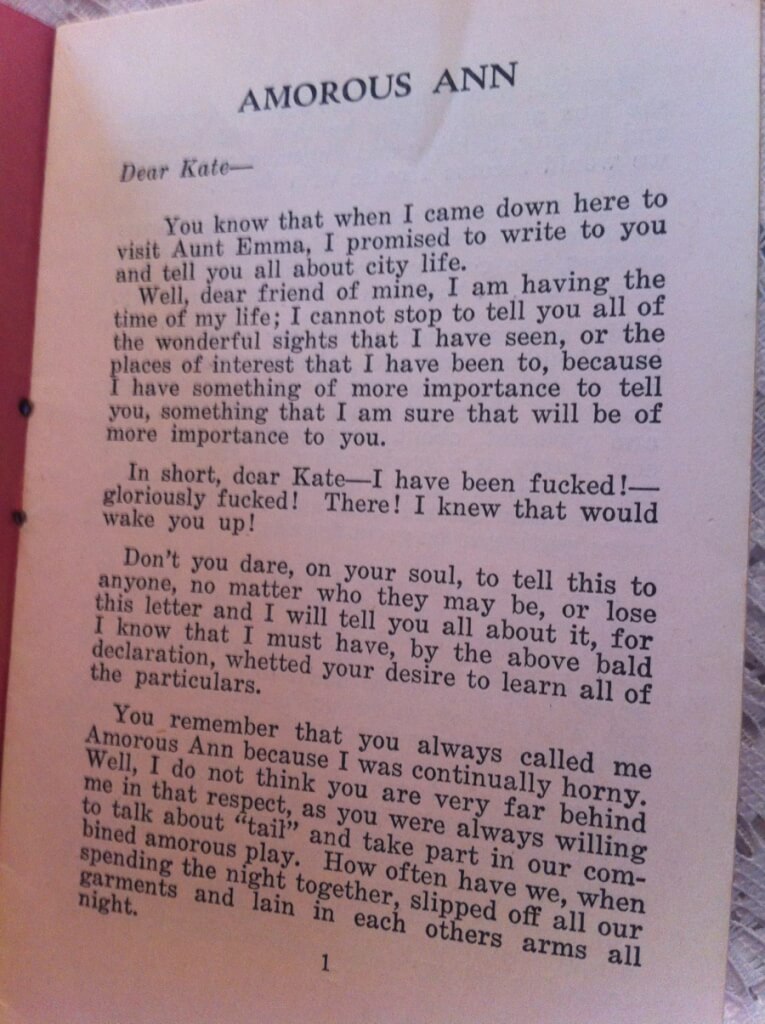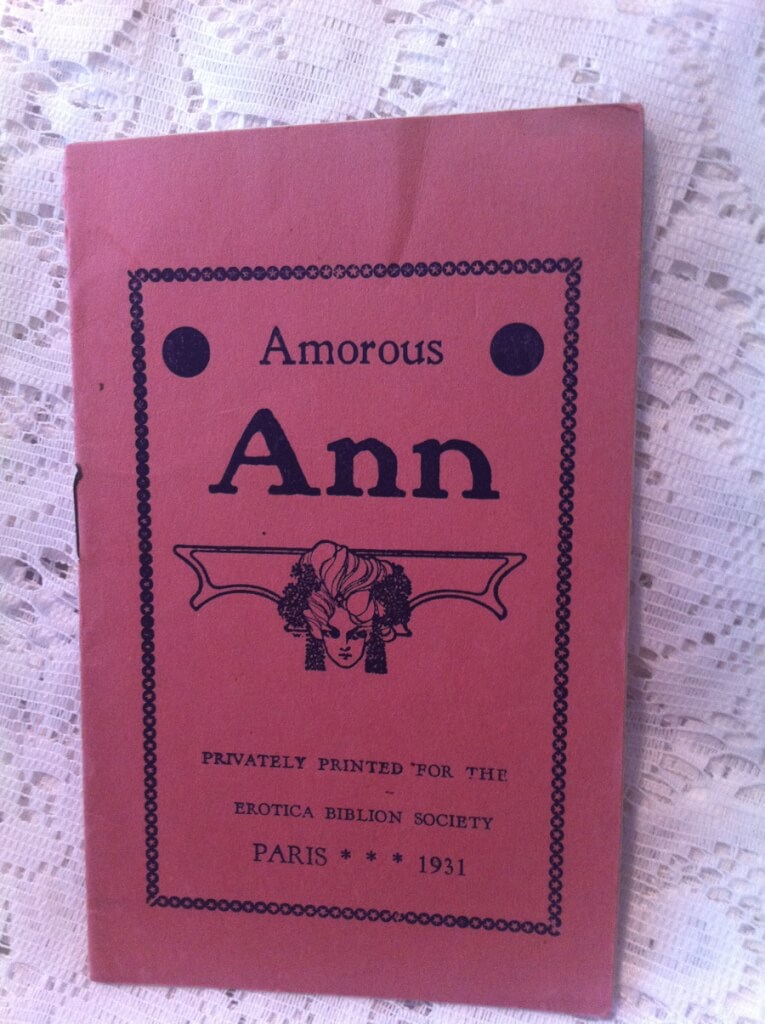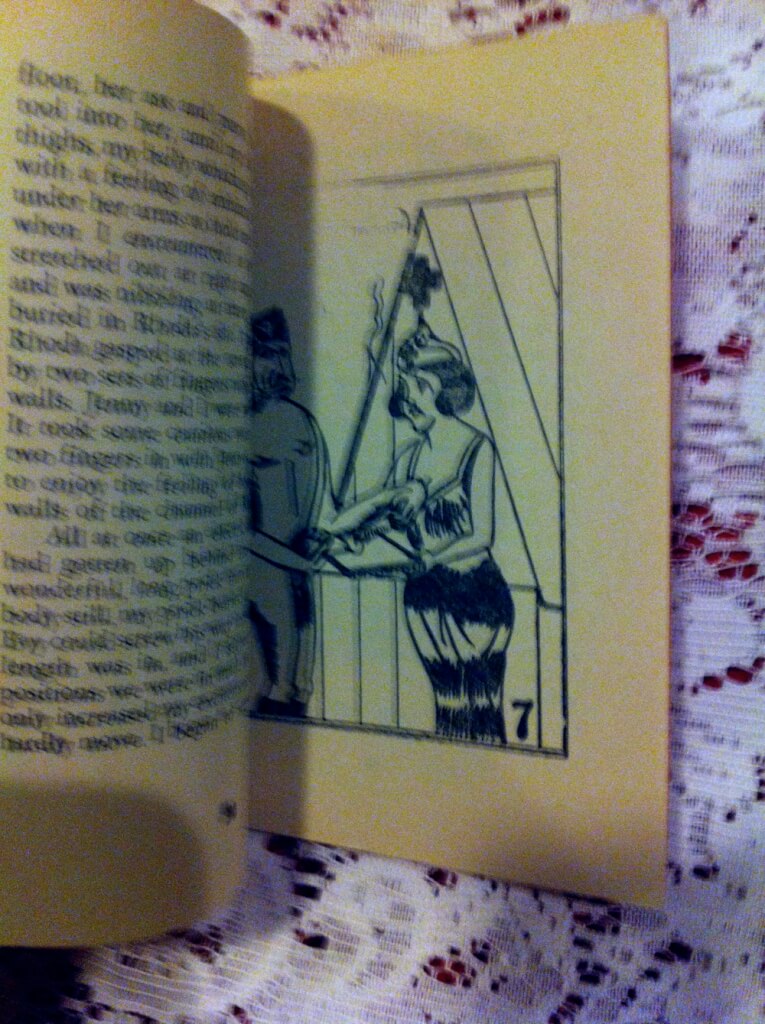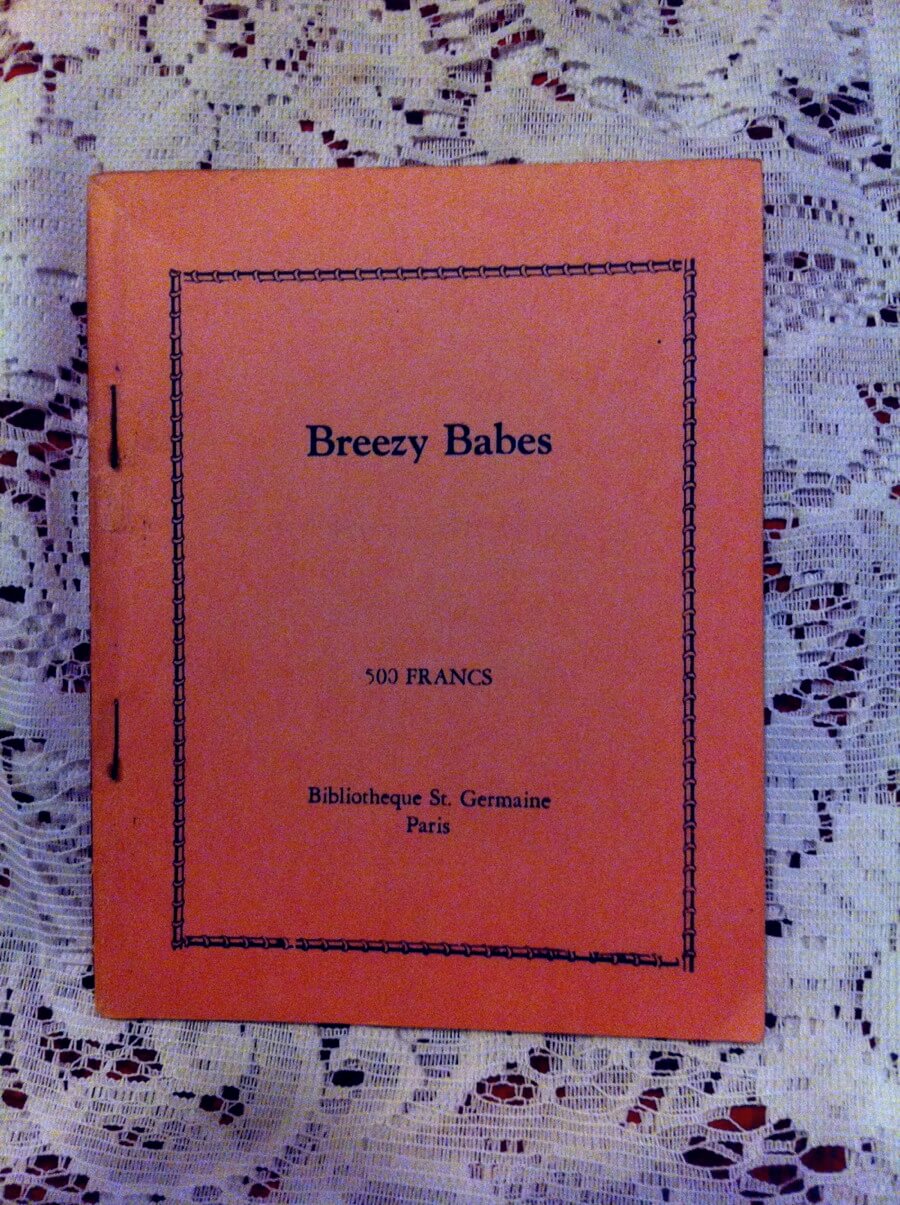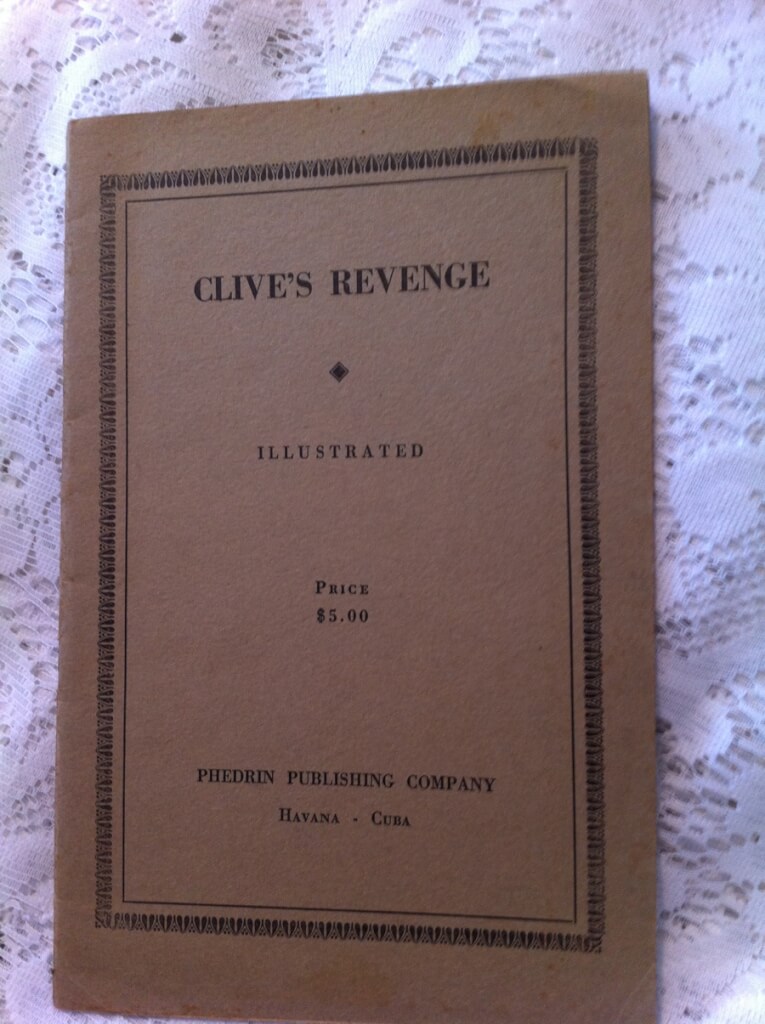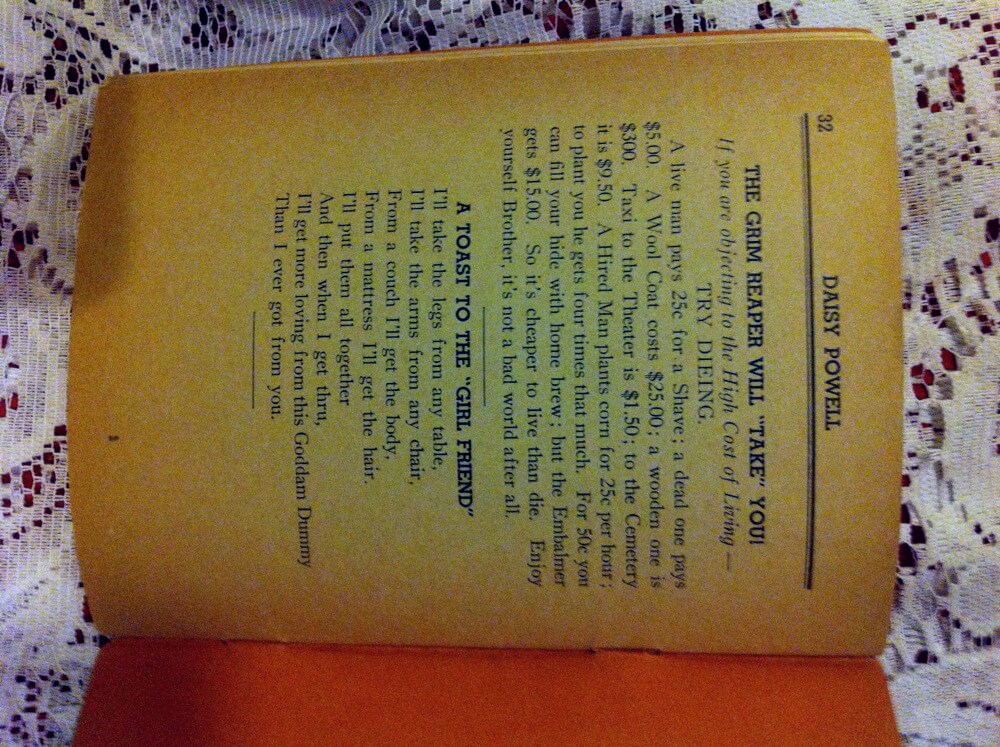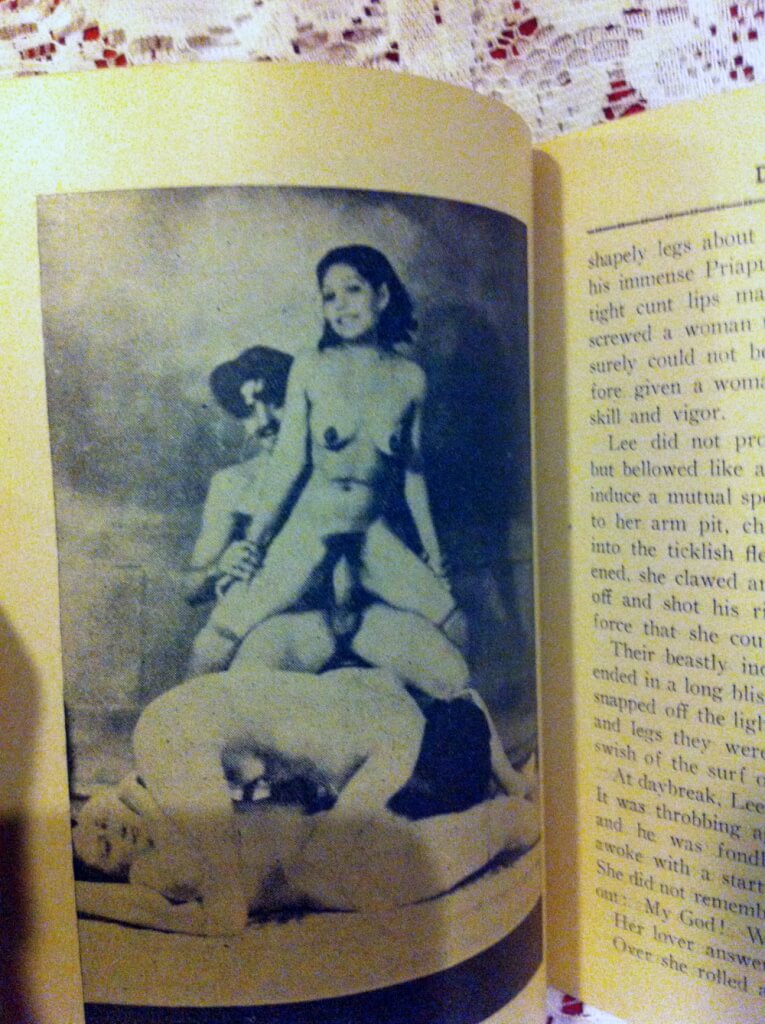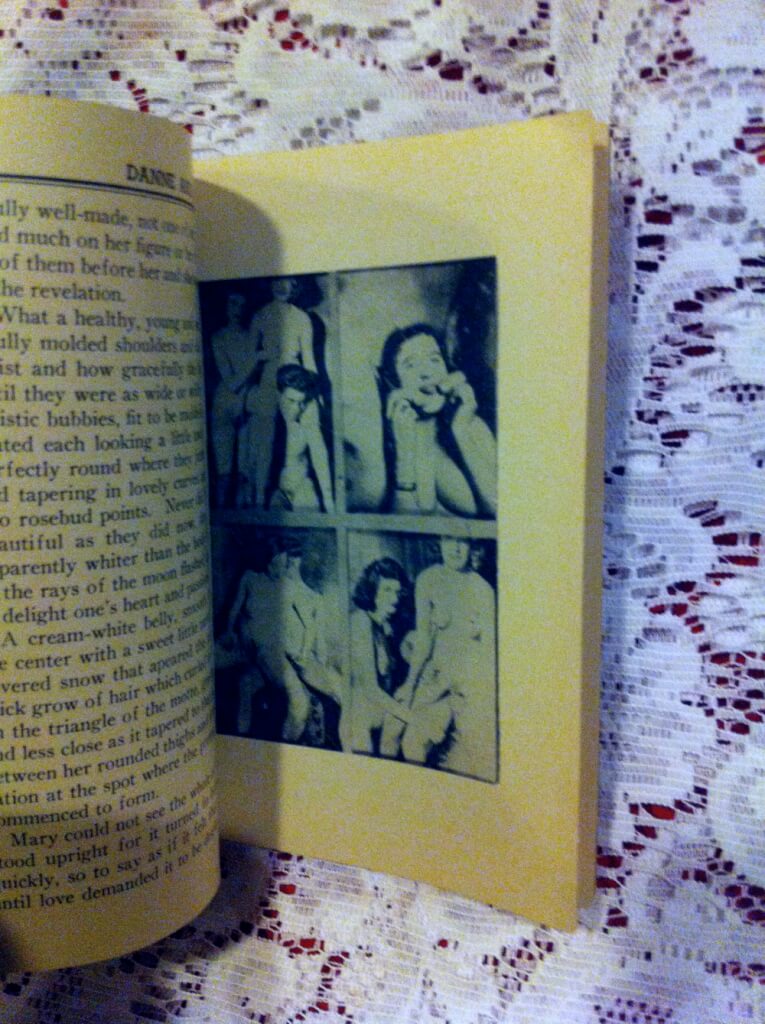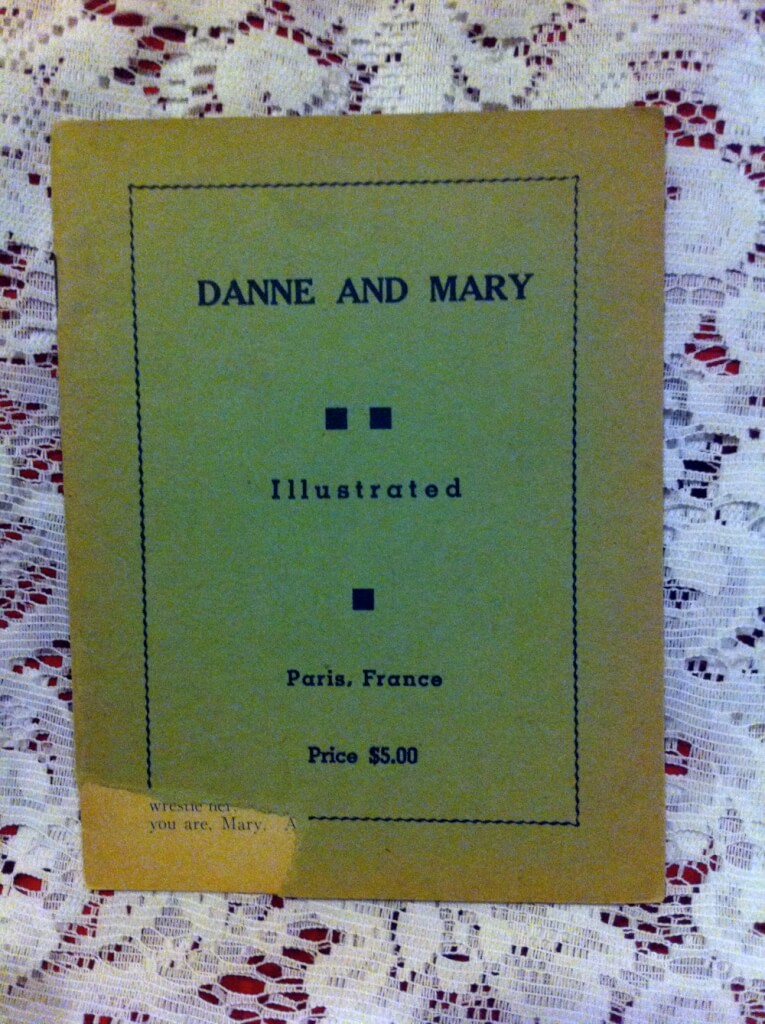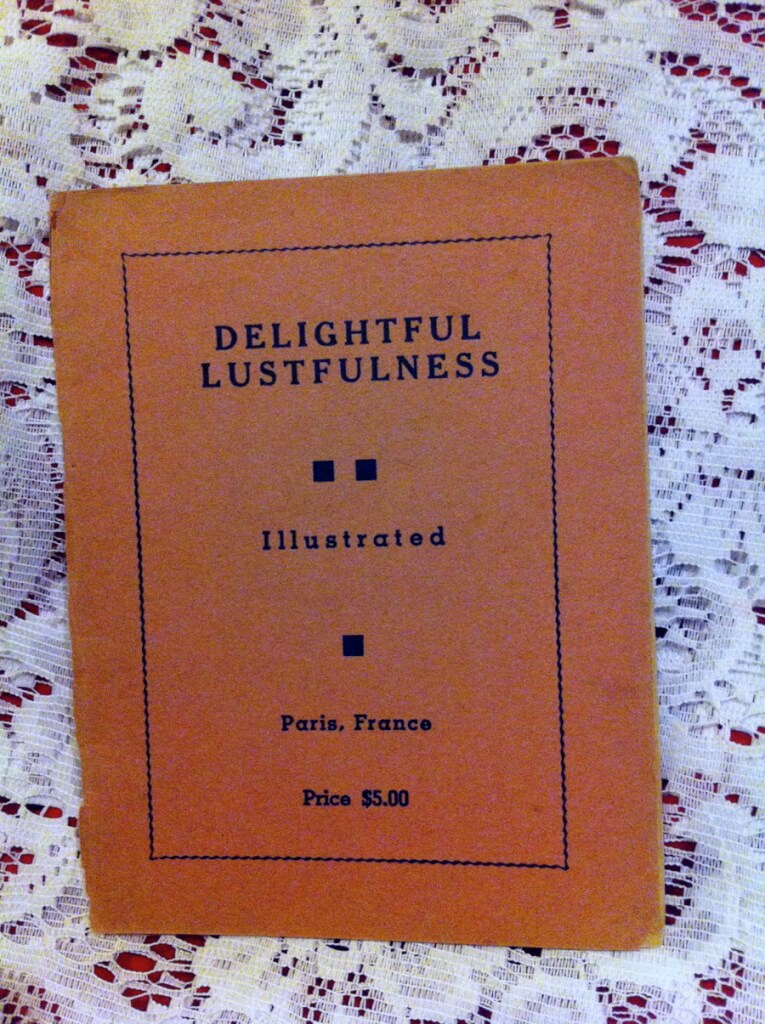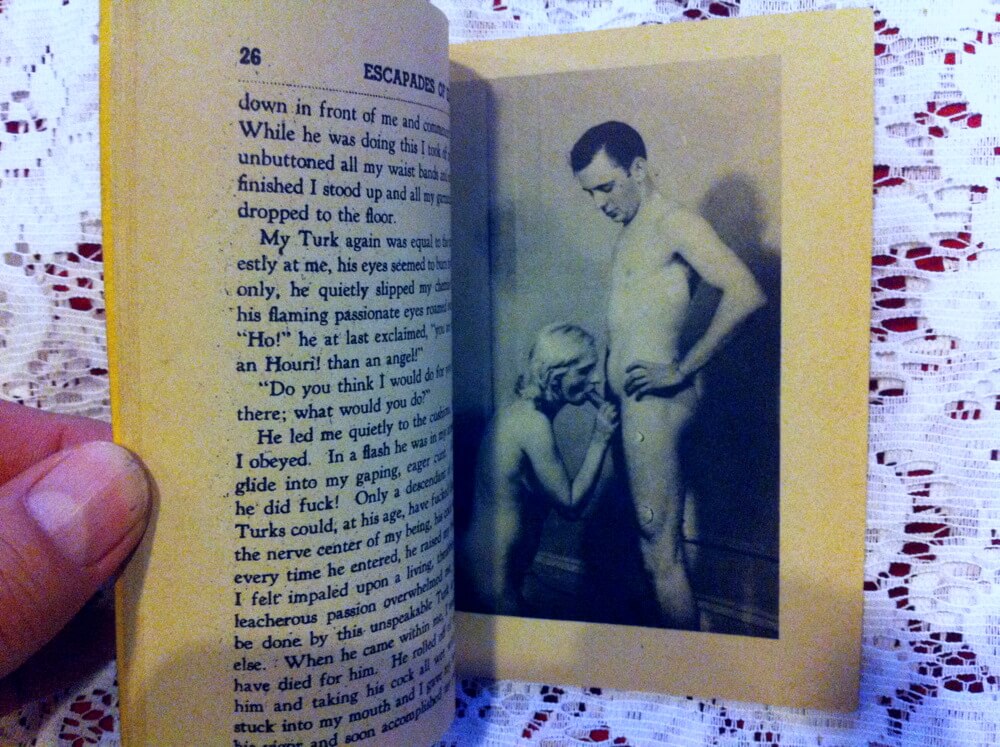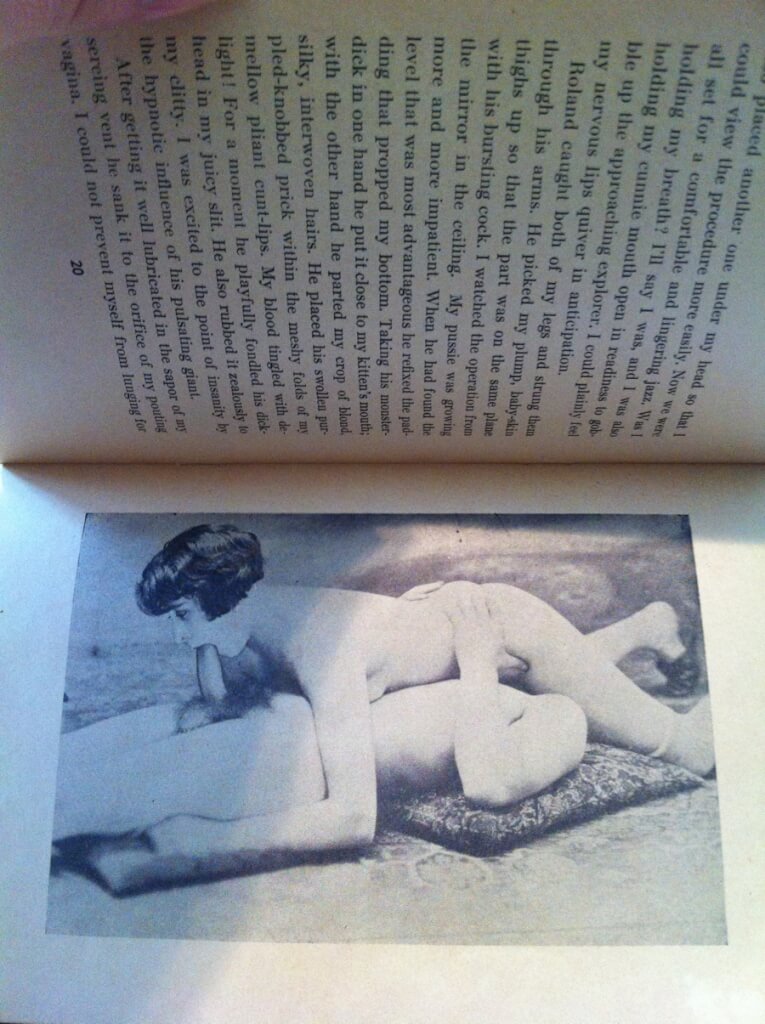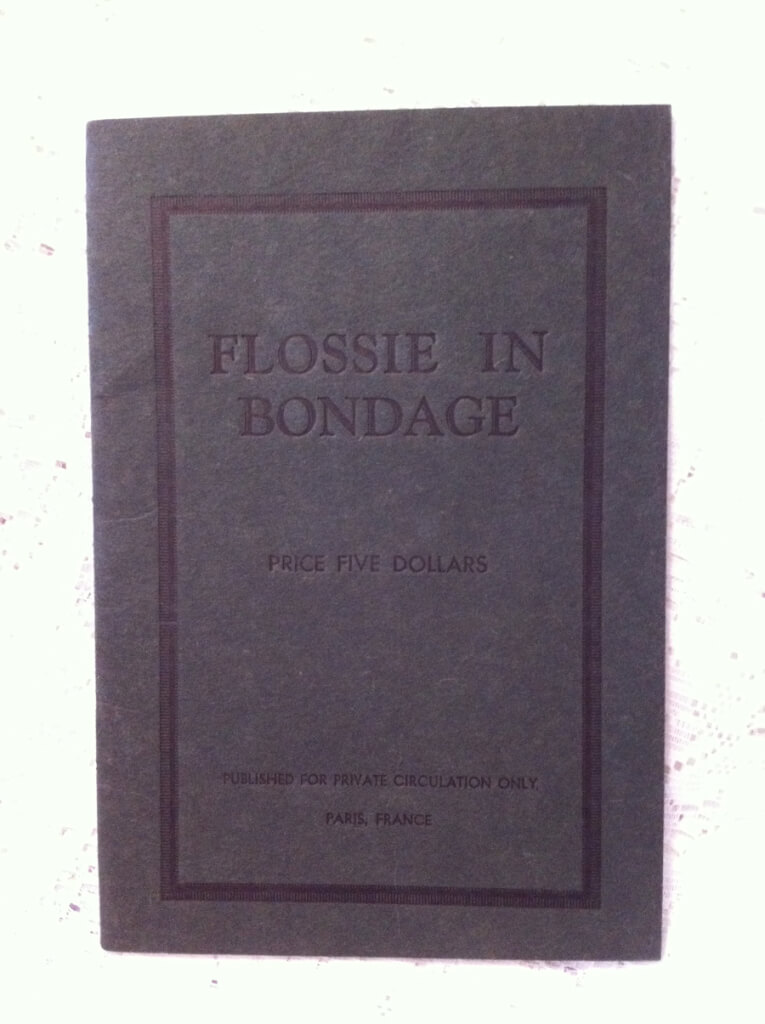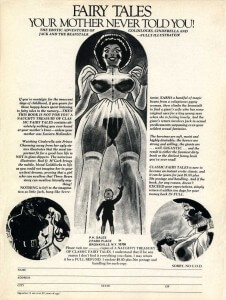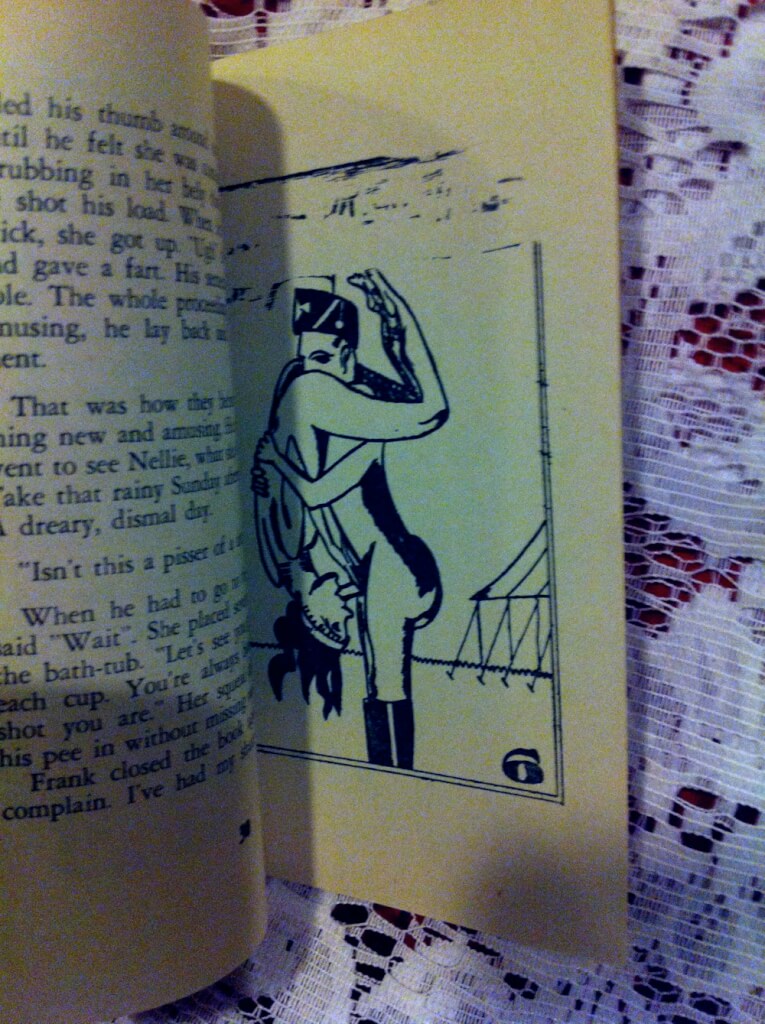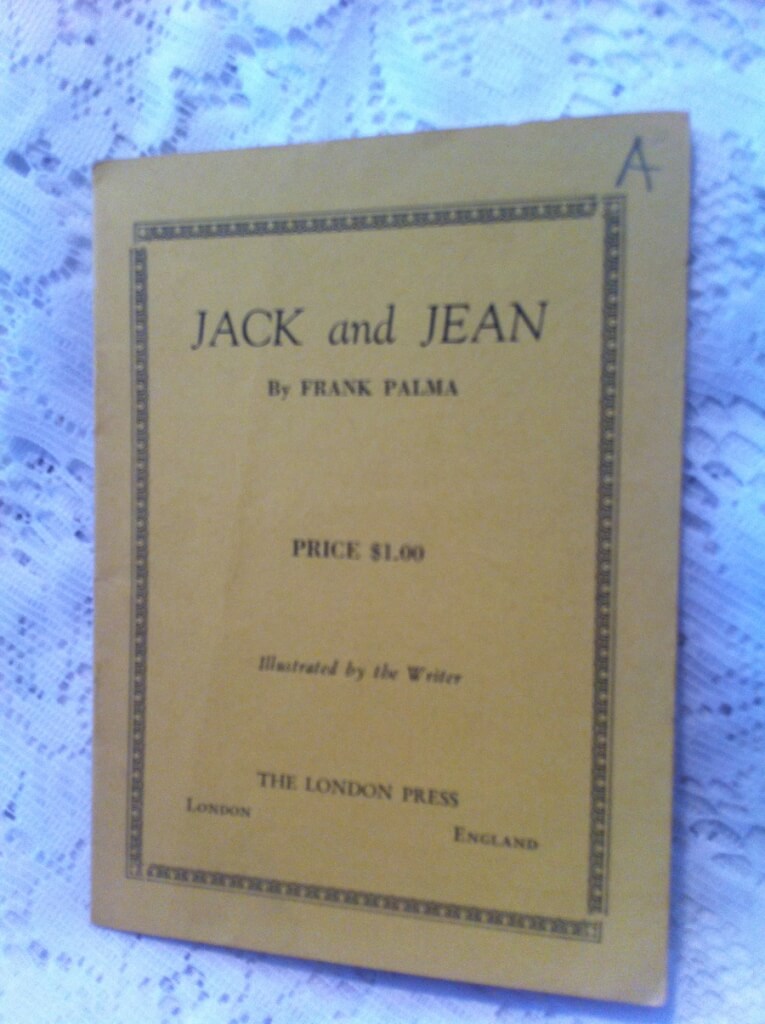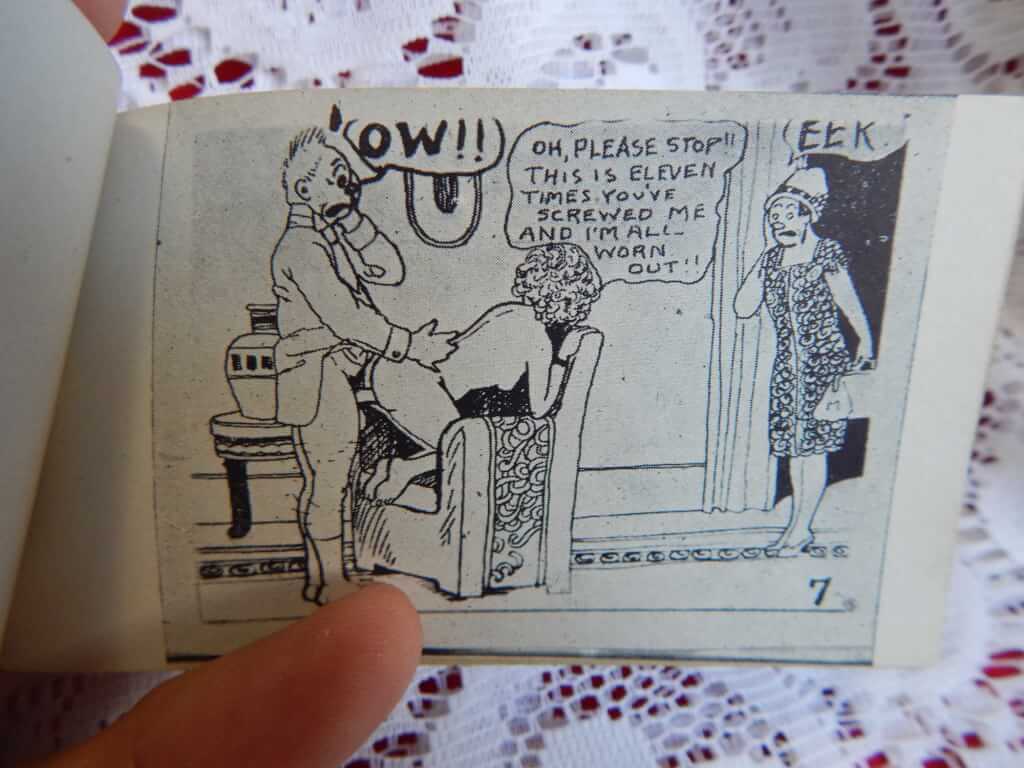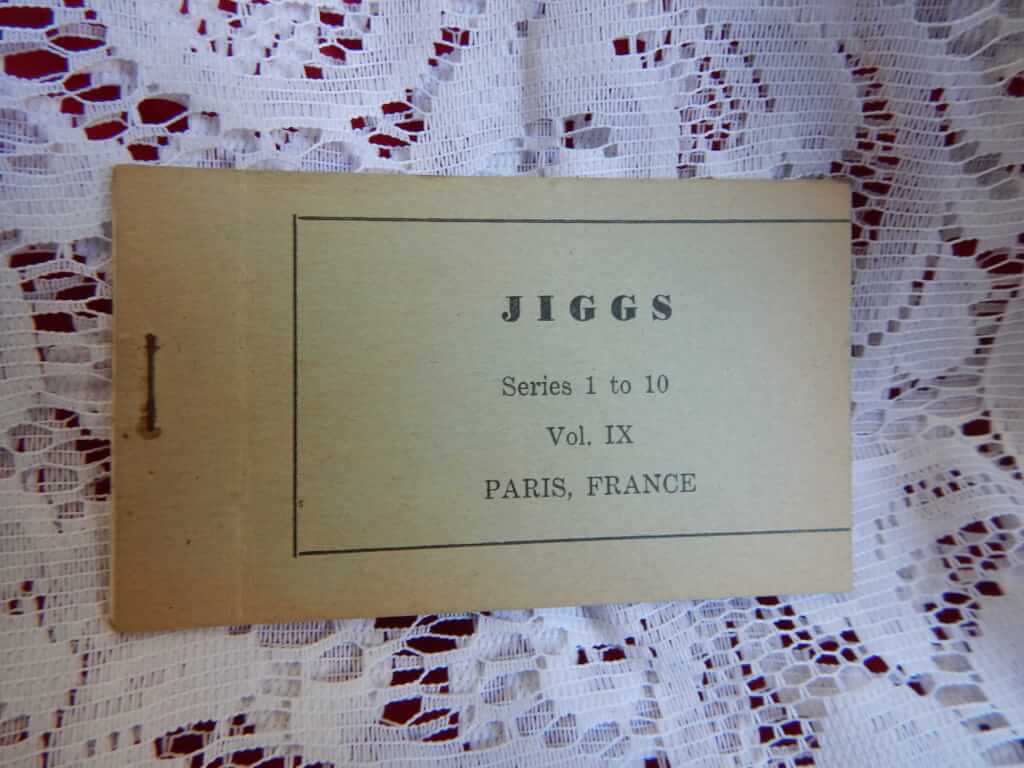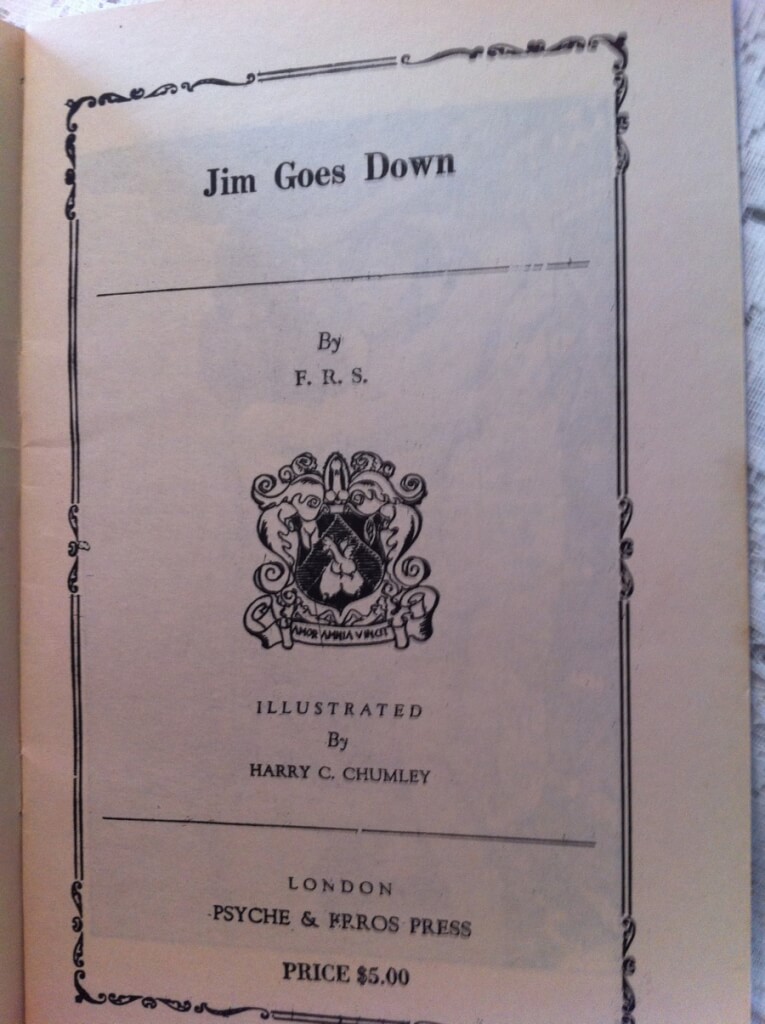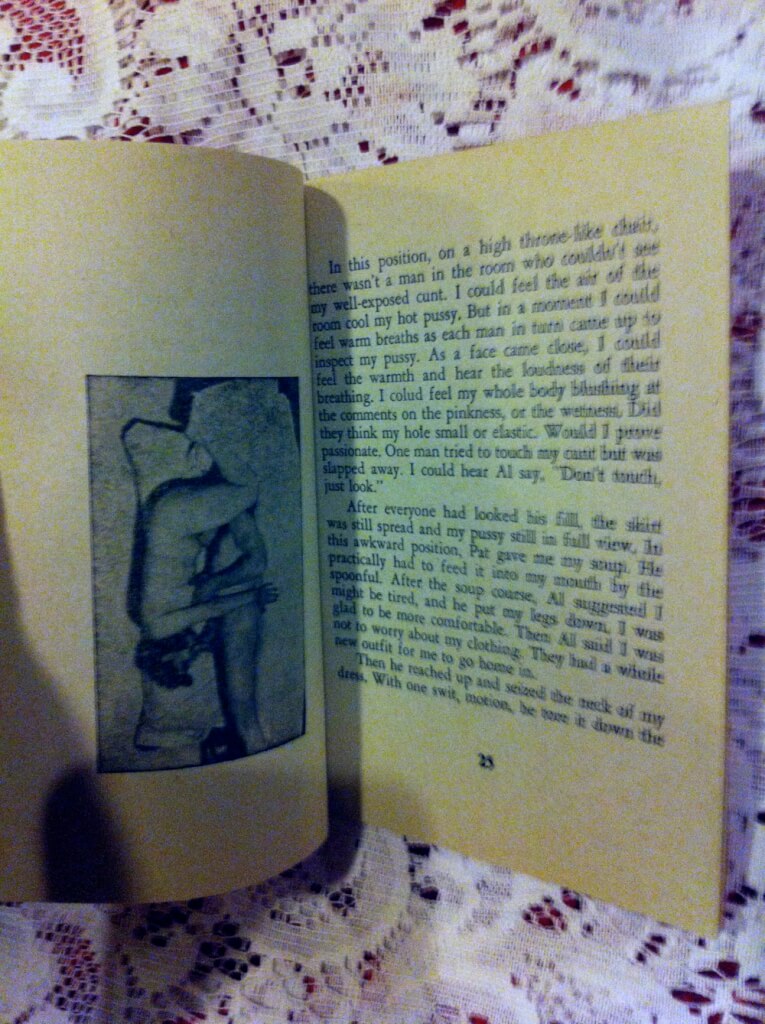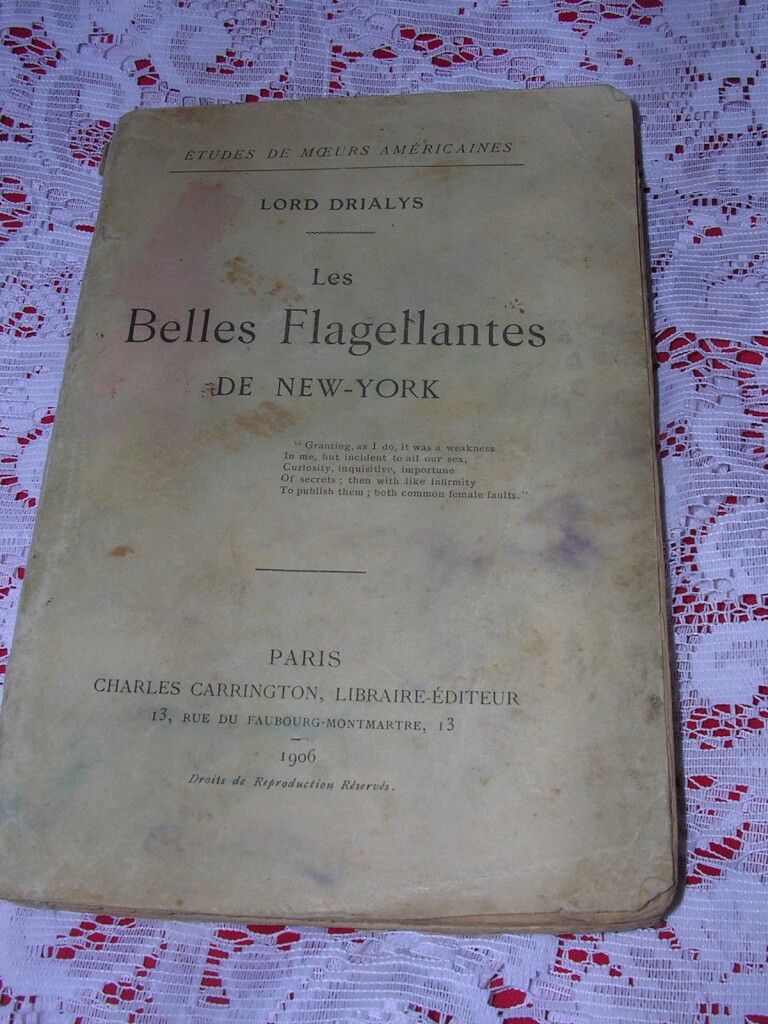People have been writing about sex since they have been writing. Often they had to do this underground or in exile. Many books have misleading title pages, stating the book was published in Paris (where it was often legal) or simply saying “Private, for subscribers” which was also a away around the censorship laws. Sometimes books were masked as anthropological or scientific work. Often books were banned and publishers went to jail. Each work of erotica that survived is a part of a much neglected (and often shunned) history. Our collection spans the mere “bawdy” to the sexually explicit both in literature and in the artwork that accompanied that literature. We also have sexology studies into the “exotic” and “perverse” sexual practices around the world often presented in an intentionally salacious way.
-
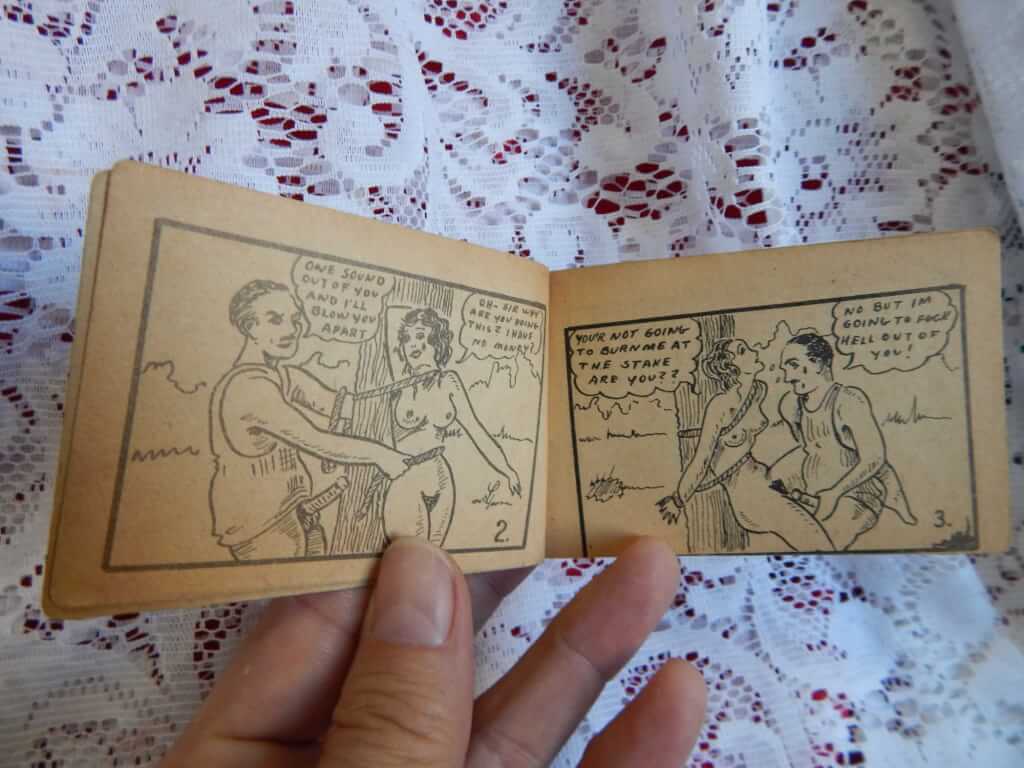
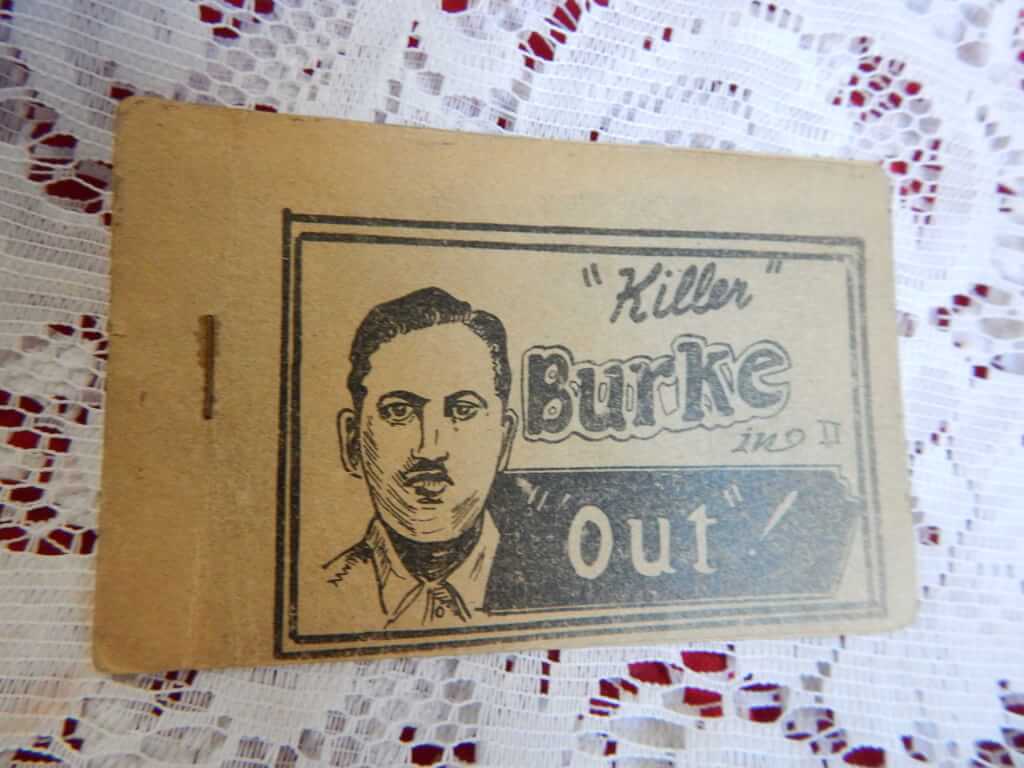 "Killer" Burke in "Out", (n.p. n.d.) 4.5" x 3", 8pp. pamphlet, stapled Tijuana bibles (also known as eight-pagers, bluesies, gray-backs, Jiggs-and-Maggie books, jo-jo books, Tillie-and-Mac books, and two-by-fours) were little pornographic comic books produced in the United States from the 1920s to the early 1960s.
"Killer" Burke in "Out", (n.p. n.d.) 4.5" x 3", 8pp. pamphlet, stapled Tijuana bibles (also known as eight-pagers, bluesies, gray-backs, Jiggs-and-Maggie books, jo-jo books, Tillie-and-Mac books, and two-by-fours) were little pornographic comic books produced in the United States from the 1920s to the early 1960s. -
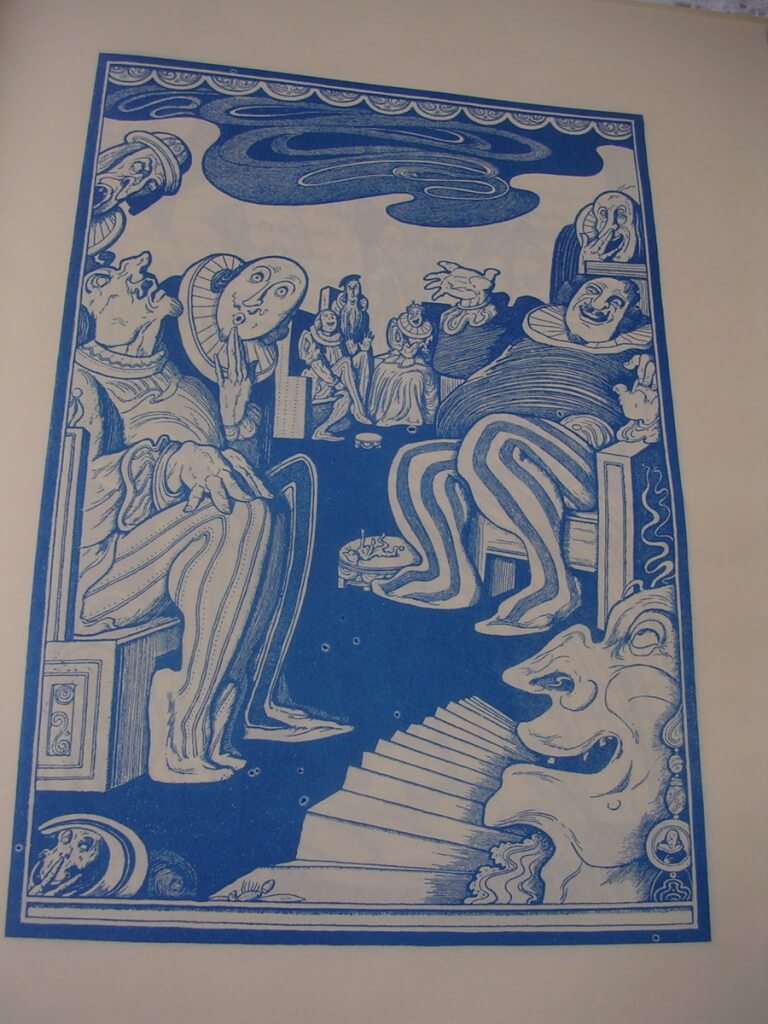
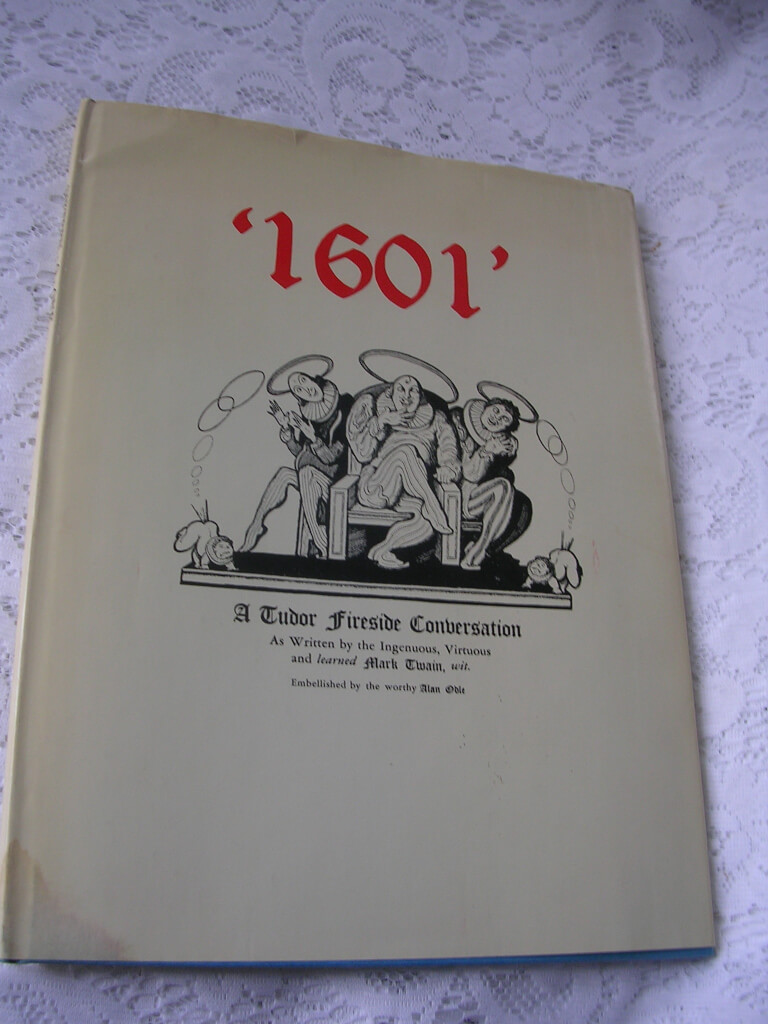 1601 A Tudor Fireside Conversation As Written by the Ingenuous, Virtuous and learned Mark Twain, wit., Embellished by the worthy Alan Odle, Mark Twain, illustrations Alan Odle (Land's End Press, USA, 1969, stated "At London, Printed for Subscribers Only and are to be sold at ye beare Back-Side in Maiden Lane") 12 1/2" X 9 1/2", 24pp (unpaginated), hardbound with dust jacket, blue boards with blue titles, pages, pages printed in such a way that the lower edge is uncut (six folded sheets of paper printed on one side, making up 4 pages) [Date: 1601.] Conversation, as it was the Social Fireside, in the Time of the Tudors is the title of a humorous work by Mark Twain, first published anonymously in 1880. Edward Wagenknecht once referred to it as "the most famous piece of pornography in American literature." Its content is irreverent and vulgar rather than obscene, and its purpose seems to be comedic shock rather than erotic arousal. It would thus qualify as ribaldry rather than pornography. Twain wrote 1601 during the summer of 1876 (between writing Tom Sawyer and Huckleberry Finn), for the amusement of his closest friend, Reverend Joseph Twichell, 1601 was later first published by another friend, John Hay, who later became Secretary of State. The work circulated among printers (due to it's often archaic type font) and many small batches were printed, however the authorship of the work remained unverified until Twain finally acknowledged he wrote it in 1906.
1601 A Tudor Fireside Conversation As Written by the Ingenuous, Virtuous and learned Mark Twain, wit., Embellished by the worthy Alan Odle, Mark Twain, illustrations Alan Odle (Land's End Press, USA, 1969, stated "At London, Printed for Subscribers Only and are to be sold at ye beare Back-Side in Maiden Lane") 12 1/2" X 9 1/2", 24pp (unpaginated), hardbound with dust jacket, blue boards with blue titles, pages, pages printed in such a way that the lower edge is uncut (six folded sheets of paper printed on one side, making up 4 pages) [Date: 1601.] Conversation, as it was the Social Fireside, in the Time of the Tudors is the title of a humorous work by Mark Twain, first published anonymously in 1880. Edward Wagenknecht once referred to it as "the most famous piece of pornography in American literature." Its content is irreverent and vulgar rather than obscene, and its purpose seems to be comedic shock rather than erotic arousal. It would thus qualify as ribaldry rather than pornography. Twain wrote 1601 during the summer of 1876 (between writing Tom Sawyer and Huckleberry Finn), for the amusement of his closest friend, Reverend Joseph Twichell, 1601 was later first published by another friend, John Hay, who later became Secretary of State. The work circulated among printers (due to it's often archaic type font) and many small batches were printed, however the authorship of the work remained unverified until Twain finally acknowledged he wrote it in 1906. -
 1601 A Tudor Fireside Conversation As Written by the Ingenuous, Virtuous and learned Mark Twain, wit., Embellished by the worthy Alan Odle, Mark Twain, illustrations Alan Odle (Land's End Press, USA, 1969, stated "At London, Printed for Subscribers Only and are to be sold at ye beare Back-Side in Maiden Lane") 8.75"x11.25", 24pp (unpaginated), hardbound with mylar-protected dust jacket, red boards with gilt titles [Date: 1601.] Conversation, as it was the Social Fireside, in the Time of the Tudors is the title of a humorous work by Mark Twain, first published anonymously in 1880. Edward Wagenknecht once referred to it as "the most famous piece of pornography in American literature." Its content is irreverent and vulgar rather than obscene, and its purpose seems to be comedic shock rather than erotic arousal. It would thus qualify as ribaldry rather than pornography. Twain wrote 1601 during the summer of 1876 (between writing Tom Sawyer and Huckleberry Finn), for the amusement of his closest friend, Reverend Joseph Twichell, 1601 was later first published by another friend, John Hay, who later became Secretary of State. The work circulated among printers (due to it's often archaic type font) and many small batches were printed, however the authorship of the work remained unverified until Twain finally acknowledged he wrote it in 1906.
1601 A Tudor Fireside Conversation As Written by the Ingenuous, Virtuous and learned Mark Twain, wit., Embellished by the worthy Alan Odle, Mark Twain, illustrations Alan Odle (Land's End Press, USA, 1969, stated "At London, Printed for Subscribers Only and are to be sold at ye beare Back-Side in Maiden Lane") 8.75"x11.25", 24pp (unpaginated), hardbound with mylar-protected dust jacket, red boards with gilt titles [Date: 1601.] Conversation, as it was the Social Fireside, in the Time of the Tudors is the title of a humorous work by Mark Twain, first published anonymously in 1880. Edward Wagenknecht once referred to it as "the most famous piece of pornography in American literature." Its content is irreverent and vulgar rather than obscene, and its purpose seems to be comedic shock rather than erotic arousal. It would thus qualify as ribaldry rather than pornography. Twain wrote 1601 during the summer of 1876 (between writing Tom Sawyer and Huckleberry Finn), for the amusement of his closest friend, Reverend Joseph Twichell, 1601 was later first published by another friend, John Hay, who later became Secretary of State. The work circulated among printers (due to it's often archaic type font) and many small batches were printed, however the authorship of the work remained unverified until Twain finally acknowledged he wrote it in 1906. -
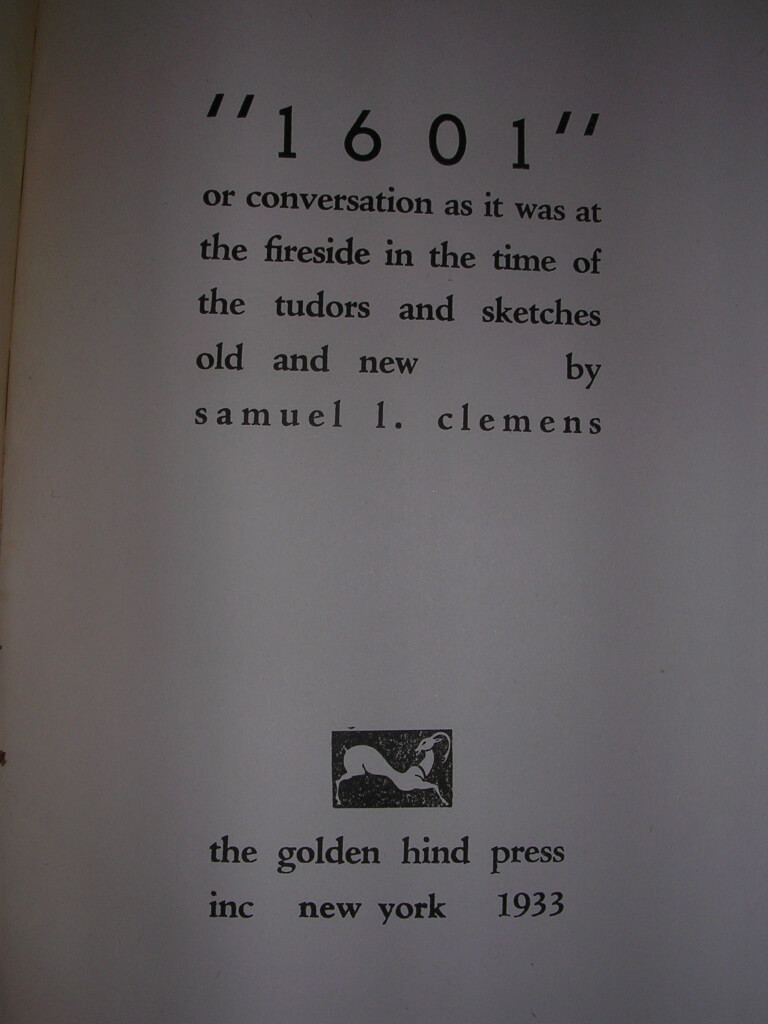
 "1601" or conversation as it was at the fireside in the time of the tudors and sketches old and new by Samuel L. Clemens, Mark Twain, Preface by Samuel Roth (The Golden Hind Press Inc., New York, 1933) 9 1/8" X 6 1/8", 204pp, hardbound no DJ, red cloth boards with gilt decorations and title, fair condition, boards detaching, binding intact, fading on boards and spine [Date: 1601.] Conversation, as it was the Social Fireside, in the Time of the Tudors is the title of a humorous work by Mark Twain, first published anonymously in 1880. Edward Wagenknecht once referred to it as "the most famous piece of pornography in American literature." Its content is irreverent and vulgar rather than obscene, and its purpose seems to be comedic shock rather than erotic arousal. It would thus qualify as ribaldry rather than pornography. Twain wrote 1601 during the summer of 1876 (between writing Tom Sawyer and Huckleberry Finn), for the amusement of his closest friend, Reverend Joseph Twichell, 1601 was later first published by another friend, John Hay, who later became Secretary of State. The work circulated among printers (due to it's often archaic type font) and many small batches were printed, however the authorship of the work remained unverified until Twain finally acknowledged he wrote it in 1906. This book contains 1601 and numerous sketches previously published as "Sketches Old and New"
"1601" or conversation as it was at the fireside in the time of the tudors and sketches old and new by Samuel L. Clemens, Mark Twain, Preface by Samuel Roth (The Golden Hind Press Inc., New York, 1933) 9 1/8" X 6 1/8", 204pp, hardbound no DJ, red cloth boards with gilt decorations and title, fair condition, boards detaching, binding intact, fading on boards and spine [Date: 1601.] Conversation, as it was the Social Fireside, in the Time of the Tudors is the title of a humorous work by Mark Twain, first published anonymously in 1880. Edward Wagenknecht once referred to it as "the most famous piece of pornography in American literature." Its content is irreverent and vulgar rather than obscene, and its purpose seems to be comedic shock rather than erotic arousal. It would thus qualify as ribaldry rather than pornography. Twain wrote 1601 during the summer of 1876 (between writing Tom Sawyer and Huckleberry Finn), for the amusement of his closest friend, Reverend Joseph Twichell, 1601 was later first published by another friend, John Hay, who later became Secretary of State. The work circulated among printers (due to it's often archaic type font) and many small batches were printed, however the authorship of the work remained unverified until Twain finally acknowledged he wrote it in 1906. This book contains 1601 and numerous sketches previously published as "Sketches Old and New" -
 2 books bound together: L'Onanisme, Dissertation Sur Les Maladies Produites Par La Masturbation, Samuel-Auguste Tissot (chez Marc Chapuis, Lausanne, 1778, 5th edition) Avis Au Peuple, Sur Les Asphyxies ou Morts Apparentes Et Subites: Contenant Les Moyens de les prevenir & d'y remedier, Avec La Description D'Une Nouvelle Boete fumigatoire portative. Publie par order du Gouvernement, Joseph-Jacques de Gardane (chez Rault, Paris, 1774) 4.25” x 6.25”, xiv+272pp + 114pp+2, bound in full calf, gilt title and decorations on spine, ex-libris V. Bertrand of Mareuil-sur-Lay (Vendée) France on front past-down. These two very notable medical books are bound together. Why are American men circumcised? Most people will offer some explanation to do with hygiene. But the real reason is that the Founding Fathers considered the presence of a foreskin an encouragement to masturbation, a vice which recent scientific research had shown threatened the very bedrock of civilisation. Their intellectual guide was one Samuel Auguste Tissot, a Swiss physician of the age of Enlightenment who cited self-pollution as responsible for a horde of ailments including jaundice, haemorrhoids, blindness, acne, insanity, epilepsy, delirium, tuberculosis, memory loss, paleness, pimples and death. Born in 1728 in Grancy, Switzerland, Tissot took up practice in Lausanne and became an expert on syphilis. Wrongly identifying the third-stage sequelae of syphilis as the results of excessive masturbation, he produced a book with two subtitles which became an international best-seller: Onanism: Or, a Treatise Upon the Disorders produced by Masturbation: Or, the Dangerous Effects of Secret and Excessive Venery (1760). In Onanism Tissot abandoned the moral and theological tone of previous commentators, taking the exclusively medical view that the human body had to maintain a delicate balance between nutrition on the one hand and fluid loss on the other. The emission of semen or vaginal fluid through repetitive, addictive non-procreative sex could tip the system into disastrous imbalance, especially since every ounce of the magic sexual excrement was equivalent to 40 ounces of blood. Tissot described a typical sufferer from excessive masturbation, or spermatorrhoea: “I went to his home; what I found was less a living being than a cadaver lying on straw, thin, pale, exuding a loathsome stench…A pale and watery blood often dripped from his nose, he drooled continually; subject to attacks of diarrhea, he defecated in his bed without noticing it; there was constant flow of semen…Thus sunk below the level of the beast, it was difficult to believe that he had once belonged to the human race.” Women could be tempted through a variety of stimuli, including novels, horseback riding, perfumes, corsets, feather beds, prolonged mental effort, pockets, bananas, society, solitude, spanking, rocking chairs and paintings (both oil and watercolor). “The humor they lose being less precious, less perfected than male sperm,” Tissot wrote humorlessly, “its loss does not perhaps weaken them as quickly, but when they indulge excessively, their nervous system being weaker and naturally more inclined to spasm, the troubles are more violent.” Joseph-Jacques de Gardane was a doctor and Royal Censor in Paris. In addition to the treatment of syphilis, he was concerned, as in this work, with the subject of asphyxiation death. In this rare work, translated as “Notice to the people, on asphyxia or related and sudden deaths. Contained here: The means to prevent them & their remedy. With the description of a new Boëte portable fumigator. Published by order of the Government” A medical revolution of the day when asphyxiation, like most maladies, was treated by leeches, Gardane’s approach to curing drowning was a “fumigator” which was a convenient invention for blowing tobacco smoke into the anus. Yes, LITERALLY blowing smoke up one’s ass! There are fold-out engravings with a diagram of the device and demonstration on its proper use.
2 books bound together: L'Onanisme, Dissertation Sur Les Maladies Produites Par La Masturbation, Samuel-Auguste Tissot (chez Marc Chapuis, Lausanne, 1778, 5th edition) Avis Au Peuple, Sur Les Asphyxies ou Morts Apparentes Et Subites: Contenant Les Moyens de les prevenir & d'y remedier, Avec La Description D'Une Nouvelle Boete fumigatoire portative. Publie par order du Gouvernement, Joseph-Jacques de Gardane (chez Rault, Paris, 1774) 4.25” x 6.25”, xiv+272pp + 114pp+2, bound in full calf, gilt title and decorations on spine, ex-libris V. Bertrand of Mareuil-sur-Lay (Vendée) France on front past-down. These two very notable medical books are bound together. Why are American men circumcised? Most people will offer some explanation to do with hygiene. But the real reason is that the Founding Fathers considered the presence of a foreskin an encouragement to masturbation, a vice which recent scientific research had shown threatened the very bedrock of civilisation. Their intellectual guide was one Samuel Auguste Tissot, a Swiss physician of the age of Enlightenment who cited self-pollution as responsible for a horde of ailments including jaundice, haemorrhoids, blindness, acne, insanity, epilepsy, delirium, tuberculosis, memory loss, paleness, pimples and death. Born in 1728 in Grancy, Switzerland, Tissot took up practice in Lausanne and became an expert on syphilis. Wrongly identifying the third-stage sequelae of syphilis as the results of excessive masturbation, he produced a book with two subtitles which became an international best-seller: Onanism: Or, a Treatise Upon the Disorders produced by Masturbation: Or, the Dangerous Effects of Secret and Excessive Venery (1760). In Onanism Tissot abandoned the moral and theological tone of previous commentators, taking the exclusively medical view that the human body had to maintain a delicate balance between nutrition on the one hand and fluid loss on the other. The emission of semen or vaginal fluid through repetitive, addictive non-procreative sex could tip the system into disastrous imbalance, especially since every ounce of the magic sexual excrement was equivalent to 40 ounces of blood. Tissot described a typical sufferer from excessive masturbation, or spermatorrhoea: “I went to his home; what I found was less a living being than a cadaver lying on straw, thin, pale, exuding a loathsome stench…A pale and watery blood often dripped from his nose, he drooled continually; subject to attacks of diarrhea, he defecated in his bed without noticing it; there was constant flow of semen…Thus sunk below the level of the beast, it was difficult to believe that he had once belonged to the human race.” Women could be tempted through a variety of stimuli, including novels, horseback riding, perfumes, corsets, feather beds, prolonged mental effort, pockets, bananas, society, solitude, spanking, rocking chairs and paintings (both oil and watercolor). “The humor they lose being less precious, less perfected than male sperm,” Tissot wrote humorlessly, “its loss does not perhaps weaken them as quickly, but when they indulge excessively, their nervous system being weaker and naturally more inclined to spasm, the troubles are more violent.” Joseph-Jacques de Gardane was a doctor and Royal Censor in Paris. In addition to the treatment of syphilis, he was concerned, as in this work, with the subject of asphyxiation death. In this rare work, translated as “Notice to the people, on asphyxia or related and sudden deaths. Contained here: The means to prevent them & their remedy. With the description of a new Boëte portable fumigator. Published by order of the Government” A medical revolution of the day when asphyxiation, like most maladies, was treated by leeches, Gardane’s approach to curing drowning was a “fumigator” which was a convenient invention for blowing tobacco smoke into the anus. Yes, LITERALLY blowing smoke up one’s ass! There are fold-out engravings with a diagram of the device and demonstration on its proper use. -
 40 prints from “Liebe. Vierzig Zeichnungen”, Mihály Zichy (n.d. n.p. [1911-13]) 11.25″ X 13.5″, 40pp unnumbered, bound in half-morocco with gilt edges over red boards, gilt titles and decorations on spine, all 40 original plates are present and bound together in what appears to be a contemporary binding, good condition, some foxing throughout. Mihály Zichy (1827 – 1906) was a Hungarian painter and graphic artist. He is considered a notable representative of Hungarian romantic painting. He lived and worked primarily in St. Petersburg and Paris during his career. He is known for illustrating the Georgian epic poem The Knight in the Panther's Skin on an 1881 commission by the intelligentsia. By the time he had completed 35 pictures, he was so moved by the poem that he gave his works to the Georgian people as a gift. In 1911 40 héliogravures after Zichy’s erotic drawings were published as “Liebe. Vierzig Zeichnungen” [Love. 40 drawings]. The subjects were bold, provocative, and at times taboo. Only 300 copies were printed, only for subscribers. There was also a very rare limited printing in 1913 before the plates were destroyed. As far as I can tell these appear to be the prints taken from that one of those editions, and rebound here without the title page that accompanied the published work.
40 prints from “Liebe. Vierzig Zeichnungen”, Mihály Zichy (n.d. n.p. [1911-13]) 11.25″ X 13.5″, 40pp unnumbered, bound in half-morocco with gilt edges over red boards, gilt titles and decorations on spine, all 40 original plates are present and bound together in what appears to be a contemporary binding, good condition, some foxing throughout. Mihály Zichy (1827 – 1906) was a Hungarian painter and graphic artist. He is considered a notable representative of Hungarian romantic painting. He lived and worked primarily in St. Petersburg and Paris during his career. He is known for illustrating the Georgian epic poem The Knight in the Panther's Skin on an 1881 commission by the intelligentsia. By the time he had completed 35 pictures, he was so moved by the poem that he gave his works to the Georgian people as a gift. In 1911 40 héliogravures after Zichy’s erotic drawings were published as “Liebe. Vierzig Zeichnungen” [Love. 40 drawings]. The subjects were bold, provocative, and at times taboo. Only 300 copies were printed, only for subscribers. There was also a very rare limited printing in 1913 before the plates were destroyed. As far as I can tell these appear to be the prints taken from that one of those editions, and rebound here without the title page that accompanied the published work. -

 A Complete Encyclopaedia of the Sexual Sciences, Dr. Iwan Bloch, trans Dr. M. Eden Paul (Falstaff Press, New York, 1937) 8.75" X 5.75", xxx+790pp, hardbound, no DJ, decorative red cloth with gilt lettering and decorations. The 30 pages of the preface printed in black with red decorations (mostly praise of the book and the author by various people including Dr. Bloch). Good condition, corners bumped, some fading/spotting on cover and spine, binding very good. "The author's aim in writing this book was to write a complete Encyclopaedia on the sexual sciences, and it will probably be acknowledged by all who study its pages that the author has accomplished his intention in a very scholarly manner, and in such form as to be of great value to the professions for whom this translation is intended. The subject is no doubt one which appeals to and affects the interests of all adult persons, but the publishers have, after very serious and careful consideration, come to the conclusion that the sale of the English translation of the book shall be limited to members of the legal and medical professions." -from Publisher's Note
A Complete Encyclopaedia of the Sexual Sciences, Dr. Iwan Bloch, trans Dr. M. Eden Paul (Falstaff Press, New York, 1937) 8.75" X 5.75", xxx+790pp, hardbound, no DJ, decorative red cloth with gilt lettering and decorations. The 30 pages of the preface printed in black with red decorations (mostly praise of the book and the author by various people including Dr. Bloch). Good condition, corners bumped, some fading/spotting on cover and spine, binding very good. "The author's aim in writing this book was to write a complete Encyclopaedia on the sexual sciences, and it will probably be acknowledged by all who study its pages that the author has accomplished his intention in a very scholarly manner, and in such form as to be of great value to the professions for whom this translation is intended. The subject is no doubt one which appeals to and affects the interests of all adult persons, but the publishers have, after very serious and careful consideration, come to the conclusion that the sale of the English translation of the book shall be limited to members of the legal and medical professions." -from Publisher's Note -
 "A Defence of Women for their Inconstancy & their Paintings made by Jack Donne & printed now with five decorations by Norman Lindsay" (Fanfrolico Press, London, 1925, #161/370) 7.5" X 5.5", unpaginated [12], brown cloth boards with gilt titles on spine, very good condition for age, slight bumping to corners. Woman’s Constancy” is one of John Donne’s many metaphysical poems of the 16th century. He writes this poem to a woman who he is or was in a relationship with. Despite the title, he talks about how inconsistent the woman’s love is and presents it in a series of questions. The poem describes a situation where a man has been loved by a woman for an entire day. However, he wonders if she will declare her love for another man the day after. He thinks that the woman’s logic is that the oath of love ends when one partner dies, and that since sleep resembles death, it is okay for the oath of love to be broken. For the woman to be true to herself, she must admit her false statements of love. The author thinks that he is more intelligent than her and states that he will not argue with her about her reasons for leaving him. However, Donne states that the following day he may feel the same way that she does. John Donne (1572 - 1631) was an English poet, scholar, soldier and secretary born into a recusant family, who later became a cleric in the Church of England. Under royal patronage, he was made Dean of St Paul's Cathedral in London (1621–1631). He is considered the preeminent representative of the metaphysical poets. His poetical works are noted for their metaphorical and sensual style and include sonnets, love poems, religious poems, Latin translations, epigrams, elegies, songs and satires. He is also known for his sermons. Donne's style is characterized by abrupt openings and various paradoxes, ironies and dislocations. These features, along with his frequent dramatic or everyday speech rhythms, his tense syntax and his tough eloquence, were both a reaction against the smoothness of conventional Elizabethan poetry and an adaptation into English of European baroque and mannerist techniques. His early career was marked by poetry that bore immense knowledge of English society. Another important theme in Donne's poetry is the idea of true religion, something that he spent much time considering and about which he often theorized. He wrote secular poems as well as erotic and love poems. He is particularly famous for his mastery of metaphysical conceits. Despite his great education and poetic talents, Donne lived in poverty for several years, relying heavily on wealthy friends. He spent much of the money he inherited during and after his education on womanising, literature, pastimes and travel. In 1601, Donne secretly married Anne More, with whom he had twelve children. In 1615 he was ordained Anglican deacon and then priest, although he did not want to take holy orders and only did so because the king ordered it. He also served as a member of Parliament in 1601 and in 1614. Fanfrolico Press, Australia’s first ‘private press’ in the arts-and-craft tradition, was founded by Jack Lindsay, P. R. Stephensen and John Kirtley, originally in North Sydney in 1923. The press specialized in printings artful, limited editions of classics and forgotten works that were suited to the extravagant style of artist like his father, artist, sculptor and author Norman Lindsay who illustrated many of their books. Fanfrolico was scornful of modernism and with its florid style determinedly backward-looking. They did surprisingly well, despite the lack of business expertise of their young, ambitious "bohemian" owners, eking out a living despite the risky move to London in 1926 and upheavals in ownership that saw the departure in 1927 of Kirtley, and then Stephenson in 1929. Sometime in 1930 they published their last book. Norman Alfred William Lindsay (1879-1969) was an Australian artist, etcher, sculptor, writer, editorial cartoonist, scale modeller, and an accomplished amateur boxer. Lindsay is widely regarded as one of Australia's greatest artists, producing a vast body of work in different media, including pen drawing, etching, watercolour, oil and sculptures in concrete and bronze. His frank and sumptuous nudes were highly controversial. In 1940, his wife took sixteen crates of paintings, drawings and etchings to the U.S. to protect them from the war. Unfortunately, they were discovered when the train they were on caught fire. The pieces were impounded and subsequently burned as pornography by American officials.
"A Defence of Women for their Inconstancy & their Paintings made by Jack Donne & printed now with five decorations by Norman Lindsay" (Fanfrolico Press, London, 1925, #161/370) 7.5" X 5.5", unpaginated [12], brown cloth boards with gilt titles on spine, very good condition for age, slight bumping to corners. Woman’s Constancy” is one of John Donne’s many metaphysical poems of the 16th century. He writes this poem to a woman who he is or was in a relationship with. Despite the title, he talks about how inconsistent the woman’s love is and presents it in a series of questions. The poem describes a situation where a man has been loved by a woman for an entire day. However, he wonders if she will declare her love for another man the day after. He thinks that the woman’s logic is that the oath of love ends when one partner dies, and that since sleep resembles death, it is okay for the oath of love to be broken. For the woman to be true to herself, she must admit her false statements of love. The author thinks that he is more intelligent than her and states that he will not argue with her about her reasons for leaving him. However, Donne states that the following day he may feel the same way that she does. John Donne (1572 - 1631) was an English poet, scholar, soldier and secretary born into a recusant family, who later became a cleric in the Church of England. Under royal patronage, he was made Dean of St Paul's Cathedral in London (1621–1631). He is considered the preeminent representative of the metaphysical poets. His poetical works are noted for their metaphorical and sensual style and include sonnets, love poems, religious poems, Latin translations, epigrams, elegies, songs and satires. He is also known for his sermons. Donne's style is characterized by abrupt openings and various paradoxes, ironies and dislocations. These features, along with his frequent dramatic or everyday speech rhythms, his tense syntax and his tough eloquence, were both a reaction against the smoothness of conventional Elizabethan poetry and an adaptation into English of European baroque and mannerist techniques. His early career was marked by poetry that bore immense knowledge of English society. Another important theme in Donne's poetry is the idea of true religion, something that he spent much time considering and about which he often theorized. He wrote secular poems as well as erotic and love poems. He is particularly famous for his mastery of metaphysical conceits. Despite his great education and poetic talents, Donne lived in poverty for several years, relying heavily on wealthy friends. He spent much of the money he inherited during and after his education on womanising, literature, pastimes and travel. In 1601, Donne secretly married Anne More, with whom he had twelve children. In 1615 he was ordained Anglican deacon and then priest, although he did not want to take holy orders and only did so because the king ordered it. He also served as a member of Parliament in 1601 and in 1614. Fanfrolico Press, Australia’s first ‘private press’ in the arts-and-craft tradition, was founded by Jack Lindsay, P. R. Stephensen and John Kirtley, originally in North Sydney in 1923. The press specialized in printings artful, limited editions of classics and forgotten works that were suited to the extravagant style of artist like his father, artist, sculptor and author Norman Lindsay who illustrated many of their books. Fanfrolico was scornful of modernism and with its florid style determinedly backward-looking. They did surprisingly well, despite the lack of business expertise of their young, ambitious "bohemian" owners, eking out a living despite the risky move to London in 1926 and upheavals in ownership that saw the departure in 1927 of Kirtley, and then Stephenson in 1929. Sometime in 1930 they published their last book. Norman Alfred William Lindsay (1879-1969) was an Australian artist, etcher, sculptor, writer, editorial cartoonist, scale modeller, and an accomplished amateur boxer. Lindsay is widely regarded as one of Australia's greatest artists, producing a vast body of work in different media, including pen drawing, etching, watercolour, oil and sculptures in concrete and bronze. His frank and sumptuous nudes were highly controversial. In 1940, his wife took sixteen crates of paintings, drawings and etchings to the U.S. to protect them from the war. Unfortunately, they were discovered when the train they were on caught fire. The pieces were impounded and subsequently burned as pornography by American officials. -
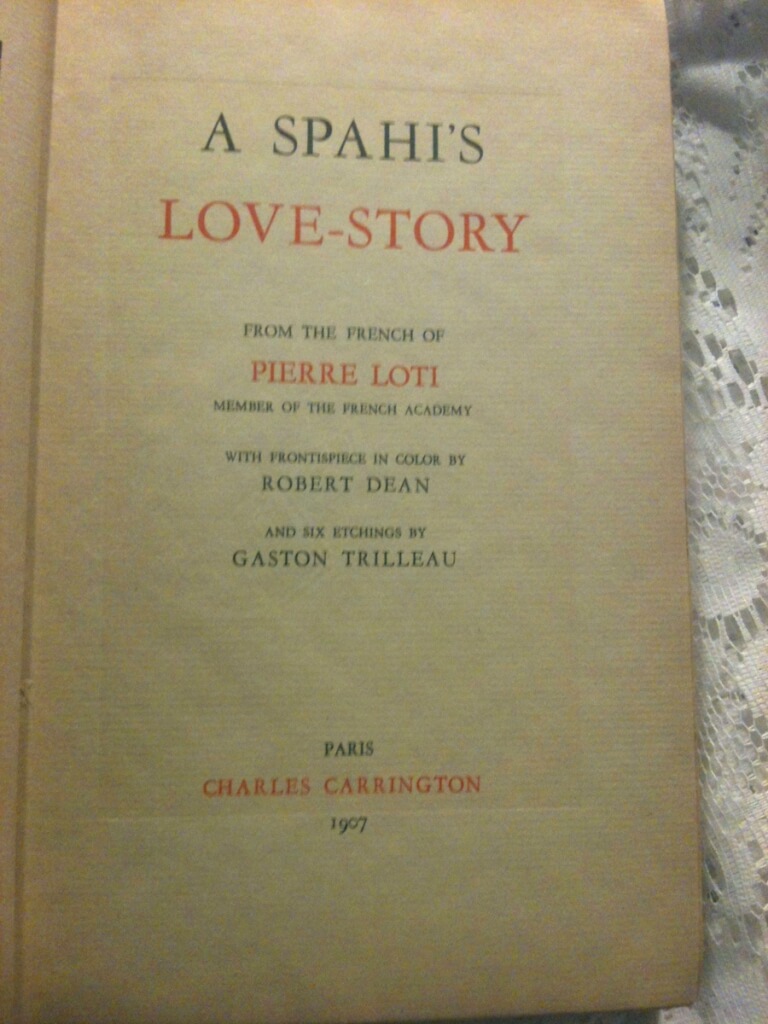
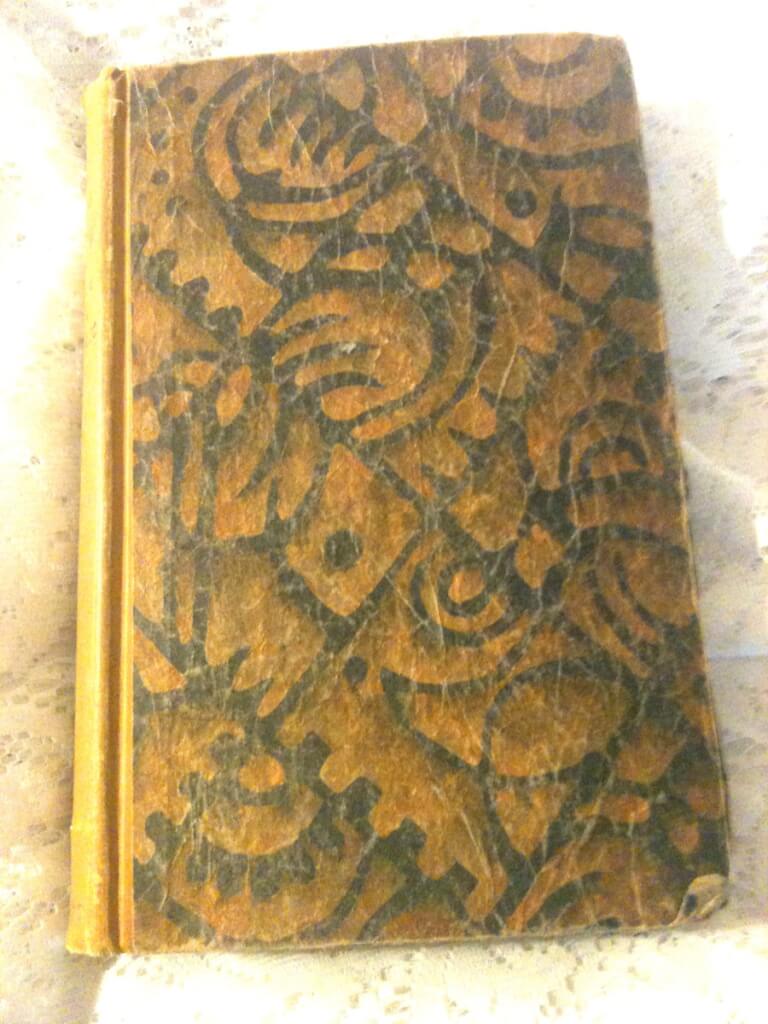 A Spahi’s Love-Story, Pierre Loti [pseud. Julien Viaud], illus. Robert Dean, illus. Gaston Trilleau (Charles Carrington, Paris, 1907, #17/1000) 9″ x 5.75″, xii+330pp, hardbound, yellow cloth and batik design paper over boards, tipped-in color frontispiece, hand-made paper, deckled edges, good+ condition Julien Viaud (1850-1923) was a French novelist and naval officer. This his third novel (originally titled “Le Roman d’un Spahi”), was originally published in 1881. It recounts the tragic story in the dark middle ages of a Turkish soldier, who fell in love with a woman from a far away culture with a very different background. Color frontispiece by Robert Dean tipped in and six etchings by Gaston Trilleau throughout the book.
A Spahi’s Love-Story, Pierre Loti [pseud. Julien Viaud], illus. Robert Dean, illus. Gaston Trilleau (Charles Carrington, Paris, 1907, #17/1000) 9″ x 5.75″, xii+330pp, hardbound, yellow cloth and batik design paper over boards, tipped-in color frontispiece, hand-made paper, deckled edges, good+ condition Julien Viaud (1850-1923) was a French novelist and naval officer. This his third novel (originally titled “Le Roman d’un Spahi”), was originally published in 1881. It recounts the tragic story in the dark middle ages of a Turkish soldier, who fell in love with a woman from a far away culture with a very different background. Color frontispiece by Robert Dean tipped in and six etchings by Gaston Trilleau throughout the book. -

 Acting in Private "An Old Old Story", (The London Press, London England, n.d.) 4.5" x 3.5", 8pp. pamphlet, stapled Tijuana bibles (also known as eight-pagers, bluesies, gray-backs, Jiggs-and-Maggie books, jo-jo books, Tillie-and-Mac books, and two-by-fours) were little pornographic comic books produced in the United States from the 1920s to the early 1960s.
Acting in Private "An Old Old Story", (The London Press, London England, n.d.) 4.5" x 3.5", 8pp. pamphlet, stapled Tijuana bibles (also known as eight-pagers, bluesies, gray-backs, Jiggs-and-Maggie books, jo-jo books, Tillie-and-Mac books, and two-by-fours) were little pornographic comic books produced in the United States from the 1920s to the early 1960s. -
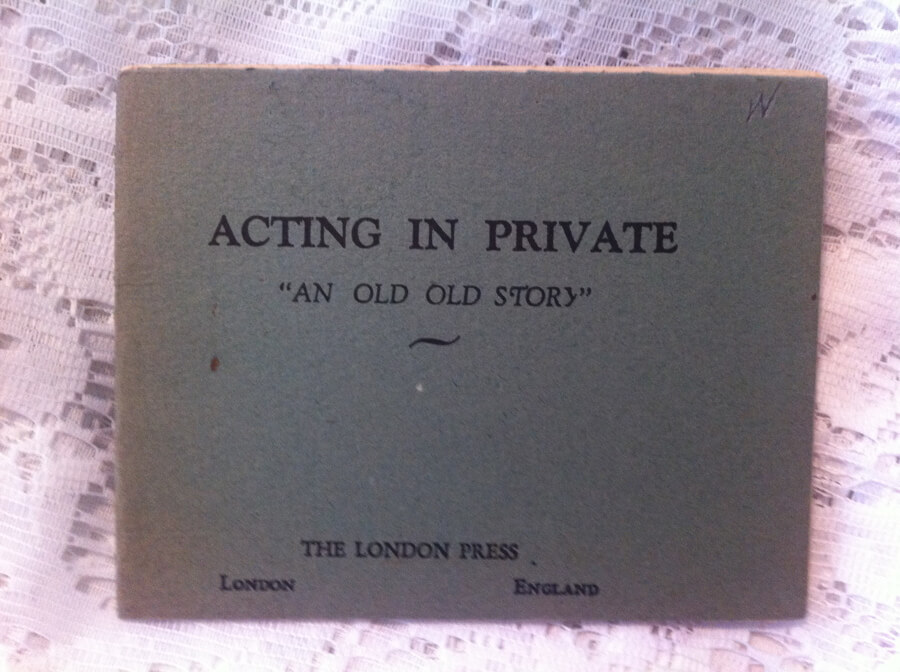
 Acting in Private "An Old Old Story", (The London Press, London England, n.d.) 4.5" x 3.5", 8pp. pamphlet, stapled Tijuana bibles (also known as eight-pagers, bluesies, gray-backs, Jiggs-and-Maggie books, jo-jo books, Tillie-and-Mac books, and two-by-fours) were little pornographic comic books produced in the United States from the 1920s to the early 1960s.
Acting in Private "An Old Old Story", (The London Press, London England, n.d.) 4.5" x 3.5", 8pp. pamphlet, stapled Tijuana bibles (also known as eight-pagers, bluesies, gray-backs, Jiggs-and-Maggie books, jo-jo books, Tillie-and-Mac books, and two-by-fours) were little pornographic comic books produced in the United States from the 1920s to the early 1960s. -
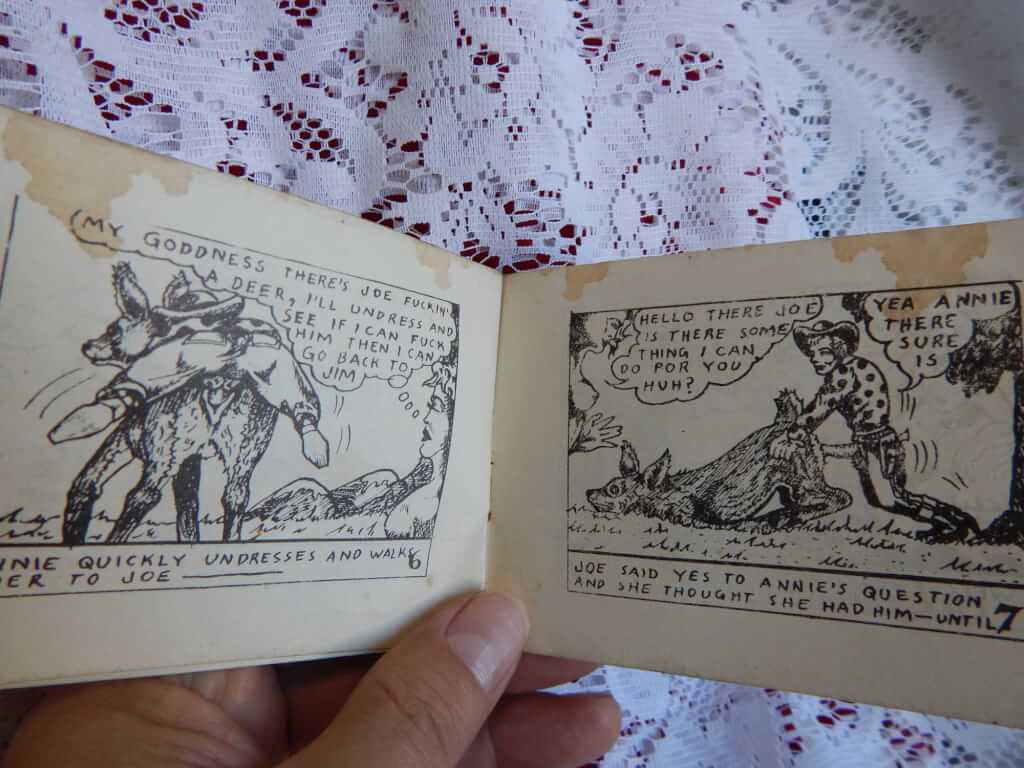
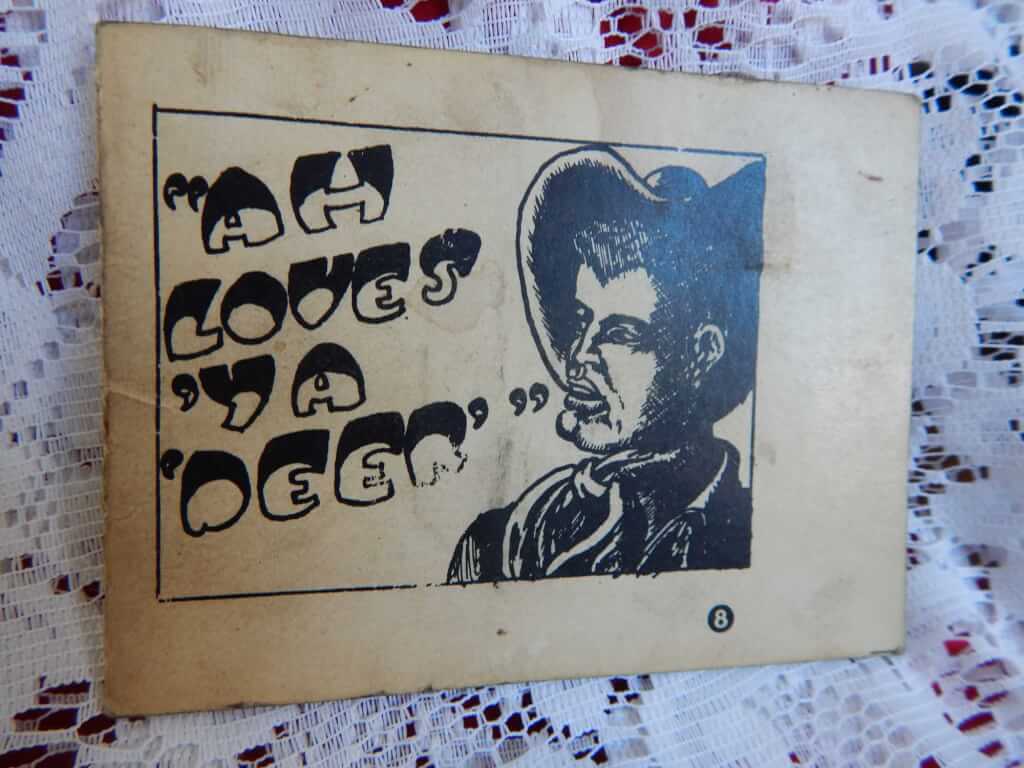 Ah Loves 'ya 'Deer'", (np. nd.) 4.5" x 3", 8pp., pamphlet, stapled and taped Tijuana bibles (also known as eight-pagers, bluesies, gray-backs, Jiggs-and-Maggie books, jo-jo books, Tillie-and-Mac books, and two-by-fours) were little pornographic comic books produced in the United States from the 1920s to the early 1960s.
Ah Loves 'ya 'Deer'", (np. nd.) 4.5" x 3", 8pp., pamphlet, stapled and taped Tijuana bibles (also known as eight-pagers, bluesies, gray-backs, Jiggs-and-Maggie books, jo-jo books, Tillie-and-Mac books, and two-by-fours) were little pornographic comic books produced in the United States from the 1920s to the early 1960s. -
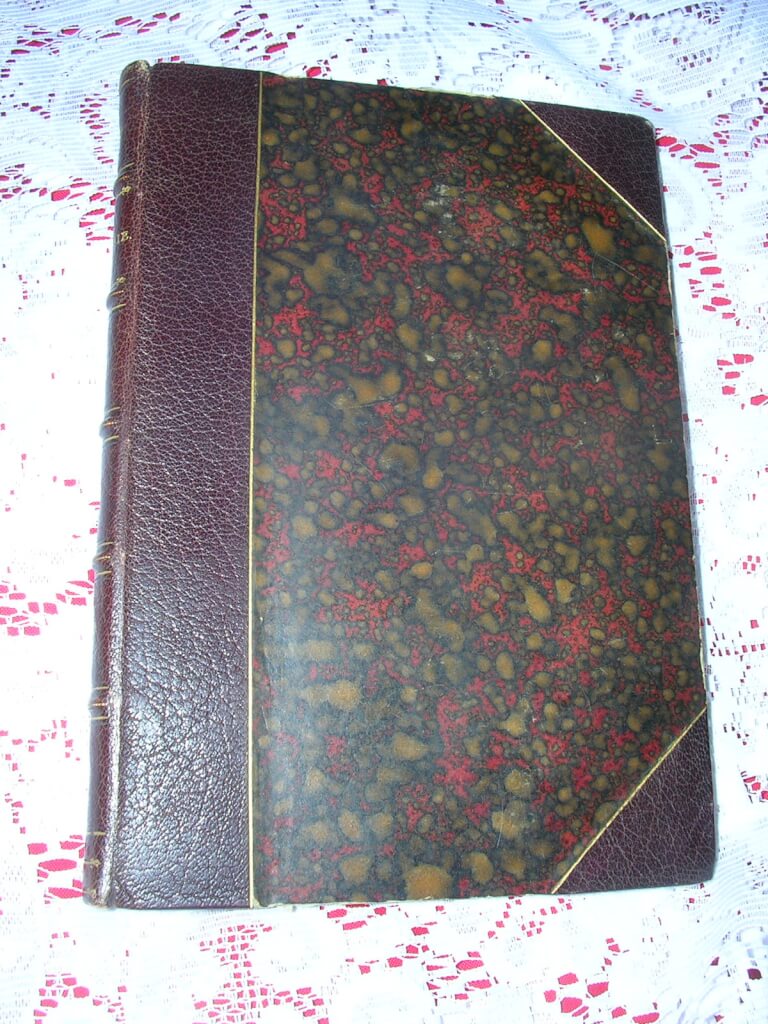
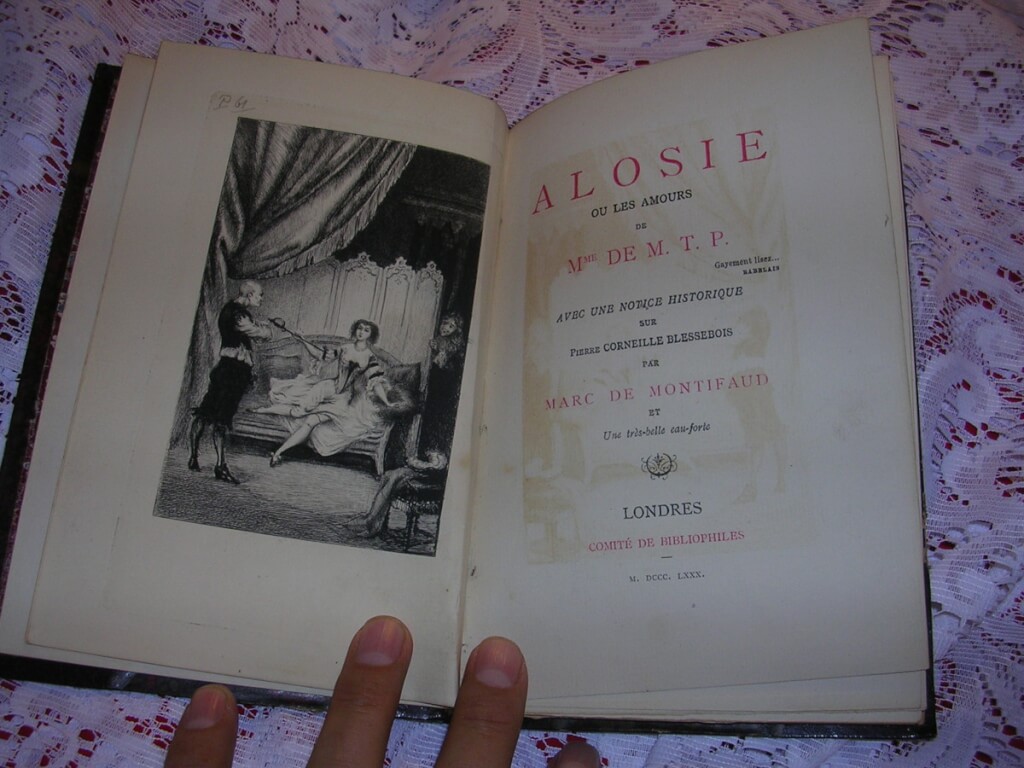 Alosie, ou Les Amours de Mme. de M. T. P. | Avec une notice historique sur Pierre Corneille Blessebois par Marc de Montifaud et Une très-belle eau-forte, Marc de Montifaud [pseud. Marie-Amélie Chartroule, Mme Quivogne de Montifaud] (Comité de Bibliophiles, London, 1880 [131/500 printed on Holland paper]) 7.5" x 5.25", 104pp, hardbound 1/2 leather, marbled boards and endpapers, gilt decorationson spine and leather corners, five raised bands on spine. Top edge gilt. Frontispiece engraving. #131 of 300 on Holland paper. Great condition for age. Initials "P.G." above frontispiece. Mme Quivogne de Montifaud (1845-50 to 1912/13) french writer and "free-thinker". She often dressed as her male pseudonym Marc de Montifaud. This book (published in London in 1880) is a reprint of part of the larger 17th century erotic work, "Amours des dames illustres de nostre siècle" (Loves of Illustrious Ladies of our Century) with an essay where Montifaud tries to unravel the authorship (usually the work is attributed to Pierre Corneille Blessebois). The author changes the original name to reflect that this is an autobiography of Madame de Montespan, the notorius mistress of Louis XIV. When originally published in Holland in 1878 (as "Lupanie, histoire amoureuse de ce temps") a court in Seine called it a moral outrage describing "licentious scenes on almost every page; told in a style revoltingly obscene". For publishing this book Montifaud was sentenced to 8 days in jail and fined 500 francs and ordered all copies of the book destroyed. The publisher was also fined 500 francs. This is a rare copy of a rare book in it's original "publishers leather".
Alosie, ou Les Amours de Mme. de M. T. P. | Avec une notice historique sur Pierre Corneille Blessebois par Marc de Montifaud et Une très-belle eau-forte, Marc de Montifaud [pseud. Marie-Amélie Chartroule, Mme Quivogne de Montifaud] (Comité de Bibliophiles, London, 1880 [131/500 printed on Holland paper]) 7.5" x 5.25", 104pp, hardbound 1/2 leather, marbled boards and endpapers, gilt decorationson spine and leather corners, five raised bands on spine. Top edge gilt. Frontispiece engraving. #131 of 300 on Holland paper. Great condition for age. Initials "P.G." above frontispiece. Mme Quivogne de Montifaud (1845-50 to 1912/13) french writer and "free-thinker". She often dressed as her male pseudonym Marc de Montifaud. This book (published in London in 1880) is a reprint of part of the larger 17th century erotic work, "Amours des dames illustres de nostre siècle" (Loves of Illustrious Ladies of our Century) with an essay where Montifaud tries to unravel the authorship (usually the work is attributed to Pierre Corneille Blessebois). The author changes the original name to reflect that this is an autobiography of Madame de Montespan, the notorius mistress of Louis XIV. When originally published in Holland in 1878 (as "Lupanie, histoire amoureuse de ce temps") a court in Seine called it a moral outrage describing "licentious scenes on almost every page; told in a style revoltingly obscene". For publishing this book Montifaud was sentenced to 8 days in jail and fined 500 francs and ordered all copies of the book destroyed. The publisher was also fined 500 francs. This is a rare copy of a rare book in it's original "publishers leather". -
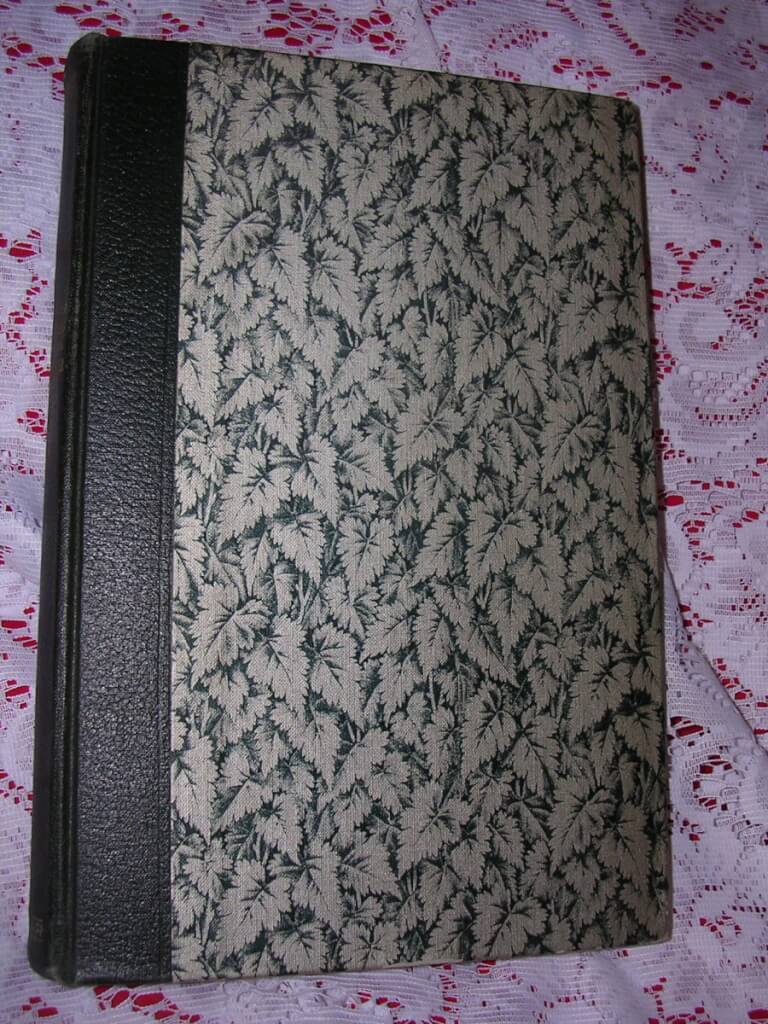
 Amatory Adventures of Sheik Mansour, A Master of the Art of Love, Hector France (Jul-Mar Press, 1932) 6 3/8 x 9 5/8", 249 pp, Stated, limited printing of 1000, but has no number. By Hector France, illustrated by Esaye Rabkin, this is a nice copy of this classic erotic novel. Book is a good used copy - cover is nice, has some rubbing to corners, overall age/use, as seen in the photo. Pages are all present and bound solid. Book has two 'Discarded' stamps, one at inside of the front cover, one at the title page. Has a damp stain along bottom margin of pages from front to page 19, small chip and tear at bottom of the title page. I see no other extraneous marks in this copy! Hector France (1837 - 1908) was a French author best known for his "orientalist" and flagellation tales. This is his risque tale of an Arab stud in action; a novel set around a Turkish harem. Translated by Alfred Allinson and reproduced from the Charles Carrington novel "The Chastisement of Mansour"
Amatory Adventures of Sheik Mansour, A Master of the Art of Love, Hector France (Jul-Mar Press, 1932) 6 3/8 x 9 5/8", 249 pp, Stated, limited printing of 1000, but has no number. By Hector France, illustrated by Esaye Rabkin, this is a nice copy of this classic erotic novel. Book is a good used copy - cover is nice, has some rubbing to corners, overall age/use, as seen in the photo. Pages are all present and bound solid. Book has two 'Discarded' stamps, one at inside of the front cover, one at the title page. Has a damp stain along bottom margin of pages from front to page 19, small chip and tear at bottom of the title page. I see no other extraneous marks in this copy! Hector France (1837 - 1908) was a French author best known for his "orientalist" and flagellation tales. This is his risque tale of an Arab stud in action; a novel set around a Turkish harem. Translated by Alfred Allinson and reproduced from the Charles Carrington novel "The Chastisement of Mansour" -
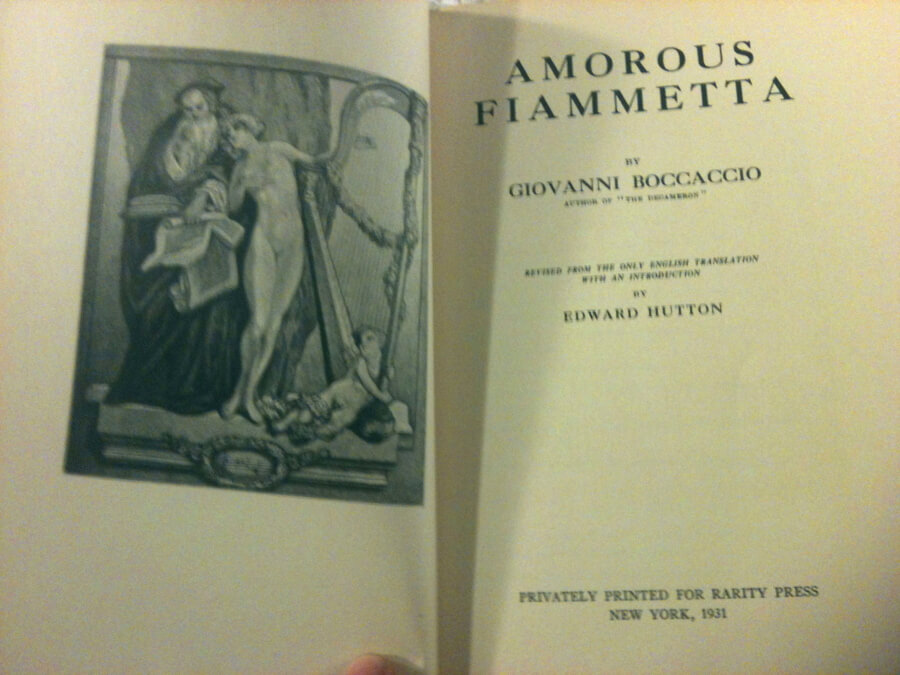
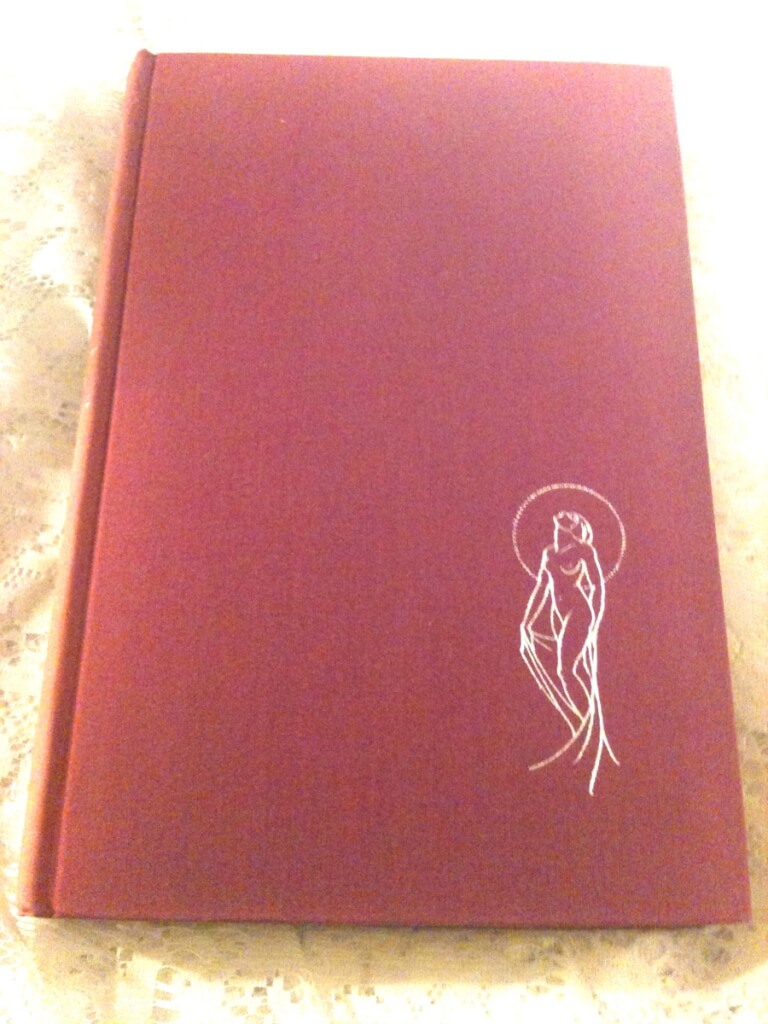 Amorous Fiammetta, Giovanni Boccaccio, introduction by Edward Hutton, trans. & illus. various unknown. (Rarity Press, New York, 1931 ) 9.5" X 6.5", 356pp, Hardcover no DJ, red cloth boards, botton and fore edges deckled. Good condition for age, a fading on spine, silver gilt lettering and decorations Originally titled "Elegia di Madonna Fiammetta" (The Elegy of Lady Fiammetta), this marvelous European romance was written by Giovanni Boccaccio somewhere between 1343 and 1344. It is a first-person confessional monologue narrated by a woman and is considered the first psychological novel in a modern language and a precursor of stream-of-consciousness fiction. Lady Fiammetta, recounts how, although a married woman, she falls in love with a handsome young foreigner named Panfilo and, becomes his lover. Panfilo subsequently abandons Fiammetta and returns to his native land, where his father is said to be dying. When he fails to keep his promise to return, Fiammetta, describes her longings, her anguish, and her despair. A host of contradictory sentiments drive her to desperation and to an unsuccessful suicide attempt. After a time, Fiammetta resumes her futile wait for Panfilo. She finally resolves to seek him out in his native land. Disguising her true intent from her husband, she secures his promise to help her in this undertaking. Addressing an exclusively female audience, Fiammetta warns them about the vicious ways of men. Her whole narrative adds up to an indictment of men as both readers and lovers. Fiammetta has been variously described as a pathetic victim of male cruelty; an irresponsible fool of a girl; a sophisticated, cunning, and wholly disingenuous female; and, finally, a genuinely modern woman. Whatever judgment we make of her, Fiammetta stands out among medieval women as an ardent and outspoken feminist. Sometime around 1330 Boccaccio fell in love and married his "Fiammetta" who most believe is Maria d'Aquino (?-1382), a royal bastard, an illegitimate daughter of Robert the Wise, King of Naples and Count of Provence. He wrote about her and their relationship in several of his literary works. She is traditionally identified as Fiammetta. According to him, Maria's mother was a Provençal noblewoman, Sibila Sabran, wife of Count Thomas IV of Aquino. She was born after Countess Sibila and King Robert committed adultery at his coronation festivities in 1310, but was given the family name of her mother's husband. Her putative father placed her in a convent. In 1345 she was an accomplice in the murder of King Andrew, the husband of her niece and Robert's successor, Queen Joanna I. For this Maria was sentenced to death and beheaded in 1382 on the orders of Queen Joanna I's successor, King Charles III.
Amorous Fiammetta, Giovanni Boccaccio, introduction by Edward Hutton, trans. & illus. various unknown. (Rarity Press, New York, 1931 ) 9.5" X 6.5", 356pp, Hardcover no DJ, red cloth boards, botton and fore edges deckled. Good condition for age, a fading on spine, silver gilt lettering and decorations Originally titled "Elegia di Madonna Fiammetta" (The Elegy of Lady Fiammetta), this marvelous European romance was written by Giovanni Boccaccio somewhere between 1343 and 1344. It is a first-person confessional monologue narrated by a woman and is considered the first psychological novel in a modern language and a precursor of stream-of-consciousness fiction. Lady Fiammetta, recounts how, although a married woman, she falls in love with a handsome young foreigner named Panfilo and, becomes his lover. Panfilo subsequently abandons Fiammetta and returns to his native land, where his father is said to be dying. When he fails to keep his promise to return, Fiammetta, describes her longings, her anguish, and her despair. A host of contradictory sentiments drive her to desperation and to an unsuccessful suicide attempt. After a time, Fiammetta resumes her futile wait for Panfilo. She finally resolves to seek him out in his native land. Disguising her true intent from her husband, she secures his promise to help her in this undertaking. Addressing an exclusively female audience, Fiammetta warns them about the vicious ways of men. Her whole narrative adds up to an indictment of men as both readers and lovers. Fiammetta has been variously described as a pathetic victim of male cruelty; an irresponsible fool of a girl; a sophisticated, cunning, and wholly disingenuous female; and, finally, a genuinely modern woman. Whatever judgment we make of her, Fiammetta stands out among medieval women as an ardent and outspoken feminist. Sometime around 1330 Boccaccio fell in love and married his "Fiammetta" who most believe is Maria d'Aquino (?-1382), a royal bastard, an illegitimate daughter of Robert the Wise, King of Naples and Count of Provence. He wrote about her and their relationship in several of his literary works. She is traditionally identified as Fiammetta. According to him, Maria's mother was a Provençal noblewoman, Sibila Sabran, wife of Count Thomas IV of Aquino. She was born after Countess Sibila and King Robert committed adultery at his coronation festivities in 1310, but was given the family name of her mother's husband. Her putative father placed her in a convent. In 1345 she was an accomplice in the murder of King Andrew, the husband of her niece and Robert's successor, Queen Joanna I. For this Maria was sentenced to death and beheaded in 1382 on the orders of Queen Joanna I's successor, King Charles III. -
Out of stock
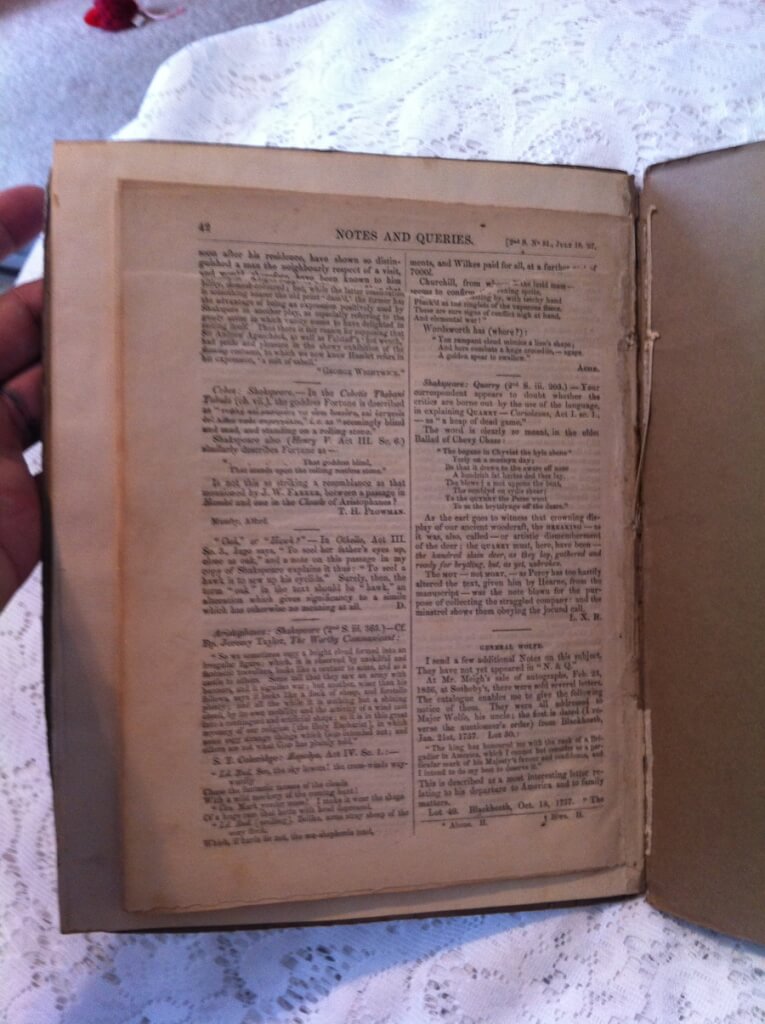
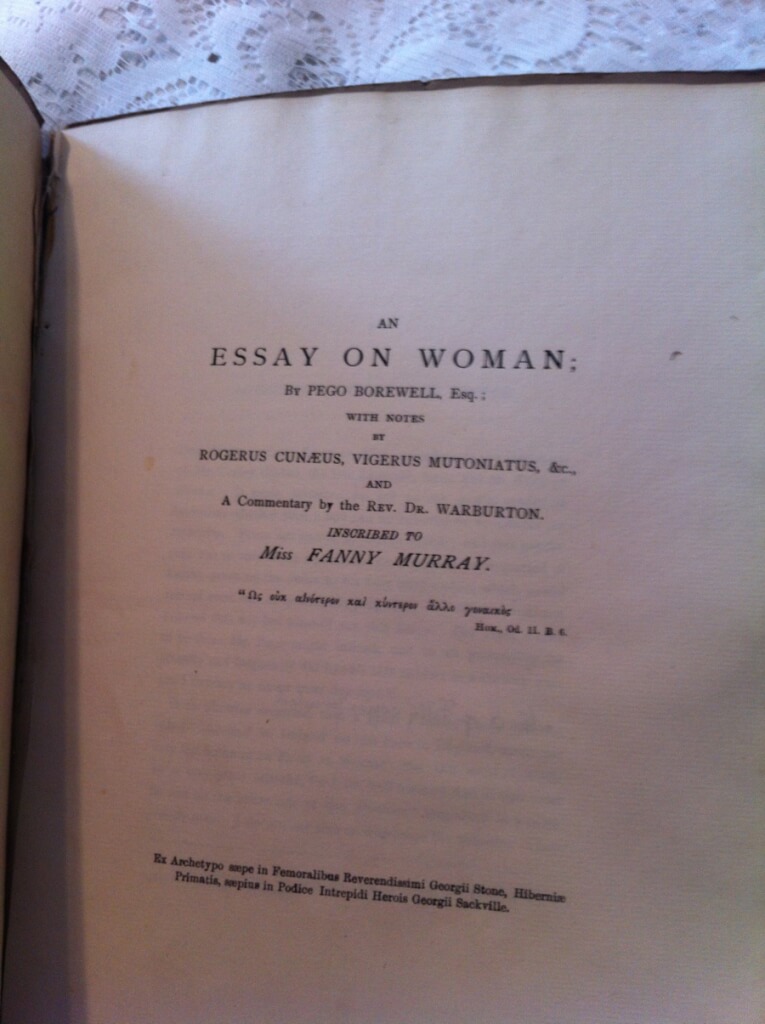 An Essay on Woman, by Pego Borewell, Esq., "with notes by Rogerus Cuneaus, Vigerus Mutoniatus, & Co. and A Commentary by the Rev. Dr. Warburton, inscribed to Miss Fanny Murray (np, bibliography on last page dated 1883) 7.5" X 9.75", 24pp., original soft wraps appear to be enclosed in brown wrap, appear to be two pages cut out before the title page, articles from "Notes and Queries" (dating July 11, 1857 and July 18, 1857) pasted into back of the book, followed by notes on legal paper from previous owner presumably trying to verify this edition Sometime in 1755, John Wilkes, together with fellow rake and son of the Archbishop of Cantebury, Thomas Potter (c. 1718-1759), composed a bawdy set of parodied Alexander Pope poems entitled An Essay on Woman, a satirical imitation of Pope's An Essay on Man. In 1763 he was put in jail for political reasons ("seditious libel for his anti-Jacobite smearing which appeared in his 'radical' weekly publication"). Upon release, his home was unlawfully searched and proofs of his "Essay on Woman" was discovered. This is an unknown reprint, as no original is known. I am still researching.
An Essay on Woman, by Pego Borewell, Esq., "with notes by Rogerus Cuneaus, Vigerus Mutoniatus, & Co. and A Commentary by the Rev. Dr. Warburton, inscribed to Miss Fanny Murray (np, bibliography on last page dated 1883) 7.5" X 9.75", 24pp., original soft wraps appear to be enclosed in brown wrap, appear to be two pages cut out before the title page, articles from "Notes and Queries" (dating July 11, 1857 and July 18, 1857) pasted into back of the book, followed by notes on legal paper from previous owner presumably trying to verify this edition Sometime in 1755, John Wilkes, together with fellow rake and son of the Archbishop of Cantebury, Thomas Potter (c. 1718-1759), composed a bawdy set of parodied Alexander Pope poems entitled An Essay on Woman, a satirical imitation of Pope's An Essay on Man. In 1763 he was put in jail for political reasons ("seditious libel for his anti-Jacobite smearing which appeared in his 'radical' weekly publication"). Upon release, his home was unlawfully searched and proofs of his "Essay on Woman" was discovered. This is an unknown reprint, as no original is known. I am still researching. -
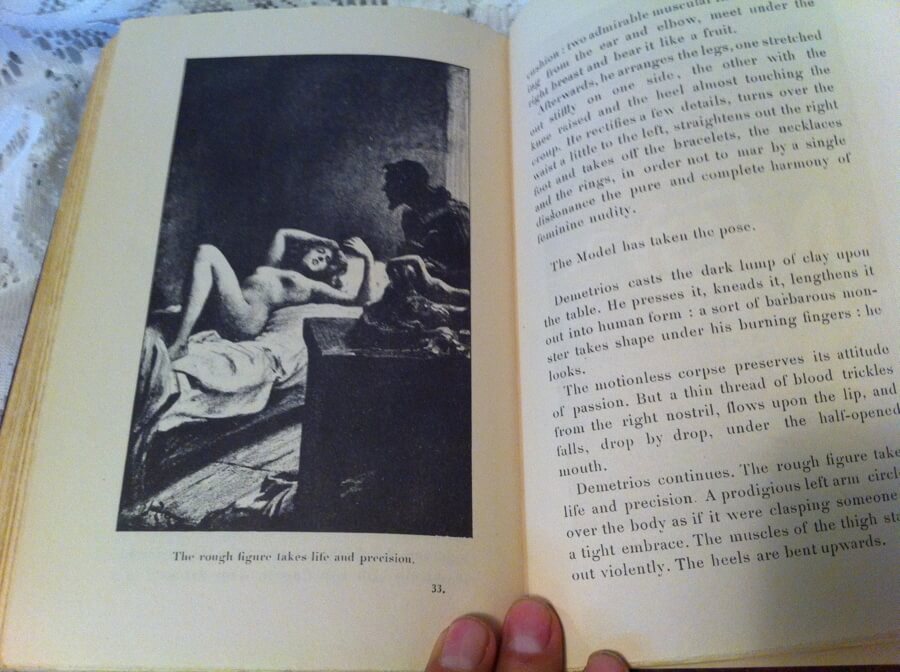
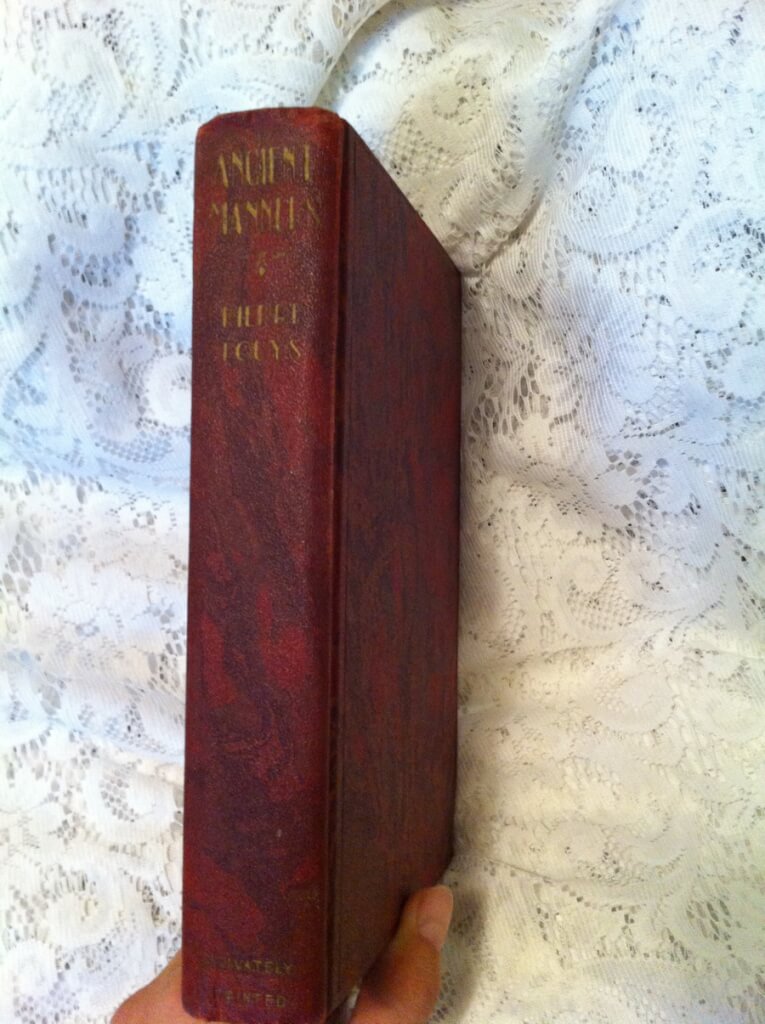 Ancient Manners, Pierre Louys (Privately printed for Subscribers only, Paris, nd. [c. 1920] ) 9.25" X 6", xvi 412pp, hardbound in marbled simulated leather cloth, edges deckled. Very good condition. Stated one of 1000, unnumbered. Owner's signature on front pastedown "E. D. York | Feb. 29, 1944." Pierre Louys (1870 - 1925) was a French poet and writer, most renowned for lesbian and classical themes in some of his writings. He is known as a writer who "expressed pagan sensuality with stylistic perfection." "Aphrodite: mæurs antiques" (Ancient Manners) is a "libertine" story set in ancient Alexandria. Highlights include the loves of Chrysis, an orgy banquet ending in the crucifixion of a slave, the love of two young musician girls and the festivals of Aphrodite. This edition states "This Translation of Ancient Manners was executed on the Printing Presses of Charles HERISSEY, at Evereux, (France), for Mr. Charles CARRINGTON, Paris, Bookseller et Publisher, and is the only complete English version extant." This is obviously a pirated copy of that edition.
Ancient Manners, Pierre Louys (Privately printed for Subscribers only, Paris, nd. [c. 1920] ) 9.25" X 6", xvi 412pp, hardbound in marbled simulated leather cloth, edges deckled. Very good condition. Stated one of 1000, unnumbered. Owner's signature on front pastedown "E. D. York | Feb. 29, 1944." Pierre Louys (1870 - 1925) was a French poet and writer, most renowned for lesbian and classical themes in some of his writings. He is known as a writer who "expressed pagan sensuality with stylistic perfection." "Aphrodite: mæurs antiques" (Ancient Manners) is a "libertine" story set in ancient Alexandria. Highlights include the loves of Chrysis, an orgy banquet ending in the crucifixion of a slave, the love of two young musician girls and the festivals of Aphrodite. This edition states "This Translation of Ancient Manners was executed on the Printing Presses of Charles HERISSEY, at Evereux, (France), for Mr. Charles CARRINGTON, Paris, Bookseller et Publisher, and is the only complete English version extant." This is obviously a pirated copy of that edition. -
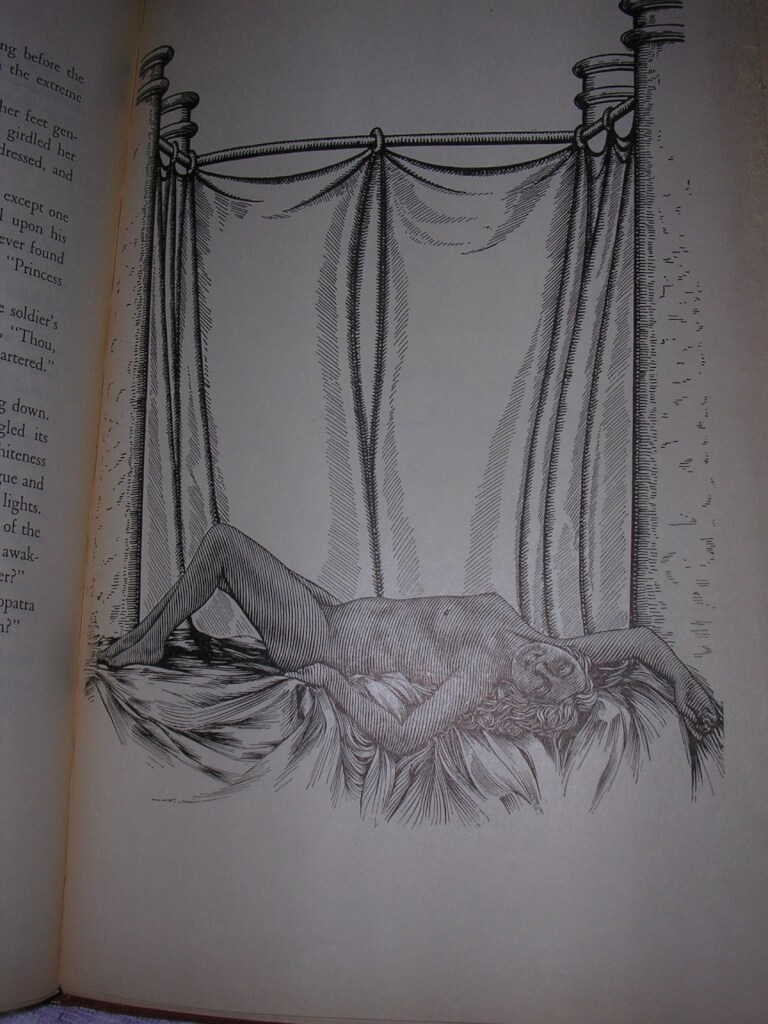
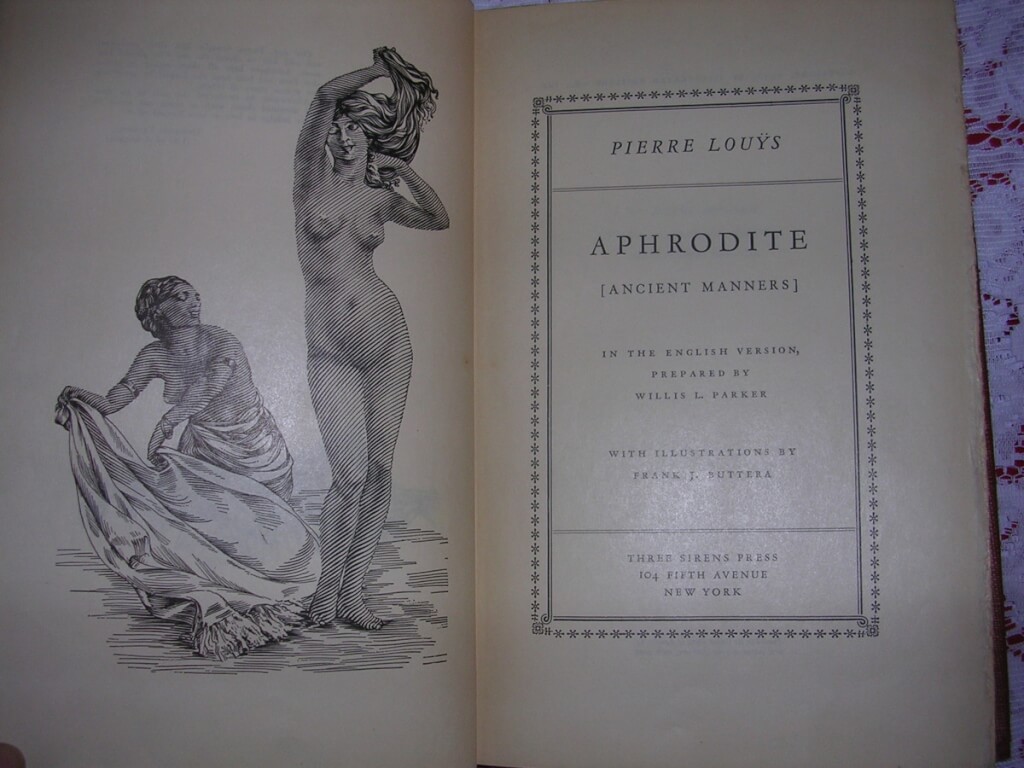 Aphrodite (Ancient Manners), Pierre Louys, trans. Willis L. Parker, illustrator Frank J. Buttera (Three Sirens Press, New York, 1932) 9 1/2" X 6 1/4", 251pp, hardbound no DJ, red cloth over boards with gilt decorations, deckle fore and bottom edge, inked top edge, very good condition, minor bumping to corners Pierre Louys (1870 - 1925) was a French poet and writer, most renowned for lesbian and classical themes in some of his writings. He is known as a writer who "expressed pagan sensuality with stylistic perfection." "Aphrodite: mæurs antiques" (Ancient Manners) is a "libertine" story set in ancient Alexandria. Highlights include the loves of Chrysis, an orgy banquet ending in the crucifixion of a slave, the love of two young musician girls and the festivals of Aphrodite. This edition is illustrated by Frank J. Buttera
Aphrodite (Ancient Manners), Pierre Louys, trans. Willis L. Parker, illustrator Frank J. Buttera (Three Sirens Press, New York, 1932) 9 1/2" X 6 1/4", 251pp, hardbound no DJ, red cloth over boards with gilt decorations, deckle fore and bottom edge, inked top edge, very good condition, minor bumping to corners Pierre Louys (1870 - 1925) was a French poet and writer, most renowned for lesbian and classical themes in some of his writings. He is known as a writer who "expressed pagan sensuality with stylistic perfection." "Aphrodite: mæurs antiques" (Ancient Manners) is a "libertine" story set in ancient Alexandria. Highlights include the loves of Chrysis, an orgy banquet ending in the crucifixion of a slave, the love of two young musician girls and the festivals of Aphrodite. This edition is illustrated by Frank J. Buttera -
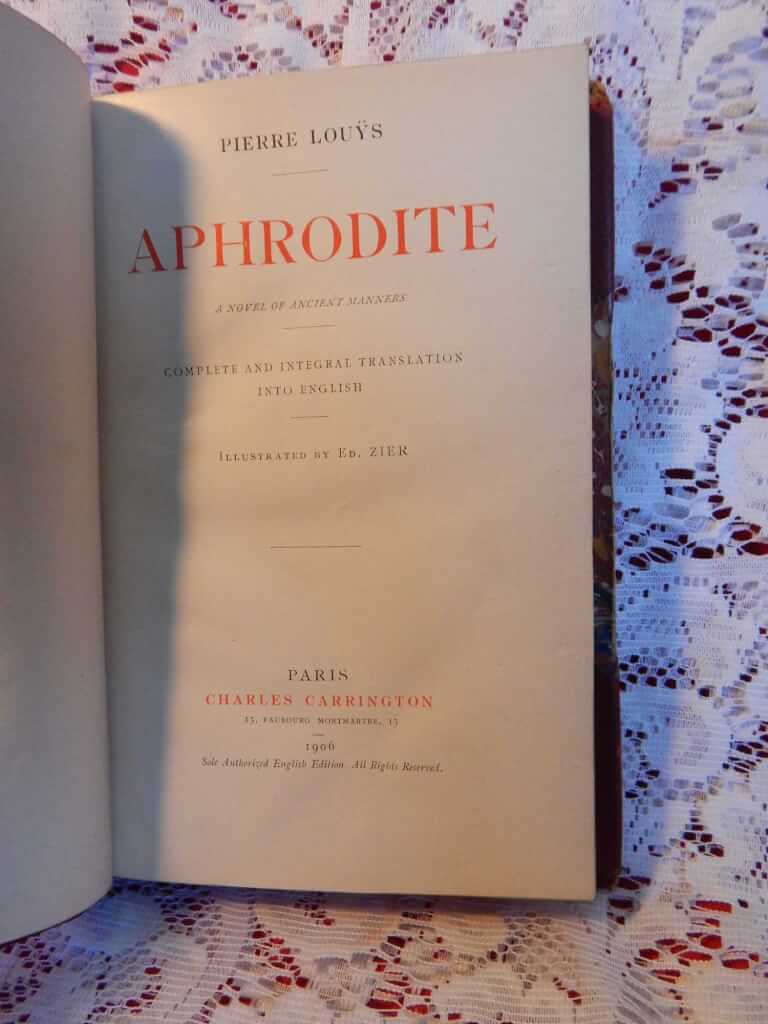
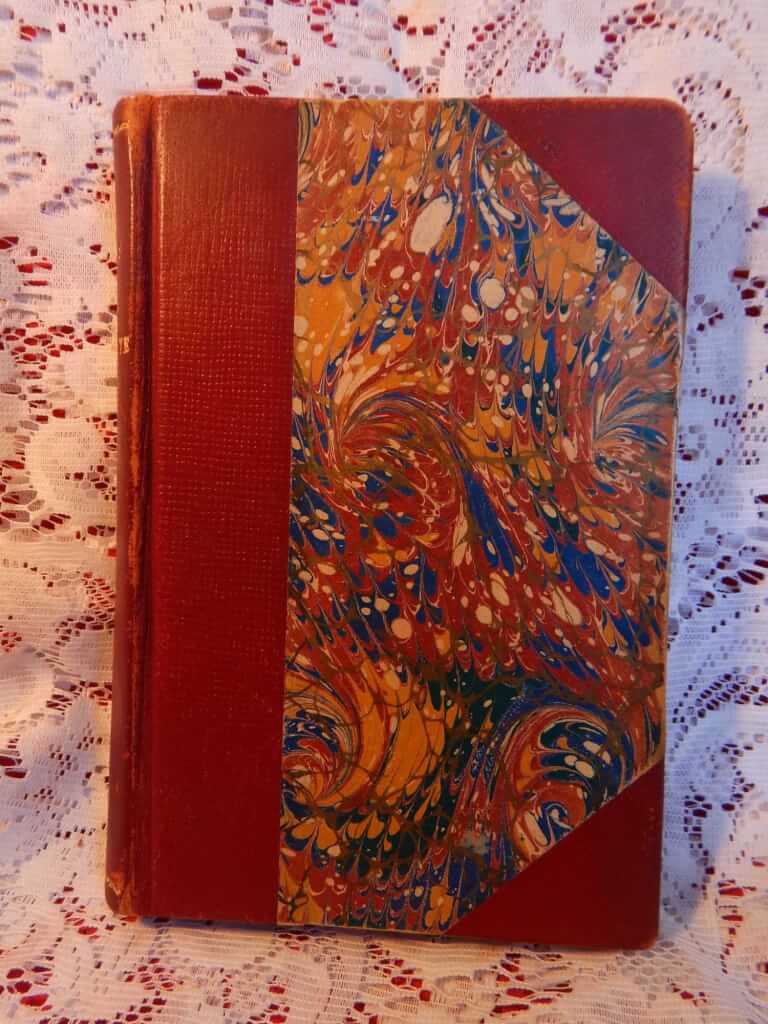 Aphrodite, a novel of ancient manners, by Pierre Louÿs, illus. Ed. Zier (Charles Carrington, 1906, first edition thus, first English translation) 5.25 x 8", 412pp, marbled boards with three quarter red cloth, gilt lettering and decoration on spine, very good condition for age, some slight bumping/scuffing Pierre Louys (1870 - 1925) was a French poet and writer, most renowned for lesbian and classical themes in some of his writings. He is known as a writer who "expressed pagan sensuality with stylistic perfection." "Aphrodite: mæurs antiques" (Ancient Manners) is a "libertine" story set in ancient Alexandria. Highlights include the loves of Chrysis, an orgy banquet ending in the crucifixion of a slave, the love of two young musician girls and the festivals of Aphrodite. "This Translation of Aphrodite was executed on the Printing Presses of Charles Herissey, at Evreux (France), for Mr. Charles Carrington, Paris, Bookseller et Publisher, and is the only complete English version extant." Édouard François Zier, (1856-1924) was a French illustrator and painter.
Aphrodite, a novel of ancient manners, by Pierre Louÿs, illus. Ed. Zier (Charles Carrington, 1906, first edition thus, first English translation) 5.25 x 8", 412pp, marbled boards with three quarter red cloth, gilt lettering and decoration on spine, very good condition for age, some slight bumping/scuffing Pierre Louys (1870 - 1925) was a French poet and writer, most renowned for lesbian and classical themes in some of his writings. He is known as a writer who "expressed pagan sensuality with stylistic perfection." "Aphrodite: mæurs antiques" (Ancient Manners) is a "libertine" story set in ancient Alexandria. Highlights include the loves of Chrysis, an orgy banquet ending in the crucifixion of a slave, the love of two young musician girls and the festivals of Aphrodite. "This Translation of Aphrodite was executed on the Printing Presses of Charles Herissey, at Evreux (France), for Mr. Charles Carrington, Paris, Bookseller et Publisher, and is the only complete English version extant." Édouard François Zier, (1856-1924) was a French illustrator and painter. -
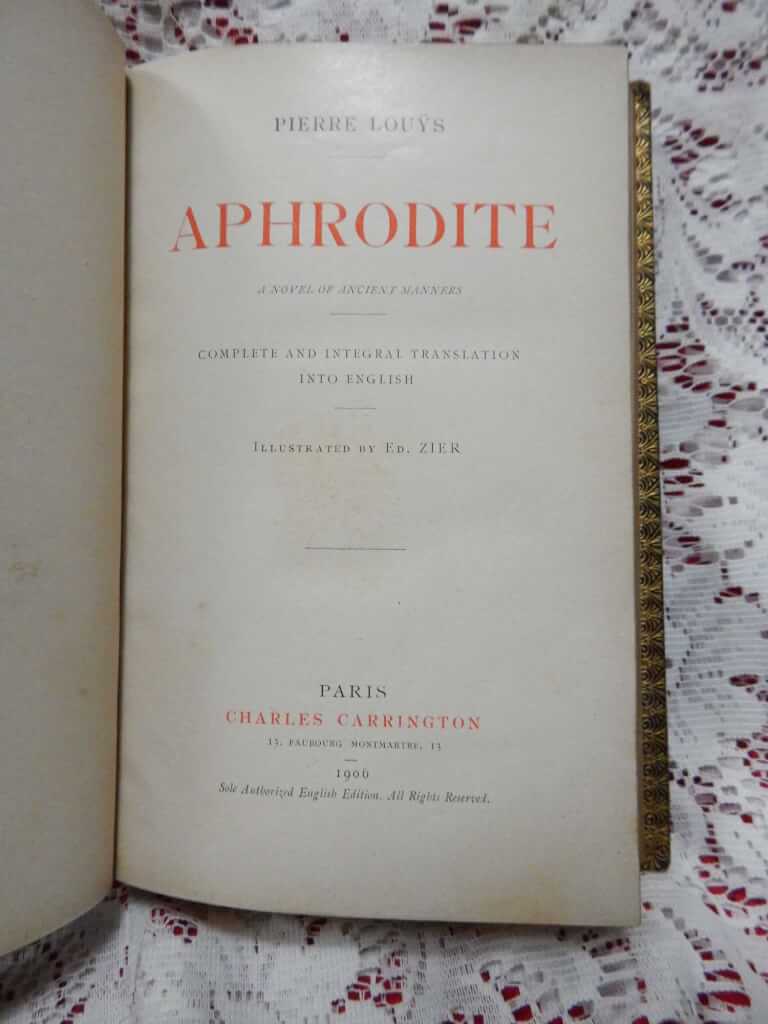
 Aphrodite, a novel of ancient manners, by Pierre Louÿs, illus. Ed. Zier (Charles Carrington, 1906, first edition thus, first English translation) 5.25 x 8", 412pp, full green moroccan, gilt lettering and decoration on spine and borders, 5 raised bands, gilt edges, gilt decorations boardering pastedown, near fine condition, some cracks in the hinges. Pierre Louys (1870 - 1925) was a French poet and writer, most renowned for lesbian and classical themes in some of his writings. He is known as a writer who "expressed pagan sensuality with stylistic perfection." "Aphrodite: mæurs antiques" (Ancient Manners) is a "libertine" story set in ancient Alexandria. Highlights include the loves of Chrysis, an orgy banquet ending in the crucifixion of a slave, the love of two young musician girls and the festivals of Aphrodite. "This Translation of Aphrodite was executed on the Printing Presses of Charles Herissey, at Evreux (France), for Mr. Charles Carrington, Paris, Bookseller et Publisher, and is the only complete English version extant." A beautiful example of this important first edition of the first translation. Very hard to find in full leather. Édouard François Zier (1856-1924) was a French illustrator and painter.
Aphrodite, a novel of ancient manners, by Pierre Louÿs, illus. Ed. Zier (Charles Carrington, 1906, first edition thus, first English translation) 5.25 x 8", 412pp, full green moroccan, gilt lettering and decoration on spine and borders, 5 raised bands, gilt edges, gilt decorations boardering pastedown, near fine condition, some cracks in the hinges. Pierre Louys (1870 - 1925) was a French poet and writer, most renowned for lesbian and classical themes in some of his writings. He is known as a writer who "expressed pagan sensuality with stylistic perfection." "Aphrodite: mæurs antiques" (Ancient Manners) is a "libertine" story set in ancient Alexandria. Highlights include the loves of Chrysis, an orgy banquet ending in the crucifixion of a slave, the love of two young musician girls and the festivals of Aphrodite. "This Translation of Aphrodite was executed on the Printing Presses of Charles Herissey, at Evreux (France), for Mr. Charles Carrington, Paris, Bookseller et Publisher, and is the only complete English version extant." A beautiful example of this important first edition of the first translation. Very hard to find in full leather. Édouard François Zier (1856-1924) was a French illustrator and painter. -
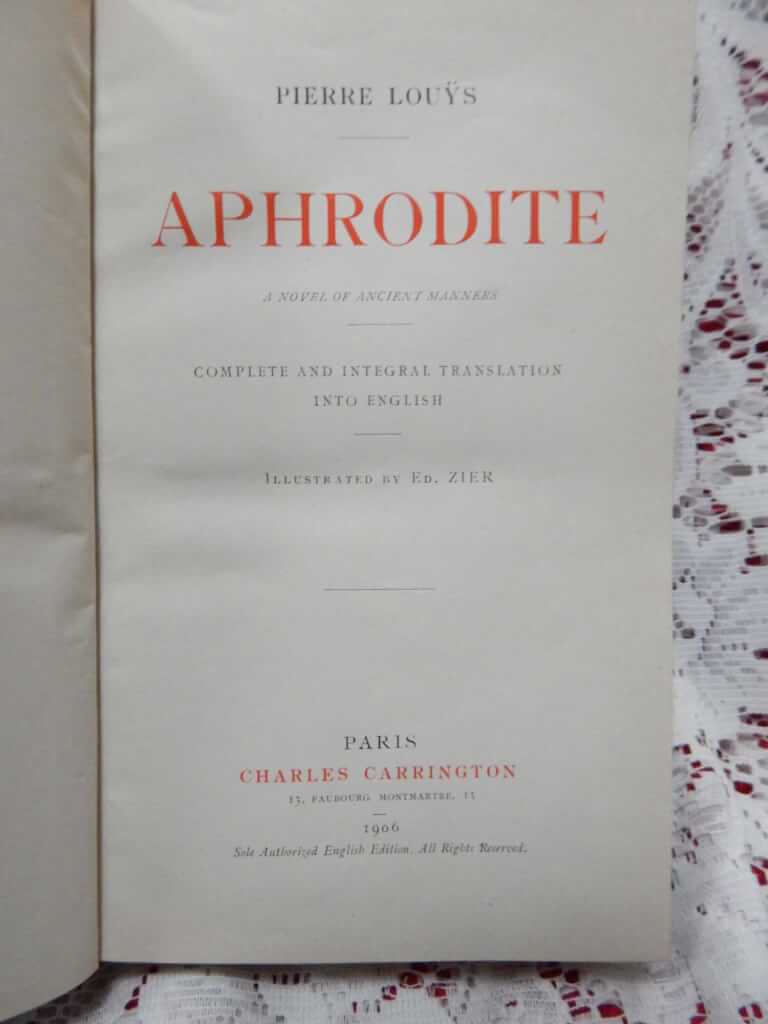
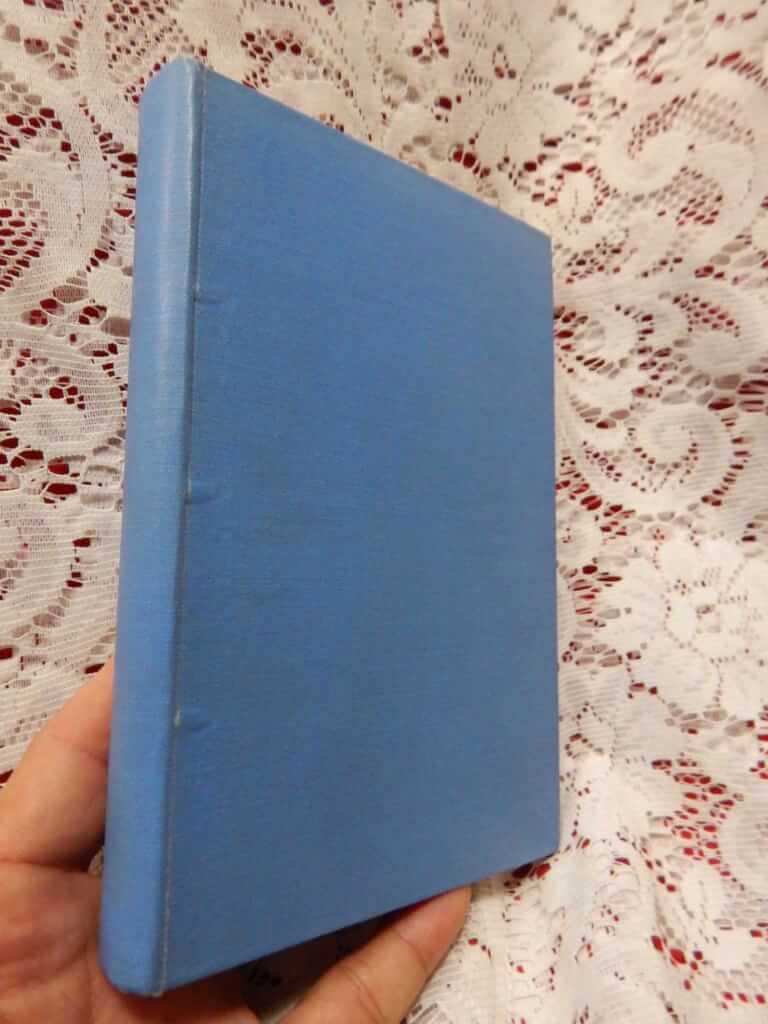 Aphrodite, a novel of ancient manners, by Pierre Louÿs, illus. Ed. Zier (Charles Carrington, 1906, first edition thus, first English translation) 5.25 x 7.75", xiv+412pp, rebound with plain blue boards, fine condition Pierre Louys (1870 - 1925) was a French poet and writer, most renowned for lesbian and classical themes in some of his writings. He is known as a writer who "expressed pagan sensuality with stylistic perfection." "Aphrodite: mæurs antiques" (Ancient Manners) is a "libertine" story set in ancient Alexandria. Highlights include the loves of Chrysis, an orgy banquet ending in the crucifixion of a slave, the love of two young musician girls and the festivals of Aphrodite. "This Translation of Aphrodite was executed on the Printing Presses of Charles Herissey, at Evreux (France), for Mr. Charles Carrington, Paris, Bookseller et Publisher, and is the only complete English version extant." Édouard François Zier (1856-1924) was a French illustrator and painter.
Aphrodite, a novel of ancient manners, by Pierre Louÿs, illus. Ed. Zier (Charles Carrington, 1906, first edition thus, first English translation) 5.25 x 7.75", xiv+412pp, rebound with plain blue boards, fine condition Pierre Louys (1870 - 1925) was a French poet and writer, most renowned for lesbian and classical themes in some of his writings. He is known as a writer who "expressed pagan sensuality with stylistic perfection." "Aphrodite: mæurs antiques" (Ancient Manners) is a "libertine" story set in ancient Alexandria. Highlights include the loves of Chrysis, an orgy banquet ending in the crucifixion of a slave, the love of two young musician girls and the festivals of Aphrodite. "This Translation of Aphrodite was executed on the Printing Presses of Charles Herissey, at Evreux (France), for Mr. Charles Carrington, Paris, Bookseller et Publisher, and is the only complete English version extant." Édouard François Zier (1856-1924) was a French illustrator and painter. -
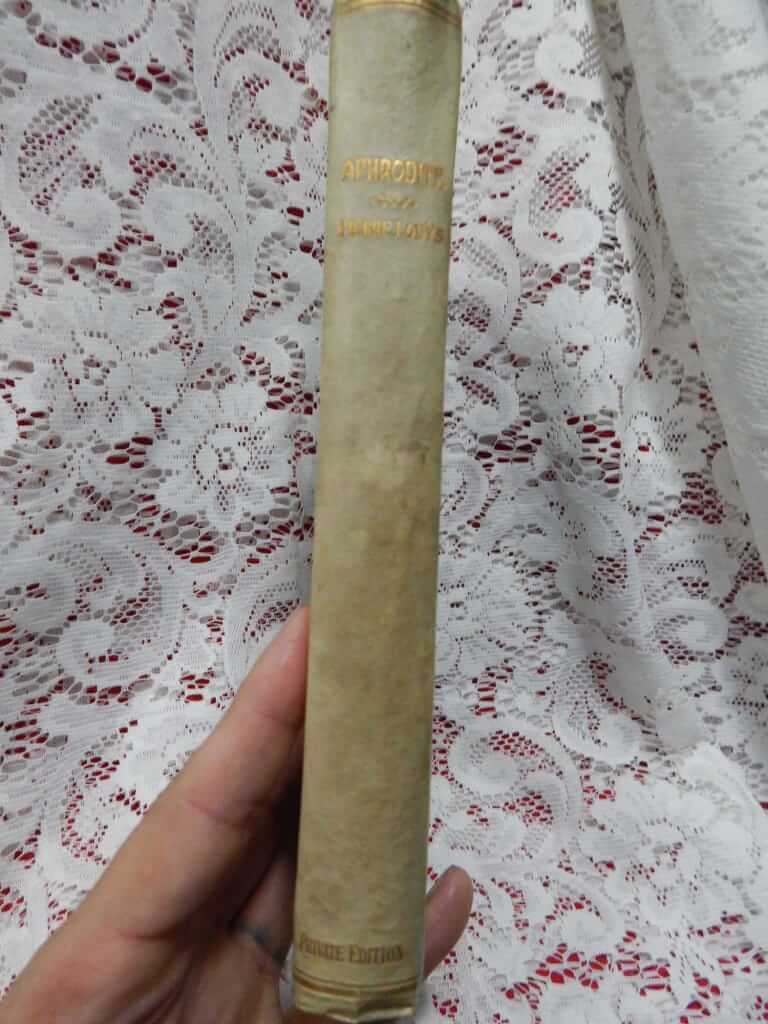
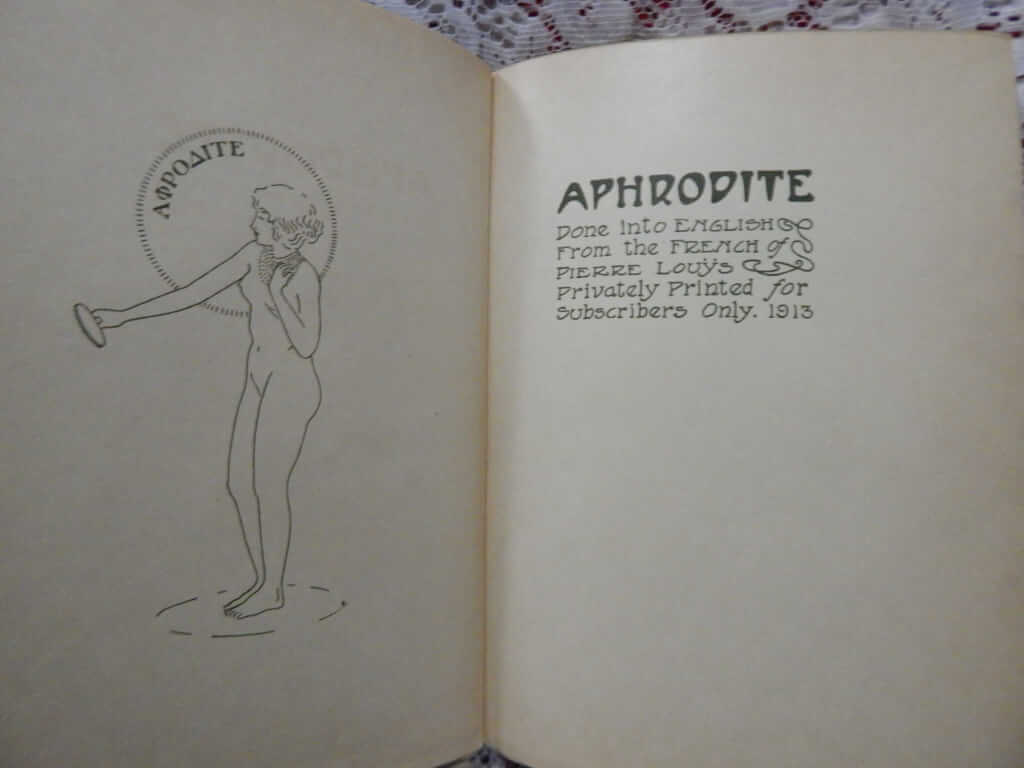 Aphrodite, done into English from the French of Pierre Louys, by Pierre Louÿs, illus. unknown, (Privately Printed for Subscribers Only[Mitchell S. Buck], 1913, #66/550) 6.5"x8.75", xi+258pp+Notes+Index, cream vellum spine over green boards, gilt titles on spine, good condition, some bumping and rubbing Buck's translation is easier to read than Carrington's translation a few years earlier. This was his first book, most likely, self-published and printed by Nicholas L. Brown. Pierre Louys (1870 - 1925) was a French poet and writer, most renowned for lesbian and classical themes in some of his writings. He is known as a writer who "expressed pagan sensuality with stylistic perfection." "Aphrodite: mæurs antiques" (Ancient Manners) is a "libertine" story set in ancient Alexandria. Highlights include the loves of Chrysis, an orgy banquet ending in the crucifixion of a slave, the love of two young musician girls and the festivals of Aphrodite." Mitchell Starrett Buck (February 10, 1887 – May 12, 1959) was an American poet, translator and classical scholar. His volumes of verse and prose poetry were deeply influenced by 1890s aestheticism as well as classical Greek and Roman Literature. Buck’s writing was secondary to his work as a heating engineer, and the money he made professionally allowed him to become a noted book-collector, specializing in first editions, English literature, Greek and Latin classics. Buck’s first book was a translation of Aphrodite by the French decadent Pierre Louÿs (1870-1925). It appeared in 1913, and was “privately printed”, probably at Buck’s expense. It may have been arranged through the Philadelphia bookseller Nicholas L. Brown, who officially became a publisher in 1916, and thereafter issued most of Buck’s output. Between 1916 and 1932, Brown published small editions of poetry, belles lettres, translations, sometimes without his imprint but stating that the title has been “issued privately for subscribers” (in order to evade prosecution for dealing in obscene materials). Such classical erotica is very tame by modern standards, but in the teens and twenties such material was policed by self-appointed authorities such as John S. Sumner of the New York Society for the Suppression of Vice.
Aphrodite, done into English from the French of Pierre Louys, by Pierre Louÿs, illus. unknown, (Privately Printed for Subscribers Only[Mitchell S. Buck], 1913, #66/550) 6.5"x8.75", xi+258pp+Notes+Index, cream vellum spine over green boards, gilt titles on spine, good condition, some bumping and rubbing Buck's translation is easier to read than Carrington's translation a few years earlier. This was his first book, most likely, self-published and printed by Nicholas L. Brown. Pierre Louys (1870 - 1925) was a French poet and writer, most renowned for lesbian and classical themes in some of his writings. He is known as a writer who "expressed pagan sensuality with stylistic perfection." "Aphrodite: mæurs antiques" (Ancient Manners) is a "libertine" story set in ancient Alexandria. Highlights include the loves of Chrysis, an orgy banquet ending in the crucifixion of a slave, the love of two young musician girls and the festivals of Aphrodite." Mitchell Starrett Buck (February 10, 1887 – May 12, 1959) was an American poet, translator and classical scholar. His volumes of verse and prose poetry were deeply influenced by 1890s aestheticism as well as classical Greek and Roman Literature. Buck’s writing was secondary to his work as a heating engineer, and the money he made professionally allowed him to become a noted book-collector, specializing in first editions, English literature, Greek and Latin classics. Buck’s first book was a translation of Aphrodite by the French decadent Pierre Louÿs (1870-1925). It appeared in 1913, and was “privately printed”, probably at Buck’s expense. It may have been arranged through the Philadelphia bookseller Nicholas L. Brown, who officially became a publisher in 1916, and thereafter issued most of Buck’s output. Between 1916 and 1932, Brown published small editions of poetry, belles lettres, translations, sometimes without his imprint but stating that the title has been “issued privately for subscribers” (in order to evade prosecution for dealing in obscene materials). Such classical erotica is very tame by modern standards, but in the teens and twenties such material was policed by self-appointed authorities such as John S. Sumner of the New York Society for the Suppression of Vice. -
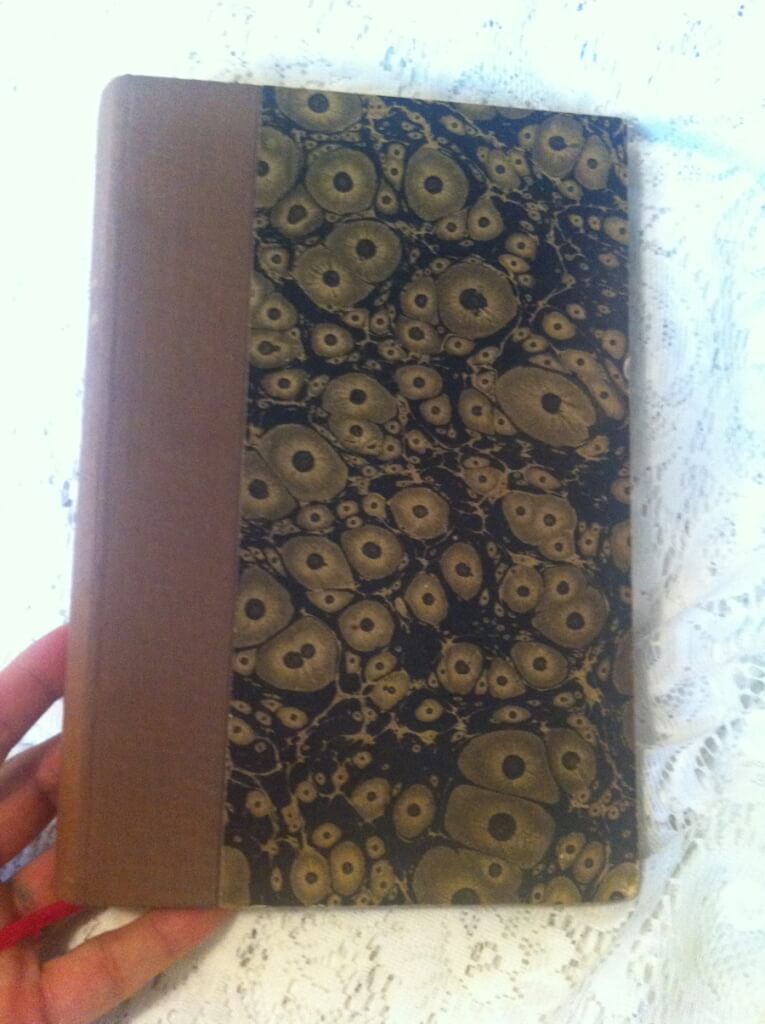
 Aphrodite, mœurs antiques, by Pierre Louÿs, illus. Eduard Zier (Librairie Illustree, J. Tallandier, Éditeur, nd [c. 1900], Paris, printed by Charles Hérissey, engravings executed by Ruckert et Cie, on Champon, Bichelberger et Cie ) 6.75" x 10", 374pp, hardbound in half buckram over marbled boards, very good condition for age, some bumping to boards and foxing throughout pages, red ribbon intact Pierre Louys (1870 - 1925) was a French poet and writer, most renowned for lesbian and classical themes in some of his writings. He is known as a writer who "expressed pagan sensuality with stylistic perfection." "Aphrodite: mæurs antiques" (Ancient Manners) is a "libertine" story set in ancient Alexandria. Highlights include the loves of Chrysis, an orgy banquet ending in the crucifixion of a slave, the love of two young musician girls and the festivals of Aphrodite.
Aphrodite, mœurs antiques, by Pierre Louÿs, illus. Eduard Zier (Librairie Illustree, J. Tallandier, Éditeur, nd [c. 1900], Paris, printed by Charles Hérissey, engravings executed by Ruckert et Cie, on Champon, Bichelberger et Cie ) 6.75" x 10", 374pp, hardbound in half buckram over marbled boards, very good condition for age, some bumping to boards and foxing throughout pages, red ribbon intact Pierre Louys (1870 - 1925) was a French poet and writer, most renowned for lesbian and classical themes in some of his writings. He is known as a writer who "expressed pagan sensuality with stylistic perfection." "Aphrodite: mæurs antiques" (Ancient Manners) is a "libertine" story set in ancient Alexandria. Highlights include the loves of Chrysis, an orgy banquet ending in the crucifixion of a slave, the love of two young musician girls and the festivals of Aphrodite. -
 Aristophanes: Lysistrata, Aristophanes, illus. by Aubrey Beardsley (Beardsley Press, 1927, one of 750 unnumbered) 8.25″ x 11.5″, 99pp, quarter silver over black cloth, with silver and black patterned endpapers, black lettering to spine, good condition for age, bumping and scraping present, Beardsley’s prints are tipped in. Aristophanes was the greatest writer of ancient Athenian “old comedy,” known for its satires of contemporary life and for its broad, often obscene humor. Lysistrata was first produced in 411 BC, when the Peloponnesian War had been devastating Greece for 20 years. Most people know the plot: Lysistrata assembles women from all of Greece, and they agree that they will not have sex until the men make peace. Aubrey Beardsley was the greatest and the most controversial Art Nouveau illustrator in England, famous for his illustrations of Mallory’s Morte d’Arthur, Oscar Wilde’s Salome, Pope’s The Rape of the Lock, and for several magazines. Because he was associated with Oscar Wilde, Beardsley lost his job as art editor of a magazine named The Yellow Book in 1895, soon after Wilde was arrested for homosexuality. He was approached by Leonard Smithers, a publisher of erotic books, who asked him to illustrate Lysistrata. His illustrations are very much in the spirit of Aristophanes, as funny as they are obscene. Beardsley converted to Catholicism in 1897, and soon after, he asked Smithers to “destroy all copies of Lysistrata” with its “obscene drawings,” but Smithers refused. Beardsley died of tuberculosis in 1898, at the age of 26. Smithers initially published Lysistrata in a limited edition of one hundred copies. It was occasionally reprinted in very small runs, usually clandestinely, often poorly, but copies have long been scarce and expensive. Few copies of Beardsley’s Lysistrata printed before 1966 are currently in circulation. This copy is a rare limited edition printed by the Beardsley Press, London and even rarer with the binding intact.
Aristophanes: Lysistrata, Aristophanes, illus. by Aubrey Beardsley (Beardsley Press, 1927, one of 750 unnumbered) 8.25″ x 11.5″, 99pp, quarter silver over black cloth, with silver and black patterned endpapers, black lettering to spine, good condition for age, bumping and scraping present, Beardsley’s prints are tipped in. Aristophanes was the greatest writer of ancient Athenian “old comedy,” known for its satires of contemporary life and for its broad, often obscene humor. Lysistrata was first produced in 411 BC, when the Peloponnesian War had been devastating Greece for 20 years. Most people know the plot: Lysistrata assembles women from all of Greece, and they agree that they will not have sex until the men make peace. Aubrey Beardsley was the greatest and the most controversial Art Nouveau illustrator in England, famous for his illustrations of Mallory’s Morte d’Arthur, Oscar Wilde’s Salome, Pope’s The Rape of the Lock, and for several magazines. Because he was associated with Oscar Wilde, Beardsley lost his job as art editor of a magazine named The Yellow Book in 1895, soon after Wilde was arrested for homosexuality. He was approached by Leonard Smithers, a publisher of erotic books, who asked him to illustrate Lysistrata. His illustrations are very much in the spirit of Aristophanes, as funny as they are obscene. Beardsley converted to Catholicism in 1897, and soon after, he asked Smithers to “destroy all copies of Lysistrata” with its “obscene drawings,” but Smithers refused. Beardsley died of tuberculosis in 1898, at the age of 26. Smithers initially published Lysistrata in a limited edition of one hundred copies. It was occasionally reprinted in very small runs, usually clandestinely, often poorly, but copies have long been scarce and expensive. Few copies of Beardsley’s Lysistrata printed before 1966 are currently in circulation. This copy is a rare limited edition printed by the Beardsley Press, London and even rarer with the binding intact. -
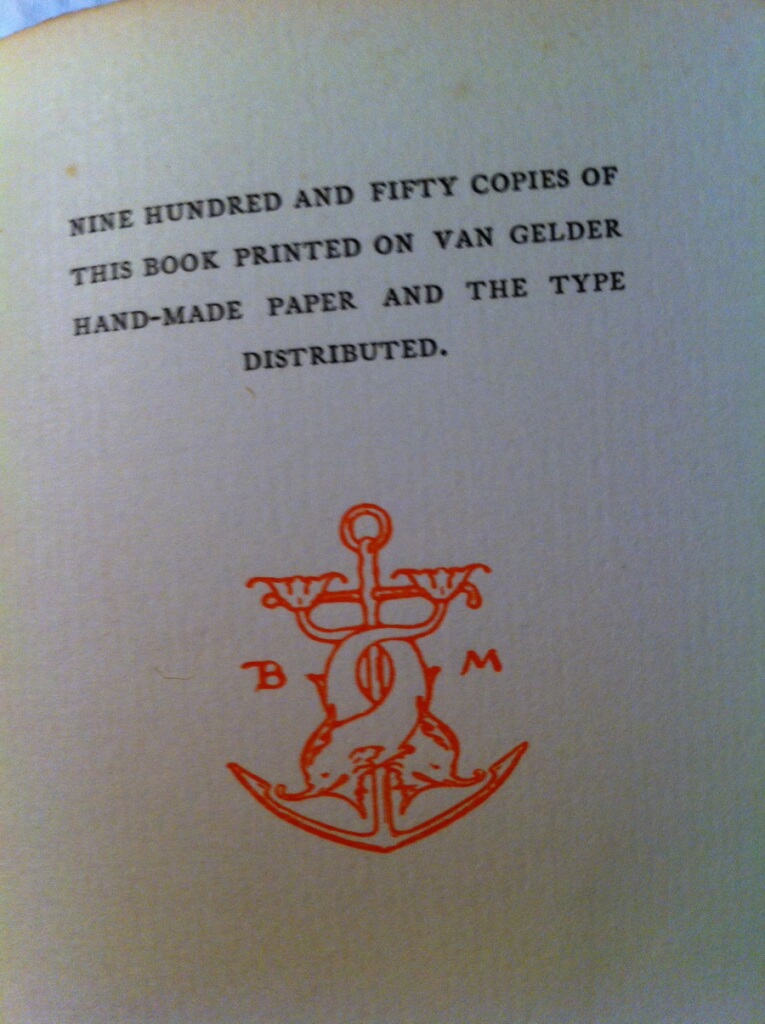
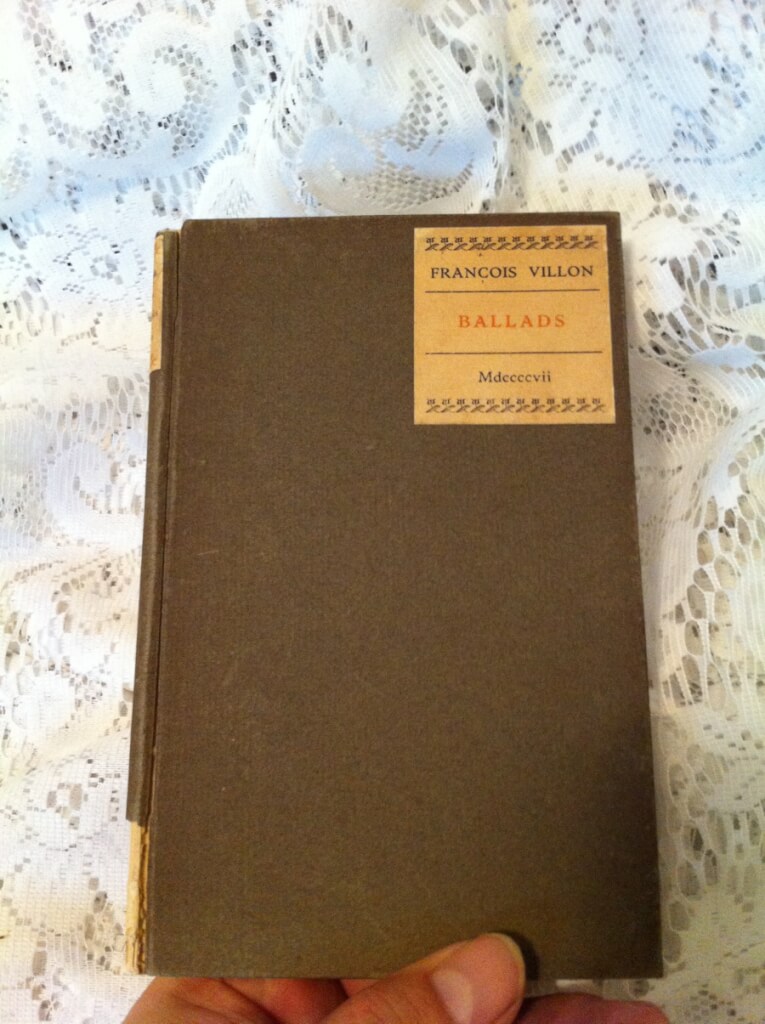 Ballands Done Into English from the French of Francois Villon, Francois Villon (Thomas B. Mosher, 1907) 7" X 4.5", 43pp, hardbound, grey boards with paper labels on cover and spine. Fair condition for age, spine loose on one side but holding, hinges good, fore and bottom edges deckled, owner's signatures on front pastedown François Villon (c. 1431_1464) was a French poet. Most of what is known about Villon has been gathered from legal records and gleaned from his own writings. He was a thief, killer, barroom brawler, and vagabond. He is perhaps best known for his Testaments and his Ballades. He was the most famous realist poet of the Middle Ages.
Ballands Done Into English from the French of Francois Villon, Francois Villon (Thomas B. Mosher, 1907) 7" X 4.5", 43pp, hardbound, grey boards with paper labels on cover and spine. Fair condition for age, spine loose on one side but holding, hinges good, fore and bottom edges deckled, owner's signatures on front pastedown François Villon (c. 1431_1464) was a French poet. Most of what is known about Villon has been gathered from legal records and gleaned from his own writings. He was a thief, killer, barroom brawler, and vagabond. He is perhaps best known for his Testaments and his Ballades. He was the most famous realist poet of the Middle Ages. -
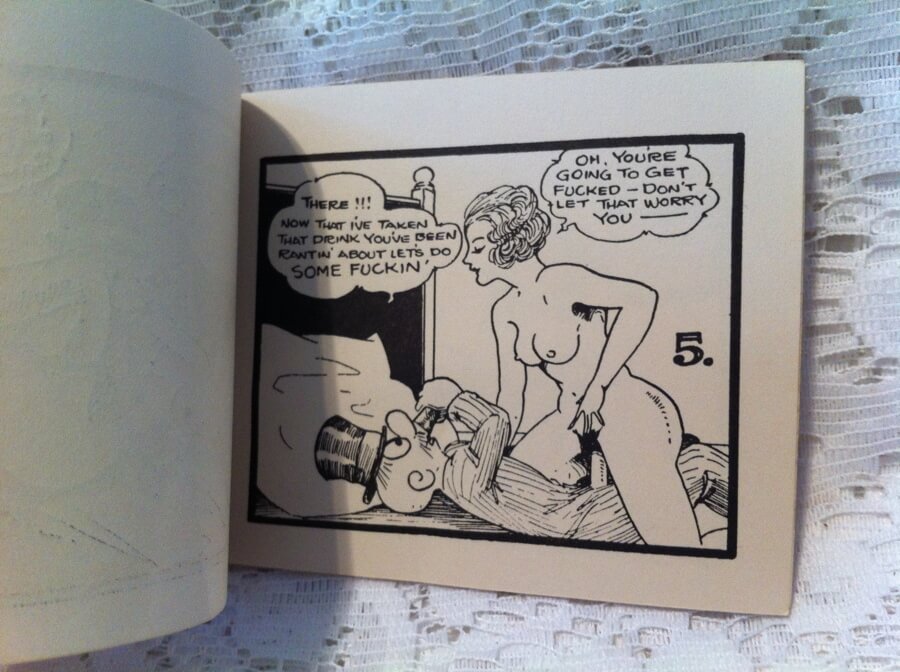
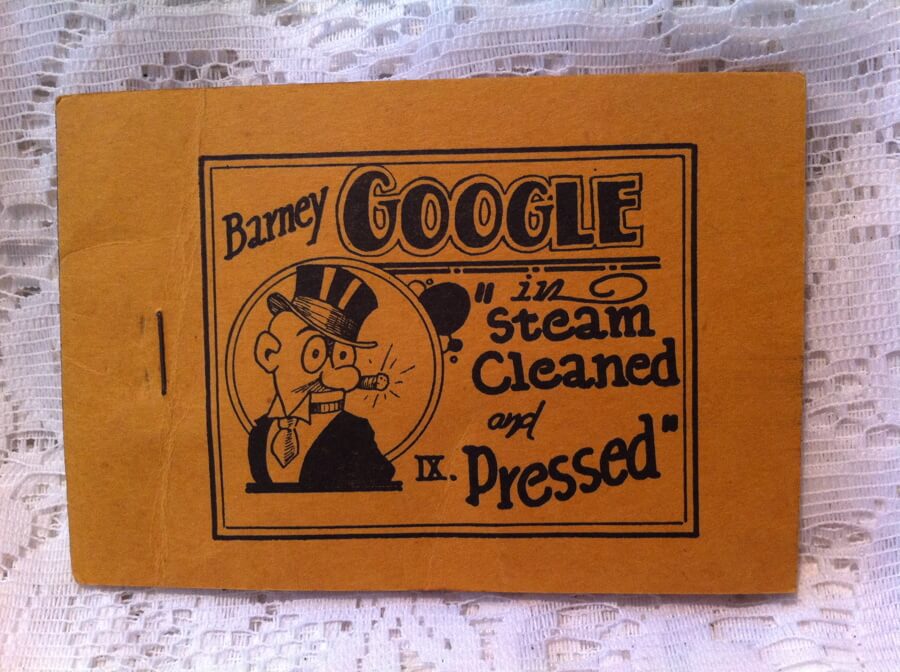 Barney Google in "Steam Cleaned and Pressed", (n.p. n.d.) 4.5" x 3", 8pp. pamphlet, stapled Tijuana bibles (also known as eight-pagers, bluesies, gray-backs, Jiggs-and-Maggie books, jo-jo books, Tillie-and-Mac books, and two-by-fours) were little pornographic comic books produced in the United States from the 1920s to the early 1960s. This parodies "Barney Google and Snuffy Smith" an widely read (even today) comic strip that has been around since 1919.
Barney Google in "Steam Cleaned and Pressed", (n.p. n.d.) 4.5" x 3", 8pp. pamphlet, stapled Tijuana bibles (also known as eight-pagers, bluesies, gray-backs, Jiggs-and-Maggie books, jo-jo books, Tillie-and-Mac books, and two-by-fours) were little pornographic comic books produced in the United States from the 1920s to the early 1960s. This parodies "Barney Google and Snuffy Smith" an widely read (even today) comic strip that has been around since 1919. -
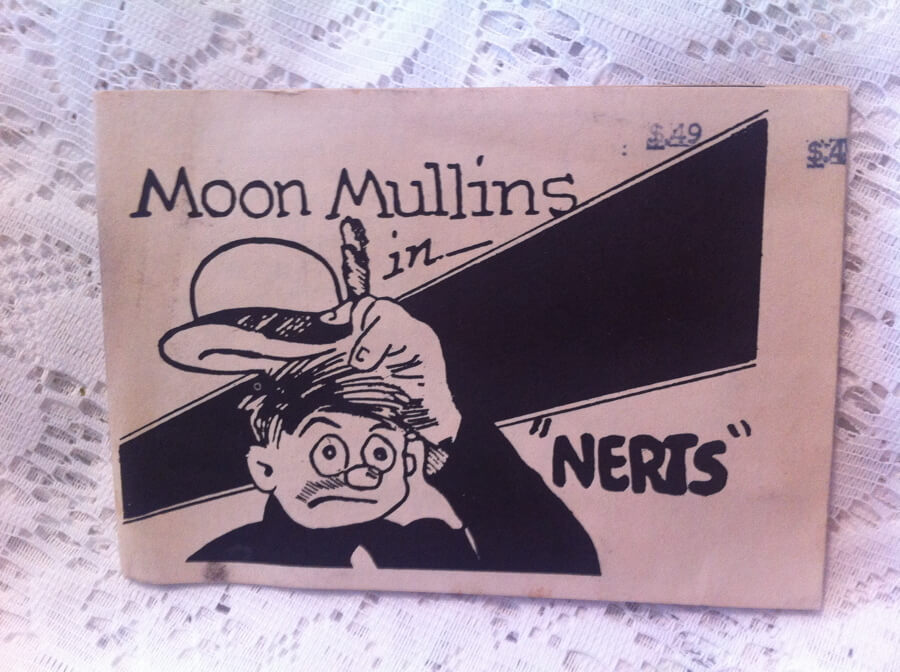
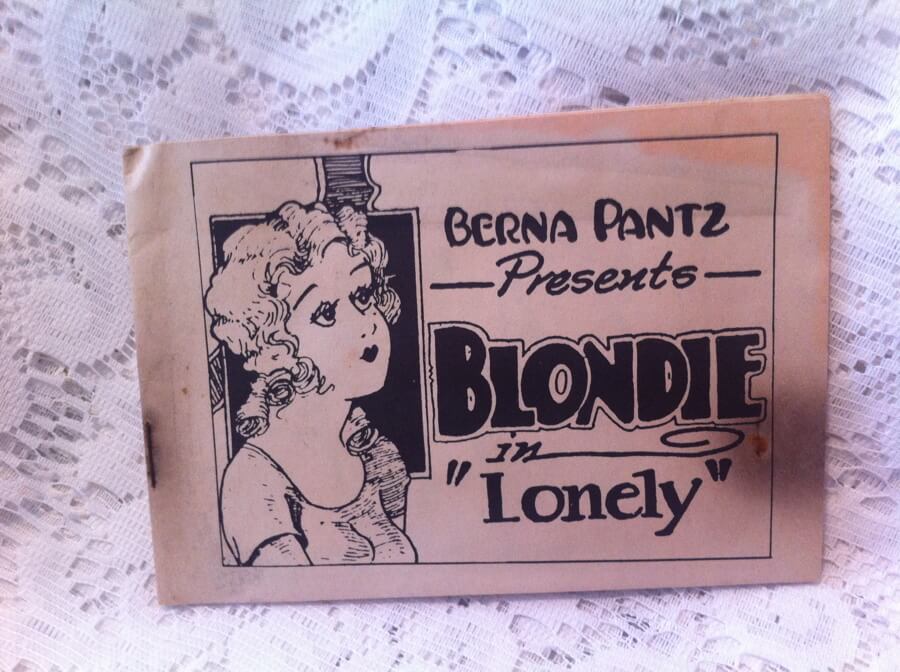 Berna Pantz Presents Blondie in "Lonely" / Moon Mullins in "Nerts", (n.p., n.d.) 5" x 3.5", 8pp. double pamphlet, stapled Tijuana bibles (also known as eight-pagers, bluesies, gray-backs, Jiggs-and-Maggie books, jo-jo books, Tillie-and-Mac books, and two-by-fours) were little pornographic comic books produced in the United States from the 1920s to the early 1960s. This book is two books in one, featuring reprints of the originals printed on both sides of the paper. Flip the book over and it's a different book.
Berna Pantz Presents Blondie in "Lonely" / Moon Mullins in "Nerts", (n.p., n.d.) 5" x 3.5", 8pp. double pamphlet, stapled Tijuana bibles (also known as eight-pagers, bluesies, gray-backs, Jiggs-and-Maggie books, jo-jo books, Tillie-and-Mac books, and two-by-fours) were little pornographic comic books produced in the United States from the 1920s to the early 1960s. This book is two books in one, featuring reprints of the originals printed on both sides of the paper. Flip the book over and it's a different book. -

 Berna Pantz Presents Blondie in "Lonely" / Moon Mullins in "Nerts", (n.p., n.d.) 5" x 3.5", 8pp. double pamphlet, stapled Tijuana bibles (also known as eight-pagers, bluesies, gray-backs, Jiggs-and-Maggie books, jo-jo books, Tillie-and-Mac books, and two-by-fours) were little pornographic comic books produced in the United States from the 1920s to the early 1960s. This book is two books in one, featuring reprints of the originals printed on both sides of the paper. Flip the book over and it's a different book.
Berna Pantz Presents Blondie in "Lonely" / Moon Mullins in "Nerts", (n.p., n.d.) 5" x 3.5", 8pp. double pamphlet, stapled Tijuana bibles (also known as eight-pagers, bluesies, gray-backs, Jiggs-and-Maggie books, jo-jo books, Tillie-and-Mac books, and two-by-fours) were little pornographic comic books produced in the United States from the 1920s to the early 1960s. This book is two books in one, featuring reprints of the originals printed on both sides of the paper. Flip the book over and it's a different book. -
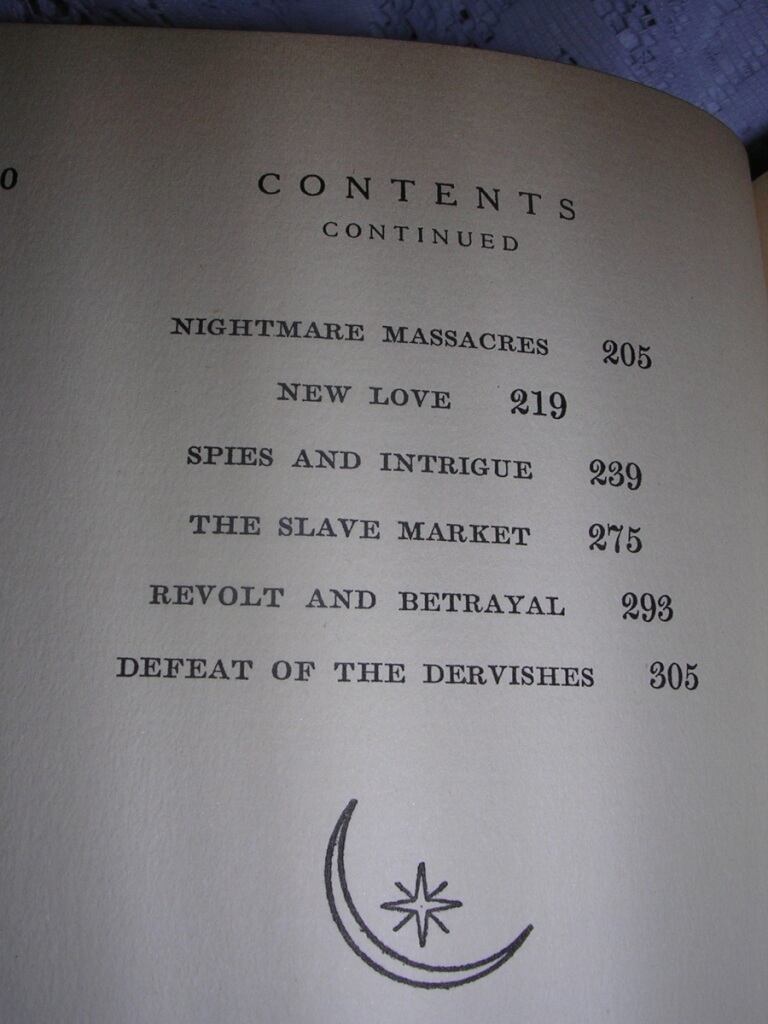
 Black Lust, Jean de Villiot [George Grassal (Hugues Rebell)] (Privately printed by The Panurge Press, Inc., New York, 1931, #365/2000) 8 5/8" X 6", 312pp, hardbound no DJ, cream cloth boards with black stamped decorations, top edge dyed blue, other edges deckle, good condition, slight soiling to boards, binding tight Jean de Villiot was a pseudonym used by several authors and compilers working for the publisher Charles Carrington writing novels and "studies" concerning flagellation, including Hugues Rebell (Georges Grassal), Hector France, Stéphane Arnoulin and Charles Carrington, himself. This novel is attributed to George Grassal (Hugues Rebell) originally written in French, in 1902, as "La Femme et son maître" (The Woman and her Master). In 1904 "Woman and her Master" was published in English by Charles Carrington. Panurge Press published this work as "Black Lust" in 1931. This book is a numbered limited edition copy of the Panurge Press edition.
Black Lust, Jean de Villiot [George Grassal (Hugues Rebell)] (Privately printed by The Panurge Press, Inc., New York, 1931, #365/2000) 8 5/8" X 6", 312pp, hardbound no DJ, cream cloth boards with black stamped decorations, top edge dyed blue, other edges deckle, good condition, slight soiling to boards, binding tight Jean de Villiot was a pseudonym used by several authors and compilers working for the publisher Charles Carrington writing novels and "studies" concerning flagellation, including Hugues Rebell (Georges Grassal), Hector France, Stéphane Arnoulin and Charles Carrington, himself. This novel is attributed to George Grassal (Hugues Rebell) originally written in French, in 1902, as "La Femme et son maître" (The Woman and her Master). In 1904 "Woman and her Master" was published in English by Charles Carrington. Panurge Press published this work as "Black Lust" in 1931. This book is a numbered limited edition copy of the Panurge Press edition. -

 Casanova's Memoirs, by Casanova, Ed. Joseph Monét, illus. Vincente Minnilli (Willey Book Company, New York, 1946) 6.25"x9.25", 290pp, mylar protected DJ with some rips and tears over red boards with gilt lettering, boards loose but holding Giovanni Giacomo Casanova (1725-1798) was an ecclesiastic, writer, soldier, spy, and diplomatist, chiefly remembered as the prince of Italian adventurers and as the man who made the name Casanova synonymous with "libertine." His autobiography, which perhaps exaggerates some of his escapades, is a splendid description of 18th-century society in the capitals of Europe. As far as I can tell this is the only illustration work done by Vincente Minnelli [obscure at the time but later famous director and husband of Judy Garland]. It was done soon after he moved to New York from Chicago and before he landed a steady job at Radio City Music Hall. In his autobiography he described the work as "in the Aubrey Beardsley style".
Casanova's Memoirs, by Casanova, Ed. Joseph Monét, illus. Vincente Minnilli (Willey Book Company, New York, 1946) 6.25"x9.25", 290pp, mylar protected DJ with some rips and tears over red boards with gilt lettering, boards loose but holding Giovanni Giacomo Casanova (1725-1798) was an ecclesiastic, writer, soldier, spy, and diplomatist, chiefly remembered as the prince of Italian adventurers and as the man who made the name Casanova synonymous with "libertine." His autobiography, which perhaps exaggerates some of his escapades, is a splendid description of 18th-century society in the capitals of Europe. As far as I can tell this is the only illustration work done by Vincente Minnelli [obscure at the time but later famous director and husband of Judy Garland]. It was done soon after he moved to New York from Chicago and before he landed a steady job at Radio City Music Hall. In his autobiography he described the work as "in the Aubrey Beardsley style". -
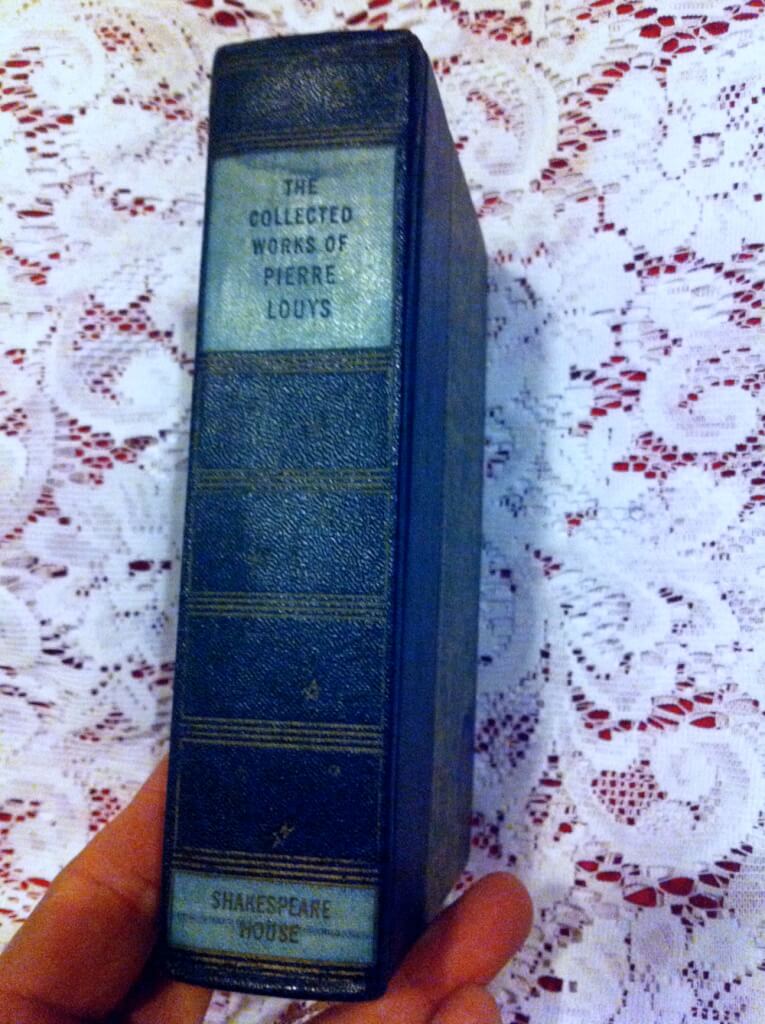
 Collected Works of Pierre Louys, Pierre Louys (Shakespeare House, New York, 1951) 6.75" X 4.5", 628pp., hardbound in blue-grey buckram boards with simulated leather spine, gilt decorations (portrait of Shakespear) on cover. Fine condition, ribbon intact. Pierre Louys (1870 - 1925) was a French poet and writer, most renowned for lesbian and classical themes in some of his writings. He is known as a writer who "expressed pagan sensuality with stylistic perfection." This is a collection which contains Aphrodite, The Songs of Bilitis, The Adventures of King Pausole, and 9 of his short stories.
Collected Works of Pierre Louys, Pierre Louys (Shakespeare House, New York, 1951) 6.75" X 4.5", 628pp., hardbound in blue-grey buckram boards with simulated leather spine, gilt decorations (portrait of Shakespear) on cover. Fine condition, ribbon intact. Pierre Louys (1870 - 1925) was a French poet and writer, most renowned for lesbian and classical themes in some of his writings. He is known as a writer who "expressed pagan sensuality with stylistic perfection." This is a collection which contains Aphrodite, The Songs of Bilitis, The Adventures of King Pausole, and 9 of his short stories. -
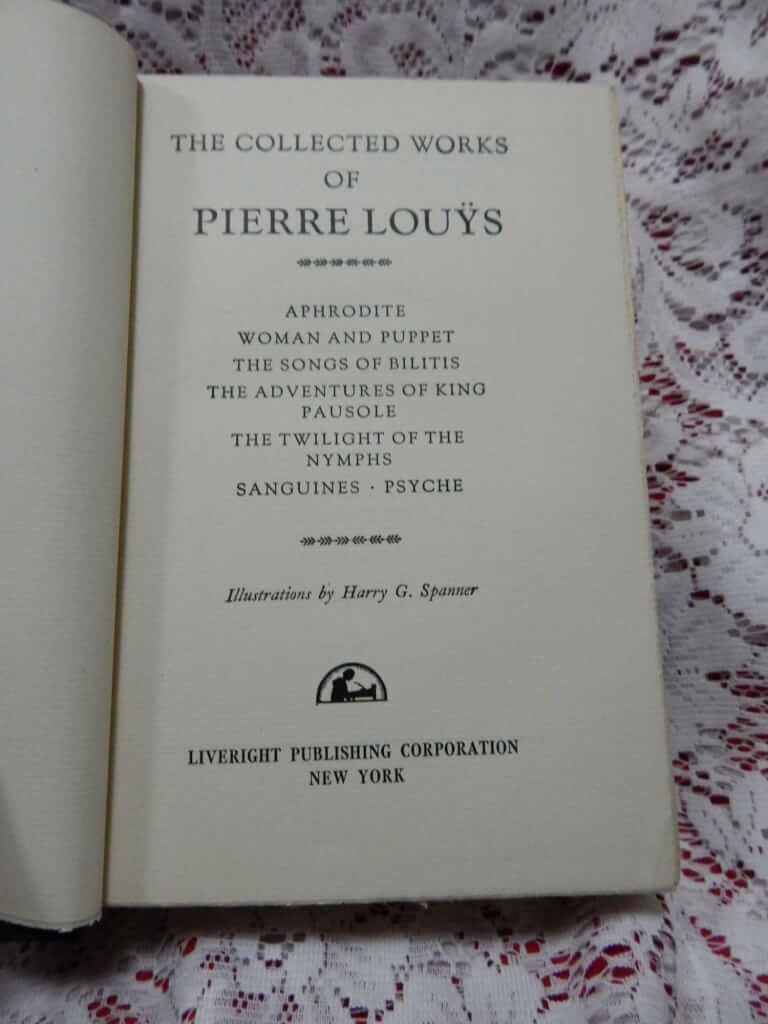
 Collected Works of Pierre Louys, Aphrodite, Woman and Puppet, The Songs of Billitis, The Adventures of King Pausole, The Twilight of the Nymphs, Sanguines, Psyche, Pierre Louys, Illust. by Harry G. Spanner, trans. by Mitchell S. Buck (Liveright Publishing Corporation, New York, 1932) 5.75" X 7.75", xii+742pp., black boards with gilt nude on cover, gilt and blue titles and decorations on spine, top edge inked, other edges deckled, printed on fine hand-layed paper Pierre Louys (1870 - 1925) was a French poet and writer, most renowned for lesbian and classical themes in some of his writings. He is known as a writer who "expressed pagan sensuality with stylistic perfection." Mitchell Starrett Buck (February 10, 1887 – May 12, 1959) was an American poet, translator and classical scholar. His volumes of verse and prose poetry were deeply influenced by 1890s aestheticism as well as classical Greek and Roman Literature. Buck’s writing was secondary to his work as a heating engineer, and the money he made professionally allowed him to become a noted book-collector, specializing in first editions, English literature, Greek and Latin classics. Buck’s first book was a translation of Aphrodite by the French decadent Pierre Louÿs (1870-1925). It appeared in 1913, and was “privately printed”, probably at Buck’s expense. It may have been arranged through the Philadelphia bookseller Nicholas L. Brown, who officially became a publisher in 1916, and thereafter issued most of Buck’s output. Between 1916 and 1932, Brown published small editions of poetry, belles lettres, translations, sometimes without his imprint but stating that the title has been “issued privately for subscribers” (in order to evade prosecution for dealing in obscene materials). Such classical erotica is very tame by modern standards, but in the teens and twenties such material was policed by self-appointed authorities such as John S. Sumner of the New York Society for the Suppression of Vice.
Collected Works of Pierre Louys, Aphrodite, Woman and Puppet, The Songs of Billitis, The Adventures of King Pausole, The Twilight of the Nymphs, Sanguines, Psyche, Pierre Louys, Illust. by Harry G. Spanner, trans. by Mitchell S. Buck (Liveright Publishing Corporation, New York, 1932) 5.75" X 7.75", xii+742pp., black boards with gilt nude on cover, gilt and blue titles and decorations on spine, top edge inked, other edges deckled, printed on fine hand-layed paper Pierre Louys (1870 - 1925) was a French poet and writer, most renowned for lesbian and classical themes in some of his writings. He is known as a writer who "expressed pagan sensuality with stylistic perfection." Mitchell Starrett Buck (February 10, 1887 – May 12, 1959) was an American poet, translator and classical scholar. His volumes of verse and prose poetry were deeply influenced by 1890s aestheticism as well as classical Greek and Roman Literature. Buck’s writing was secondary to his work as a heating engineer, and the money he made professionally allowed him to become a noted book-collector, specializing in first editions, English literature, Greek and Latin classics. Buck’s first book was a translation of Aphrodite by the French decadent Pierre Louÿs (1870-1925). It appeared in 1913, and was “privately printed”, probably at Buck’s expense. It may have been arranged through the Philadelphia bookseller Nicholas L. Brown, who officially became a publisher in 1916, and thereafter issued most of Buck’s output. Between 1916 and 1932, Brown published small editions of poetry, belles lettres, translations, sometimes without his imprint but stating that the title has been “issued privately for subscribers” (in order to evade prosecution for dealing in obscene materials). Such classical erotica is very tame by modern standards, but in the teens and twenties such material was policed by self-appointed authorities such as John S. Sumner of the New York Society for the Suppression of Vice. -

 Confessions of a Lady's Waiting Maid: being a true record of her marvelous adventures in both hemispheres, Fanny Beresford [Charles Paul de Kock (probably pseudonyms of George Thompson)] (J. H. Farrell, New York, nd [1848]) 9.5" X 5.75", 340pp, original soft covers, back cover missing, front cover and original orange paper front illustration page detached. Top and bottom edges untrimmed. Poor condition but for the age in good shape for a cheaply made and well read paperback. A museum piece. This is a very rare surviving paperback from the publisher Jeremiah H. Farrell. One of three main publishers of erotica of the time, According to Comstock (famous New York prosecutor of obscenity) "Farrell published about 109 different books. He had been at it about sixteen years, at the time of his death in 1873." The story was written by George Thompson who was the most prolific author of American erotica of the mid-nineteenth century, who got his start in Boston and later relocated to New York. Thompson wrote under numerous pseudonyms. The name of Charles Paul de Kock (a popular French novelist of the time) was a popular pseudonym of erotic work in America for obvious reasons.
Confessions of a Lady's Waiting Maid: being a true record of her marvelous adventures in both hemispheres, Fanny Beresford [Charles Paul de Kock (probably pseudonyms of George Thompson)] (J. H. Farrell, New York, nd [1848]) 9.5" X 5.75", 340pp, original soft covers, back cover missing, front cover and original orange paper front illustration page detached. Top and bottom edges untrimmed. Poor condition but for the age in good shape for a cheaply made and well read paperback. A museum piece. This is a very rare surviving paperback from the publisher Jeremiah H. Farrell. One of three main publishers of erotica of the time, According to Comstock (famous New York prosecutor of obscenity) "Farrell published about 109 different books. He had been at it about sixteen years, at the time of his death in 1873." The story was written by George Thompson who was the most prolific author of American erotica of the mid-nineteenth century, who got his start in Boston and later relocated to New York. Thompson wrote under numerous pseudonyms. The name of Charles Paul de Kock (a popular French novelist of the time) was a popular pseudonym of erotic work in America for obvious reasons. -

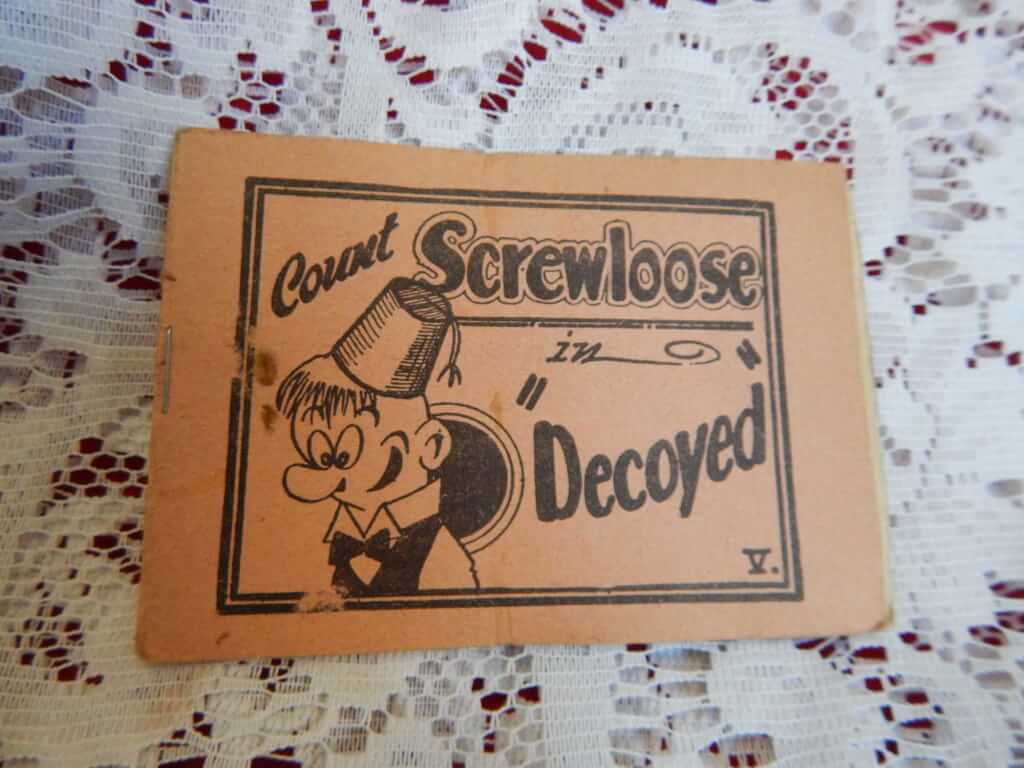 Count Screwloose in "Decoyed", (n.p. n.d.) 4.5" x 3", 8pp. pamphlet, stapled Tijuana bibles (also known as eight-pagers, bluesies, gray-backs, Jiggs-and-Maggie books, jo-jo books, Tillie-and-Mac books, and two-by-fours) were little pornographic comic books produced in the United States from the 1920s to the early 1960s.
Count Screwloose in "Decoyed", (n.p. n.d.) 4.5" x 3", 8pp. pamphlet, stapled Tijuana bibles (also known as eight-pagers, bluesies, gray-backs, Jiggs-and-Maggie books, jo-jo books, Tillie-and-Mac books, and two-by-fours) were little pornographic comic books produced in the United States from the 1920s to the early 1960s. -
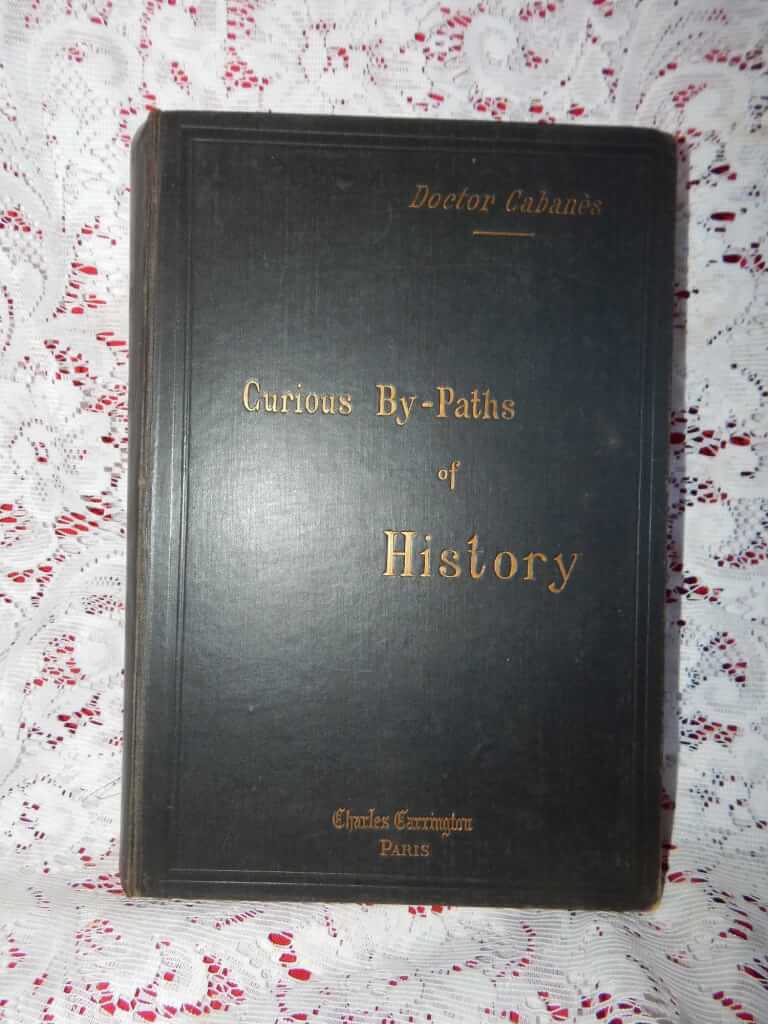
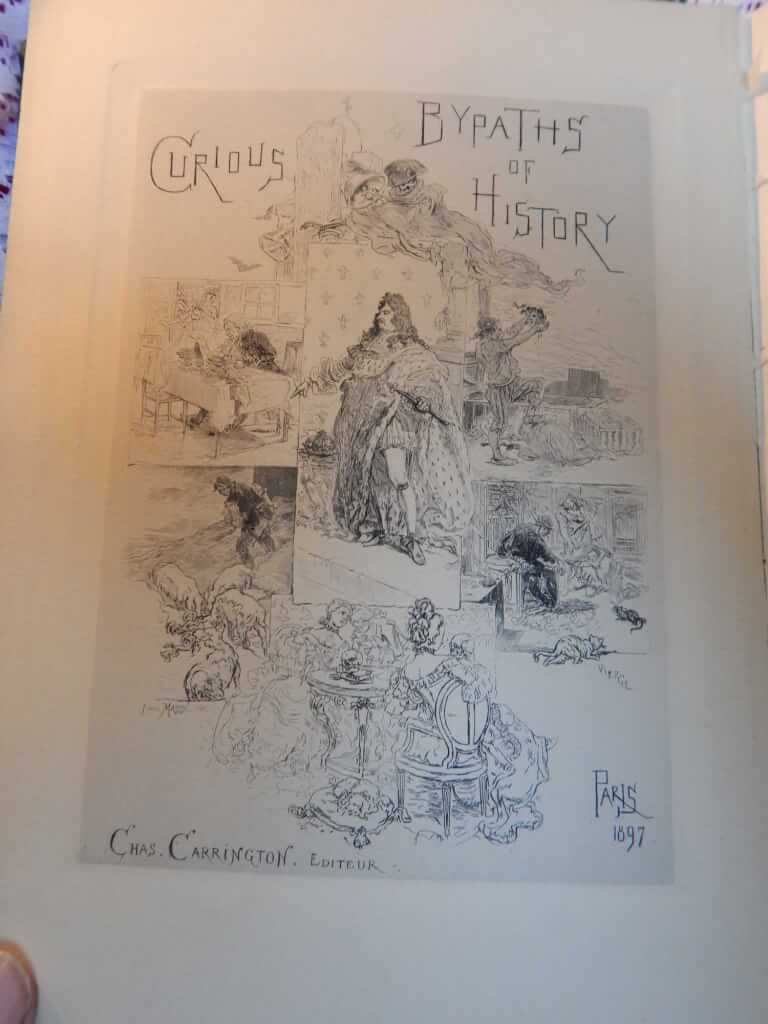 Curious Bypaths of History: Being Medico-Historical Studies and Observations, by Dr. [Augustin] Cabanès, frontispiece by Daniel Vierge engraved on copper by F. Massé (Librairie Des Bibliophiles, Charles Carrington, Éditeur, Paris 1898, #238/500) 7"x10", xx+367pp, black cloth with gilt titles on cover and spine (spine titles faded), front boards loose but holding, marbled endpapers, printed on "Van Gelder's vellum paper", gilt top edge, other edges deckled. Charles Carrington published a series of 3 books looking into the private lives of the French aristocracy titled, "Pathological studies of the past". The books are Secret Cabinet of History Peeped into By a Doctor (1897), Curious Bypaths of History: Being Medico-Historical Studies and Observations (1898), Flagellation in France from a medical and historical standpoint (1898). The first two and possibly the third were written by Dr. Augustin Cabanès (1862-1928), a French doctor, historian and author. Contents of this book, Curious Bypaths of History, include: The Teeth of Louis Xi, The Clandestine Accouchements of Mdlle De La Valliere (Louise de La Vallière was a mistress of Louis XIV of France from 1661 to 1667.), Illustrious Remains And Anatomical Relics. — the Skeleton of Mme De Maintenon And the Skull of Mme De Sevigne, The Infirmities of Sophie Arnould (a very popular French operatic soprano), Was Dr. Guillotin the Inventor Or the God-Father, of the Guillotine?, the Real Charlotte Corday. — Her Personal Appearance (Marie-Anne Charlotte de Corday d'Armont was a figure of the French Revolution. In 1793, she was executed by guillotine for the assassination of Jacobin leader Jean-Paul Marat, who was in part responsible for the more radical course the Revolution had taken through his role as a politician and journalist.), The Superstitions of Napoleon I, A Romance With Three Actors: Alfred De Musset, George Sand, And Doctor Pagello.
Curious Bypaths of History: Being Medico-Historical Studies and Observations, by Dr. [Augustin] Cabanès, frontispiece by Daniel Vierge engraved on copper by F. Massé (Librairie Des Bibliophiles, Charles Carrington, Éditeur, Paris 1898, #238/500) 7"x10", xx+367pp, black cloth with gilt titles on cover and spine (spine titles faded), front boards loose but holding, marbled endpapers, printed on "Van Gelder's vellum paper", gilt top edge, other edges deckled. Charles Carrington published a series of 3 books looking into the private lives of the French aristocracy titled, "Pathological studies of the past". The books are Secret Cabinet of History Peeped into By a Doctor (1897), Curious Bypaths of History: Being Medico-Historical Studies and Observations (1898), Flagellation in France from a medical and historical standpoint (1898). The first two and possibly the third were written by Dr. Augustin Cabanès (1862-1928), a French doctor, historian and author. Contents of this book, Curious Bypaths of History, include: The Teeth of Louis Xi, The Clandestine Accouchements of Mdlle De La Valliere (Louise de La Vallière was a mistress of Louis XIV of France from 1661 to 1667.), Illustrious Remains And Anatomical Relics. — the Skeleton of Mme De Maintenon And the Skull of Mme De Sevigne, The Infirmities of Sophie Arnould (a very popular French operatic soprano), Was Dr. Guillotin the Inventor Or the God-Father, of the Guillotine?, the Real Charlotte Corday. — Her Personal Appearance (Marie-Anne Charlotte de Corday d'Armont was a figure of the French Revolution. In 1793, she was executed by guillotine for the assassination of Jacobin leader Jean-Paul Marat, who was in part responsible for the more radical course the Revolution had taken through his role as a politician and journalist.), The Superstitions of Napoleon I, A Romance With Three Actors: Alfred De Musset, George Sand, And Doctor Pagello. -

 John Putz presents Daddy Warbucks in It's a Small World, (n.p. n.d.) 4.5" x 3", 8pp. pamphlet, stapled Tijuana bibles (also known as eight-pagers, bluesies, gray-backs, Jiggs-and-Maggie books, jo-jo books, Tillie-and-Mac books, and two-by-fours) were little pornographic comic books produced in the United States from the 1920s to the early 1960s.
John Putz presents Daddy Warbucks in It's a Small World, (n.p. n.d.) 4.5" x 3", 8pp. pamphlet, stapled Tijuana bibles (also known as eight-pagers, bluesies, gray-backs, Jiggs-and-Maggie books, jo-jo books, Tillie-and-Mac books, and two-by-fours) were little pornographic comic books produced in the United States from the 1920s to the early 1960s. -

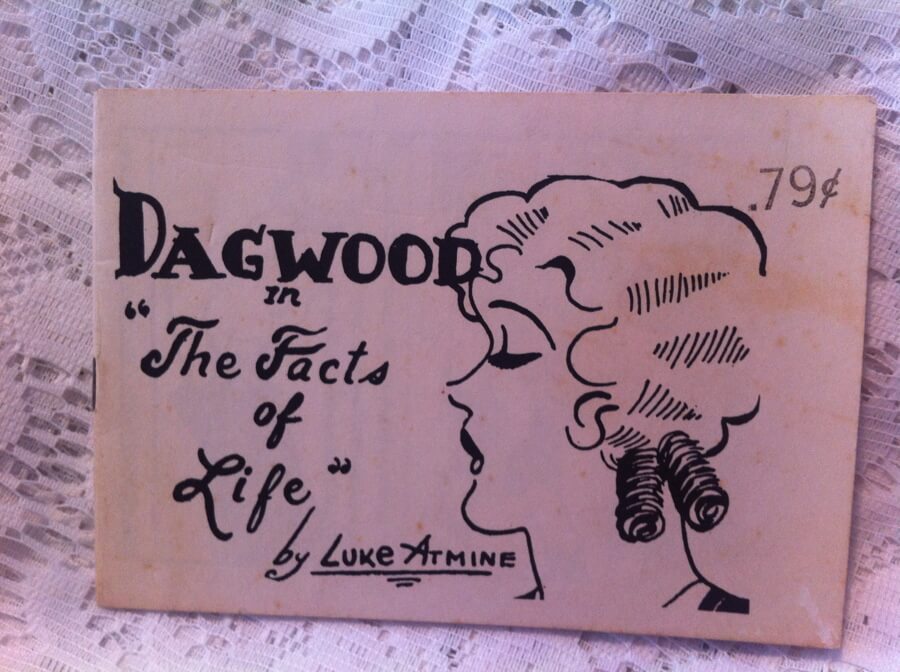 Dagwood in "The Facts of Life" / Boots, by Luke Armine (n.p., n.d.) 5" x 3.5", 8pp. double pamphlet, stapled Tijuana bibles (also known as eight-pagers, bluesies, gray-backs, Jiggs-and-Maggie books, jo-jo books, Tillie-and-Mac books, and two-by-fours) were little pornographic comic books produced in the United States from the 1920s to the early 1960s. This book is two books in one, featuring reprints of the originals printed on both sides of the paper. Flip the book over and it's a different book. "Boots and Her Buddies" was an American comic strip that ran from 1924 to 1969. Some newspapers presented the strip under the shortened title "Boots". The character of Boots was variously labeled the "Sweetheart of the Comics", the "Sweetheart of America" and "Everybody's Sweetheart".
Dagwood in "The Facts of Life" / Boots, by Luke Armine (n.p., n.d.) 5" x 3.5", 8pp. double pamphlet, stapled Tijuana bibles (also known as eight-pagers, bluesies, gray-backs, Jiggs-and-Maggie books, jo-jo books, Tillie-and-Mac books, and two-by-fours) were little pornographic comic books produced in the United States from the 1920s to the early 1960s. This book is two books in one, featuring reprints of the originals printed on both sides of the paper. Flip the book over and it's a different book. "Boots and Her Buddies" was an American comic strip that ran from 1924 to 1969. Some newspapers presented the strip under the shortened title "Boots". The character of Boots was variously labeled the "Sweetheart of the Comics", the "Sweetheart of America" and "Everybody's Sweetheart". -

 Das Dekameron, by Giovanni Baccaccio, illustrated by F. v. Bayros. With a foreword by Hanns Heinz Ewers (Wilhelm Borngräber Verlag, Berlin., 1913) 5.25"x7.5", 612pp + 4 pages of ads, hardcover, half buckram with gilt title and decorations, very good condition. German language of Boccaccio's Decameron with 6 illustrations by Franz von Bayros. The Decameron, (subtitled Prencipe Galeotto or Prince Galehaut), is a collection of novellas by the 14th-century Italian author Giovanni Boccaccio (1313–1375). The book is structured as a frame story containing 100 tales told by a group of seven young women and three young men sheltering in a secluded villa just outside Florence to escape the Black Death, which was afflicting the city. To make their exile more pleasant each of the ten tells the others one story every day. The Decameron records the narratives of ten days -- 100 stories. Boccaccio probably conceived of The Decameron after the epidemic of 1348, and completed it by 1353. These tales run the entire range of human emotion: grief, love, humor, anger, revenge. Many are based on oral folklore. Boccaccio's ten narrators thus retell already familiar stories about errant priests, rascally husbands, and mischievous wives. Variants of these stories are known in many cultures, but no one formulates them more cleverly or relates them more eloquently than does Boccaccio. In addition to its literary value and widespread influence, it provides a document of life at the time. Written in the vernacular of the Florentine language, it is considered a masterpiece of classical early Italian prose.
Das Dekameron, by Giovanni Baccaccio, illustrated by F. v. Bayros. With a foreword by Hanns Heinz Ewers (Wilhelm Borngräber Verlag, Berlin., 1913) 5.25"x7.5", 612pp + 4 pages of ads, hardcover, half buckram with gilt title and decorations, very good condition. German language of Boccaccio's Decameron with 6 illustrations by Franz von Bayros. The Decameron, (subtitled Prencipe Galeotto or Prince Galehaut), is a collection of novellas by the 14th-century Italian author Giovanni Boccaccio (1313–1375). The book is structured as a frame story containing 100 tales told by a group of seven young women and three young men sheltering in a secluded villa just outside Florence to escape the Black Death, which was afflicting the city. To make their exile more pleasant each of the ten tells the others one story every day. The Decameron records the narratives of ten days -- 100 stories. Boccaccio probably conceived of The Decameron after the epidemic of 1348, and completed it by 1353. These tales run the entire range of human emotion: grief, love, humor, anger, revenge. Many are based on oral folklore. Boccaccio's ten narrators thus retell already familiar stories about errant priests, rascally husbands, and mischievous wives. Variants of these stories are known in many cultures, but no one formulates them more cleverly or relates them more eloquently than does Boccaccio. In addition to its literary value and widespread influence, it provides a document of life at the time. Written in the vernacular of the Florentine language, it is considered a masterpiece of classical early Italian prose. -
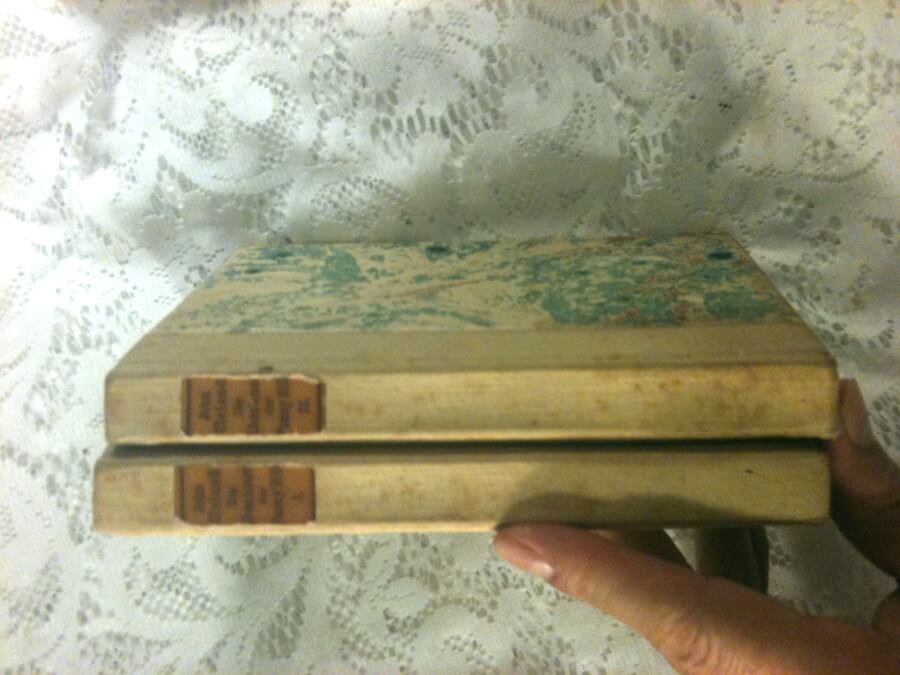
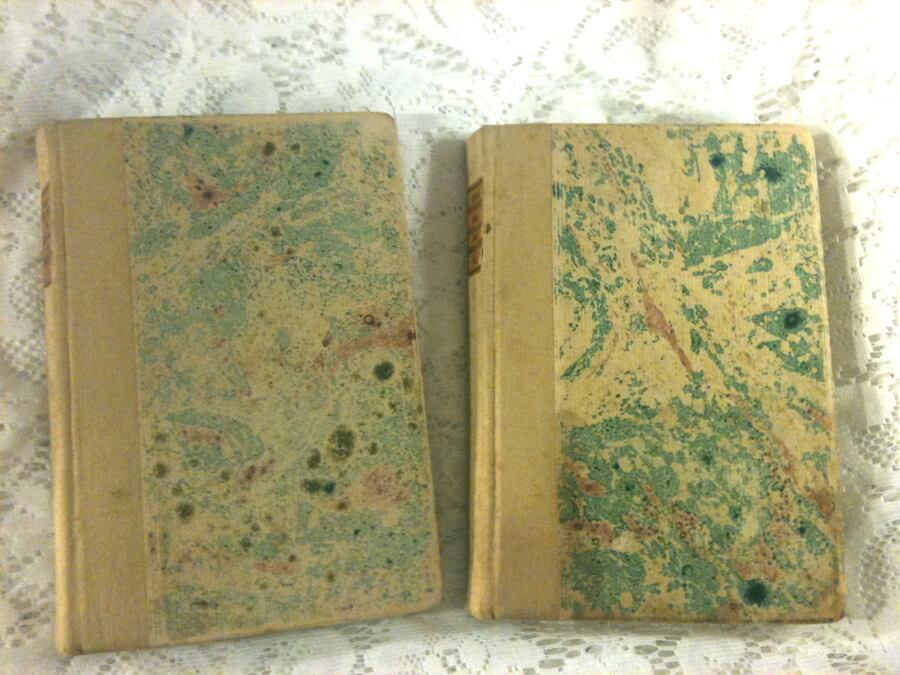 Die Abenteuer der Fanny Hill, John Cleland (np, München, 1919) 7.25" x 5", 2 vol., 178pp, 179-370pp, hardbound, marbled paper boards with cloth spine. Paper label on spine. Good condition for age, showing wear at hinges, both slightly cocked, pages yellowing. Boards worn at edges and corners Written while the author was in debtor's prison in London and first published in 1749, Fanny Hill is considered the first original English prose pornography, and the first pornography to use the form of the novel. One of the most prosecuted and banned books in history, it has become a synonym for obscenity. This German version of Fanny Hill is without mention of publisher. This was German "Bückware" or an item that was kept under the counter only for customers who asked for it. A nice 2 volume set in German.
Die Abenteuer der Fanny Hill, John Cleland (np, München, 1919) 7.25" x 5", 2 vol., 178pp, 179-370pp, hardbound, marbled paper boards with cloth spine. Paper label on spine. Good condition for age, showing wear at hinges, both slightly cocked, pages yellowing. Boards worn at edges and corners Written while the author was in debtor's prison in London and first published in 1749, Fanny Hill is considered the first original English prose pornography, and the first pornography to use the form of the novel. One of the most prosecuted and banned books in history, it has become a synonym for obscenity. This German version of Fanny Hill is without mention of publisher. This was German "Bückware" or an item that was kept under the counter only for customers who asked for it. A nice 2 volume set in German. -
 Die Abenteuer des Chevalier Faublas | Erzählt von Louvet de Couvray [[The adventures of the Chevalier Faublas | Told by Louvet de Couvray], etchings by Karl Walser (Georg Müller, Munich, 1910, #1411/1500) 8.25"x5.5", 4 volumes, x+216pp, 279pp, 295pp, 344pp, half calf over decorated silk (from a drawing by Karl Walser), black title and vol. label with gilt lettering and decorations on spine, 4 etched title vignettes and 12 toned etchings by Karl Walser on 12 panels with green tissue guard, ribbons present in all volumes, good+ condition. Karl Walser (1877-1943) was a Swiss painter, set designer and illustrator. His artwork, although very popular during his lifetime, has mostly been forgotten by the art world, unlike his brother, author Robert Walser, who was never able to support himself through writing which gained notoriety after his death. Jean-Baptiste Louvet de Couvrai (1760 - 1797) was born in Paris as the son of a stationer, he became a bookseller's clerk, and first attracted attention with the first part of his novel "Les Amours du chevalier de Faublas" (5 parts) in 1787; it was followed in 1788 by "Six semaines de la vie du chevalier de Faublas" (8 parts) and in 1790 by "La Fin des amours du chevalier de Faublas" (6 parts). The heroine, Lodoiska, was modeled on the wife of a jeweler in the Palais Royal, with whom he had an affair. She divorced her husband in 1792 and married Louvet in 1793. This is considered a so-called "libertine" novel. It dwells mainly on the sexual escapades of its hero, a sort of amiable young libertine, and on the corrupted morals of eighteenth-century France. At the start of this novel the young Chevalier de Faublas attends a party dressed as a woman and is knowingly seduced by the lady of the house ('. I receive with equal astonishment and pleasure a charming lesson, which I repeated more than once .') Oxford Comp. to French Literature says it is "typical of many frivolous, licentious novels of its time, and still mentioned. Faublas, the amiable hero, is the victim of his own charms. His amorous adventures, recounted with a certain lively force, begin with his entry into society at the age of sixteen. He loves several women by the way and three in particular. A jealous husband and a despairing suicide reduce the three to one. The novel ends on a moral note: Faublas , who had happened to settle down with his remaining love, is haunted by the avenging phantoms of the other two and goes mad."
Die Abenteuer des Chevalier Faublas | Erzählt von Louvet de Couvray [[The adventures of the Chevalier Faublas | Told by Louvet de Couvray], etchings by Karl Walser (Georg Müller, Munich, 1910, #1411/1500) 8.25"x5.5", 4 volumes, x+216pp, 279pp, 295pp, 344pp, half calf over decorated silk (from a drawing by Karl Walser), black title and vol. label with gilt lettering and decorations on spine, 4 etched title vignettes and 12 toned etchings by Karl Walser on 12 panels with green tissue guard, ribbons present in all volumes, good+ condition. Karl Walser (1877-1943) was a Swiss painter, set designer and illustrator. His artwork, although very popular during his lifetime, has mostly been forgotten by the art world, unlike his brother, author Robert Walser, who was never able to support himself through writing which gained notoriety after his death. Jean-Baptiste Louvet de Couvrai (1760 - 1797) was born in Paris as the son of a stationer, he became a bookseller's clerk, and first attracted attention with the first part of his novel "Les Amours du chevalier de Faublas" (5 parts) in 1787; it was followed in 1788 by "Six semaines de la vie du chevalier de Faublas" (8 parts) and in 1790 by "La Fin des amours du chevalier de Faublas" (6 parts). The heroine, Lodoiska, was modeled on the wife of a jeweler in the Palais Royal, with whom he had an affair. She divorced her husband in 1792 and married Louvet in 1793. This is considered a so-called "libertine" novel. It dwells mainly on the sexual escapades of its hero, a sort of amiable young libertine, and on the corrupted morals of eighteenth-century France. At the start of this novel the young Chevalier de Faublas attends a party dressed as a woman and is knowingly seduced by the lady of the house ('. I receive with equal astonishment and pleasure a charming lesson, which I repeated more than once .') Oxford Comp. to French Literature says it is "typical of many frivolous, licentious novels of its time, and still mentioned. Faublas, the amiable hero, is the victim of his own charms. His amorous adventures, recounted with a certain lively force, begin with his entry into society at the age of sixteen. He loves several women by the way and three in particular. A jealous husband and a despairing suicide reduce the three to one. The novel ends on a moral note: Faublas , who had happened to settle down with his remaining love, is haunted by the avenging phantoms of the other two and goes mad." -
 Die Weiberherrschaft in der Geschichte der Menschheit [The Rule of Women in the History of Mankind], Eduard Fuchs, Alfred Kind (Albert Langen, München, 1913) 8.75″ X 11″, complete set, 2 volumes plus supplementary volume, x+1-348pp, 349-711pp, ix+319pp, decorated green cloth boards, decorated cloth endpapers, binding loose by design and very much intact on all volumes (binding is often a problem with this edition), Vol. 1&2 contain 665 illustrations and 90 tipped in illustrations. The supplemental volume contains 317 illustrations and 34 tipped in illustrations. Minor bumping on covers, in excellent condition for age. Compiling 665+317 reproductions of drawings, prints and paintings from the collection of Eduard Fuchs, this edition shows how the image of female domination and male submission was widespread in Europe from the Renaissance to the early 20th century. Edward Fuchs (1870-1940). Fuchs' father was a shopkeeper. Early in his life, the younger Fuchs developed socialist and Marxist political convictions. In 1886, he joined the outlawed political party Sozialistische Arbeiterpartei (the precursor of the modern SPD, Sozialdemokratische Partei Deutschlands). Fuchs received a doctor of law degree and practiced as an attorney. In 1892, he became editor-in-chief of the satiric weekly Süddeutscher Postillon and later co-editor of the Leipziger Volkszeitung. His inflammatory articles in newspapers—one accusing the Kaiser of being a mass murderer—resulted in periodic jail sentences. During his periods of confinement, Fuchs wrote various social histories utilizing images as one of his primary sources. The first of these was his Karikatur der europäischen Völker (Caricatures of European Peoples), 1902. He moved to Berlin that same year where he edited the socialist newspaper Vorwärts. The following year he began his magnum opus, an examination of moral practice, Sittengeschichte, eventually running to six volumes by 1912. While engaged in this series, he followed up his interest in caricatures with one devoted to the representation of women, Die Frau in der Karikatur, 1905 (3 vols). Another book documenting the stereotypical representations of Jews appeared in 1912. Fuchs traveled with the artist Max Slevogt to Egypt in 1914, shortly before the outbreak of World War I. He was a pacifist during the War. Lenin's government put him in charge of prisoner exchange with Germany after the war; he was among the leaders of the German Comintern in Berlin in 1919. His interest in societal concerns in caricature led to a research interest in Daumier. Beginning in 1920, Fuchs published a catalogue raisonné on the artist in three volumes. He resigned from the party in 1929, following the expulsion of several stalwarts. At Hitler's ascension to power in Germany in 1933, Fuchs moved to France.
Die Weiberherrschaft in der Geschichte der Menschheit [The Rule of Women in the History of Mankind], Eduard Fuchs, Alfred Kind (Albert Langen, München, 1913) 8.75″ X 11″, complete set, 2 volumes plus supplementary volume, x+1-348pp, 349-711pp, ix+319pp, decorated green cloth boards, decorated cloth endpapers, binding loose by design and very much intact on all volumes (binding is often a problem with this edition), Vol. 1&2 contain 665 illustrations and 90 tipped in illustrations. The supplemental volume contains 317 illustrations and 34 tipped in illustrations. Minor bumping on covers, in excellent condition for age. Compiling 665+317 reproductions of drawings, prints and paintings from the collection of Eduard Fuchs, this edition shows how the image of female domination and male submission was widespread in Europe from the Renaissance to the early 20th century. Edward Fuchs (1870-1940). Fuchs' father was a shopkeeper. Early in his life, the younger Fuchs developed socialist and Marxist political convictions. In 1886, he joined the outlawed political party Sozialistische Arbeiterpartei (the precursor of the modern SPD, Sozialdemokratische Partei Deutschlands). Fuchs received a doctor of law degree and practiced as an attorney. In 1892, he became editor-in-chief of the satiric weekly Süddeutscher Postillon and later co-editor of the Leipziger Volkszeitung. His inflammatory articles in newspapers—one accusing the Kaiser of being a mass murderer—resulted in periodic jail sentences. During his periods of confinement, Fuchs wrote various social histories utilizing images as one of his primary sources. The first of these was his Karikatur der europäischen Völker (Caricatures of European Peoples), 1902. He moved to Berlin that same year where he edited the socialist newspaper Vorwärts. The following year he began his magnum opus, an examination of moral practice, Sittengeschichte, eventually running to six volumes by 1912. While engaged in this series, he followed up his interest in caricatures with one devoted to the representation of women, Die Frau in der Karikatur, 1905 (3 vols). Another book documenting the stereotypical representations of Jews appeared in 1912. Fuchs traveled with the artist Max Slevogt to Egypt in 1914, shortly before the outbreak of World War I. He was a pacifist during the War. Lenin's government put him in charge of prisoner exchange with Germany after the war; he was among the leaders of the German Comintern in Berlin in 1919. His interest in societal concerns in caricature led to a research interest in Daumier. Beginning in 1920, Fuchs published a catalogue raisonné on the artist in three volumes. He resigned from the party in 1929, following the expulsion of several stalwarts. At Hitler's ascension to power in Germany in 1933, Fuchs moved to France. -
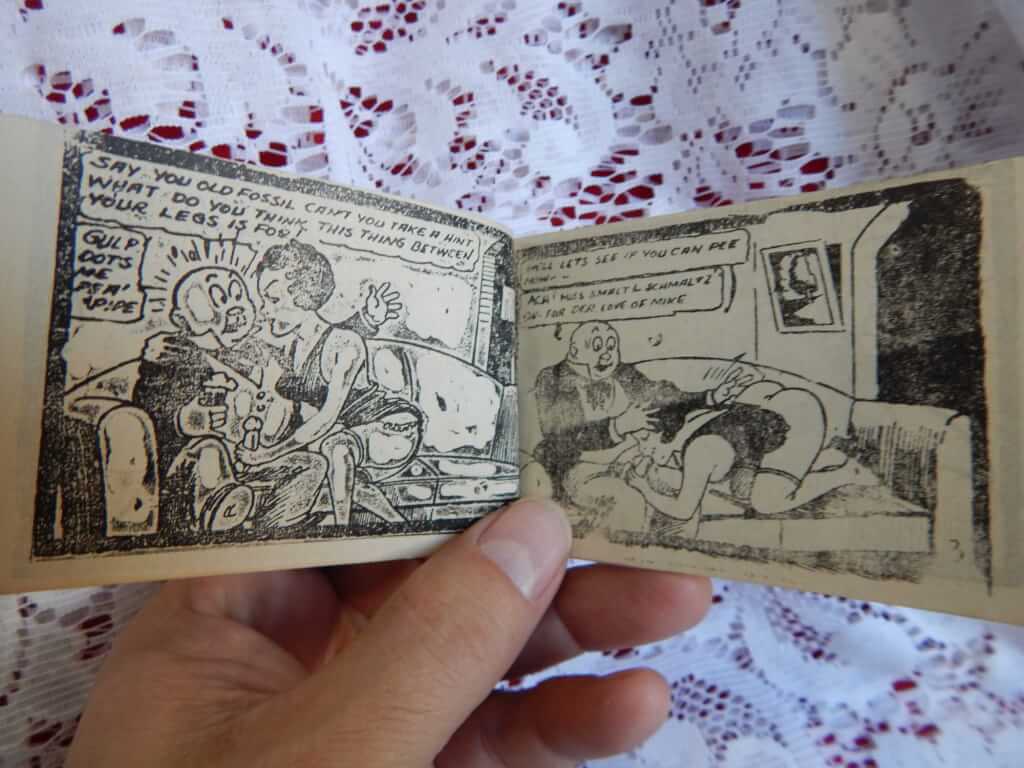
 Dingle Hoofer and his Dog Aolph, (n.p. n.d.) 4.5" x 3", 8pp. pamphlet, stapled, cover detatched Tijuana bibles (also known as eight-pagers, bluesies, gray-backs, Jiggs-and-Maggie books, jo-jo books, Tillie-and-Mac books, and two-by-fours) were little pornographic comic books produced in the United States from the 1920s to the early 1960s.
Dingle Hoofer and his Dog Aolph, (n.p. n.d.) 4.5" x 3", 8pp. pamphlet, stapled, cover detatched Tijuana bibles (also known as eight-pagers, bluesies, gray-backs, Jiggs-and-Maggie books, jo-jo books, Tillie-and-Mac books, and two-by-fours) were little pornographic comic books produced in the United States from the 1920s to the early 1960s. -

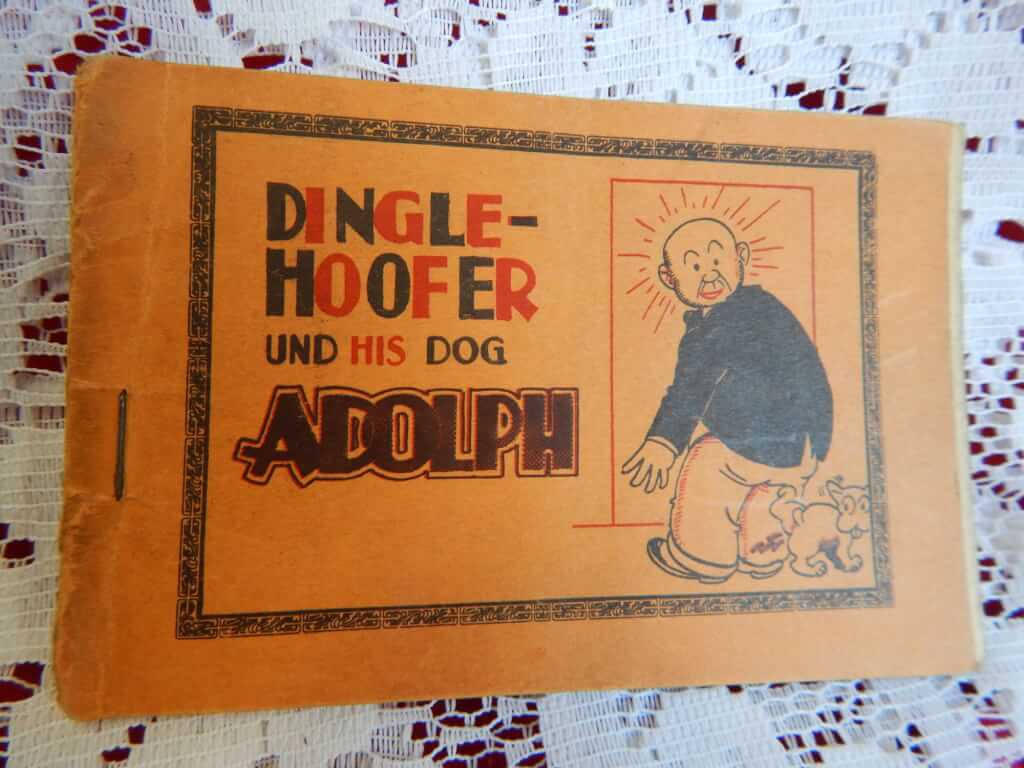 Dingle-Hoofer und his dog Adolph, (np. nd.) 4.5" x 3", 8pp. pamphlet, stapled Tijuana bibles (also known as eight-pagers, bluesies, gray-backs, Jiggs-and-Maggie books, jo-jo books, Tillie-and-Mac books, and two-by-fours) were little pornographic comic books produced in the United States from the 1920s to the early 1960s.
Dingle-Hoofer und his dog Adolph, (np. nd.) 4.5" x 3", 8pp. pamphlet, stapled Tijuana bibles (also known as eight-pagers, bluesies, gray-backs, Jiggs-and-Maggie books, jo-jo books, Tillie-and-Mac books, and two-by-fours) were little pornographic comic books produced in the United States from the 1920s to the early 1960s. -
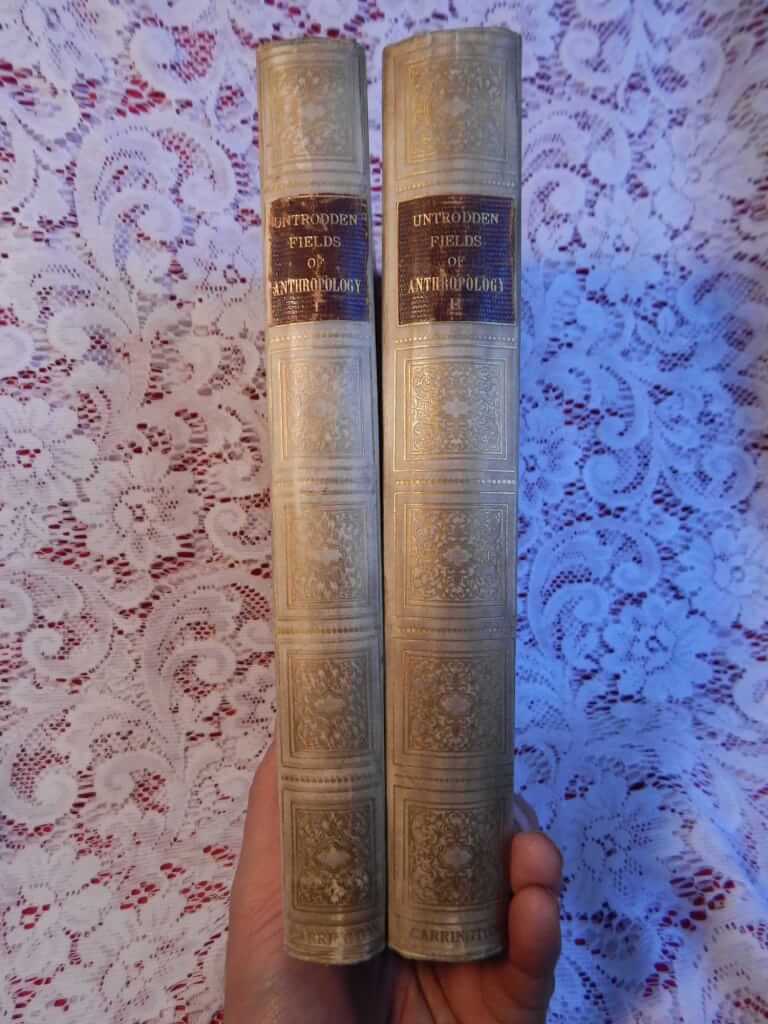
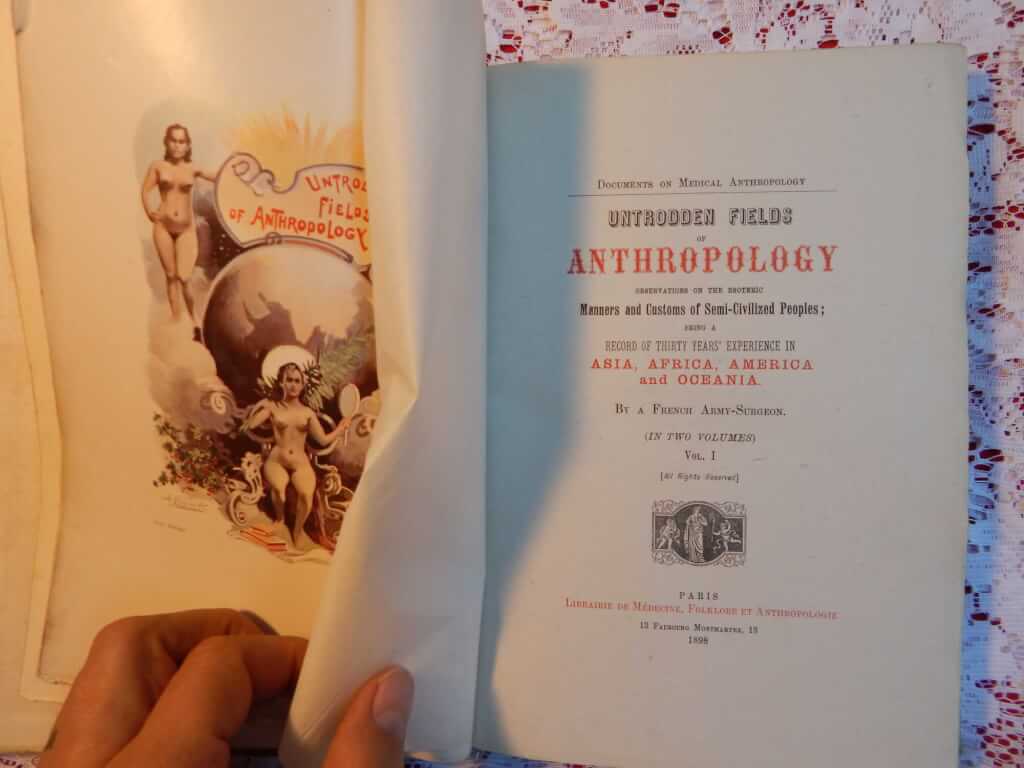 Documents on Medical Anthropology | Untrodden Fields of Anthropology | observations on the esoteric Manners and Customs of Semi-Civilized Peoples; being a record of thirty years' experience in asia, africa, america, and oceana., "By a French Army-Surgeon [in later books identified as "Jacobus X.."] (Charles Carrington, Paris, 1898, "second enlarged and revised edition [was there a first?]", #52/150, "printed on papier de chine") 7"x10" 2 vol., xl+ 341pp, xiv+502pp, Hardbound with paper wrappers inside, 1/2-bound in vellum over marbled boards, gilt lettering on spine, top edge gilt, other edges deckle/uncut, fine hand-laid paper, marlbled endpapers, binding tight, color frontispiece and numerous B&W full page engravings with descriptive tissue guards, very rare copy, bookplates of Frederic Roa This work of ''anthropology'' seems in fact intended to serve the purposes of titillation with its detailed descriptions of exotic sexual practices. Also present in this edition (to be presumably studied) are illustrations of naked women from all over the world. This is a rare book, often mentioned but not seen.
Documents on Medical Anthropology | Untrodden Fields of Anthropology | observations on the esoteric Manners and Customs of Semi-Civilized Peoples; being a record of thirty years' experience in asia, africa, america, and oceana., "By a French Army-Surgeon [in later books identified as "Jacobus X.."] (Charles Carrington, Paris, 1898, "second enlarged and revised edition [was there a first?]", #52/150, "printed on papier de chine") 7"x10" 2 vol., xl+ 341pp, xiv+502pp, Hardbound with paper wrappers inside, 1/2-bound in vellum over marbled boards, gilt lettering on spine, top edge gilt, other edges deckle/uncut, fine hand-laid paper, marlbled endpapers, binding tight, color frontispiece and numerous B&W full page engravings with descriptive tissue guards, very rare copy, bookplates of Frederic Roa This work of ''anthropology'' seems in fact intended to serve the purposes of titillation with its detailed descriptions of exotic sexual practices. Also present in this edition (to be presumably studied) are illustrations of naked women from all over the world. This is a rare book, often mentioned but not seen. -
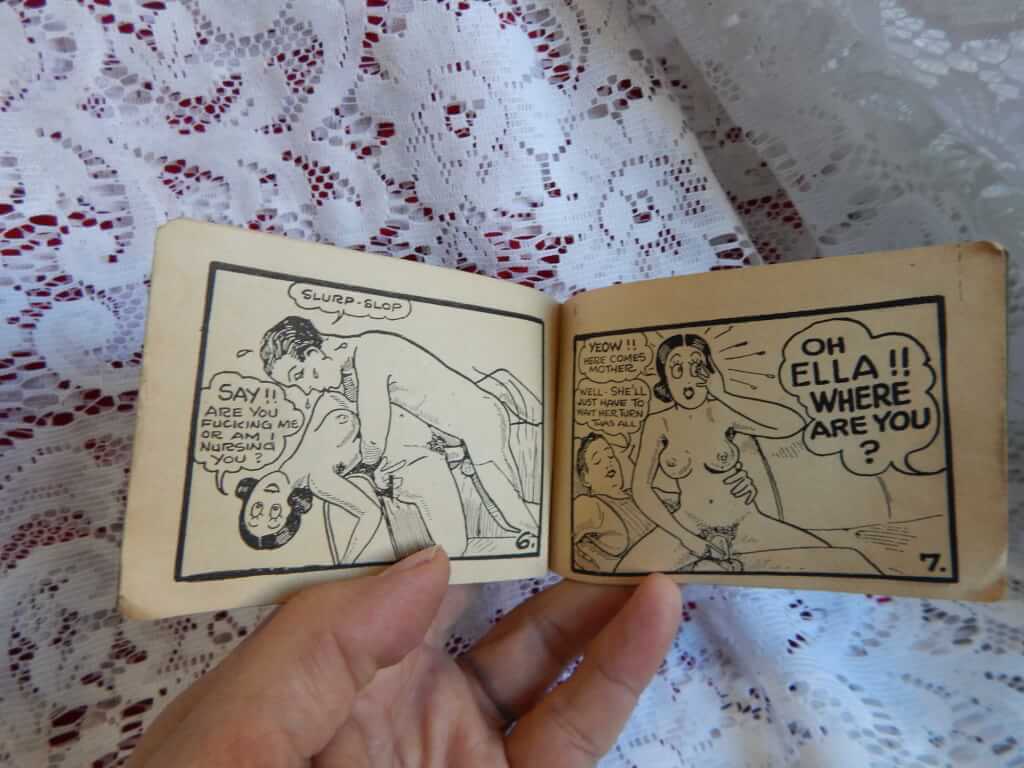
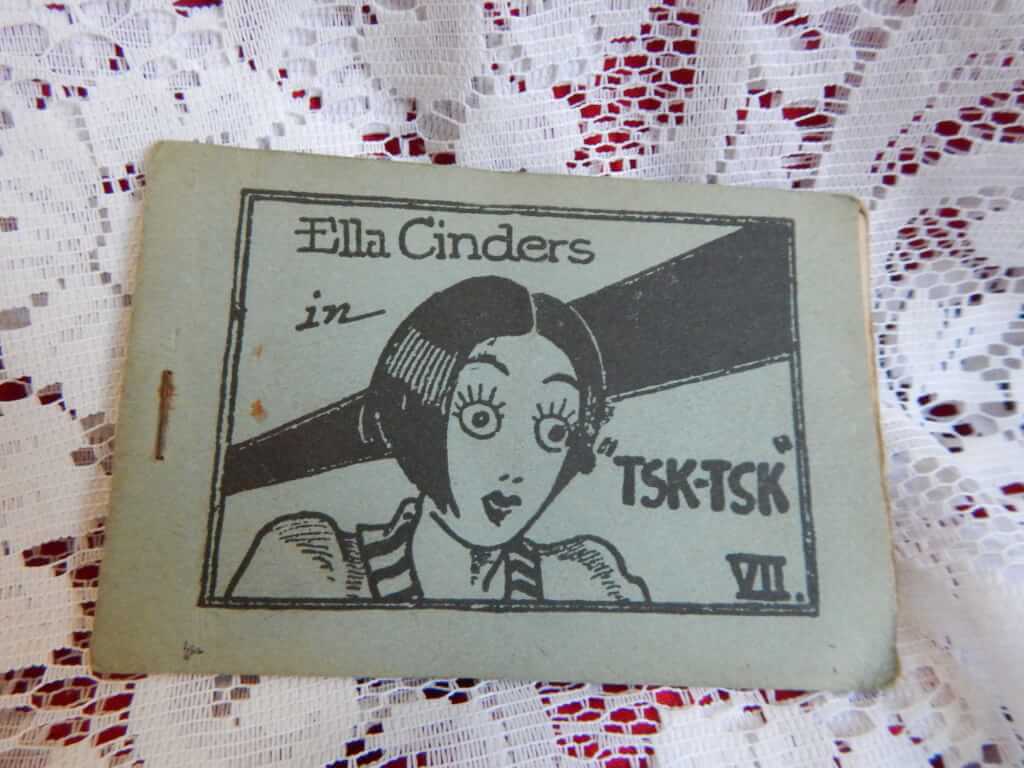 Ella Cinders in "Tsk-Tsk", (n.p. n.d.) 4.5" x 3", 8pp. pamphlet, stapled Tijuana bibles (also known as eight-pagers, bluesies, gray-backs, Jiggs-and-Maggie books, jo-jo books, Tillie-and-Mac books, and two-by-fours) were little pornographic comic books produced in the United States from the 1920s to the early 1960s.
Ella Cinders in "Tsk-Tsk", (n.p. n.d.) 4.5" x 3", 8pp. pamphlet, stapled Tijuana bibles (also known as eight-pagers, bluesies, gray-backs, Jiggs-and-Maggie books, jo-jo books, Tillie-and-Mac books, and two-by-fours) were little pornographic comic books produced in the United States from the 1920s to the early 1960s. -
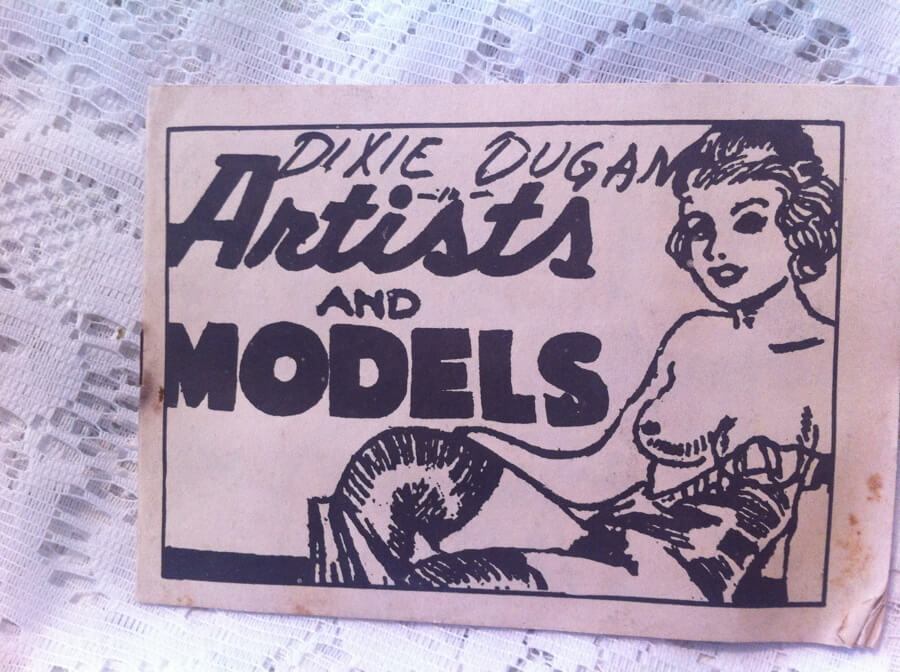
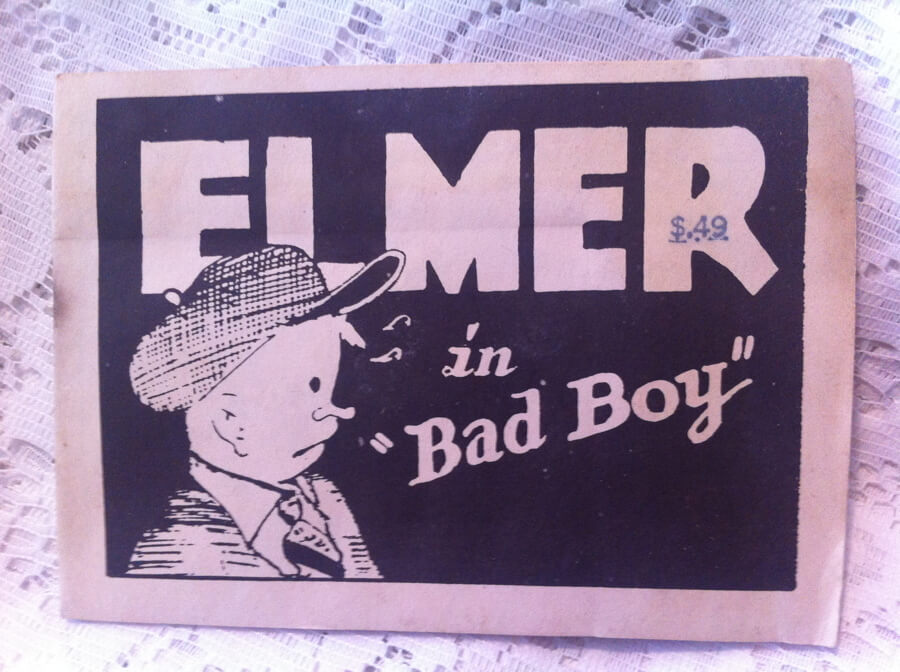 Elmer in "Bad Boy" / Dixie Dugan in Artists and Models, (n.p., n.d.) 5" x 3.5", 8pp. double pamphlet, stapled Tijuana bibles (also known as eight-pagers, bluesies, gray-backs, Jiggs-and-Maggie books, jo-jo books, Tillie-and-Mac books, and two-by-fours) were little pornographic comic books produced in the United States from the 1920s to the early 1960s. This book is two books in one, featuring reprints of the originals printed on both sides of the paper. Flip the book over and it's a different book.
Elmer in "Bad Boy" / Dixie Dugan in Artists and Models, (n.p., n.d.) 5" x 3.5", 8pp. double pamphlet, stapled Tijuana bibles (also known as eight-pagers, bluesies, gray-backs, Jiggs-and-Maggie books, jo-jo books, Tillie-and-Mac books, and two-by-fours) were little pornographic comic books produced in the United States from the 1920s to the early 1960s. This book is two books in one, featuring reprints of the originals printed on both sides of the paper. Flip the book over and it's a different book. -
Out of stock
 Emmanuelle, Bianca, and Venus in Furs, Emmanuelle Arsan, Leopold von Sacher-Masoch, Guido Crepax, introduction by Paolo Caneppelle and Günter Krenn [Evergreen/Benedikt Taschen Verlag GmbH, 2000, Germany, 1st edition thus] 8 x 10.5", 463pp, Hardcover w/DJ, red boards with white lettering, like-new condition. Published in 2000, and nolonger in print, designed by Lambert & Lambert, this edition has become rare and sought after. It was published with another volume “Justine and The Story of O”. This book has three of Crepax’s graphic novels. All three (like most of Crepax’s works) are very sexually graphic stories of sexual self-discovery under varying circumstances. Guido Crepas (1933-2003), better known by his nom de plume Guido Crepax, was an Italian comics artist. He is most famous for his character Valentina, created in 1965 and very representative of the spirit of the 1960s. The Valentina series of books and strips became noted for Crepax's sophisticated drawing, and for the psychedelic, dreamlike storylines, generally involving a strong dose of erotism. Marayat Rollet-Andriane formerly Marayat Krasaesin (1932-2005), known by the pen name Emmanuelle Arsan, was a French novelist of Thai origin, best known for the novel featuring the fictional character Emmanuelle, a woman who sets out on a voyage of sexual self-discovery under varying circumstances. It was later claimed that the real author of the book was her husband, Louis-Jacques Rollet-Andriane. The novel Emmanuelle was initially published and distributed clandestinely in France in 1959, without an author's name. Successive editions were ascribed to Emmanuelle Arsan, who was subsequently revealed to be Marayat Rollet-Andriane. Though the novel was sometimes hinted to be quasi-autobiographical, it was later revealed that the actual author was her husband Louis-Jacques Rollet-Andriane. Several more novels were published under the Emmanuelle Arsan pseudonym. Venus in Furs (German: Venus im Pelz) is a novella by Leopold Ritter von Sacher-Masoch (1836-1895), an Austrian writer and journalist. It is now his best known work and because of its themes the term masochism is derived from his name, coined by the Austrian psychiatrist, Krafft-Ebing. The novel was to be part of an epic series that Sacher-Masoch envisioned called Legacy of Cain. Venus in Furs was part of Love, the first volume of the series. It was published in 1870. The novel draws themes, like female dominance and sadomasochism, and character inspiration heavily from Sacher-Masoch's own life. Wanda von Dunajew, the novel's central female character, was modelled after his mistress Baroness Fanny Pistor. In December 1869 the two signed a contract making him her slave for a period of 6 months. In 1873, after the publication of Venus in Furs, Sacher-Masoch married Aurora von Rümelin who he pressured to continue the lifestyle he wrote about in his book. After 10 years they divorced. Rümelin, using the pseudonym of the books title character, "Wanda von Dunajew", wrote Meine Lebensbeichte (My Life Confession) published in 1906. It detailed Sacher-Masoch's private life and her relationship with him. During his lifetime, Sacher-Masoch was well known as a man of letters, a utopian thinker who espoused socialist and humanist ideals in his fiction and non-fiction. Most of his works remain untranslated into English. Until recently, his novel Venus in Furs was his only book commonly available in English.
Emmanuelle, Bianca, and Venus in Furs, Emmanuelle Arsan, Leopold von Sacher-Masoch, Guido Crepax, introduction by Paolo Caneppelle and Günter Krenn [Evergreen/Benedikt Taschen Verlag GmbH, 2000, Germany, 1st edition thus] 8 x 10.5", 463pp, Hardcover w/DJ, red boards with white lettering, like-new condition. Published in 2000, and nolonger in print, designed by Lambert & Lambert, this edition has become rare and sought after. It was published with another volume “Justine and The Story of O”. This book has three of Crepax’s graphic novels. All three (like most of Crepax’s works) are very sexually graphic stories of sexual self-discovery under varying circumstances. Guido Crepas (1933-2003), better known by his nom de plume Guido Crepax, was an Italian comics artist. He is most famous for his character Valentina, created in 1965 and very representative of the spirit of the 1960s. The Valentina series of books and strips became noted for Crepax's sophisticated drawing, and for the psychedelic, dreamlike storylines, generally involving a strong dose of erotism. Marayat Rollet-Andriane formerly Marayat Krasaesin (1932-2005), known by the pen name Emmanuelle Arsan, was a French novelist of Thai origin, best known for the novel featuring the fictional character Emmanuelle, a woman who sets out on a voyage of sexual self-discovery under varying circumstances. It was later claimed that the real author of the book was her husband, Louis-Jacques Rollet-Andriane. The novel Emmanuelle was initially published and distributed clandestinely in France in 1959, without an author's name. Successive editions were ascribed to Emmanuelle Arsan, who was subsequently revealed to be Marayat Rollet-Andriane. Though the novel was sometimes hinted to be quasi-autobiographical, it was later revealed that the actual author was her husband Louis-Jacques Rollet-Andriane. Several more novels were published under the Emmanuelle Arsan pseudonym. Venus in Furs (German: Venus im Pelz) is a novella by Leopold Ritter von Sacher-Masoch (1836-1895), an Austrian writer and journalist. It is now his best known work and because of its themes the term masochism is derived from his name, coined by the Austrian psychiatrist, Krafft-Ebing. The novel was to be part of an epic series that Sacher-Masoch envisioned called Legacy of Cain. Venus in Furs was part of Love, the first volume of the series. It was published in 1870. The novel draws themes, like female dominance and sadomasochism, and character inspiration heavily from Sacher-Masoch's own life. Wanda von Dunajew, the novel's central female character, was modelled after his mistress Baroness Fanny Pistor. In December 1869 the two signed a contract making him her slave for a period of 6 months. In 1873, after the publication of Venus in Furs, Sacher-Masoch married Aurora von Rümelin who he pressured to continue the lifestyle he wrote about in his book. After 10 years they divorced. Rümelin, using the pseudonym of the books title character, "Wanda von Dunajew", wrote Meine Lebensbeichte (My Life Confession) published in 1906. It detailed Sacher-Masoch's private life and her relationship with him. During his lifetime, Sacher-Masoch was well known as a man of letters, a utopian thinker who espoused socialist and humanist ideals in his fiction and non-fiction. Most of his works remain untranslated into English. Until recently, his novel Venus in Furs was his only book commonly available in English. -
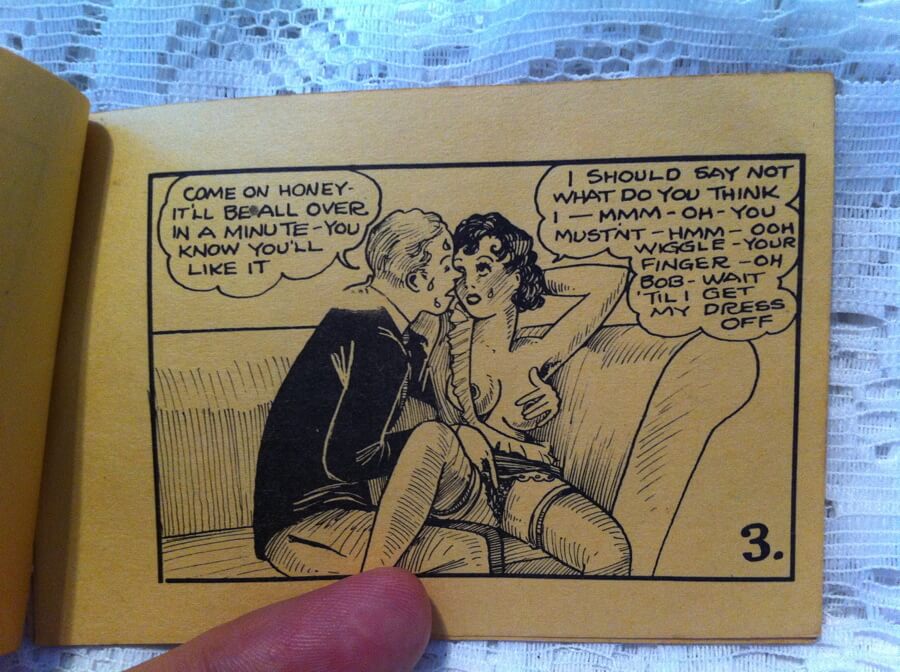
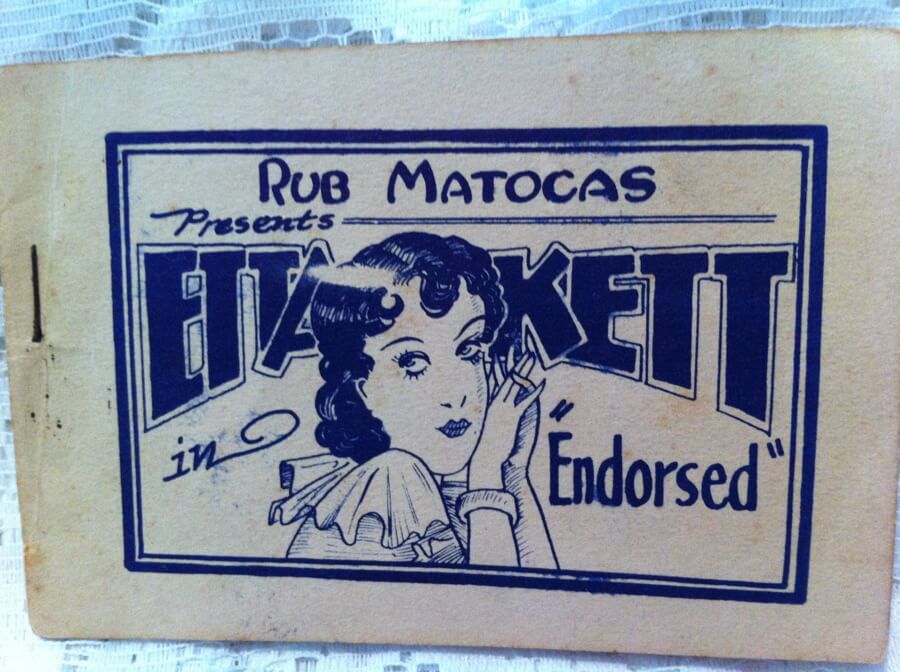 Rub Matocas Presents Etta Kett in "Endorsed", (n.p. n.d.) 4.5" x 3", 8pp. pamphlet, stapled Tijuana bibles (also known as eight-pagers, bluesies, gray-backs, Jiggs-and-Maggie books, jo-jo books, Tillie-and-Mac books, and two-by-fours) were little pornographic comic books produced in the United States from the 1920s to the early 1960s. Etta Kett was a long-run comic strip launched in December 1925, it originally offered tips to teenagers on manners, etiquette and the social graces.
Rub Matocas Presents Etta Kett in "Endorsed", (n.p. n.d.) 4.5" x 3", 8pp. pamphlet, stapled Tijuana bibles (also known as eight-pagers, bluesies, gray-backs, Jiggs-and-Maggie books, jo-jo books, Tillie-and-Mac books, and two-by-fours) were little pornographic comic books produced in the United States from the 1920s to the early 1960s. Etta Kett was a long-run comic strip launched in December 1925, it originally offered tips to teenagers on manners, etiquette and the social graces. -
 Etude Sur La Bestialite Au Point de Vue Historique, Medical et Juridique, G. Dubois-Desaulle (Charles Carrington, Paris, 1905, #437/500, printed Felix Guy et Cie, Aleçon) 10"x7.25", 2 volumes, xii+443pp, Holland paper , modern binding half-calf over red boards, gilt title and decorations on spine, original paper covers bound inside, fore and bottom edges deckled, some pages uncut, very good condition for age, clean. Study of bestiality from the historical, medical and legal point of view. A very nice copy of a VERY rare book.
Etude Sur La Bestialite Au Point de Vue Historique, Medical et Juridique, G. Dubois-Desaulle (Charles Carrington, Paris, 1905, #437/500, printed Felix Guy et Cie, Aleçon) 10"x7.25", 2 volumes, xii+443pp, Holland paper , modern binding half-calf over red boards, gilt title and decorations on spine, original paper covers bound inside, fore and bottom edges deckled, some pages uncut, very good condition for age, clean. Study of bestiality from the historical, medical and legal point of view. A very nice copy of a VERY rare book. -
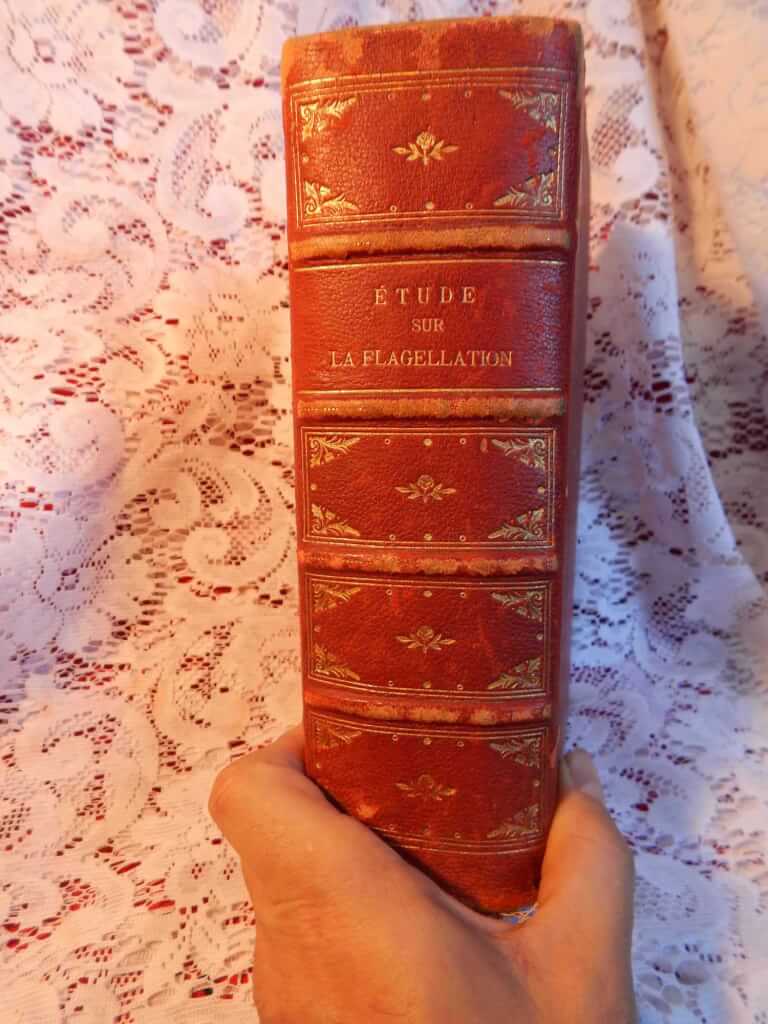
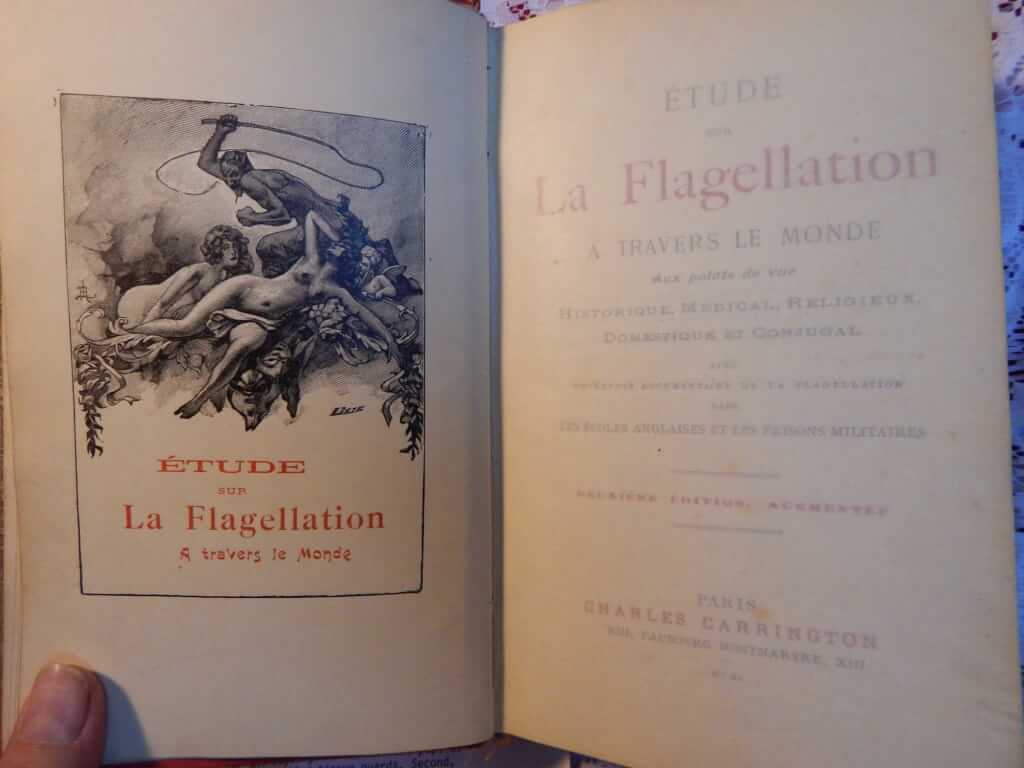 Étude sur La Flagellation a travers le monde aux points de vue Historique, Medical, Religieux, Domestique et Conjugal | avec un exposé documentaire de la flagellation dans Les écoles anglaises et les prisons militaires, Deuxiéme Édition, Augmentée [Study of the Flagellation throughout the world from the historical, medical, religious, domestic and marital points of view | with a documentary presentation of flogging in English Schools and Military Prisons, Second Edition, Augmented], by Jean de Villiot [pseud. most likely of Charles Carrington, Hugues Rebell and Hector France],illust. by René Lelong, (Charles Carrington, Paris, 1901, "Second Edition Augmented", printed by Achevé d'imprimer le 29 septembre 1900 par Em. Pivoteau. Imprimeur à Saint-Amand-Mont-Rond (Cher)) 5.5"x8.5", xxiv+646pp, quarter-bound in red morocco over red boards, 4 raised bands, gilt titles and decorations on spine, marbled paste-downs, all edges gilt, ribbon intact, binding frayed a bit at bottom, some rubbing and stains, otherwise very good condition for age, frontispiece and 20 B&W illustrations by René Lelong tipped in with titled tissue guards. This book is the compilation and expansion of a few other books previously published by Charles Carrington including the original Étude sur La Flagellation a travers le monde published in 1898. It represents a more complete representation of those writings beautifully bound into one book, covering studies on flogging through the centuries, flogging in England, flogging in the history of France (the cases of Madame Du Barry, the Marquise de Rosen.), the flogging from the medical point of view where one learns its healing properties, flogging in literature or the art of using it for pleasure, the discipline to school and domestic and spousal corrections, and "in our current society". Jean de Villiot is a pseudonym frequently used by Carrington and the various authors he relied upon, especially for works that involved flagellation. The illustrator, René Lelong was a third class medalist at the Salon des artistes français of 1895 which he became a member from 1898. He has produced advertising posters and illustrated numerous books and texts. He was a professor at the Julian Academy from 1879 to 1891.
Étude sur La Flagellation a travers le monde aux points de vue Historique, Medical, Religieux, Domestique et Conjugal | avec un exposé documentaire de la flagellation dans Les écoles anglaises et les prisons militaires, Deuxiéme Édition, Augmentée [Study of the Flagellation throughout the world from the historical, medical, religious, domestic and marital points of view | with a documentary presentation of flogging in English Schools and Military Prisons, Second Edition, Augmented], by Jean de Villiot [pseud. most likely of Charles Carrington, Hugues Rebell and Hector France],illust. by René Lelong, (Charles Carrington, Paris, 1901, "Second Edition Augmented", printed by Achevé d'imprimer le 29 septembre 1900 par Em. Pivoteau. Imprimeur à Saint-Amand-Mont-Rond (Cher)) 5.5"x8.5", xxiv+646pp, quarter-bound in red morocco over red boards, 4 raised bands, gilt titles and decorations on spine, marbled paste-downs, all edges gilt, ribbon intact, binding frayed a bit at bottom, some rubbing and stains, otherwise very good condition for age, frontispiece and 20 B&W illustrations by René Lelong tipped in with titled tissue guards. This book is the compilation and expansion of a few other books previously published by Charles Carrington including the original Étude sur La Flagellation a travers le monde published in 1898. It represents a more complete representation of those writings beautifully bound into one book, covering studies on flogging through the centuries, flogging in England, flogging in the history of France (the cases of Madame Du Barry, the Marquise de Rosen.), the flogging from the medical point of view where one learns its healing properties, flogging in literature or the art of using it for pleasure, the discipline to school and domestic and spousal corrections, and "in our current society". Jean de Villiot is a pseudonym frequently used by Carrington and the various authors he relied upon, especially for works that involved flagellation. The illustrator, René Lelong was a third class medalist at the Salon des artistes français of 1895 which he became a member from 1898. He has produced advertising posters and illustrated numerous books and texts. He was a professor at the Julian Academy from 1879 to 1891. -

 Experiences of Flagellation: A Series of Remarkable Instances of Whipping Inflicted on Both Sexes, With Curious Anecdotes of Ladies Fond of Administering Birch Discipline., "compiled by An Amateur Flagallant" (Printed for Private Circulation, London, 1885, first edition) 5.25"x 8", 80pp, hardbound no DJ, tan boards with blue spine, fair condition for age, some bumping to boards, binding fragile but holding, split between first and second signature, page 15/16 detached. A great read! Forward asserts God ordained pain and punishment, even animals fear it, it is his police department, not to punish is to keep a boy out of God's school. The rod should be used ceremoniously. Even girls up to 18 have often ben greatly improved for life by "Dr. Spankster's" cure wisely administered. Sections include: Flogging Girls, Wife Beating, A Conjugal Scene, Lady Preparing for Birching, and many more.
Experiences of Flagellation: A Series of Remarkable Instances of Whipping Inflicted on Both Sexes, With Curious Anecdotes of Ladies Fond of Administering Birch Discipline., "compiled by An Amateur Flagallant" (Printed for Private Circulation, London, 1885, first edition) 5.25"x 8", 80pp, hardbound no DJ, tan boards with blue spine, fair condition for age, some bumping to boards, binding fragile but holding, split between first and second signature, page 15/16 detached. A great read! Forward asserts God ordained pain and punishment, even animals fear it, it is his police department, not to punish is to keep a boy out of God's school. The rod should be used ceremoniously. Even girls up to 18 have often ben greatly improved for life by "Dr. Spankster's" cure wisely administered. Sections include: Flogging Girls, Wife Beating, A Conjugal Scene, Lady Preparing for Birching, and many more. -
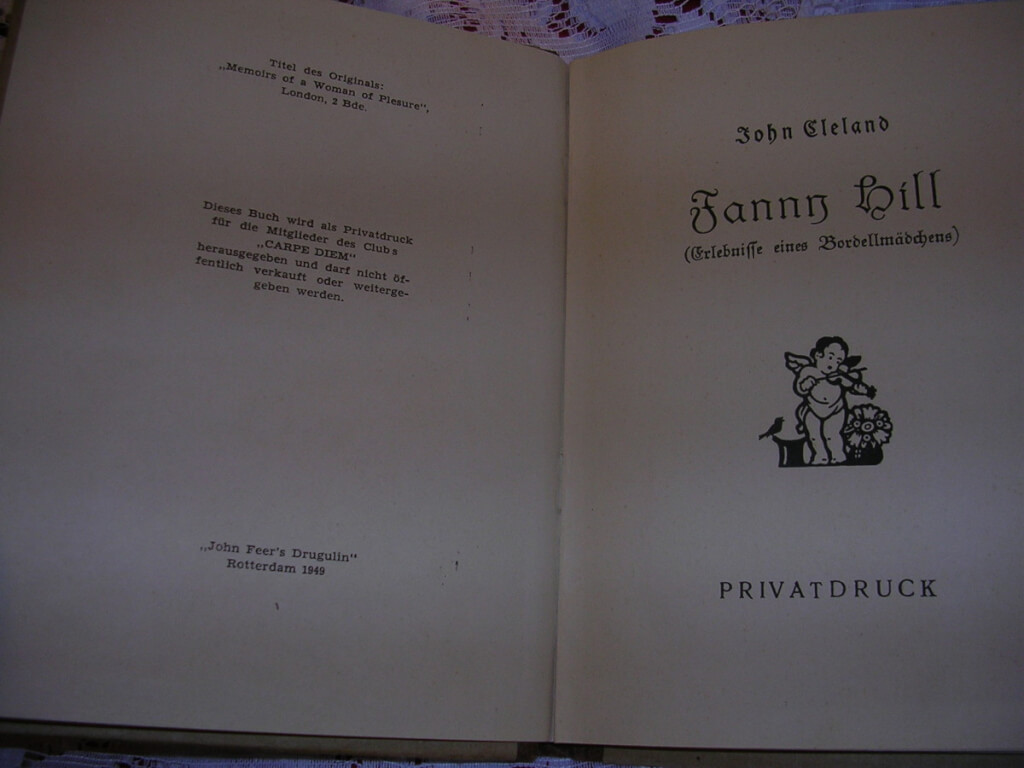
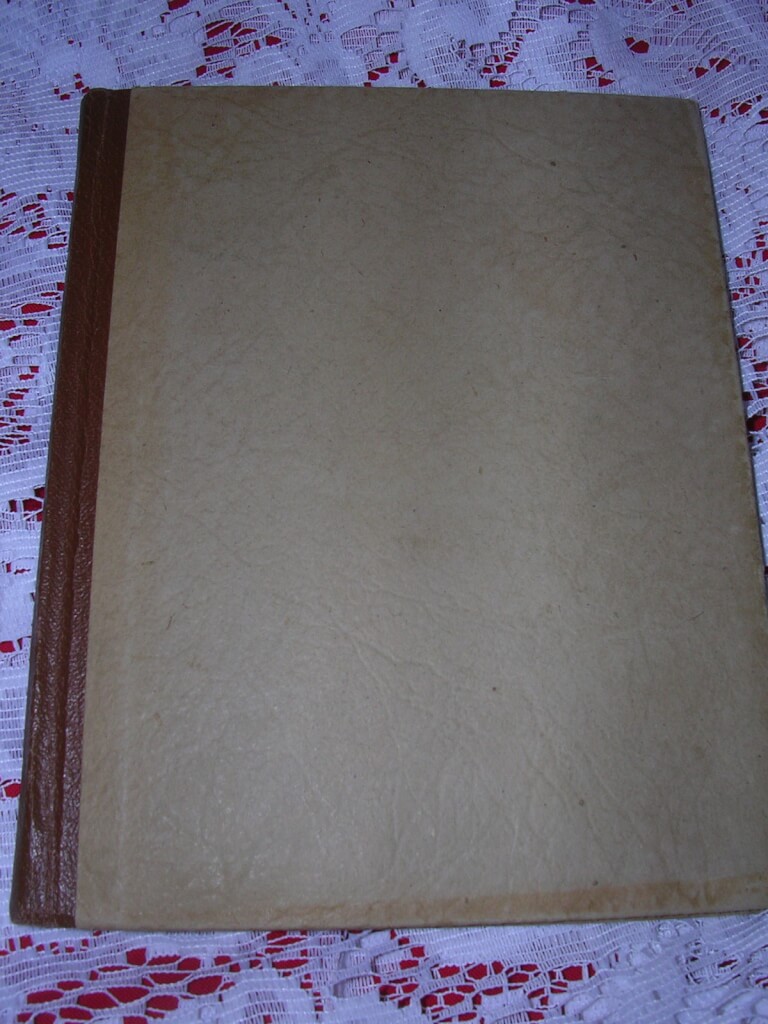 Fanny Hill (Erlebnisse eines Bordellmädchens.), John Cleland (Dieses Buch wird als Privatdruck für die Mitglieder des Clubs 'Carpe Diem' herausgegeben und darf nicht öffentlich verkauft oder weitergegeben werden. John Freer's Druglin, Rotterdam, 1949) 6.5" x 5.25", 78pp, hardbound tan paper over boards, faux leather spine. Good condition, slight foxing around edges of front cover. "This book is privately printed, published for the members of the 'Carpe Diem' club and must not be passed on or sold to the public." This was German "Bückware" or an item that was kept under the counter only for customers who asked for it. The book is labeled "Erstes Buch" (First Book). It is unknown whether this is a complete book. With only 79 pages, it might be a loosely translated edition or just the first volume. I have not found any similar books labeled anything but "Erste Buch"
Fanny Hill (Erlebnisse eines Bordellmädchens.), John Cleland (Dieses Buch wird als Privatdruck für die Mitglieder des Clubs 'Carpe Diem' herausgegeben und darf nicht öffentlich verkauft oder weitergegeben werden. John Freer's Druglin, Rotterdam, 1949) 6.5" x 5.25", 78pp, hardbound tan paper over boards, faux leather spine. Good condition, slight foxing around edges of front cover. "This book is privately printed, published for the members of the 'Carpe Diem' club and must not be passed on or sold to the public." This was German "Bückware" or an item that was kept under the counter only for customers who asked for it. The book is labeled "Erstes Buch" (First Book). It is unknown whether this is a complete book. With only 79 pages, it might be a loosely translated edition or just the first volume. I have not found any similar books labeled anything but "Erste Buch" -
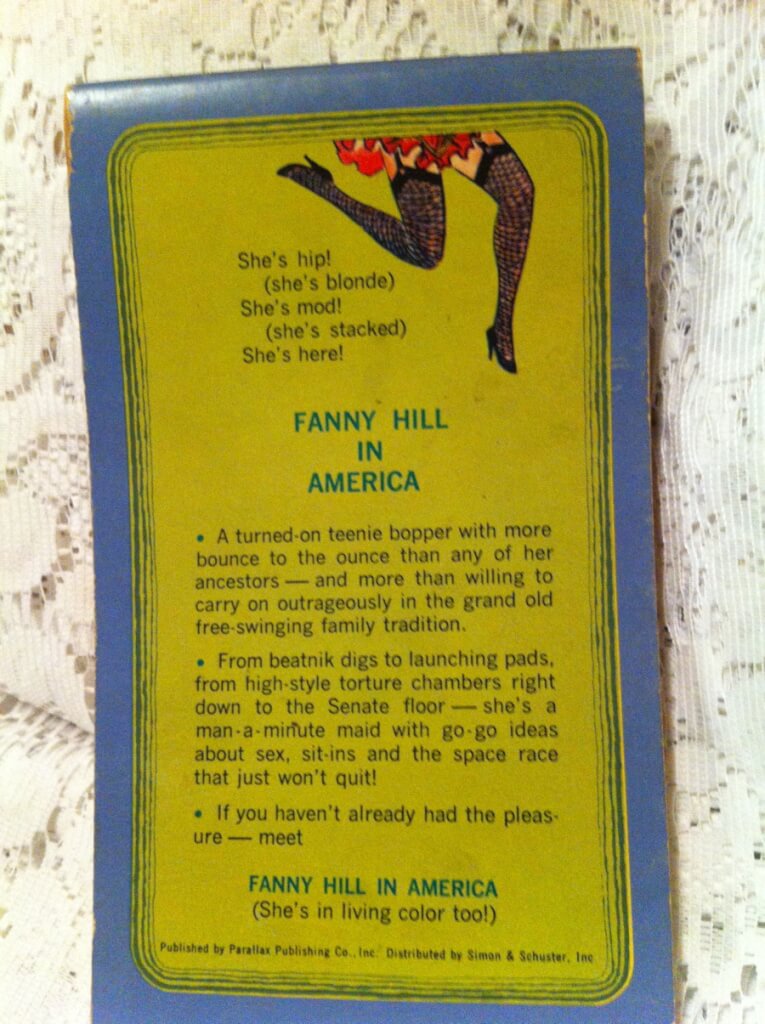
 Fanny Hill in America, by Frank Fosdick and David Sierra, cover by Jerry Schiano (Parallax Publishing Company, Inc, New York, Distributed by Simon & Schuster, Inc.) 7" x 4.25", soft cover comic book, cover scuffed and slightly soiled Stated "The first Go-Go Comic Novel in Full Color". As far as I can find it is the ONLY "Go-Go" Comic Novel. The Man from M.O.T.H.E.R. was also published in similar form saying "A Super-Cool Comic Novel in Full Color". Parallax is also hard to track down. I've only found mention of a few other comic books. all published in 1966 (The Great Society Comic Book[a parody of LBJ's social policies], it's companion comic, Bobman and Teddy [parodying Robert and Ted Kennedy], and the VERY rare Kosher Comics [featuring The Lone Arranger, Supermax, Tishman of the Apes, & Dick Shamus]). I can't find this publication listed at all. Other Parallax publications are similarly very rare.
Fanny Hill in America, by Frank Fosdick and David Sierra, cover by Jerry Schiano (Parallax Publishing Company, Inc, New York, Distributed by Simon & Schuster, Inc.) 7" x 4.25", soft cover comic book, cover scuffed and slightly soiled Stated "The first Go-Go Comic Novel in Full Color". As far as I can find it is the ONLY "Go-Go" Comic Novel. The Man from M.O.T.H.E.R. was also published in similar form saying "A Super-Cool Comic Novel in Full Color". Parallax is also hard to track down. I've only found mention of a few other comic books. all published in 1966 (The Great Society Comic Book[a parody of LBJ's social policies], it's companion comic, Bobman and Teddy [parodying Robert and Ted Kennedy], and the VERY rare Kosher Comics [featuring The Lone Arranger, Supermax, Tishman of the Apes, & Dick Shamus]). I can't find this publication listed at all. Other Parallax publications are similarly very rare. -
 Fanny Hill's Cook Book, Lionel H. Braun & William Adams, illustrations by Brian Forbes (Taplinger Publishing Co., Inc., New York, 1971 [first edition]) 9 3/8" X 6 1/8", 137pp, hardbound with DJ, good condition, binding tight, some soiling to front boards, few tears in dust jacket Rare and raunchy 70's cookbook. Highlights include "Whores d'oeuvres and snacks" featuring "Dildoughs with Warts in Hot Lips", "Pickled Peckers" and Marquise d'Salade with Crafty Ebbing Undressing". In the "Meat Dishes" section there is "Suc d'Meat", "Rump Roast or Backside Entree", and "Fellatio Mignon". There is a whole section "On Stuffing." The pasta section features "Cunnilinguini with Pietro's Tongue" and the dessert features among others "Jock's Strap", "The Nutcracker Sweet" and "Virgin's pushups with a few bawdy stories thrown in between the recipes. The illustrations are very fun. Very 70's. A good copy of a rare book.
Fanny Hill's Cook Book, Lionel H. Braun & William Adams, illustrations by Brian Forbes (Taplinger Publishing Co., Inc., New York, 1971 [first edition]) 9 3/8" X 6 1/8", 137pp, hardbound with DJ, good condition, binding tight, some soiling to front boards, few tears in dust jacket Rare and raunchy 70's cookbook. Highlights include "Whores d'oeuvres and snacks" featuring "Dildoughs with Warts in Hot Lips", "Pickled Peckers" and Marquise d'Salade with Crafty Ebbing Undressing". In the "Meat Dishes" section there is "Suc d'Meat", "Rump Roast or Backside Entree", and "Fellatio Mignon". There is a whole section "On Stuffing." The pasta section features "Cunnilinguini with Pietro's Tongue" and the dessert features among others "Jock's Strap", "The Nutcracker Sweet" and "Virgin's pushups with a few bawdy stories thrown in between the recipes. The illustrations are very fun. Very 70's. A good copy of a rare book. -
 Female Masturbation, New Illustrated Edition, G. Lombard Kelly, M.D. (Banner Books, Inglewood, Calif., 1966) 8.75" X 5.25", 192pp, softcover, good+ condition "A complete reprinting of Dr. Kelly's monograph on the subject of female auto-eroticism, as well as articles on the same subject by other well-known doctors including Edwin Hirsch, Bernhard Bauer, A. von Schrench-Notzing, J. Richardson Parke and Albert Moll."
Female Masturbation, New Illustrated Edition, G. Lombard Kelly, M.D. (Banner Books, Inglewood, Calif., 1966) 8.75" X 5.25", 192pp, softcover, good+ condition "A complete reprinting of Dr. Kelly's monograph on the subject of female auto-eroticism, as well as articles on the same subject by other well-known doctors including Edwin Hirsch, Bernhard Bauer, A. von Schrench-Notzing, J. Richardson Parke and Albert Moll." -
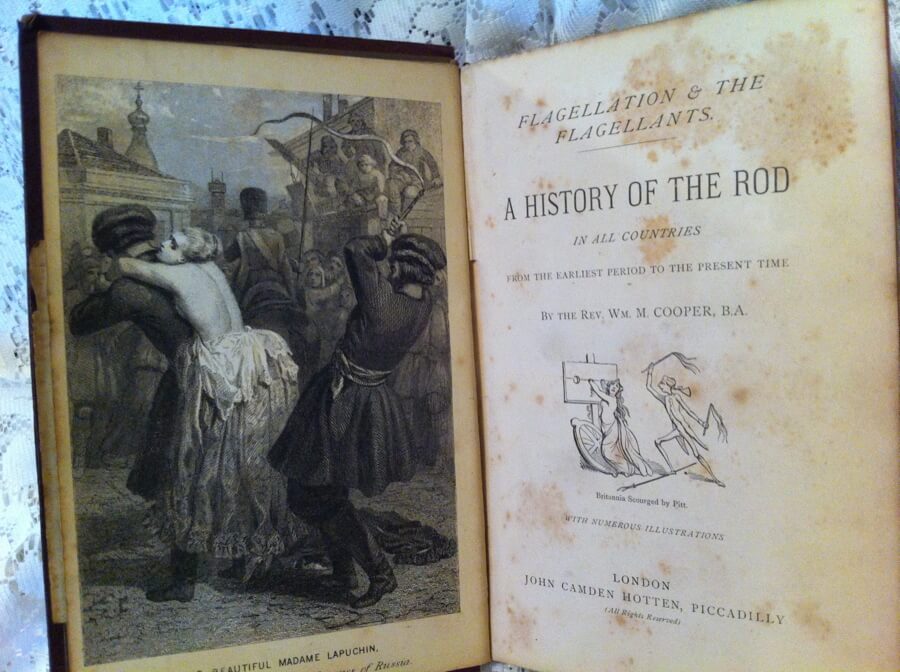
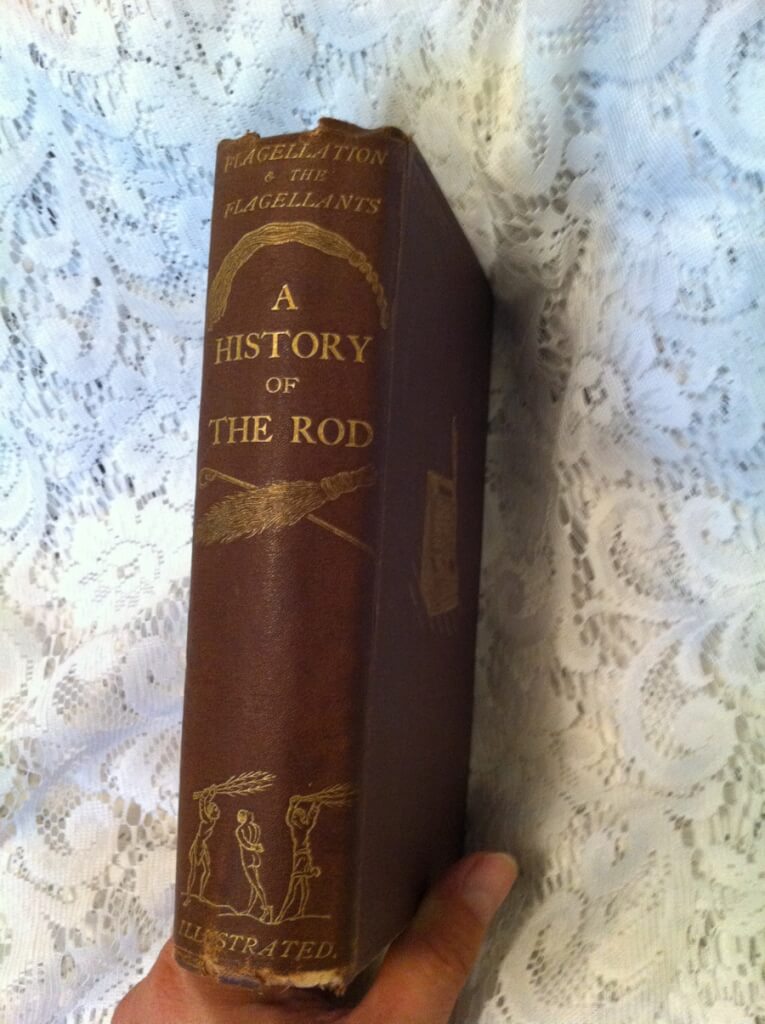 Flagellation & the Flagellants. a History of the Rod in All Countries, The Rev. Wm. M. Cooper, B.A. [James Glass Bertram] (John Camden Hotten, London, n.d. [1870, from ads at end of book]) 7 3/4" X 5 1/2", 544pp plus 32 pages of advertisements for "Very Important New Books", hardbound with red cloth, gilt lettering and decorations, spine worn at top and bottom and lower front, Binder's ticket on lower pastedown: "Bound by W. Bone and Son. 76 Fleet St. London E.C.", front pastdown has cute bookplate asking the book be returned to Robert Day, front end-paper has armorial bookplate of Robert Day. Good condition, corners bumped, top and bottom of spine worn, back boards loose but holding. Bertram was apprenticed to Tait's Edinburgh Magazine and became managing clerk, before joining a company of strolling players. He returned to Edinburgh and set up as a bookseller and newsagent. In 1855 he was appointed the editor of the North Briton and in 1872 of the Glasgow News, leaving to become a freelance journalist two years later. He published "flagellation" pornography under the names "Revd William Cooper" and "Margaret Anson". Illustrated throughout with a colored frontispiece. The bookplate is of Robert Day (1836_1914), an Irish antiquarian and photographer who collaborated with Franz Tieze in producing imitation Williamite, Jacobite and Irish Volunteer glassware. He was an important and well-travelled antiquarian collector. He was involved in his family's extensive saddlery business together with a sports shop well known to Cork anglers.
Flagellation & the Flagellants. a History of the Rod in All Countries, The Rev. Wm. M. Cooper, B.A. [James Glass Bertram] (John Camden Hotten, London, n.d. [1870, from ads at end of book]) 7 3/4" X 5 1/2", 544pp plus 32 pages of advertisements for "Very Important New Books", hardbound with red cloth, gilt lettering and decorations, spine worn at top and bottom and lower front, Binder's ticket on lower pastedown: "Bound by W. Bone and Son. 76 Fleet St. London E.C.", front pastdown has cute bookplate asking the book be returned to Robert Day, front end-paper has armorial bookplate of Robert Day. Good condition, corners bumped, top and bottom of spine worn, back boards loose but holding. Bertram was apprenticed to Tait's Edinburgh Magazine and became managing clerk, before joining a company of strolling players. He returned to Edinburgh and set up as a bookseller and newsagent. In 1855 he was appointed the editor of the North Briton and in 1872 of the Glasgow News, leaving to become a freelance journalist two years later. He published "flagellation" pornography under the names "Revd William Cooper" and "Margaret Anson". Illustrated throughout with a colored frontispiece. The bookplate is of Robert Day (1836_1914), an Irish antiquarian and photographer who collaborated with Franz Tieze in producing imitation Williamite, Jacobite and Irish Volunteer glassware. He was an important and well-travelled antiquarian collector. He was involved in his family's extensive saddlery business together with a sports shop well known to Cork anglers. -
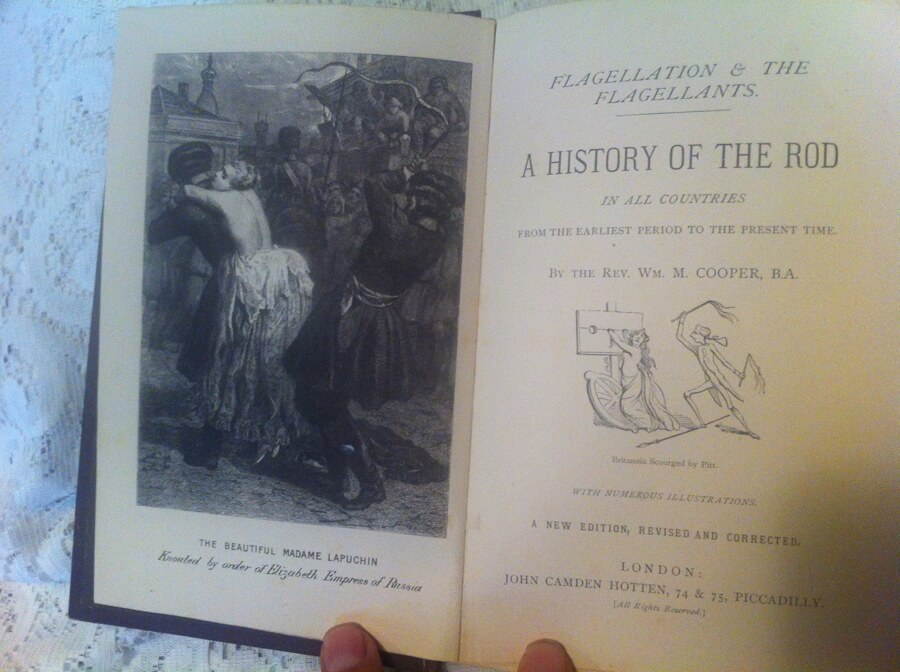
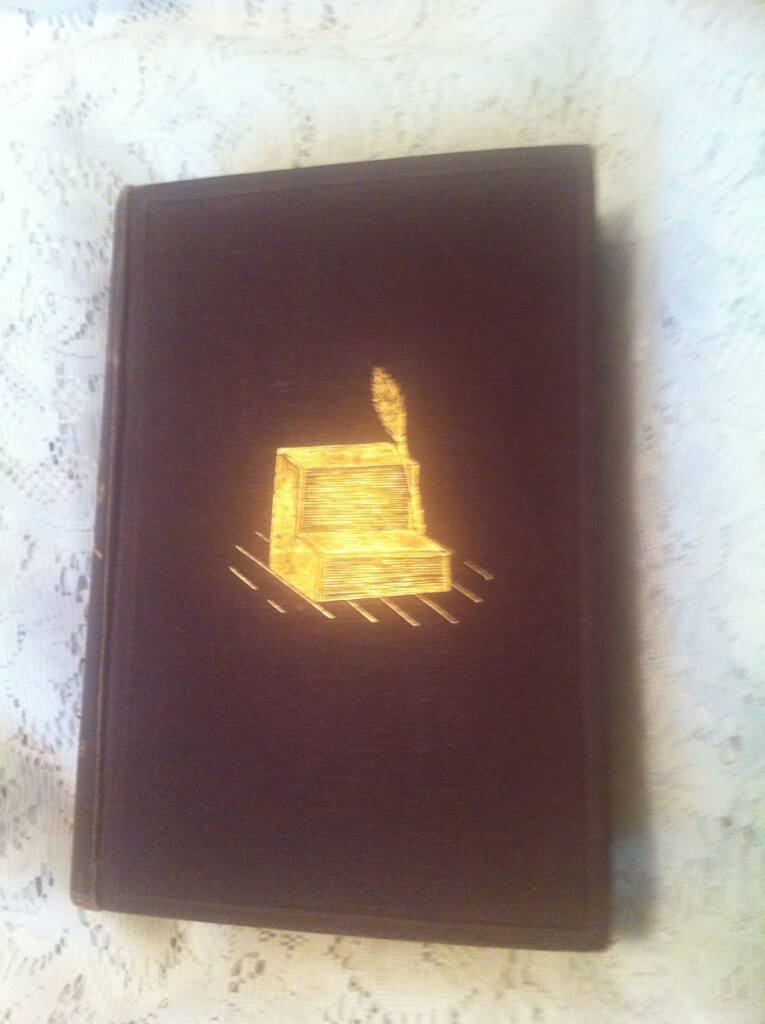 Flagellation & the Flagellants. a History of the Rod in All Countries, The Rev. Wm. M. Cooper, B.A. [James Glass Bertram] (John Camden Hotten, London, n.d. [1873, from ads at end of book] "a new edition revised and corrected") 7 3/4" X 5 1/2", 544pp plus 32 pages of advertisements for "Very Important New Books", hardbound with red cloth, gilt lettering and decorations, spine worn at top and bottom and lower front, Very Good condition, corners bumped, top and bottom of spine worn, boards slightly loose. Ex libris: "From the library of Walter Wentworth Allerton" Bertram was apprenticed to Tait's Edinburgh Magazine and became managing clerk, before joining a company of strolling players. He returned to Edinburgh and set up as a bookseller and newsagent. In 1855 he was appointed the editor of the North Briton and in 1872 of the Glasgow News, leaving to become a freelance journalist two years later. He published "flagellation" pornography under the names "Revd William Cooper" and "Margaret Anson". Illustrated throughout. This is a later "newly revised edition" from Hotten and the version used for the Reeves edition.
Flagellation & the Flagellants. a History of the Rod in All Countries, The Rev. Wm. M. Cooper, B.A. [James Glass Bertram] (John Camden Hotten, London, n.d. [1873, from ads at end of book] "a new edition revised and corrected") 7 3/4" X 5 1/2", 544pp plus 32 pages of advertisements for "Very Important New Books", hardbound with red cloth, gilt lettering and decorations, spine worn at top and bottom and lower front, Very Good condition, corners bumped, top and bottom of spine worn, boards slightly loose. Ex libris: "From the library of Walter Wentworth Allerton" Bertram was apprenticed to Tait's Edinburgh Magazine and became managing clerk, before joining a company of strolling players. He returned to Edinburgh and set up as a bookseller and newsagent. In 1855 he was appointed the editor of the North Briton and in 1872 of the Glasgow News, leaving to become a freelance journalist two years later. He published "flagellation" pornography under the names "Revd William Cooper" and "Margaret Anson". Illustrated throughout. This is a later "newly revised edition" from Hotten and the version used for the Reeves edition. -
 Flagellation & the Flagellants. A History of the Rod in All Countries from the earliest period to the present time, The Rev. Wm. M. Cooper, B.A. [James Glass Bertram] (William Reeves Bookseller Limited, London, nd [c. 1908]) 7 3/4" X 5 1/4", 544pp, hardbound no DJ, dark purple cloth boards with gilt stamp and blind stamp decorations to boards and spine, price is marked on spine in gilt "12/6" (12 shilling, 6 penny), gilting is faded, good condition, minor bumping and rubbing, binding good but leaning slightly, back board hinges worn but holding. Bertram was apprenticed to Tait's Edinburgh Magazine and became managing clerk, before joining a company of strolling players. He returned to Edinburgh and set up as a bookseller and newsagent. In 1855 he was appointed the editor of the North Briton and in 1872 of the Glasgow News, leaving to become a freelance journalist two years later. He published "flagellation" pornography under the names "Revd William Cooper" and "Margaret Anson". This edition was published by William Reeves sometime around 1908.
Flagellation & the Flagellants. A History of the Rod in All Countries from the earliest period to the present time, The Rev. Wm. M. Cooper, B.A. [James Glass Bertram] (William Reeves Bookseller Limited, London, nd [c. 1908]) 7 3/4" X 5 1/4", 544pp, hardbound no DJ, dark purple cloth boards with gilt stamp and blind stamp decorations to boards and spine, price is marked on spine in gilt "12/6" (12 shilling, 6 penny), gilting is faded, good condition, minor bumping and rubbing, binding good but leaning slightly, back board hinges worn but holding. Bertram was apprenticed to Tait's Edinburgh Magazine and became managing clerk, before joining a company of strolling players. He returned to Edinburgh and set up as a bookseller and newsagent. In 1855 he was appointed the editor of the North Briton and in 1872 of the Glasgow News, leaving to become a freelance journalist two years later. He published "flagellation" pornography under the names "Revd William Cooper" and "Margaret Anson". This edition was published by William Reeves sometime around 1908. -
Out of stock
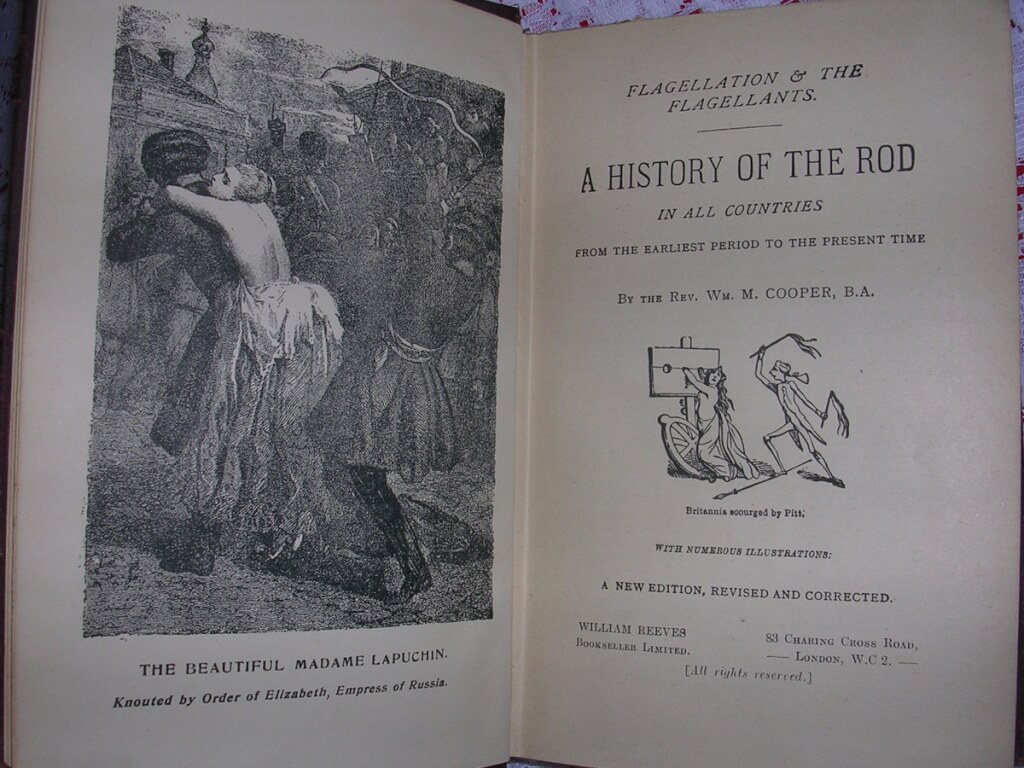
 Flagellation & the Flagellants. A History of the Rod in All Countries from the earliest period to the present time, The Rev. Wm. M. Cooper, B.A. [James Glass Bertram] (William Reeves Bookseller Limited, London, nd [c. 1908]) 7 3/4" X 5 1/4", 544pp, hardbound no DJ, dark purple cloth boards with gilt stamp and blind stamp decorations to boards and spine, good condition, minor bumping and rubbing, a few stains on lower fore-edge of boards. Bertram was apprenticed to Tait's Edinburgh Magazine and became managing clerk, before joining a company of strolling players. He returned to Edinburgh and set up as a bookseller and newsagent. In 1855 he was appointed the editor of the North Briton and in 1872 of the Glasgow News, leaving to become a freelance journalist two years later. He published "flagellation" pornography under the names "Revd William Cooper" and "Margaret Anson". This edition was published by William Reeves sometime around 1908.
Flagellation & the Flagellants. A History of the Rod in All Countries from the earliest period to the present time, The Rev. Wm. M. Cooper, B.A. [James Glass Bertram] (William Reeves Bookseller Limited, London, nd [c. 1908]) 7 3/4" X 5 1/4", 544pp, hardbound no DJ, dark purple cloth boards with gilt stamp and blind stamp decorations to boards and spine, good condition, minor bumping and rubbing, a few stains on lower fore-edge of boards. Bertram was apprenticed to Tait's Edinburgh Magazine and became managing clerk, before joining a company of strolling players. He returned to Edinburgh and set up as a bookseller and newsagent. In 1855 he was appointed the editor of the North Briton and in 1872 of the Glasgow News, leaving to become a freelance journalist two years later. He published "flagellation" pornography under the names "Revd William Cooper" and "Margaret Anson". This edition was published by William Reeves sometime around 1908. -
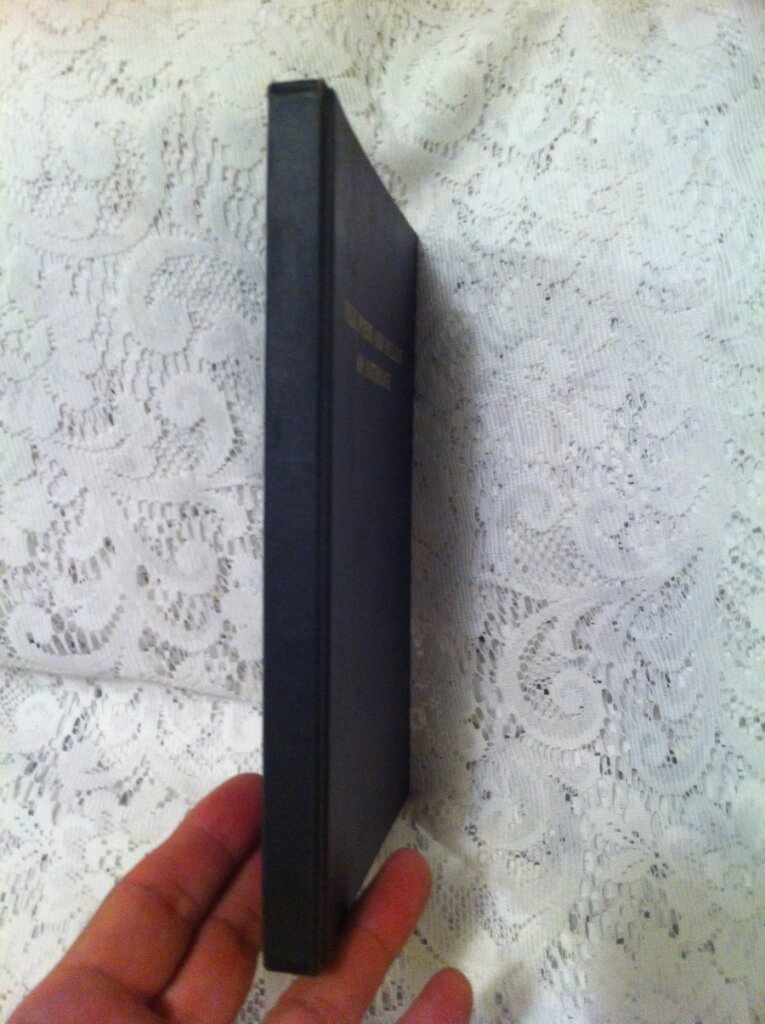
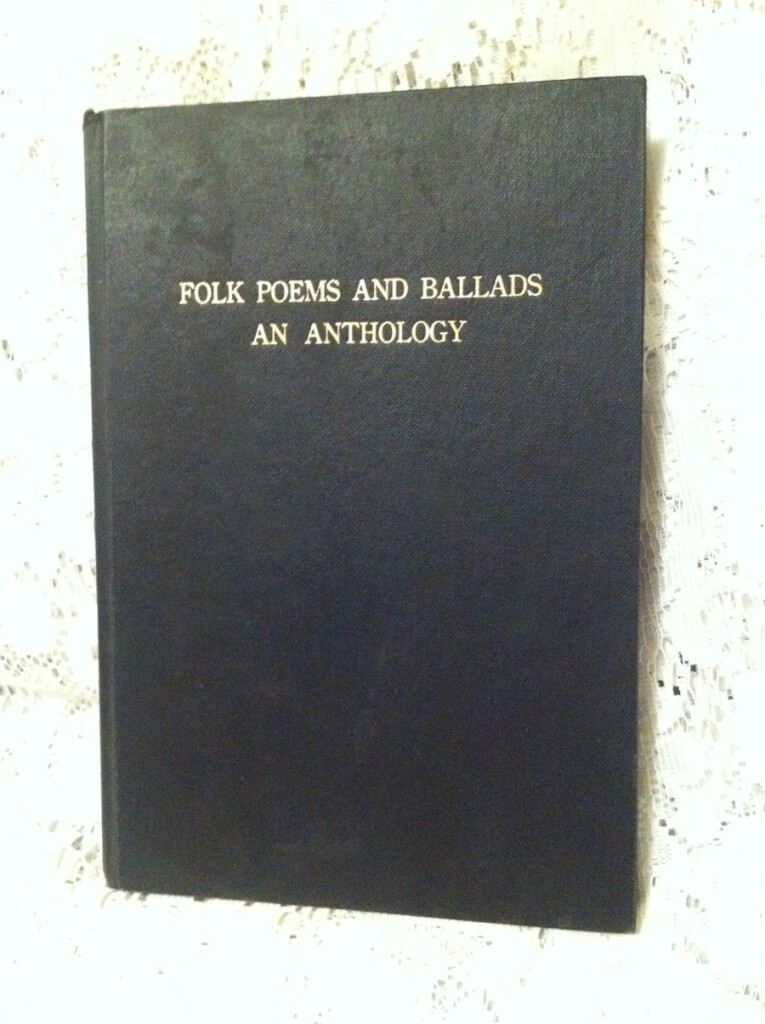 Folk Poems and Ballads An Anthology, anonymous [A. Reynolds Morse] ( Cruciform Press, Mexico City: Privately Printed for Private Circulation to Subscribers Only, 1944 [Cleveland, Ohio: A. Reynolds Morse, 1948.] #230/250) 8" X 5.5", vi 128pp. Hardbound, black cloth boards, gilt lettering on cover. Fair condition, 1st signature detached, 4th signature loose but holding (a common problem with these books), good copy of a poorly made book. Subtitled: "A collection of rare verses and amusing folk songs compiled from scarce and suppressed books as well as from verbal sources which modern prudery, false social customs, and intolerance laws have separated from the public and historical record." A. Reynolds Morse was an American, born in 1914, who died in 2000. He moved to Cleveland from Denver in 1941. An industrialist and philanthropist, he is best known for his activity in collecting works by Salvador Dali, and founding the Salvador Dali Museum. According to his obituary in the New York Times, Reynolds and his wife "embarked on a sometimes turbulent friendship with Dali and his wife, Gala". He also had a hobby of collecting and publishing works that other publishers would not print. Title page: "A collection of rare verses and amusing folk songs compiled from scarce and suppressed books as well as from verbal sources which modern prudery, false social customs, and intolerance have separated from the public and historical record." Mr. Morse also published "Limericks, A Facet of Our Culture". Both books were suppressed by police action in the late 1940's. This is the more rare of the two books.
Folk Poems and Ballads An Anthology, anonymous [A. Reynolds Morse] ( Cruciform Press, Mexico City: Privately Printed for Private Circulation to Subscribers Only, 1944 [Cleveland, Ohio: A. Reynolds Morse, 1948.] #230/250) 8" X 5.5", vi 128pp. Hardbound, black cloth boards, gilt lettering on cover. Fair condition, 1st signature detached, 4th signature loose but holding (a common problem with these books), good copy of a poorly made book. Subtitled: "A collection of rare verses and amusing folk songs compiled from scarce and suppressed books as well as from verbal sources which modern prudery, false social customs, and intolerance laws have separated from the public and historical record." A. Reynolds Morse was an American, born in 1914, who died in 2000. He moved to Cleveland from Denver in 1941. An industrialist and philanthropist, he is best known for his activity in collecting works by Salvador Dali, and founding the Salvador Dali Museum. According to his obituary in the New York Times, Reynolds and his wife "embarked on a sometimes turbulent friendship with Dali and his wife, Gala". He also had a hobby of collecting and publishing works that other publishers would not print. Title page: "A collection of rare verses and amusing folk songs compiled from scarce and suppressed books as well as from verbal sources which modern prudery, false social customs, and intolerance have separated from the public and historical record." Mr. Morse also published "Limericks, A Facet of Our Culture". Both books were suppressed by police action in the late 1940's. This is the more rare of the two books. -
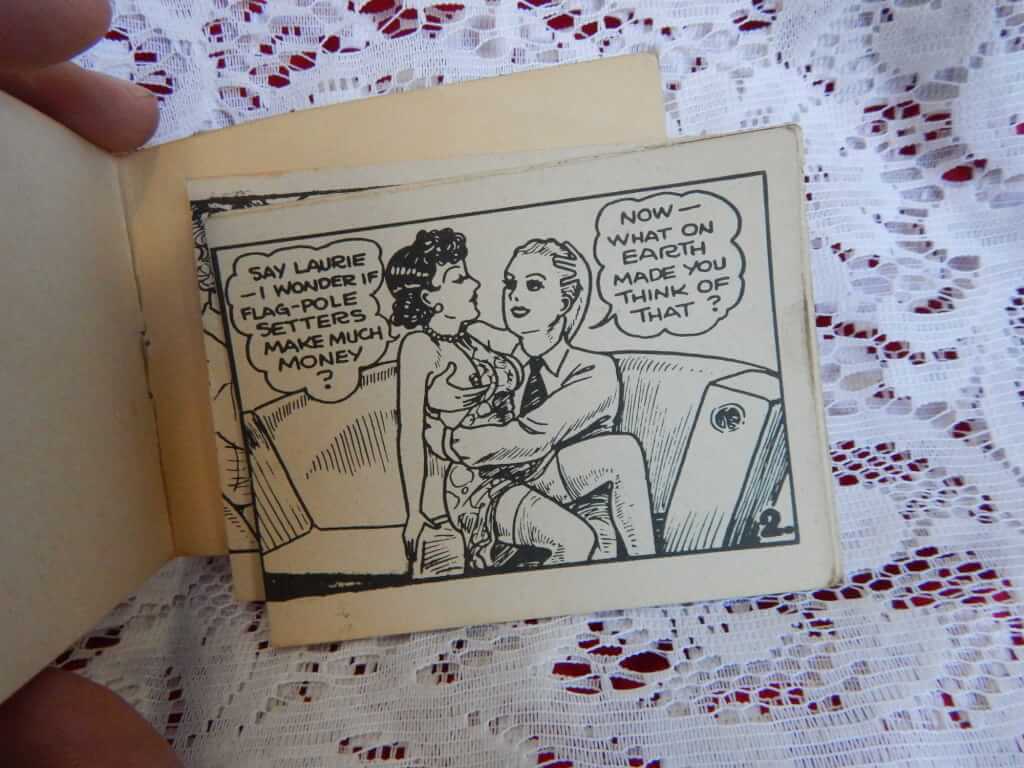
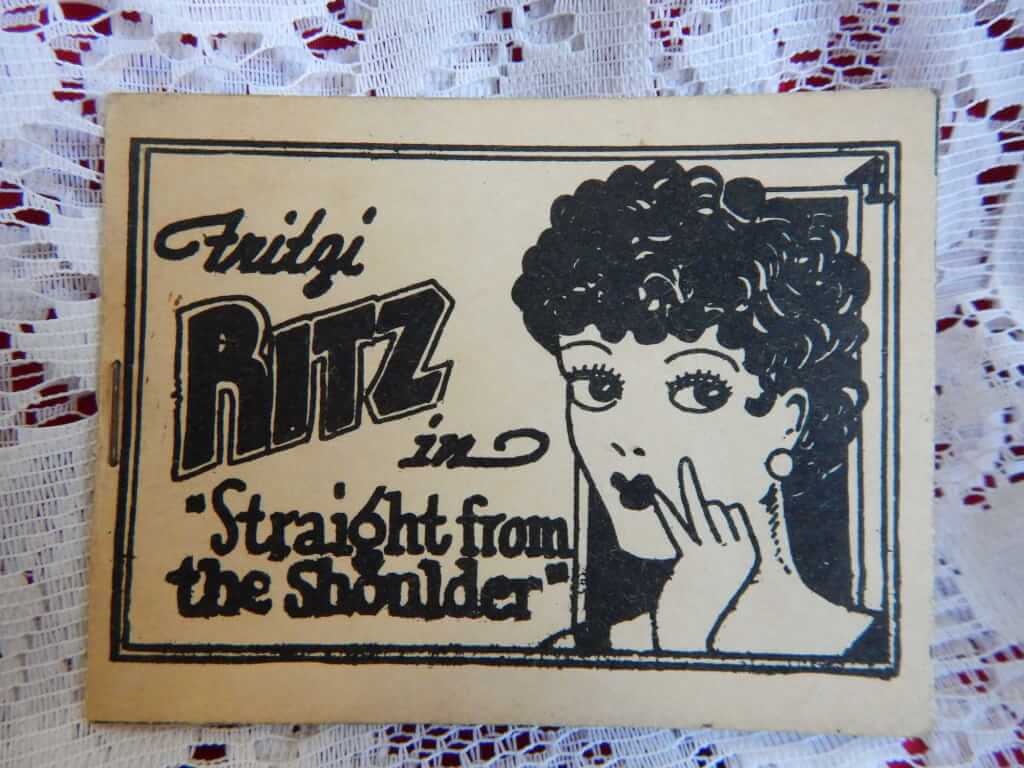 Fritzi Ritz in "Straight from the Shoulder", (n.p. n.d.) 4.5" x 3", 8pp. pamphlet, stapled, pages loose Tijuana bibles (also known as eight-pagers, bluesies, gray-backs, Jiggs-and-Maggie books, jo-jo books, Tillie-and-Mac books, and two-by-fours) were little pornographic comic books produced in the United States from the 1920s to the early 1960s.
Fritzi Ritz in "Straight from the Shoulder", (n.p. n.d.) 4.5" x 3", 8pp. pamphlet, stapled, pages loose Tijuana bibles (also known as eight-pagers, bluesies, gray-backs, Jiggs-and-Maggie books, jo-jo books, Tillie-and-Mac books, and two-by-fours) were little pornographic comic books produced in the United States from the 1920s to the early 1960s. -
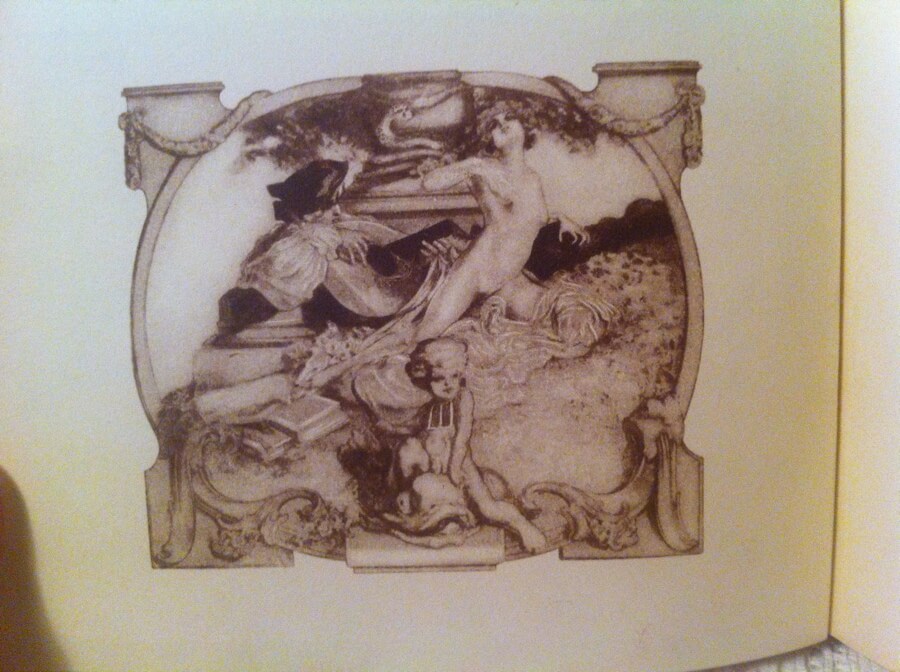
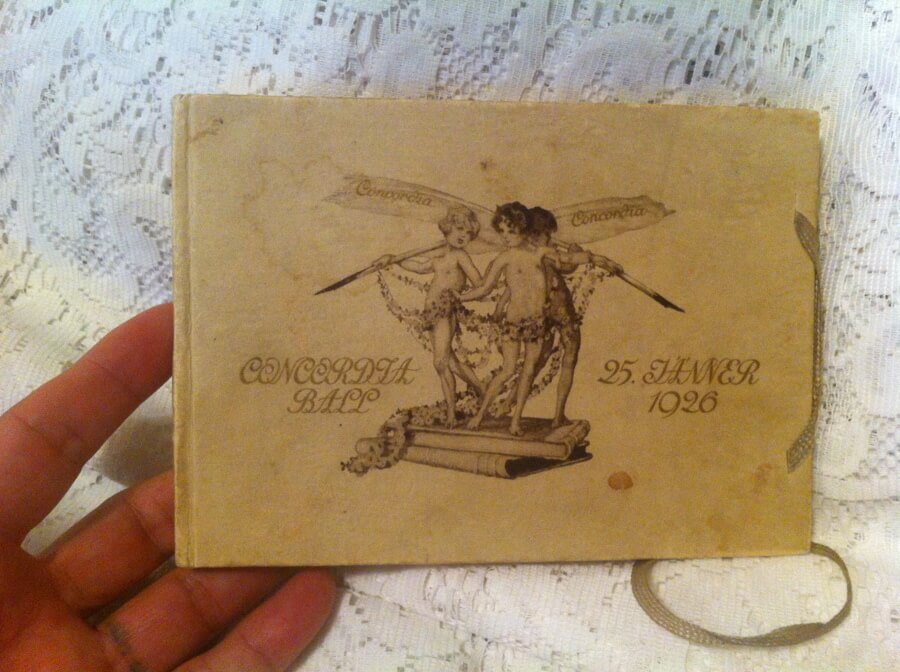 Galante Lieder und Gedichte, Concordia Ball 25. Jänner 1926 [Galante songs and poems with images after originals by Franz von Bayros selected by Johannes Pilz and Viktor Wögerer, Concordia Ball, January 25, 1926] (Der Presseclub Concordia, Strache, Vienna 1926) 6.5"x4.75", very good condition, boards slightly rubbed and stained, interior fine, with carrying strap intact. Press Club Concordia, an organization of Austrian journalists and writers, has been holding a traditional Viennese ball at the Vienna City Hall each June for over 150 years. In 1926 their program book featured art by Franz von Bayros. The illustrations feature both erotic and musical themes. This is a great piece of European/Austrian interbellum history, a rare find in this condition with the carrying strap still intact.
Galante Lieder und Gedichte, Concordia Ball 25. Jänner 1926 [Galante songs and poems with images after originals by Franz von Bayros selected by Johannes Pilz and Viktor Wögerer, Concordia Ball, January 25, 1926] (Der Presseclub Concordia, Strache, Vienna 1926) 6.5"x4.75", very good condition, boards slightly rubbed and stained, interior fine, with carrying strap intact. Press Club Concordia, an organization of Austrian journalists and writers, has been holding a traditional Viennese ball at the Vienna City Hall each June for over 150 years. In 1926 their program book featured art by Franz von Bayros. The illustrations feature both erotic and musical themes. This is a great piece of European/Austrian interbellum history, a rare find in this condition with the carrying strap still intact. -
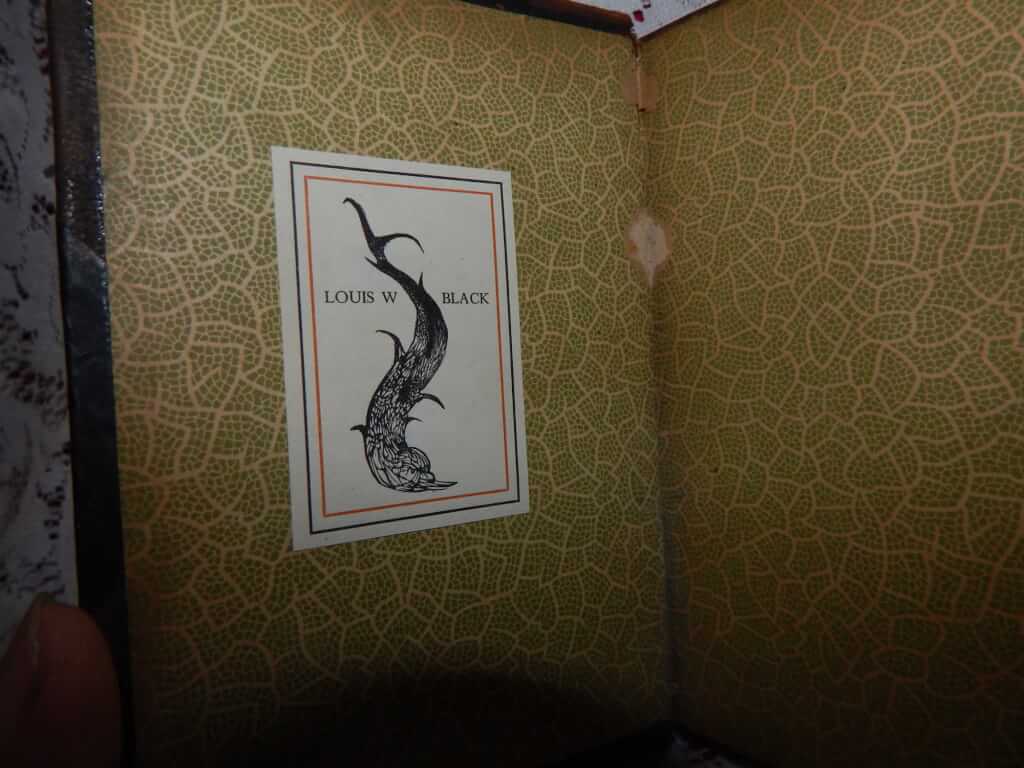
 Gamiani, ou deux nuits d'excés par Alcide, Baron de M***, anonymous [believed to have been written by Alfred de Musset] (G. Lebaucher, Libraire-Éditeur, Montreal, Canada [likely Gaucher, Malakoff, France] nd.) 4.5"x6", 144pp, half morocco over marbled boards, title in gilt on spine, 4 raised bands, boards cracked but holding, just good condition Gamiani, or Two Nights of Excess is a French erotic novel first published in 1833. Its authorship is anonymous, but it is believed to have been written by Alfred de Musset and the lesbian eponymous heroine a portrait of his lover, George Sand. It became a bestseller among nineteenth century erotic literature. Modeled after George Sand, this work gives us a young man named Alcide observing the Countess Gamiani and a young girl named Fanny, engaged in their lesbian bed. Having watched them and provoked by their abandonment, he reveals himself, joins them, and they spend the night alternately sharing their intimate histories and their bodies. The stories they tell include the rape of one in a monastery and the nearly fatal debauchment of another in a convent, as well as encounters with a number of animals, including an ape and a donkey. Elias Gaucher (publisher from 1898 until 1925(?)) was a Clandestine editor who mainly used the pseudonym G. Lebaucher, Libraire-Éditeur, Montreal (Canada), but also Maison Mystère, Imprimerie Galante, etc. This publisher published many erotic underground works in English from 1898 to about 1904 with the mentions "Printed for the Erotica Biblion Society of London and New York", he also published erotic texts in French from 1899. His printing press was actually located at 11 rue Danicourt in Malakoff, France. Gaucher left his works in deposit with booksellers-distributors [...] Most editions of Gaucher are counterfeit editions of Brancart or Hirsch, and Gaucher often republished his own works.
Gamiani, ou deux nuits d'excés par Alcide, Baron de M***, anonymous [believed to have been written by Alfred de Musset] (G. Lebaucher, Libraire-Éditeur, Montreal, Canada [likely Gaucher, Malakoff, France] nd.) 4.5"x6", 144pp, half morocco over marbled boards, title in gilt on spine, 4 raised bands, boards cracked but holding, just good condition Gamiani, or Two Nights of Excess is a French erotic novel first published in 1833. Its authorship is anonymous, but it is believed to have been written by Alfred de Musset and the lesbian eponymous heroine a portrait of his lover, George Sand. It became a bestseller among nineteenth century erotic literature. Modeled after George Sand, this work gives us a young man named Alcide observing the Countess Gamiani and a young girl named Fanny, engaged in their lesbian bed. Having watched them and provoked by their abandonment, he reveals himself, joins them, and they spend the night alternately sharing their intimate histories and their bodies. The stories they tell include the rape of one in a monastery and the nearly fatal debauchment of another in a convent, as well as encounters with a number of animals, including an ape and a donkey. Elias Gaucher (publisher from 1898 until 1925(?)) was a Clandestine editor who mainly used the pseudonym G. Lebaucher, Libraire-Éditeur, Montreal (Canada), but also Maison Mystère, Imprimerie Galante, etc. This publisher published many erotic underground works in English from 1898 to about 1904 with the mentions "Printed for the Erotica Biblion Society of London and New York", he also published erotic texts in French from 1899. His printing press was actually located at 11 rue Danicourt in Malakoff, France. Gaucher left his works in deposit with booksellers-distributors [...] Most editions of Gaucher are counterfeit editions of Brancart or Hirsch, and Gaucher often republished his own works. -
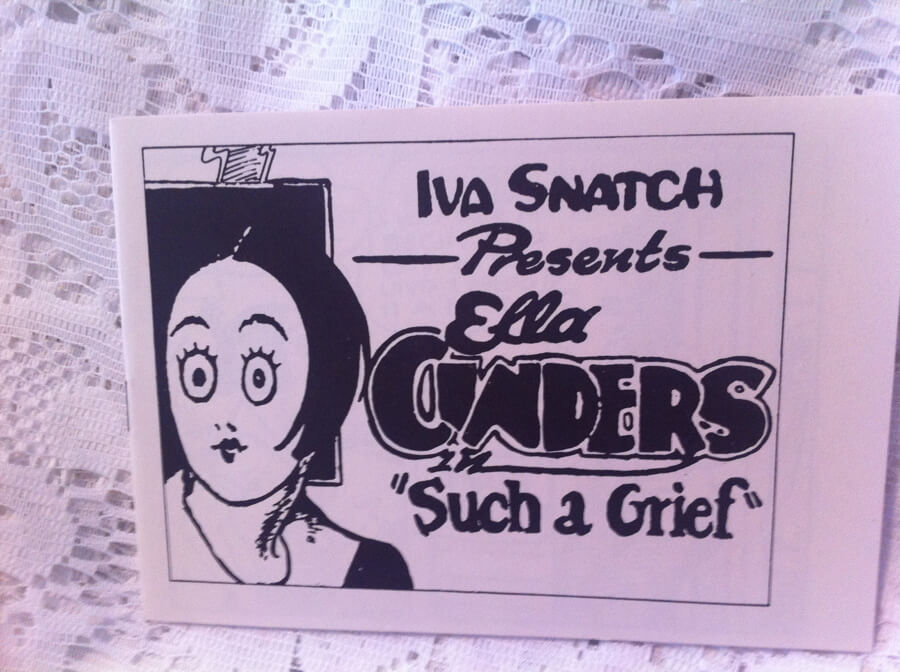
 George and Harry in "Doing Things" / Iva Snatch Presents Ella Cinders in "Such a Grief", (n.p., n.d.) 5" x 3.5", 8pp. double pamphlet, stapled Tijuana bibles (also known as eight-pagers, bluesies, gray-backs, Jiggs-and-Maggie books, jo-jo books, Tillie-and-Mac books, and two-by-fours) were little pornographic comic books produced in the United States from the 1920s to the early 1960s. This book is two books in one, featuring reprints of the originals printed on both sides of the paper. Flip the book over and it's a different book.
George and Harry in "Doing Things" / Iva Snatch Presents Ella Cinders in "Such a Grief", (n.p., n.d.) 5" x 3.5", 8pp. double pamphlet, stapled Tijuana bibles (also known as eight-pagers, bluesies, gray-backs, Jiggs-and-Maggie books, jo-jo books, Tillie-and-Mac books, and two-by-fours) were little pornographic comic books produced in the United States from the 1920s to the early 1960s. This book is two books in one, featuring reprints of the originals printed on both sides of the paper. Flip the book over and it's a different book. -
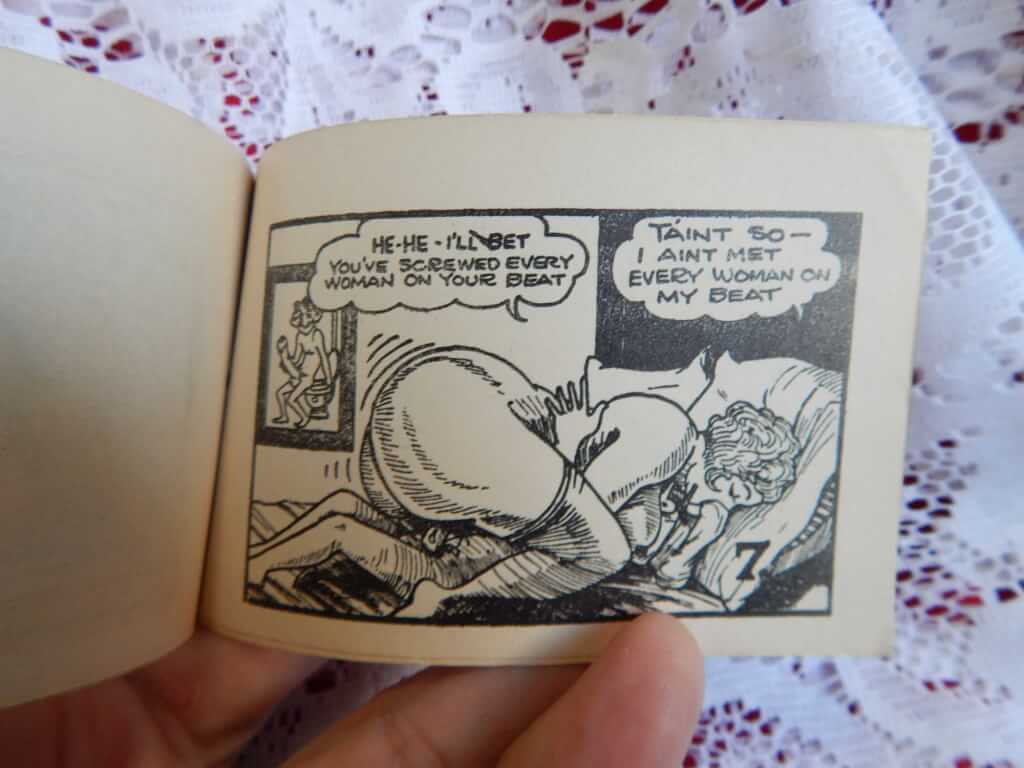
 Gertie Gulp presents Needlenose Noonan in "Heavy Duty", (n.p. n.d.) 4.5" x 3", 8pp. pamphlet, stapled Tijuana bibles (also known as eight-pagers, bluesies, gray-backs, Jiggs-and-Maggie books, jo-jo books, Tillie-and-Mac books, and two-by-fours) were little pornographic comic books produced in the United States from the 1920s to the early 1960s.
Gertie Gulp presents Needlenose Noonan in "Heavy Duty", (n.p. n.d.) 4.5" x 3", 8pp. pamphlet, stapled Tijuana bibles (also known as eight-pagers, bluesies, gray-backs, Jiggs-and-Maggie books, jo-jo books, Tillie-and-Mac books, and two-by-fours) were little pornographic comic books produced in the United States from the 1920s to the early 1960s. -
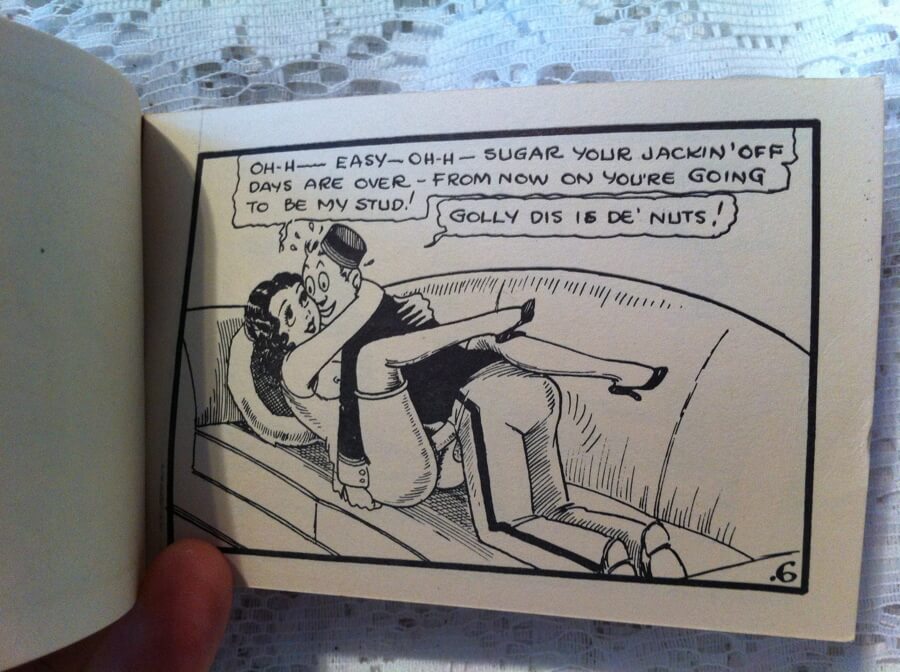
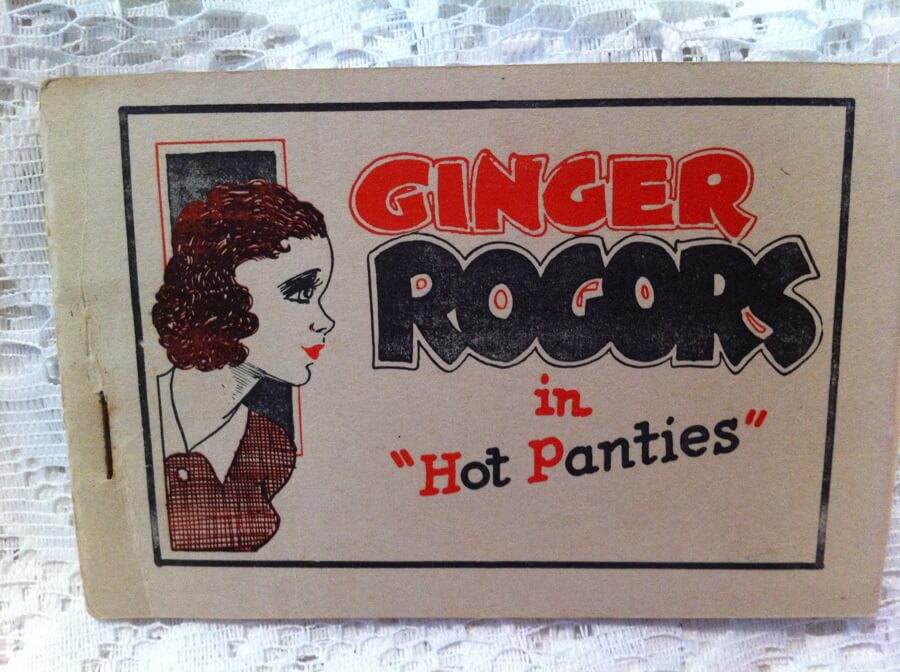 Ginger Rogers in "Hot Panties", (n.p. n.d.) 4.5" x 3", 8pp. pamphlet, stapled Tijuana bibles (also known as eight-pagers, bluesies, gray-backs, Jiggs-and-Maggie books, jo-jo books, Tillie-and-Mac books, and two-by-fours) were little pornographic comic books produced in the United States from the 1920s to the early 1960s.
Ginger Rogers in "Hot Panties", (n.p. n.d.) 4.5" x 3", 8pp. pamphlet, stapled Tijuana bibles (also known as eight-pagers, bluesies, gray-backs, Jiggs-and-Maggie books, jo-jo books, Tillie-and-Mac books, and two-by-fours) were little pornographic comic books produced in the United States from the 1920s to the early 1960s. -
 Blue Book Treasury of Classic Tails | Volume 1 | Goldilocks, "Translated from the Old Saxon and Illustrated by Sir Rod Q. M'Gurk, Knight of the Brush" (Classic Tails, Inc., 1972) 11" X 8.5", 32pp, soft covers, good condition, some minor bumping to corners & scuffing to covers, near fine internal pages. Blue Book Treasury of Classic Tails | Volume 2 | Jack and the Beanstalk, "Translated from the Old Saxon and Illustrated by Sir Rod Q. M'Gurk, Knight of the Brush" (Classic Tails, Inc., 1972) 11" X 8.5", 32pp, soft covers, just good condition, bumping to corners & scuffing/soiling to covers, near fine internal pages. Blue Book Treasury of Classic Tails | Volume 3 | Little Red Riding Hood, by Fud Dicksworth III (Classic Tails, Inc., 1972) 11" X 8.5", 32pp, soft covers, good+ condition, some bumping to corners, VERY rare. I've been able to find a few references to this book and very little about "Sir Rod Q. M'Gurk" or "Fud Dicksworth III". M'Gurk apparently also had his cartoons published in Swank magazine c. 1976-7. Eventually it came to the attention of some illustrators and (with help of former Disney animators) was made into a movie by Don Jurwich (not sure the connection between him and Sir Rod Q. M'Gurk, but I'd love to know if it was him).
Blue Book Treasury of Classic Tails | Volume 1 | Goldilocks, "Translated from the Old Saxon and Illustrated by Sir Rod Q. M'Gurk, Knight of the Brush" (Classic Tails, Inc., 1972) 11" X 8.5", 32pp, soft covers, good condition, some minor bumping to corners & scuffing to covers, near fine internal pages. Blue Book Treasury of Classic Tails | Volume 2 | Jack and the Beanstalk, "Translated from the Old Saxon and Illustrated by Sir Rod Q. M'Gurk, Knight of the Brush" (Classic Tails, Inc., 1972) 11" X 8.5", 32pp, soft covers, just good condition, bumping to corners & scuffing/soiling to covers, near fine internal pages. Blue Book Treasury of Classic Tails | Volume 3 | Little Red Riding Hood, by Fud Dicksworth III (Classic Tails, Inc., 1972) 11" X 8.5", 32pp, soft covers, good+ condition, some bumping to corners, VERY rare. I've been able to find a few references to this book and very little about "Sir Rod Q. M'Gurk" or "Fud Dicksworth III". M'Gurk apparently also had his cartoons published in Swank magazine c. 1976-7. Eventually it came to the attention of some illustrators and (with help of former Disney animators) was made into a movie by Don Jurwich (not sure the connection between him and Sir Rod Q. M'Gurk, but I'd love to know if it was him). -
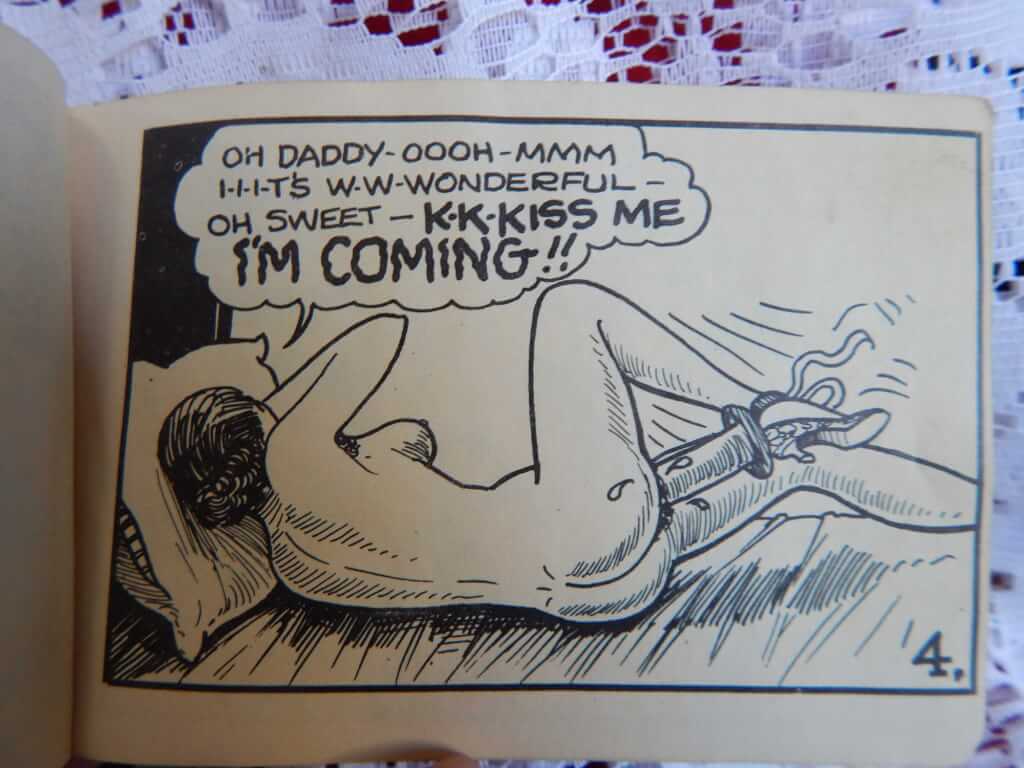
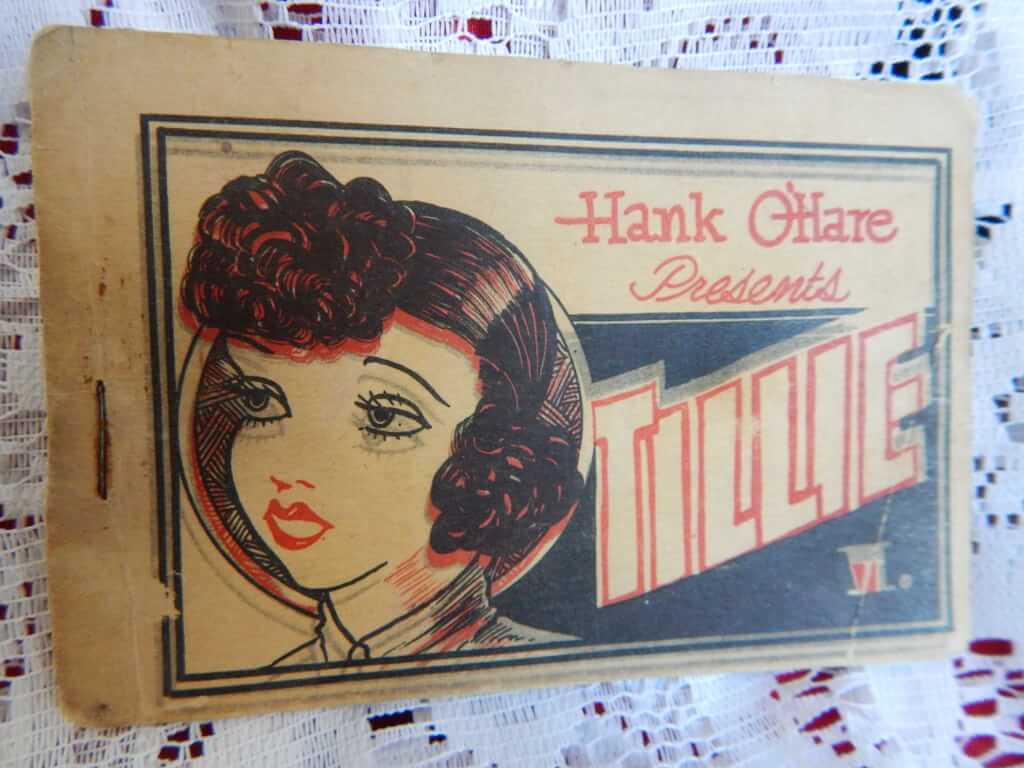 Hank O'Hare presents Tillie, (np. nd.) 4.5" x 3", 8pp., pamphlet, stapled and taped Tijuana bibles (also known as eight-pagers, bluesies, gray-backs, Jiggs-and-Maggie books, jo-jo books, Tillie-and-Mac books, and two-by-fours) were little pornographic comic books produced in the United States from the 1920s to the early 1960s.
Hank O'Hare presents Tillie, (np. nd.) 4.5" x 3", 8pp., pamphlet, stapled and taped Tijuana bibles (also known as eight-pagers, bluesies, gray-backs, Jiggs-and-Maggie books, jo-jo books, Tillie-and-Mac books, and two-by-fours) were little pornographic comic books produced in the United States from the 1920s to the early 1960s. -

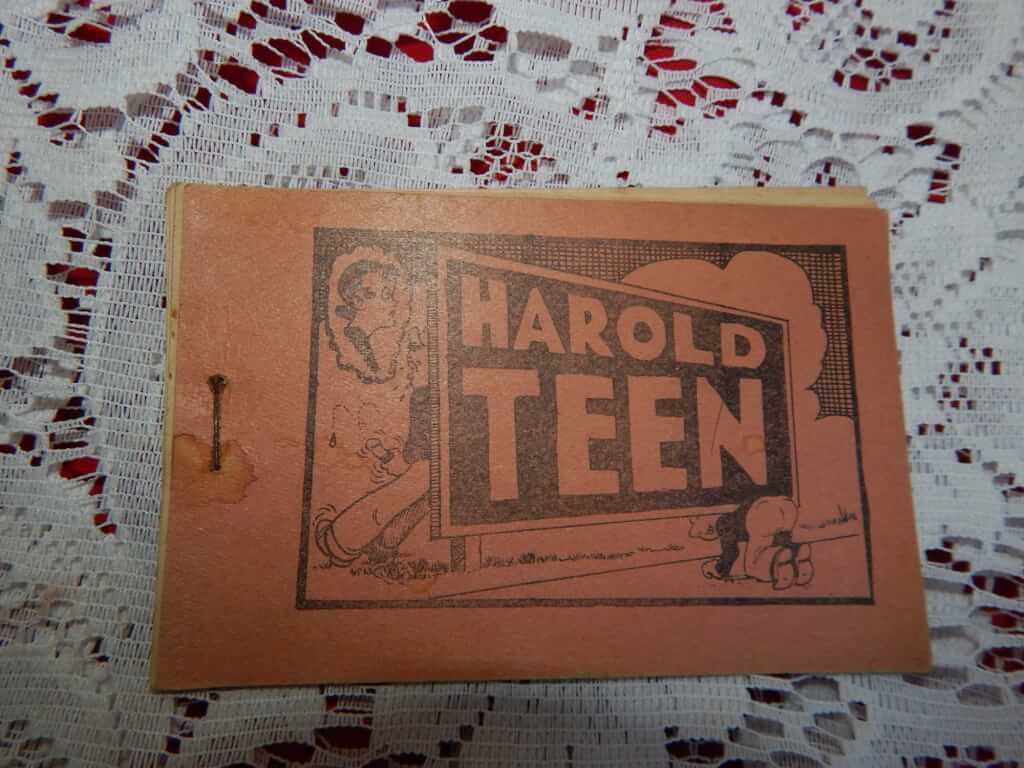 Harold Teen, (n.p. n.d.) 4.5" x 3", 8pp. pamphlet, stapled Tijuana bibles (also known as eight-pagers, bluesies, gray-backs, Jiggs-and-Maggie books, jo-jo books, Tillie-and-Mac books, and two-by-fours) were little pornographic comic books produced in the United States from the 1920s to the early 1960s.
Harold Teen, (n.p. n.d.) 4.5" x 3", 8pp. pamphlet, stapled Tijuana bibles (also known as eight-pagers, bluesies, gray-backs, Jiggs-and-Maggie books, jo-jo books, Tillie-and-Mac books, and two-by-fours) were little pornographic comic books produced in the United States from the 1920s to the early 1960s. -
Out of stock
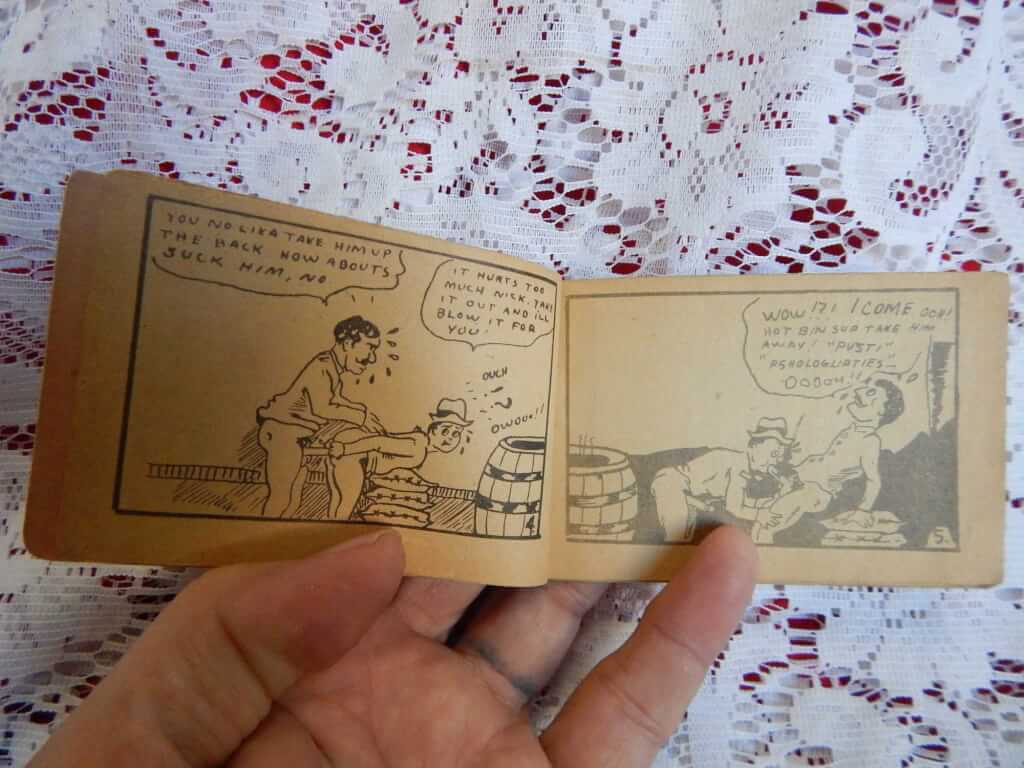
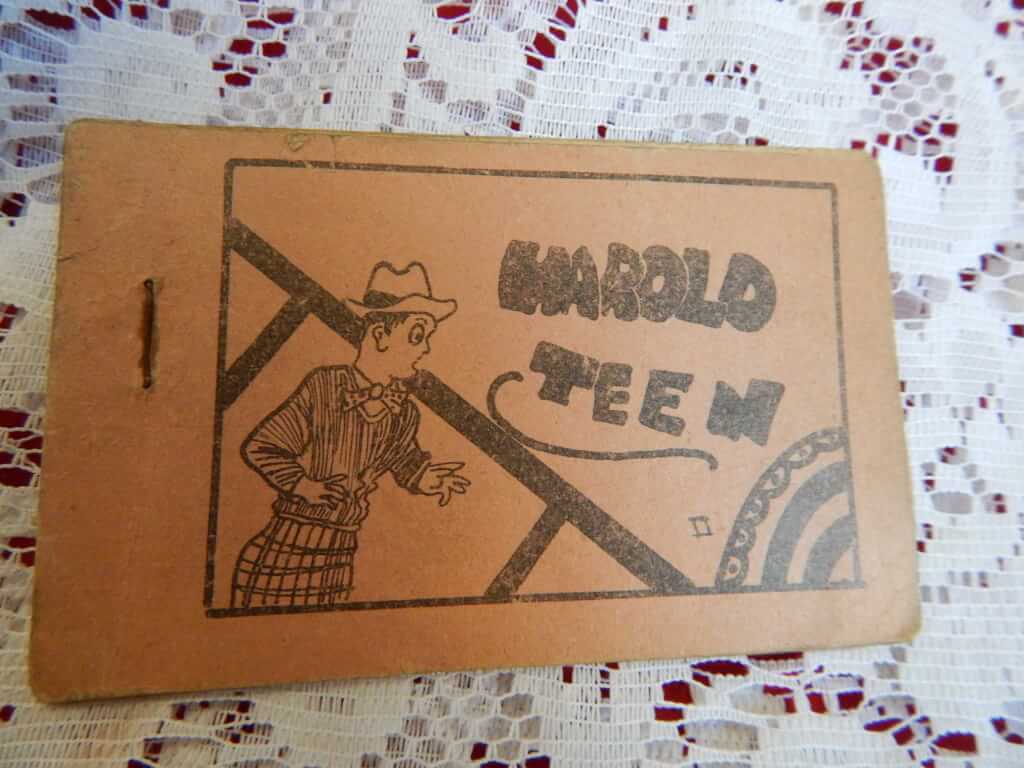 Harold Teen, (n.p. n.d.) 4.5" x 3", 8pp. pamphlet, stapled Tijuana bibles (also known as eight-pagers, bluesies, gray-backs, Jiggs-and-Maggie books, jo-jo books, Tillie-and-Mac books, and two-by-fours) were little pornographic comic books produced in the United States from the 1920s to the early 1960s.
Harold Teen, (n.p. n.d.) 4.5" x 3", 8pp. pamphlet, stapled Tijuana bibles (also known as eight-pagers, bluesies, gray-backs, Jiggs-and-Maggie books, jo-jo books, Tillie-and-Mac books, and two-by-fours) were little pornographic comic books produced in the United States from the 1920s to the early 1960s. -

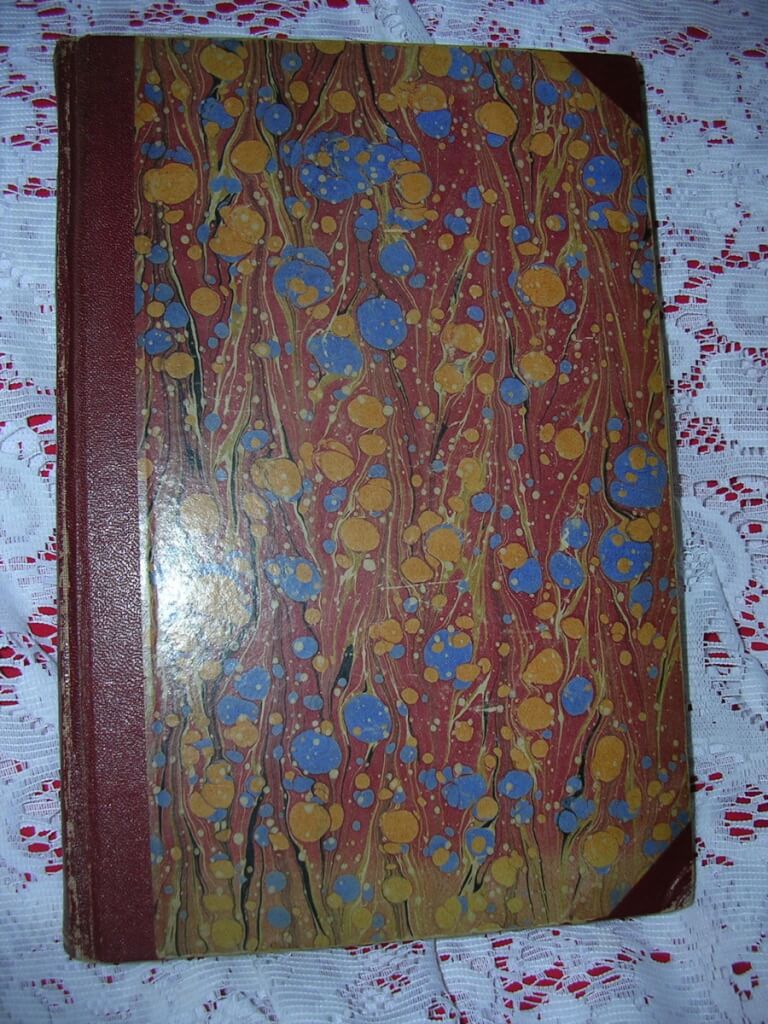 Immortalia, an anthology of american ballads, sailors' songs, cowboy songs, college songs, parodies, limericks, and other humorous verses and doggerel now for the first time brought together in book form, "By A Gentleman About Town" [T. R. Smith?] ("...privately printed for subscribers, none is for general sale" 1927 [pirated edition from the 2nd printing 1928 edtion, c.1932. New York: Samuel Roth or, less likely, Philadelphia: Nathan Young and Robert Sterling].) 6" x 8.75", iii, 184 pp., hardbound no DJ, decorated paper boards, cloth on spine and corners, worn edges on boards, corners bumped, binding tight. Assumed to be edited by T. R. Smith (George Macy, editor of Poetica Erotica around the same time). This is the most influential and widely published/circulated collection of "bawdry". Most collections since borrow from it liberally. There is a heavy emphasis on limericks (103 to be exact). Included are poems/"doggerel" attributed to James Joyce and D.H. Lawrence.
Immortalia, an anthology of american ballads, sailors' songs, cowboy songs, college songs, parodies, limericks, and other humorous verses and doggerel now for the first time brought together in book form, "By A Gentleman About Town" [T. R. Smith?] ("...privately printed for subscribers, none is for general sale" 1927 [pirated edition from the 2nd printing 1928 edtion, c.1932. New York: Samuel Roth or, less likely, Philadelphia: Nathan Young and Robert Sterling].) 6" x 8.75", iii, 184 pp., hardbound no DJ, decorated paper boards, cloth on spine and corners, worn edges on boards, corners bumped, binding tight. Assumed to be edited by T. R. Smith (George Macy, editor of Poetica Erotica around the same time). This is the most influential and widely published/circulated collection of "bawdry". Most collections since borrow from it liberally. There is a heavy emphasis on limericks (103 to be exact). Included are poems/"doggerel" attributed to James Joyce and D.H. Lawrence. -

 J. Wellington, Wimpy in "Back to his First Love" / That's My Pop, (n.p., n.d.) 5" x 3.5", 8pp. double pamphlet, stapled Tijuana bibles (also known as eight-pagers, bluesies, gray-backs, Jiggs-and-Maggie books, jo-jo books, Tillie-and-Mac books, and two-by-fours) were little pornographic comic books produced in the United States from the 1920s to the early 1960s. This book is two books in one, featuring reprints of the originals printed on both sides of the paper. Flip the book over and it's a different book.
J. Wellington, Wimpy in "Back to his First Love" / That's My Pop, (n.p., n.d.) 5" x 3.5", 8pp. double pamphlet, stapled Tijuana bibles (also known as eight-pagers, bluesies, gray-backs, Jiggs-and-Maggie books, jo-jo books, Tillie-and-Mac books, and two-by-fours) were little pornographic comic books produced in the United States from the 1920s to the early 1960s. This book is two books in one, featuring reprints of the originals printed on both sides of the paper. Flip the book over and it's a different book. -
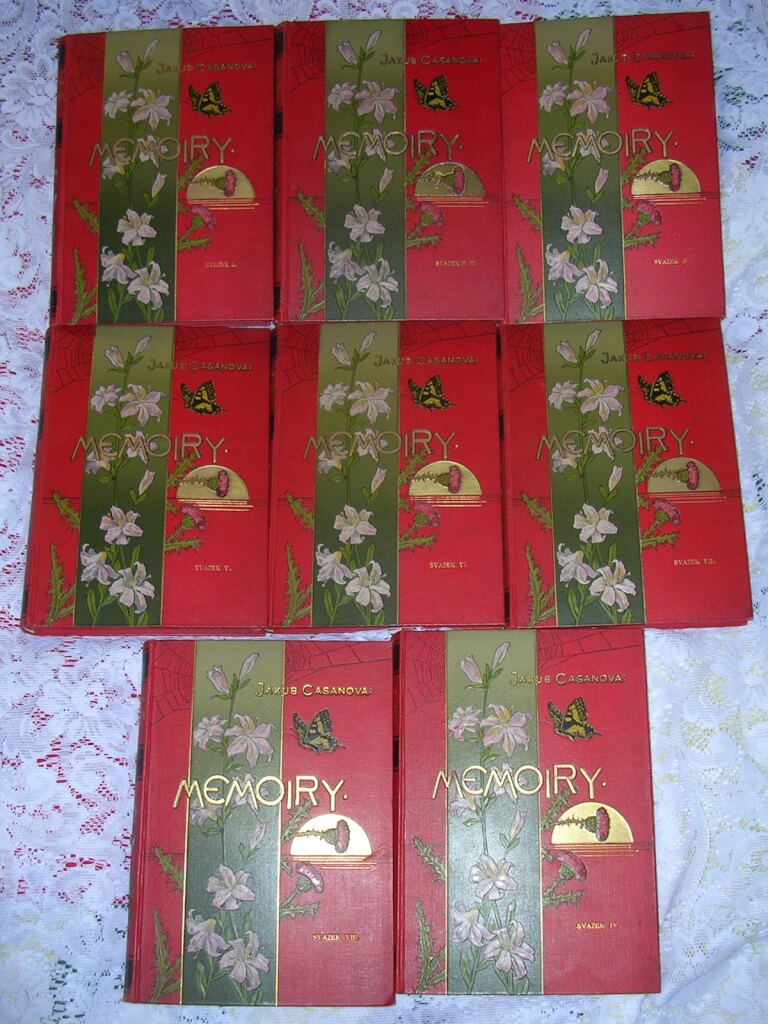
 Jakub Casanova: Memoiry (Czech: Cassanova's Memoirs), Giacomo Casanova (Alois Hynek, J. Rokyta, Praze, n.d. [c. 1890-1900]) 8.75" X 6.25" 9 vol. in 8 books 275pp. [220pp 144pp in one vol.] 283pp. 358pp. 304pp. 356pp. 326pp. 345 i-v. Hardcover with beautifully decorated red cloth boards. Very good condition. Rare complete set with full color boards. Even more rare copy translated into Czech. Giovanni Giacomo Casanova (1725-1798) was an ecclesiastic, writer, soldier, spy, and diplomatist, chiefly remembered as the prince of Italian adventurers and as the man who made the name Casanova synonymous with "libertine." His autobiography, which perhaps exaggerates some of his escapades, is a splendid description of 18th-century society in the capitals of Europe. This is a beautiful Czech edition, 9 volumes in 8 books in publisher's original decorative cloth-binding. A beautifully bound edition. I am unable to find another complete set. The only other place I can find mention these books is in the Czech National Library.
Jakub Casanova: Memoiry (Czech: Cassanova's Memoirs), Giacomo Casanova (Alois Hynek, J. Rokyta, Praze, n.d. [c. 1890-1900]) 8.75" X 6.25" 9 vol. in 8 books 275pp. [220pp 144pp in one vol.] 283pp. 358pp. 304pp. 356pp. 326pp. 345 i-v. Hardcover with beautifully decorated red cloth boards. Very good condition. Rare complete set with full color boards. Even more rare copy translated into Czech. Giovanni Giacomo Casanova (1725-1798) was an ecclesiastic, writer, soldier, spy, and diplomatist, chiefly remembered as the prince of Italian adventurers and as the man who made the name Casanova synonymous with "libertine." His autobiography, which perhaps exaggerates some of his escapades, is a splendid description of 18th-century society in the capitals of Europe. This is a beautiful Czech edition, 9 volumes in 8 books in publisher's original decorative cloth-binding. A beautifully bound edition. I am unable to find another complete set. The only other place I can find mention these books is in the Czech National Library. -

 Joe Palooka in "10 and Out", (n.p. n.d.) 4.5" x 3", 8pp. pamphlet, stapled Tijuana bibles (also known as eight-pagers, bluesies, gray-backs, Jiggs-and-Maggie books, jo-jo books, Tillie-and-Mac books, and two-by-fours) were little pornographic comic books produced in the United States from the 1920s to the early 1960s.
Joe Palooka in "10 and Out", (n.p. n.d.) 4.5" x 3", 8pp. pamphlet, stapled Tijuana bibles (also known as eight-pagers, bluesies, gray-backs, Jiggs-and-Maggie books, jo-jo books, Tillie-and-Mac books, and two-by-fours) were little pornographic comic books produced in the United States from the 1920s to the early 1960s. -

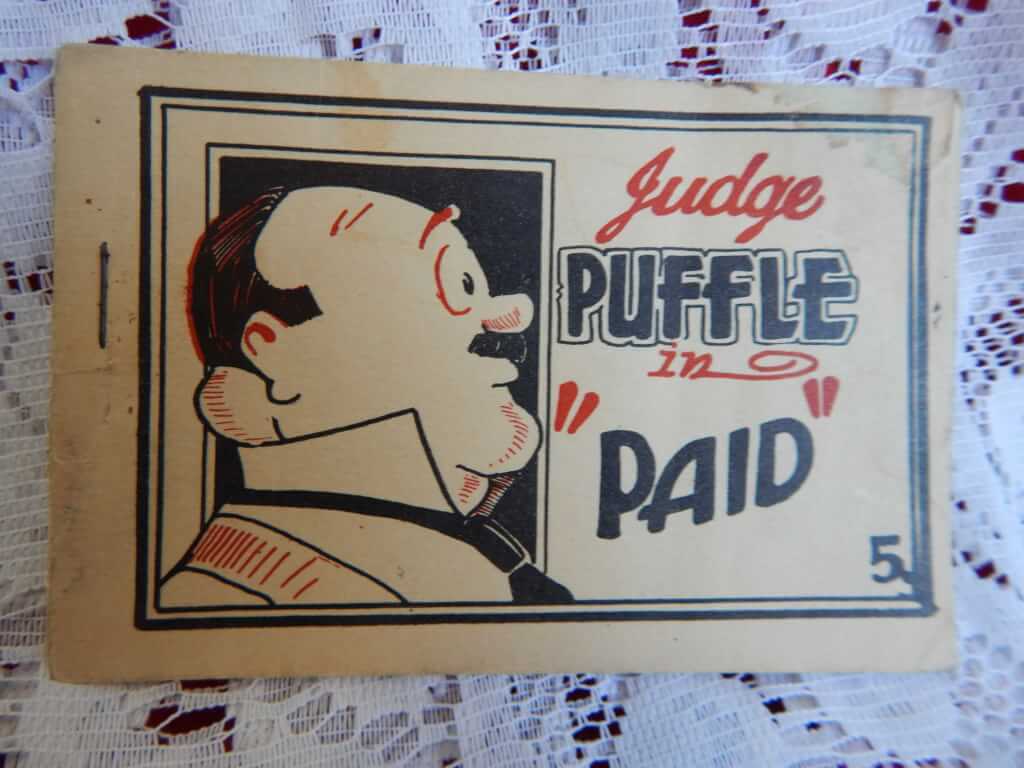 Judge Puffle in "Paid", (np. nd.) 4.5" x 3", 8pp. pamphlet, stapled Tijuana bibles (also known as eight-pagers, bluesies, gray-backs, Jiggs-and-Maggie books, jo-jo books, Tillie-and-Mac books, and two-by-fours) were little pornographic comic books produced in the United States from the 1920s to the early 1960s.
Judge Puffle in "Paid", (np. nd.) 4.5" x 3", 8pp. pamphlet, stapled Tijuana bibles (also known as eight-pagers, bluesies, gray-backs, Jiggs-and-Maggie books, jo-jo books, Tillie-and-Mac books, and two-by-fours) were little pornographic comic books produced in the United States from the 1920s to the early 1960s. -
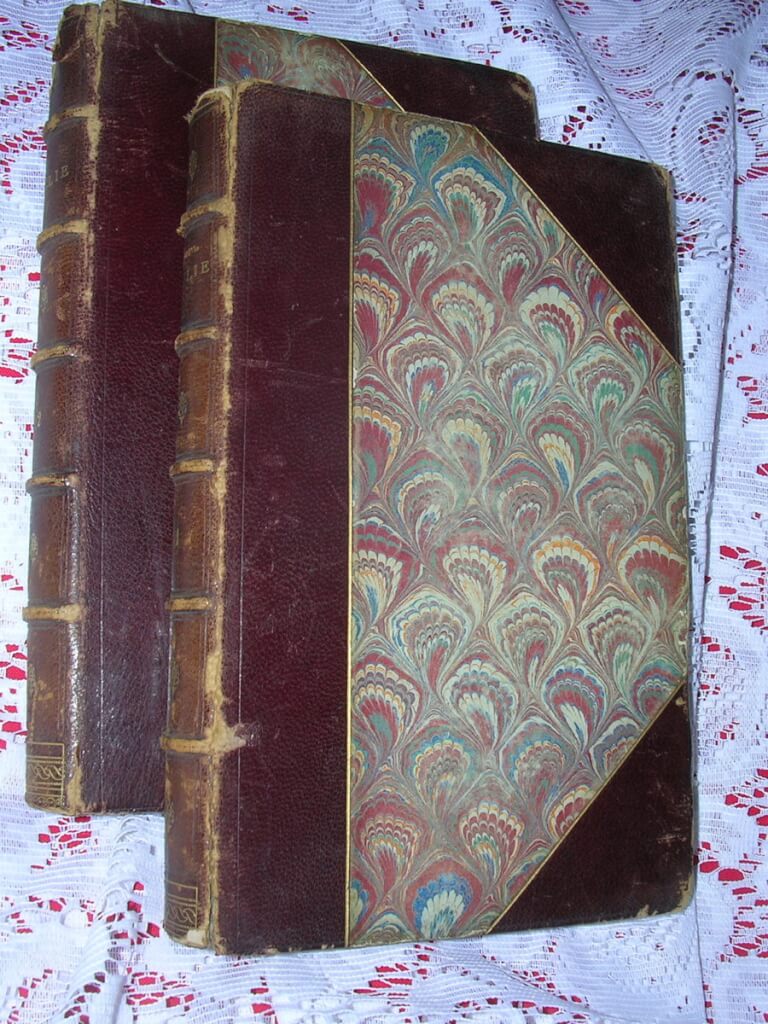
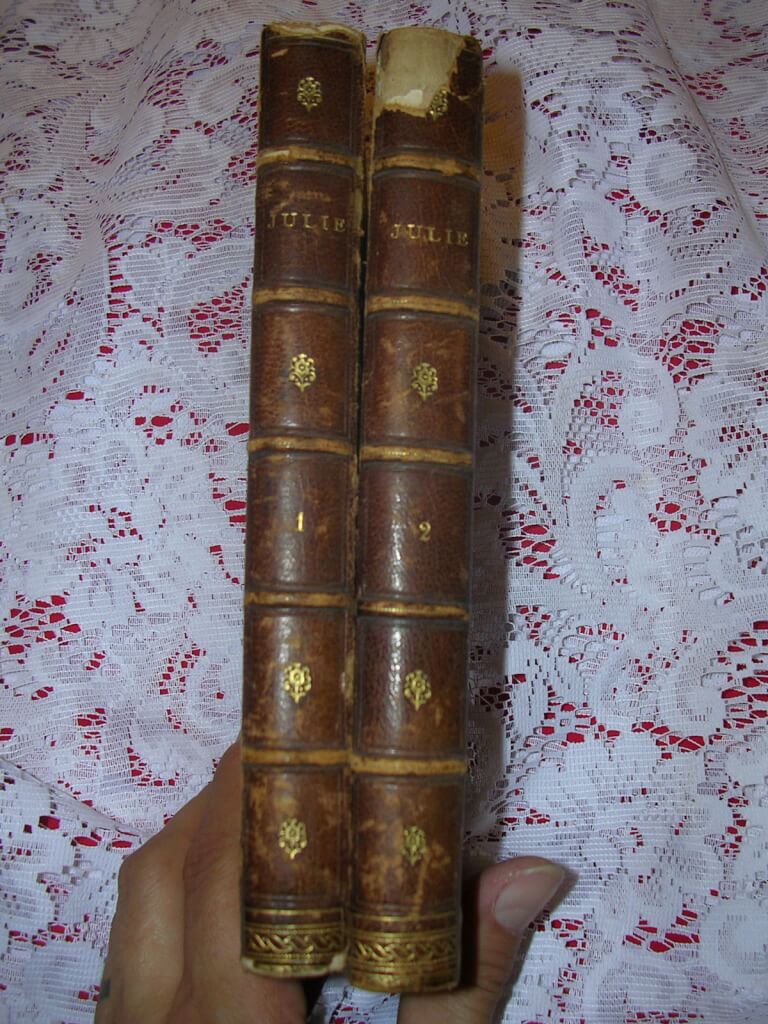 Julie, ou J'ai sauvé ma rose, Madame de C*** [Félicité Choiseul-Meuse] (Gay et Doucé, Bruxelles, 1882) 7.5" x 4.75", 2 vol. 169pp 188pp, hardbound half-leather over decorated paper boards and marbled endpapers. Gilt lettering and decorations on spine, 5 raised bands. 2 frontispiece engravings. Fair condition for age. Vol. 1 front boards loose and first few endpapers not attached, no missing pages, wear and tear to top of spine. Edges worn, corners bumped. Felicite de Choiseul-Meuse wrote approximately twenty-seven novels from 1797 to 1824. Writings are sometimes identified by pseudonyms and acronyms: LFDLC; Emilia P ***, Madame de C *** , etc.. Her 1807 novel "Julie, ou j'ai sauvé ma rose" [Julie, or I saved my rose] is widely considered the first erotic novel written by a woman. It is more appropriately translated as "how I kept my cherry" for it tells the tale of a young woman who lets her lovers fondle her all they want, but will not allow penetration until she finds the right man and marries him. The work was condemned as obscene and its destruction ordered by the Cour royale de Paris on August 5, 1828. Excerpt: "I tasted in his arms unspeakable pleasures. Deadened by pleasure, then revived by an even more delirious pleasure, I made the object of happiness almost as happy as I was myself; and yet, true to my system, I made sure that he did not harvest the rose."
Julie, ou J'ai sauvé ma rose, Madame de C*** [Félicité Choiseul-Meuse] (Gay et Doucé, Bruxelles, 1882) 7.5" x 4.75", 2 vol. 169pp 188pp, hardbound half-leather over decorated paper boards and marbled endpapers. Gilt lettering and decorations on spine, 5 raised bands. 2 frontispiece engravings. Fair condition for age. Vol. 1 front boards loose and first few endpapers not attached, no missing pages, wear and tear to top of spine. Edges worn, corners bumped. Felicite de Choiseul-Meuse wrote approximately twenty-seven novels from 1797 to 1824. Writings are sometimes identified by pseudonyms and acronyms: LFDLC; Emilia P ***, Madame de C *** , etc.. Her 1807 novel "Julie, ou j'ai sauvé ma rose" [Julie, or I saved my rose] is widely considered the first erotic novel written by a woman. It is more appropriately translated as "how I kept my cherry" for it tells the tale of a young woman who lets her lovers fondle her all they want, but will not allow penetration until she finds the right man and marries him. The work was condemned as obscene and its destruction ordered by the Cour royale de Paris on August 5, 1828. Excerpt: "I tasted in his arms unspeakable pleasures. Deadened by pleasure, then revived by an even more delirious pleasure, I made the object of happiness almost as happy as I was myself; and yet, true to my system, I made sure that he did not harvest the rose." -
 Julie, ou J'ai sauvé ma rose, Madame de C*** [Félicité Choiseul-Meuse] (J.-J. Gay, Bruxelles, 1882) 8" x 5.25", 2 vol. 169pp 188pp, full mottled calf, marbled endpapers. Gilt lettering and decorations on spine, 5 raised bands. 2 frontispiece engravings. just Fair condition, interior good, exterior in poor shape, Vol. 1 boards loose, Vol. 2 boards detached. Felicite de Choiseul-Meuse wrote approximately twenty-seven novels from 1797 to 1824. Writings are sometimes identified by pseudonyms and acronyms: LFDLC; Emilia P ***, Madame de C *** , etc.. Her 1807 novel "Julie, ou j'ai sauvé ma rose" [Julie, or I saved my rose] is widely considered the first erotic novel written by a woman. It is more appropriately translated as "how I kept my cherry" for it tells the tale of a young woman who lets her lovers fondle her all they want, but will not allow penetration until she finds the right man and marries him. The work was condemned as obscene and its destruction ordered by the Cour royale de Paris on August 5, 1828. Excerpt: "I tasted in his arms unspeakable pleasures. Deadened by pleasure, then revived by an even more delirious pleasure, I made the object of happiness almost as happy as I was myself; and yet, true to my system, I made sure that he did not harvest the rose."
Julie, ou J'ai sauvé ma rose, Madame de C*** [Félicité Choiseul-Meuse] (J.-J. Gay, Bruxelles, 1882) 8" x 5.25", 2 vol. 169pp 188pp, full mottled calf, marbled endpapers. Gilt lettering and decorations on spine, 5 raised bands. 2 frontispiece engravings. just Fair condition, interior good, exterior in poor shape, Vol. 1 boards loose, Vol. 2 boards detached. Felicite de Choiseul-Meuse wrote approximately twenty-seven novels from 1797 to 1824. Writings are sometimes identified by pseudonyms and acronyms: LFDLC; Emilia P ***, Madame de C *** , etc.. Her 1807 novel "Julie, ou j'ai sauvé ma rose" [Julie, or I saved my rose] is widely considered the first erotic novel written by a woman. It is more appropriately translated as "how I kept my cherry" for it tells the tale of a young woman who lets her lovers fondle her all they want, but will not allow penetration until she finds the right man and marries him. The work was condemned as obscene and its destruction ordered by the Cour royale de Paris on August 5, 1828. Excerpt: "I tasted in his arms unspeakable pleasures. Deadened by pleasure, then revived by an even more delirious pleasure, I made the object of happiness almost as happy as I was myself; and yet, true to my system, I made sure that he did not harvest the rose." -
 Julie, ou J'ai sauvé ma rose, Madame de C*** [Félicité Choiseul-Meuse] (Se trouve chez tous les Libraires Anglais, 1882) 8" x 5.25", 2 vol. bound together, 166pp 183pp, half calf on marbled boards, original wraps bound within, red label with gilt titles on spine, just good condition, boards intact, binding good, ribbon intact, major scuffing and bumping to the spine and rubbing to the boards. Felicite de Choiseul-Meuse wrote approximately twenty-seven novels from 1797 to 1824. Writings are sometimes identified by pseudonyms and acronyms: LFDLC; Emilia P ***, Madame de C *** , etc.. Her 1807 novel "Julie, ou j'ai sauvé ma rose" [Julie, or I saved my rose] is widely considered the first erotic novel written by a woman. It is more appropriately translated as "how I kept my cherry" for it tells the tale of a young woman who lets her lovers fondle her all they want, but will not allow penetration until she finds the right man and marries him. The work was condemned as obscene and its destruction ordered by the Cour royale de Paris on August 5, 1828. Excerpt: "I tasted in his arms unspeakable pleasures. Deadened by pleasure, then revived by an even more delirious pleasure, I made the object of happiness almost as happy as I was myself; and yet, true to my system, I made sure that he did not harvest the rose."
Julie, ou J'ai sauvé ma rose, Madame de C*** [Félicité Choiseul-Meuse] (Se trouve chez tous les Libraires Anglais, 1882) 8" x 5.25", 2 vol. bound together, 166pp 183pp, half calf on marbled boards, original wraps bound within, red label with gilt titles on spine, just good condition, boards intact, binding good, ribbon intact, major scuffing and bumping to the spine and rubbing to the boards. Felicite de Choiseul-Meuse wrote approximately twenty-seven novels from 1797 to 1824. Writings are sometimes identified by pseudonyms and acronyms: LFDLC; Emilia P ***, Madame de C *** , etc.. Her 1807 novel "Julie, ou j'ai sauvé ma rose" [Julie, or I saved my rose] is widely considered the first erotic novel written by a woman. It is more appropriately translated as "how I kept my cherry" for it tells the tale of a young woman who lets her lovers fondle her all they want, but will not allow penetration until she finds the right man and marries him. The work was condemned as obscene and its destruction ordered by the Cour royale de Paris on August 5, 1828. Excerpt: "I tasted in his arms unspeakable pleasures. Deadened by pleasure, then revived by an even more delirious pleasure, I made the object of happiness almost as happy as I was myself; and yet, true to my system, I made sure that he did not harvest the rose." -
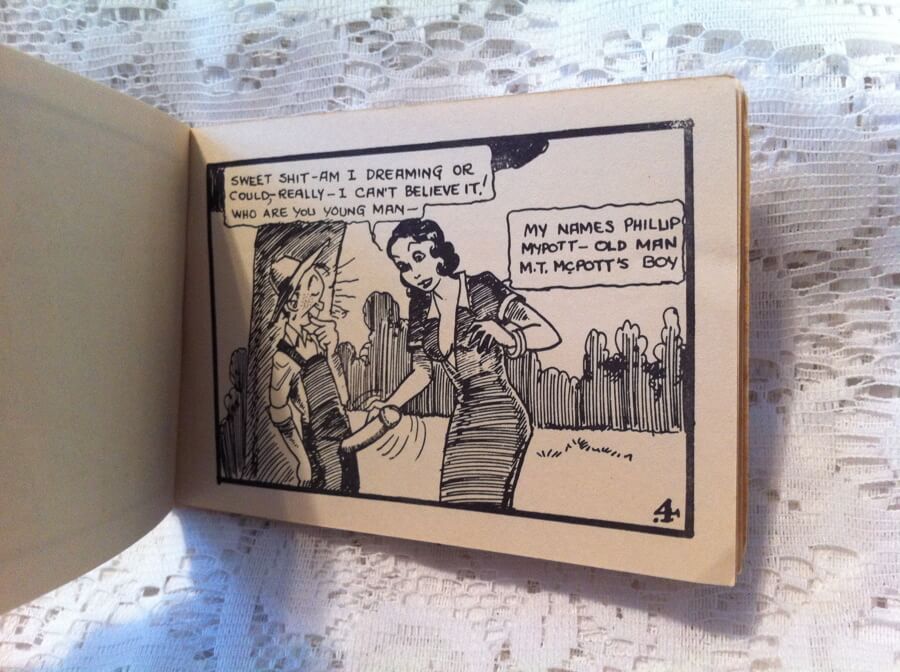
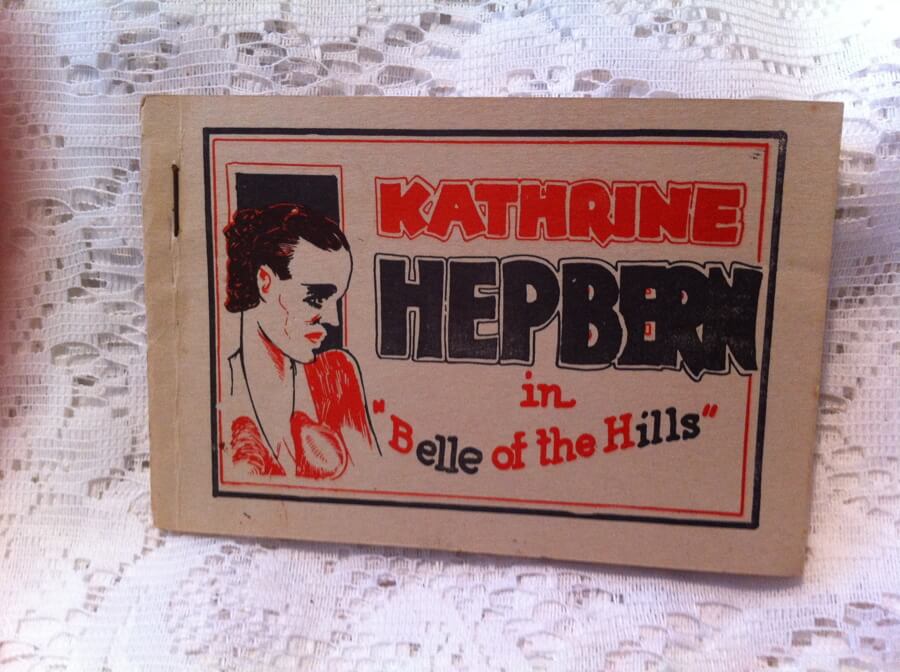 Katherine Hepbern in "Belle of the Hills", (n.p. n.d.) 4.5" x 3", 8pp. pamphlet, stapled Tijuana bibles (also known as eight-pagers, bluesies, gray-backs, Jiggs-and-Maggie books, jo-jo books, Tillie-and-Mac books, and two-by-fours) were little pornographic comic books produced in the United States from the 1920s to the early 1960s.
Katherine Hepbern in "Belle of the Hills", (n.p. n.d.) 4.5" x 3", 8pp. pamphlet, stapled Tijuana bibles (also known as eight-pagers, bluesies, gray-backs, Jiggs-and-Maggie books, jo-jo books, Tillie-and-Mac books, and two-by-fours) were little pornographic comic books produced in the United States from the 1920s to the early 1960s. -
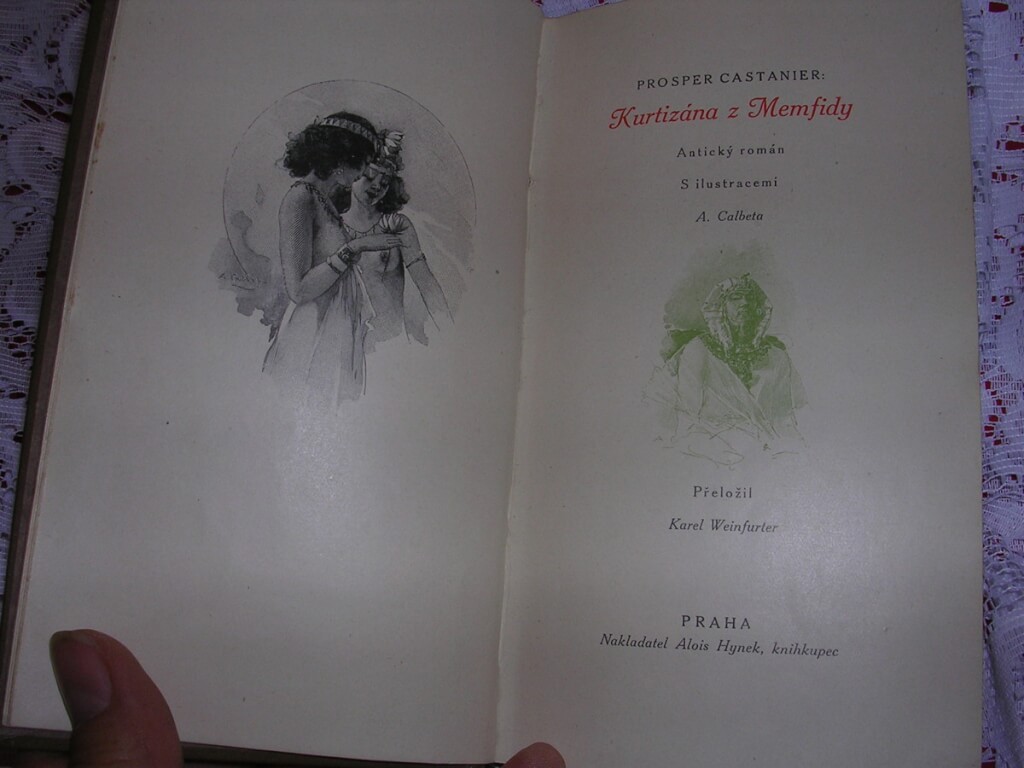
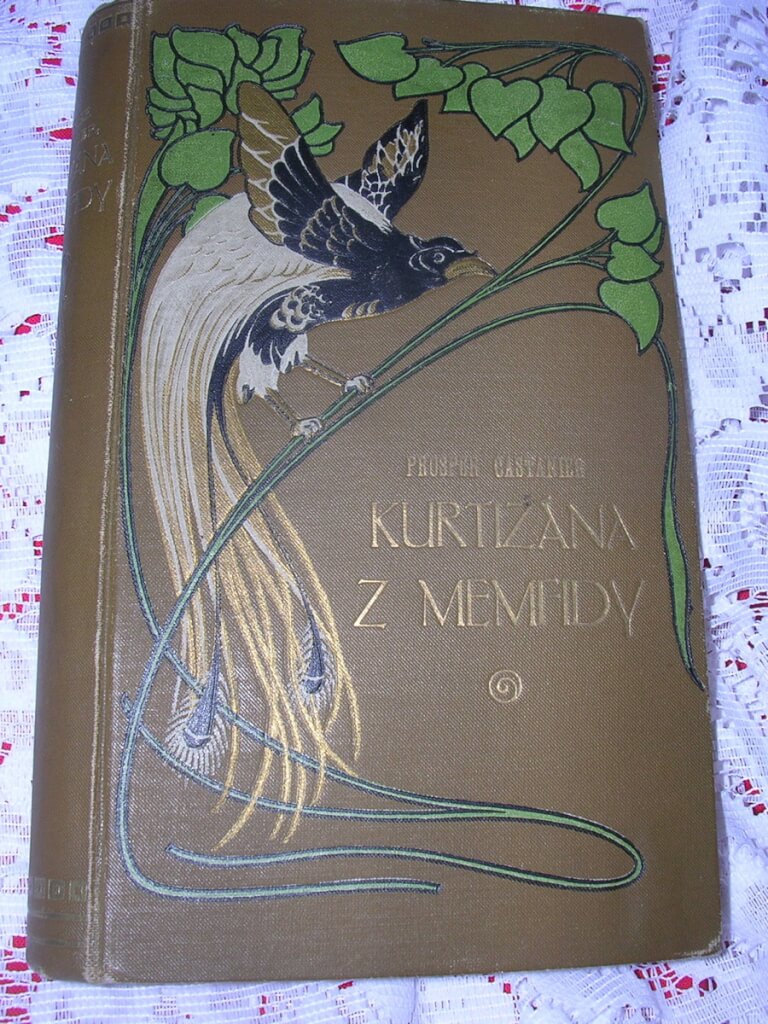 Kurtizána z Memfidy: Anticky román [Czech], Prosper Castanier, trans. Karel Weinfurter, illus. A. Calbeta (Alois Hynek, Praha [Prague], nd [c. 1901], printed by J. Rokyta, Praha) 7" x 4.5", 312pp, hardbound brown decorated cloth boards with gilt and other colors, gilt lettering and design on spine. Top edge gilt. Illustrated throughout with 4 choice illustrations duplicated in alternating red and green before title page. Great condition of a very rare book. This is a rare Czech translation of The Courtesan of Memphis, Czech Memfidy (Memphis) book, also in the rare publisher's original cloth-binding. The publisher, Alois Hynek, translated this and many of Castanier's books into German. These books had similiarly decorated covers. Most of the Hynek's Czech translations one finds are softcover. This is a rare hardcover translation into Czech. It is beautifully illustrated The French author, poet, novelist and historian Prosper Castanier (1865-19??) was born in Saint-Ambroix (Gard). He was the editor-in-chief of the "Progrès du midi". He had made a specialty of novels set in antiquity. (Particularly after the success of Aphrodite by Pierre Louès, published in 1896)
Kurtizána z Memfidy: Anticky román [Czech], Prosper Castanier, trans. Karel Weinfurter, illus. A. Calbeta (Alois Hynek, Praha [Prague], nd [c. 1901], printed by J. Rokyta, Praha) 7" x 4.5", 312pp, hardbound brown decorated cloth boards with gilt and other colors, gilt lettering and design on spine. Top edge gilt. Illustrated throughout with 4 choice illustrations duplicated in alternating red and green before title page. Great condition of a very rare book. This is a rare Czech translation of The Courtesan of Memphis, Czech Memfidy (Memphis) book, also in the rare publisher's original cloth-binding. The publisher, Alois Hynek, translated this and many of Castanier's books into German. These books had similiarly decorated covers. Most of the Hynek's Czech translations one finds are softcover. This is a rare hardcover translation into Czech. It is beautifully illustrated The French author, poet, novelist and historian Prosper Castanier (1865-19??) was born in Saint-Ambroix (Gard). He was the editor-in-chief of the "Progrès du midi". He had made a specialty of novels set in antiquity. (Particularly after the success of Aphrodite by Pierre Louès, published in 1896) -

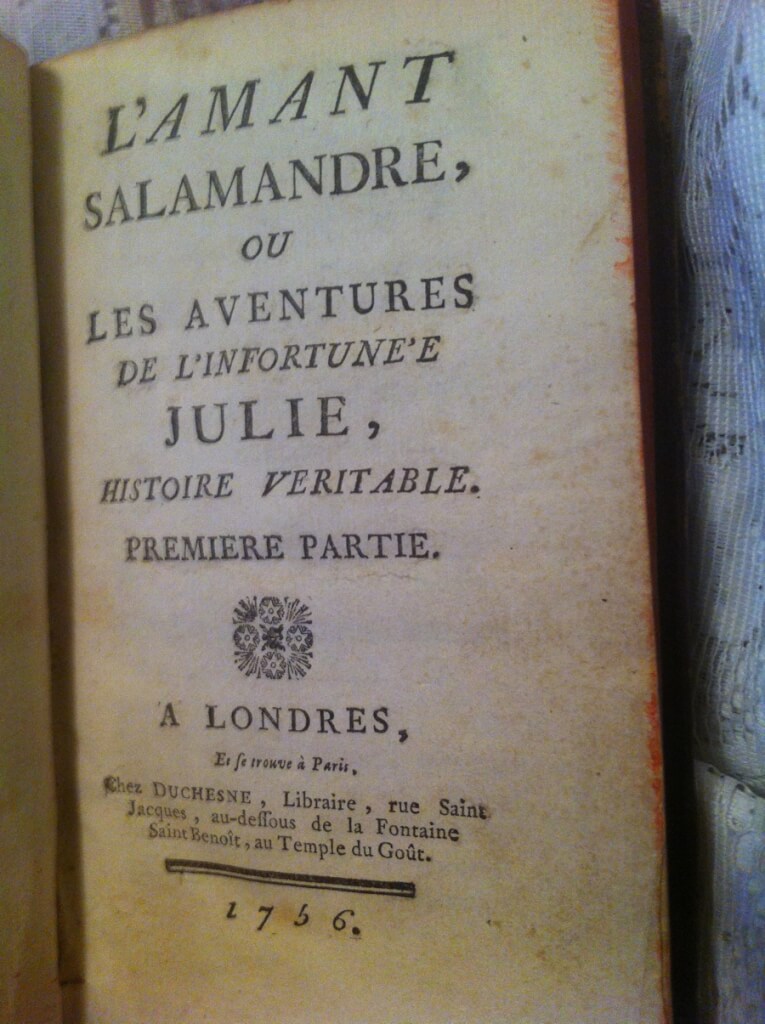 L'Amant Salamandre, ou Les Aventures de l'Infortunée Julie,Histoire Veritable, anonymous [Cointreau] , ("Londres, Et se trouve à Paris. Chez Duchesne" 1756, [first edition]) 4"x6.75", in two parts, 132pp, 135pp, Contemporary mottled calf, gilt decorations on spine, marbled boards, in good condition for age, some splitting at spine, but binding good. Julie is the bizarre tale of a young orphan tricked by her wicked governess into believing in magic. The governess delivers the girl to her son, who attempts to seduce her disguised as Salamandre, a magician. The young girl escapes to a convent, only to cross paths with the governess some time later, who once again tries to procure her for her son. 'Salamandre' is attacked by assassins and confesses his mother's crimes on his death bed. The novel was very popular in it's day. Although very popular in it's day, it's a rare find, especially the original 1756 version.
L'Amant Salamandre, ou Les Aventures de l'Infortunée Julie,Histoire Veritable, anonymous [Cointreau] , ("Londres, Et se trouve à Paris. Chez Duchesne" 1756, [first edition]) 4"x6.75", in two parts, 132pp, 135pp, Contemporary mottled calf, gilt decorations on spine, marbled boards, in good condition for age, some splitting at spine, but binding good. Julie is the bizarre tale of a young orphan tricked by her wicked governess into believing in magic. The governess delivers the girl to her son, who attempts to seduce her disguised as Salamandre, a magician. The young girl escapes to a convent, only to cross paths with the governess some time later, who once again tries to procure her for her son. 'Salamandre' is attacked by assassins and confesses his mother's crimes on his death bed. The novel was very popular in it's day. Although very popular in it's day, it's a rare find, especially the original 1756 version. -

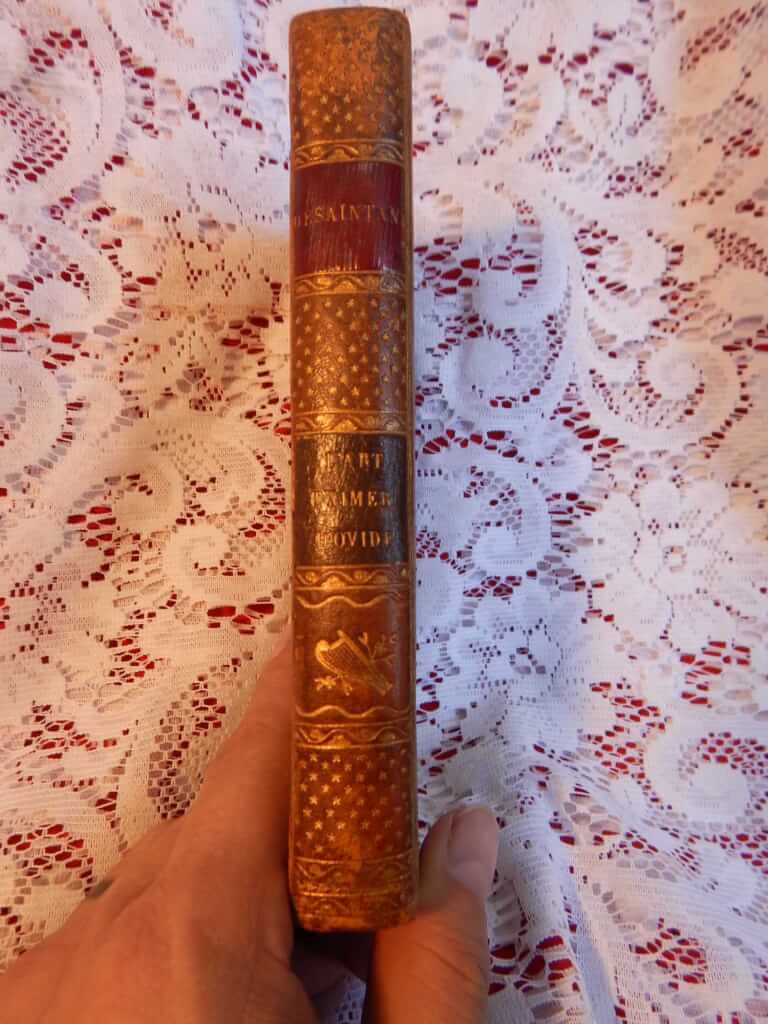 L'art d'aimer d'Ovide, traduction en vers, avec des remarques par M. Desaintange (Chez Giguet et Michaud, Paris, 1807, first edition of translation) 5"x8", 320pp, full calf, gilt titles and decorations to spine, marbled boards, some rubbing and bumping, good+ condition for age, finely engraved frontispiece, unknown artist French language translation by Saint-Ange of Ovid's The Art of Love. Publius Ovidius Naso (43 BC – AD 17/18), known as Ovid in the English-speaking world, was a Roman poet who lived during the reign of Augustus. He was a contemporary of the older Virgil and Horace, with whom he is often ranked as one of the three canonical poets of Latin literature. The Imperial scholar Quintilian considered him the last of the Latin love elegists. He enjoyed enormous popularity, but, in one of the mysteries of literary history, was sent by Augustus into exile in a remote province on the Black Sea, where he remained until his death. Ovid himself attributes his exile to carmen et error, "a poem and a mistake", but his discretion in discussing the causes has resulted in much speculation among scholars. The first major Roman poet to begin his career during the reign of Augustus, Ovid is today best known for the Metamorphoses, a 15-book continuous mythological narrative written in the meter of epic, and for works in elegiac couplets such as Ars Amatoria ("The Art of Love") and Fasti. His poetry was much imitated during Late Antiquity and the Middle Ages, and greatly influenced Western art and literature. The Metamorphoses remains one of the most important sources of classical mythology. Ange-François Fariau de Saint-Ange (1747-1810), known as Saint-Ange was a French poet and translator. Born of a father adviser of the king, he studied at the collège des jésuites de Blois, then at the college Sainte-Barbe de Paris. He acquired from a young age a reputation for his his unparalleled wit. Protected by Turgot, he gained a place in general control, but found himself without resources in the Revolution. At the fall of Robespierre, he found a job in the clothing agency of the troops, then became then professor of belles-lettres, then of general and reasoned grammar, with the central school of the street Saint-Antoine. He was elected member of the French Academy in 1810. In his reception speech, sensing that his shaky health would not allow him to sit there for a long time, he declared: "I am doing violence, at this moment, to the continual suffering and intolerable who warn me that the shadow of the academician whom I replace is waiting for mine. Three months later, he suffered a fall and died while visiting the institute.
L'art d'aimer d'Ovide, traduction en vers, avec des remarques par M. Desaintange (Chez Giguet et Michaud, Paris, 1807, first edition of translation) 5"x8", 320pp, full calf, gilt titles and decorations to spine, marbled boards, some rubbing and bumping, good+ condition for age, finely engraved frontispiece, unknown artist French language translation by Saint-Ange of Ovid's The Art of Love. Publius Ovidius Naso (43 BC – AD 17/18), known as Ovid in the English-speaking world, was a Roman poet who lived during the reign of Augustus. He was a contemporary of the older Virgil and Horace, with whom he is often ranked as one of the three canonical poets of Latin literature. The Imperial scholar Quintilian considered him the last of the Latin love elegists. He enjoyed enormous popularity, but, in one of the mysteries of literary history, was sent by Augustus into exile in a remote province on the Black Sea, where he remained until his death. Ovid himself attributes his exile to carmen et error, "a poem and a mistake", but his discretion in discussing the causes has resulted in much speculation among scholars. The first major Roman poet to begin his career during the reign of Augustus, Ovid is today best known for the Metamorphoses, a 15-book continuous mythological narrative written in the meter of epic, and for works in elegiac couplets such as Ars Amatoria ("The Art of Love") and Fasti. His poetry was much imitated during Late Antiquity and the Middle Ages, and greatly influenced Western art and literature. The Metamorphoses remains one of the most important sources of classical mythology. Ange-François Fariau de Saint-Ange (1747-1810), known as Saint-Ange was a French poet and translator. Born of a father adviser of the king, he studied at the collège des jésuites de Blois, then at the college Sainte-Barbe de Paris. He acquired from a young age a reputation for his his unparalleled wit. Protected by Turgot, he gained a place in general control, but found himself without resources in the Revolution. At the fall of Robespierre, he found a job in the clothing agency of the troops, then became then professor of belles-lettres, then of general and reasoned grammar, with the central school of the street Saint-Antoine. He was elected member of the French Academy in 1810. In his reception speech, sensing that his shaky health would not allow him to sit there for a long time, he declared: "I am doing violence, at this moment, to the continual suffering and intolerable who warn me that the shadow of the academician whom I replace is waiting for mine. Three months later, he suffered a fall and died while visiting the institute. -
 L'histoire comique de Francion en laquelle sont découvertes les plus subtiles finesses et trompeuses inventions tant des hommes que des femmes de toute sortes de conditions et d'âges. Non moins profitable pour s'en garder, que plaisante à la lecture., Charles Sorel, illus. Martin van Maele (chez Jean Fort, Paris, 1925 #131/ 1100 of copies made with pure Enoshima fibre paper) 9″x6″, 411pp, quarter-bound calf over slate boards, 5 raised bands, gilt titles and decorations on spine, top-edge gilt others deckled, fair condition, boards very loose, barely holding Charles Sorel, sieur de Souvigny (1602 –1674) was a French novelist and general writer. Very little is known of his life except that in 1635 he was historiographer of France. He wrote on science, history and religion, but is only remembered for his novels. He tried to destroy the vogue for the pastoral romance by writing a novel of adventure, the Histoire comique de Francion (first edition in seven volumes, 1623; second edition in twelve volumes, 1633). The episodical adventures of Francion found many readers, who nevertheless kept their admiration for Honoré d'Urfé's L'Astrée, which it was intended to ridicule.
L'histoire comique de Francion en laquelle sont découvertes les plus subtiles finesses et trompeuses inventions tant des hommes que des femmes de toute sortes de conditions et d'âges. Non moins profitable pour s'en garder, que plaisante à la lecture., Charles Sorel, illus. Martin van Maele (chez Jean Fort, Paris, 1925 #131/ 1100 of copies made with pure Enoshima fibre paper) 9″x6″, 411pp, quarter-bound calf over slate boards, 5 raised bands, gilt titles and decorations on spine, top-edge gilt others deckled, fair condition, boards very loose, barely holding Charles Sorel, sieur de Souvigny (1602 –1674) was a French novelist and general writer. Very little is known of his life except that in 1635 he was historiographer of France. He wrote on science, history and religion, but is only remembered for his novels. He tried to destroy the vogue for the pastoral romance by writing a novel of adventure, the Histoire comique de Francion (first edition in seven volumes, 1623; second edition in twelve volumes, 1633). The episodical adventures of Francion found many readers, who nevertheless kept their admiration for Honoré d'Urfé's L'Astrée, which it was intended to ridicule. -

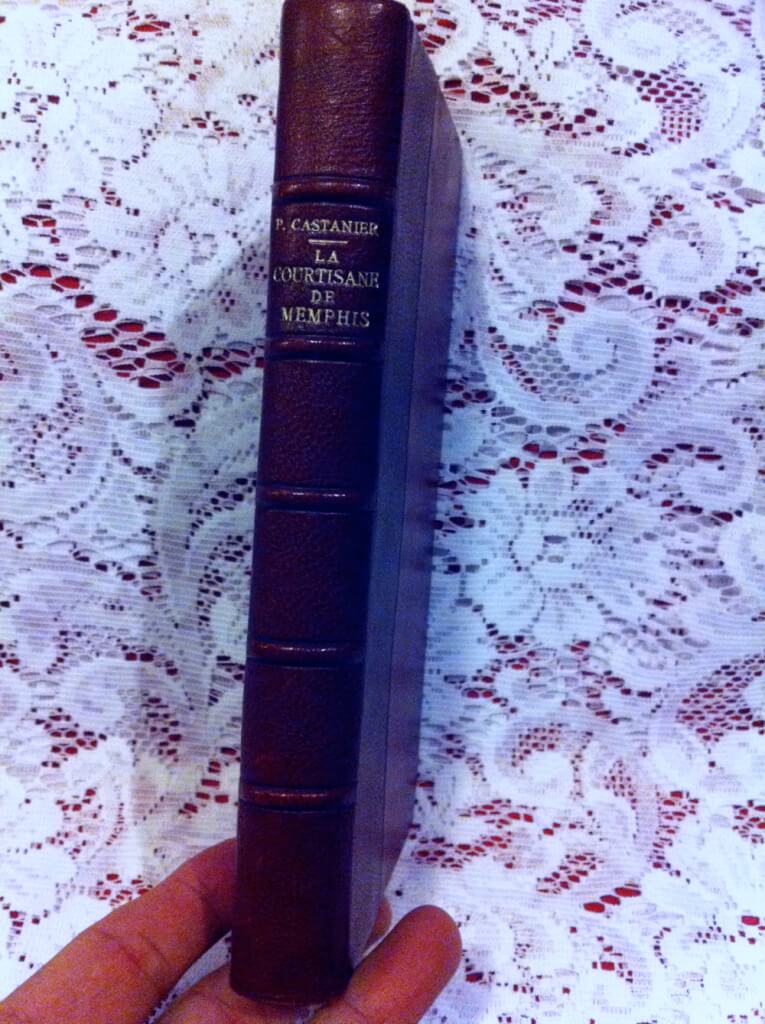 La Courtisane de Memphis, Prosper Castanier, illust. by A. Calbet (Librairie L. Borel, Paris, 1900 "Nymphée Collection") 7.75" X 4", 242pp.+, 1/2 red leather over silk-covered boards, marbled end-papers, gallery of 7 full-page illustrations in red, 5 pages of ads in back, fine condition for age, ribbon intact. In French, The Courtesan of Memphis. Prosper Castanier wrote of the decadence of ancient Rome. This is a beautiful example of a rare book. The French author, poet, novelist and historian Prosper Castanier (1865-19??) was born in Saint-Ambroix (Gard). He was the editor-in-chief of the "Progrès du midi". He had made a specialty of novels set in antiquity. (Particularly after the success of Aphrodite by Pierre Louès, published in 1896)
La Courtisane de Memphis, Prosper Castanier, illust. by A. Calbet (Librairie L. Borel, Paris, 1900 "Nymphée Collection") 7.75" X 4", 242pp.+, 1/2 red leather over silk-covered boards, marbled end-papers, gallery of 7 full-page illustrations in red, 5 pages of ads in back, fine condition for age, ribbon intact. In French, The Courtesan of Memphis. Prosper Castanier wrote of the decadence of ancient Rome. This is a beautiful example of a rare book. The French author, poet, novelist and historian Prosper Castanier (1865-19??) was born in Saint-Ambroix (Gard). He was the editor-in-chief of the "Progrès du midi". He had made a specialty of novels set in antiquity. (Particularly after the success of Aphrodite by Pierre Louès, published in 1896) -
 La Génération de l' Homme ou Tableau de l' Amour Conjugal, considéré dans l'état du mariage, tome premier, Nicolas Venette (np 1776) 4″x6.75″, 365pp, vol. 1 only (of 2), full mottled calf, 5 raised bands, titles on spine are worn off, marbled boards loose but holding, fair condition for age. Illustrated throughout including a beautifully engraved frontispiece and title page, some illustrations are fold-outs. Nicolas Venette (1633–1698) was a physician, sexologist and French writer. Born in La Rochelle, he studied medicine at Bordeaux where he received his doctorate in 1656. He then went to Paris where he studied under Guy Patin and Pierre Petit, before travelling to Spain, Portugal and Italy. He then returned to La Rochelle, where he became Regius Professor of Anatomy and Surgery in 1668. First published in Amsterdam in 1686 as Tableau de l’amour humain considéré dans l’état du mariage (Table of human love considered in the state of marriage) under the pseudonym Salocini Venetian (anagram of Nicolas Venette), this book, more properly titled Table of conjugal love, or the complete history of the generation of man, is considered to be the first treatise on sexology in West. It proved to be a bestseller and was translated into English, Spanish, German and Dutch. There were 33 editions published sporadically until 1903. This edition was published in 1776 in two-volume. This book is volume 1. Many images are upgraded from previous editions to be fold-outs. The author discusses four sub-topics with respect to sex: anatomy, reproduction, desire, and impotence/infertility. For each topic, he reviews ancient and medieval authors, adding his own observations or those of later authors, and comments where common sense prevails. The resulting composition has an ambiguous mixture of seriousness and light-heartedness bordering upon erotic literature.
La Génération de l' Homme ou Tableau de l' Amour Conjugal, considéré dans l'état du mariage, tome premier, Nicolas Venette (np 1776) 4″x6.75″, 365pp, vol. 1 only (of 2), full mottled calf, 5 raised bands, titles on spine are worn off, marbled boards loose but holding, fair condition for age. Illustrated throughout including a beautifully engraved frontispiece and title page, some illustrations are fold-outs. Nicolas Venette (1633–1698) was a physician, sexologist and French writer. Born in La Rochelle, he studied medicine at Bordeaux where he received his doctorate in 1656. He then went to Paris where he studied under Guy Patin and Pierre Petit, before travelling to Spain, Portugal and Italy. He then returned to La Rochelle, where he became Regius Professor of Anatomy and Surgery in 1668. First published in Amsterdam in 1686 as Tableau de l’amour humain considéré dans l’état du mariage (Table of human love considered in the state of marriage) under the pseudonym Salocini Venetian (anagram of Nicolas Venette), this book, more properly titled Table of conjugal love, or the complete history of the generation of man, is considered to be the first treatise on sexology in West. It proved to be a bestseller and was translated into English, Spanish, German and Dutch. There were 33 editions published sporadically until 1903. This edition was published in 1776 in two-volume. This book is volume 1. Many images are upgraded from previous editions to be fold-outs. The author discusses four sub-topics with respect to sex: anatomy, reproduction, desire, and impotence/infertility. For each topic, he reviews ancient and medieval authors, adding his own observations or those of later authors, and comments where common sense prevails. The resulting composition has an ambiguous mixture of seriousness and light-heartedness bordering upon erotic literature. -
 La Génération de l' Homme ou Tableau de l' Amour Conjugal, considéré dans l'état du mariage, Nicolas Venette (np London, 1768, "Nouvelle Édition") 6.25″x3.75″, 408pp, vol. 1 only (of 2), full mottled calf, 5 raised bands worn), gilt title and decorations on spine (worn), marbled boards, fair condition for age, beautiful illustrations including a beautifully engraved frontispiece and title page. Nicolas Venette (1633–1698) was a physician, sexologist and French writer. Born in La Rochelle, he studied medicine at Bordeaux where he received his doctorate in 1656. He then went to Paris where he studied under Guy Patin and Pierre Petit, before travelling to Spain, Portugal and Italy. He then returned to La Rochelle, where he became Regius Professor of Anatomy and Surgery in 1668. First published in Amsterdam in 1686 as Tableau de l’amour humain considéré dans l’état du mariage (Table of human love considered in the state of marriage) under the pseudonym Salocini Venetian (anagram of Nicolas Venette), this book, more properly titled Table of conjugal love, or the complete history of the generation of man, is considered to be the first treatise on sexology in West. It proved to be a bestseller and was translated into English, Spanish, German and Dutch. There were 33 editions published sporadically until 1903. This edition was published in 1768 in two-volume. This book is volume 1. The author discusses four sub-topics with respect to sex: anatomy, reproduction, desire, and impotence/infertility. For each topic, he reviews ancient and medieval authors, adding his own observations or those of later authors, and comments where common sense prevails. The resulting composition has an ambiguous mixture of seriousness and light-heartedness bordering upon erotic literature.
La Génération de l' Homme ou Tableau de l' Amour Conjugal, considéré dans l'état du mariage, Nicolas Venette (np London, 1768, "Nouvelle Édition") 6.25″x3.75″, 408pp, vol. 1 only (of 2), full mottled calf, 5 raised bands worn), gilt title and decorations on spine (worn), marbled boards, fair condition for age, beautiful illustrations including a beautifully engraved frontispiece and title page. Nicolas Venette (1633–1698) was a physician, sexologist and French writer. Born in La Rochelle, he studied medicine at Bordeaux where he received his doctorate in 1656. He then went to Paris where he studied under Guy Patin and Pierre Petit, before travelling to Spain, Portugal and Italy. He then returned to La Rochelle, where he became Regius Professor of Anatomy and Surgery in 1668. First published in Amsterdam in 1686 as Tableau de l’amour humain considéré dans l’état du mariage (Table of human love considered in the state of marriage) under the pseudonym Salocini Venetian (anagram of Nicolas Venette), this book, more properly titled Table of conjugal love, or the complete history of the generation of man, is considered to be the first treatise on sexology in West. It proved to be a bestseller and was translated into English, Spanish, German and Dutch. There were 33 editions published sporadically until 1903. This edition was published in 1768 in two-volume. This book is volume 1. The author discusses four sub-topics with respect to sex: anatomy, reproduction, desire, and impotence/infertility. For each topic, he reviews ancient and medieval authors, adding his own observations or those of later authors, and comments where common sense prevails. The resulting composition has an ambiguous mixture of seriousness and light-heartedness bordering upon erotic literature. -

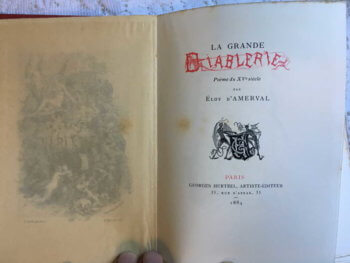 La Grande Diablerie, poem du XVe siècles, by Éloy d'Amerval (George Hurtrel, Artiste-Édueur, Paris, 1884, #152/1000 hand signed by publisher) 5" x 6.75", 216pp, in original published state, french wraps with loose hardcover/case, red with gilt decoration, frontispiece and 3 full page engravings by Paul Avril protected by tissue guard, images throughout, good minus condition, spine cover is sunned, binding is loose and splitting in places Eloy d'Amerval (fl. 1455 – 1508) was a French composer, singer, choirmaster, and poet of the Renaissance. He spent most of his life in the Loire Valley of France. From his poetic works, the long poem Le livre de la deablerie, it can be inferred that he knew most of the famous composers of the time, even though his own musical works never approached theirs in renown. This poem, considered invaluable to music historians, recounts a dialogue between Satan and Lucifer, in which their nefarious plotting of future evil deeds is interrupted periodically by the author, who among other accounts of earthly and divine virtue, records useful information on contemporary musical practice. In addition to listing musical instruments, he lists who he considers to be the great composers of the time: they are residents of Paradise in his poem, even though several were still alive in 1508, the date of its composition. Édouard-Henri Avril (1849-1928) used the pseudonym “Paul Avril” for his erotic work. He was a French painter and commercial artist. His career saw collaboration with influential people like Octave Uzanne, Henry Spencer Ashbee and Friedrich Karl Forberg. He is one of the most celebrated erotic artists of his age. Avril was a soldier before starting his career in art. He was awarded with the Legion of Honour for his actions in the Franco-Prussian War.
La Grande Diablerie, poem du XVe siècles, by Éloy d'Amerval (George Hurtrel, Artiste-Édueur, Paris, 1884, #152/1000 hand signed by publisher) 5" x 6.75", 216pp, in original published state, french wraps with loose hardcover/case, red with gilt decoration, frontispiece and 3 full page engravings by Paul Avril protected by tissue guard, images throughout, good minus condition, spine cover is sunned, binding is loose and splitting in places Eloy d'Amerval (fl. 1455 – 1508) was a French composer, singer, choirmaster, and poet of the Renaissance. He spent most of his life in the Loire Valley of France. From his poetic works, the long poem Le livre de la deablerie, it can be inferred that he knew most of the famous composers of the time, even though his own musical works never approached theirs in renown. This poem, considered invaluable to music historians, recounts a dialogue between Satan and Lucifer, in which their nefarious plotting of future evil deeds is interrupted periodically by the author, who among other accounts of earthly and divine virtue, records useful information on contemporary musical practice. In addition to listing musical instruments, he lists who he considers to be the great composers of the time: they are residents of Paradise in his poem, even though several were still alive in 1508, the date of its composition. Édouard-Henri Avril (1849-1928) used the pseudonym “Paul Avril” for his erotic work. He was a French painter and commercial artist. His career saw collaboration with influential people like Octave Uzanne, Henry Spencer Ashbee and Friedrich Karl Forberg. He is one of the most celebrated erotic artists of his age. Avril was a soldier before starting his career in art. He was awarded with the Legion of Honour for his actions in the Franco-Prussian War. -
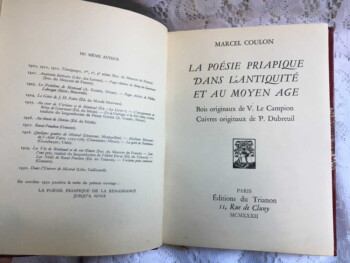
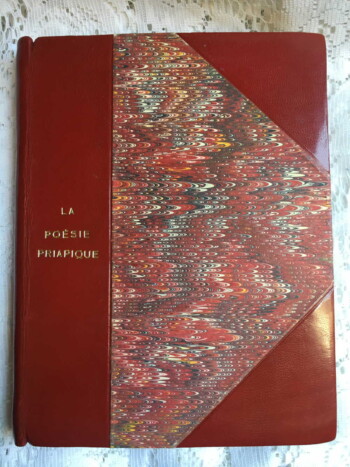 La poésie priapique dans l'antiquité et au moyen age [Priapic poetry in antiquity and the middle ages], ed. Marcel Coulon, 1 original wood engraving by V. Le Campion, 2 original brass engravings by P. Dubreuil (Éditions du Trianon, Paris, 1932, printed by Les Presses de Massoul, #119 of 750) 7.75"x6.25", 166pp+index, 3/4 bound red calf over marbled boards, gilt title on cover and spine, original french wraps bound in, marbled end papers, near fine condition, ribbon intact, pages clean. A history of priapic literature covering folklore, poetry, Priapus, mythology, homosexuality in the ancient world.
La poésie priapique dans l'antiquité et au moyen age [Priapic poetry in antiquity and the middle ages], ed. Marcel Coulon, 1 original wood engraving by V. Le Campion, 2 original brass engravings by P. Dubreuil (Éditions du Trianon, Paris, 1932, printed by Les Presses de Massoul, #119 of 750) 7.75"x6.25", 166pp+index, 3/4 bound red calf over marbled boards, gilt title on cover and spine, original french wraps bound in, marbled end papers, near fine condition, ribbon intact, pages clean. A history of priapic literature covering folklore, poetry, Priapus, mythology, homosexuality in the ancient world. -
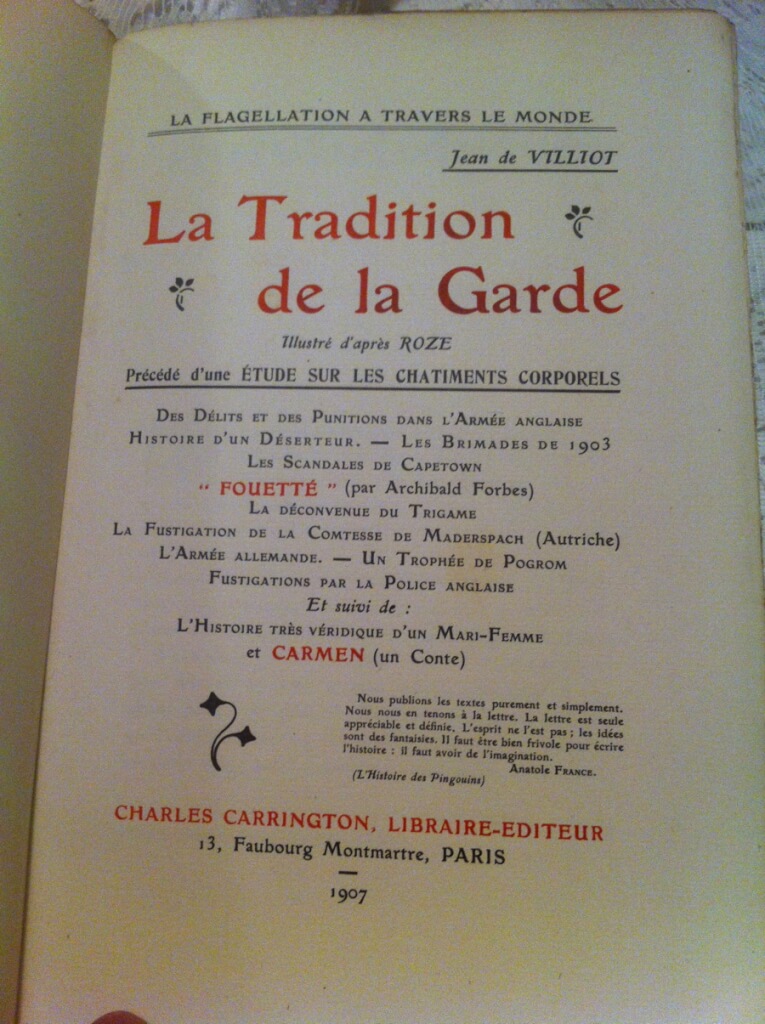
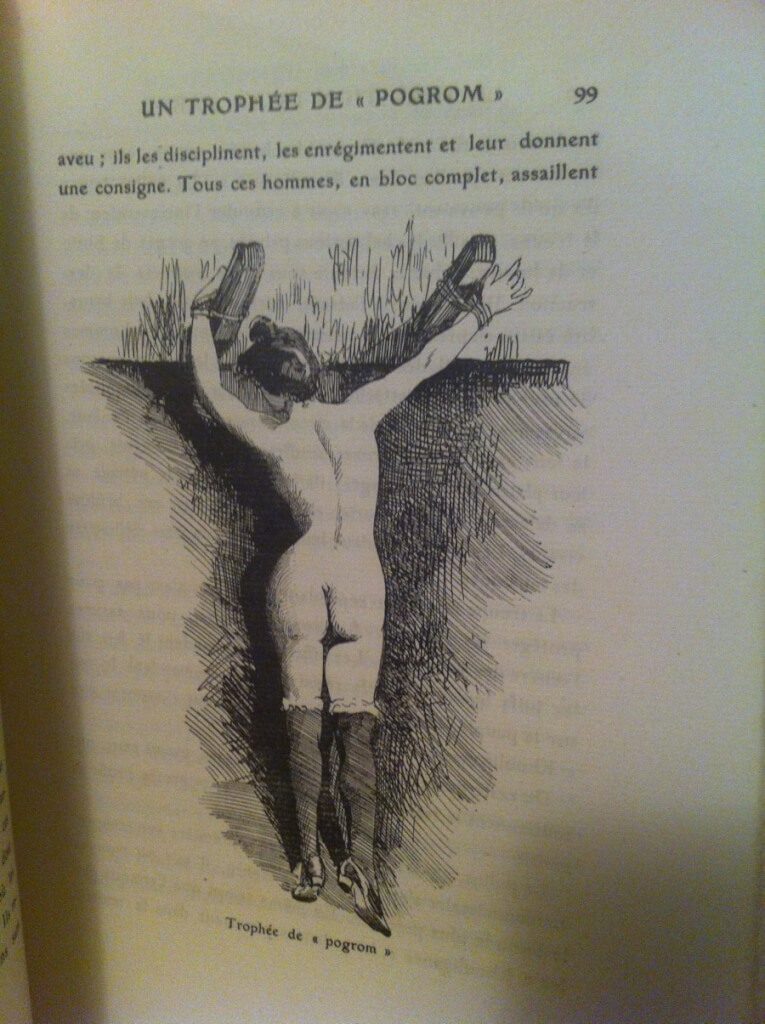 La Tradition de la Garde. Illustré d'après Roze. Précédé d'une étude sur les chatiments corporels. [Tradition of the Guard. Illustrated by Roze. Preceded by a study on corporal punishment.] by Jean de Villiot, [pseud. Georges Grassal de Choffat or Hugues Rebell], illus. Léon Roze (Charles Carrington, Paris, 1907, #244/700) 7.75" x 9.75", 209pp, very good condition for age, some light stains, soft covers and binding good, a rare, numerous illustrations
La Tradition de la Garde. Illustré d'après Roze. Précédé d'une étude sur les chatiments corporels. [Tradition of the Guard. Illustrated by Roze. Preceded by a study on corporal punishment.] by Jean de Villiot, [pseud. Georges Grassal de Choffat or Hugues Rebell], illus. Léon Roze (Charles Carrington, Paris, 1907, #244/700) 7.75" x 9.75", 209pp, very good condition for age, some light stains, soft covers and binding good, a rare, numerous illustrations -
 Le Hazard du coin du feu, dialogue moral [The Opportunities of the Fireside, a moral dialogue], Crébillon fils (a la Haye, 1763, first edition) 6.25" X 3.75", 260pp, full leather, 5 raised bands and gilt titles on spine and decorating pastedowns, gilt edges, good+ condition, minor bumping to corners, armorial bookplate of Francis John Hughes in front pastedown, Mr. Hughes wrote inside "from the collection of Wallace Stevens. Bought at auction this day 10 March 1959 - FJH" The entire book is a dialogue takes place at Célie's house in a small secluded boudoir and the subject is the deceptions and tricks of debauchery, described through stories, dialogues, and tales by the participants. Claude Prosper Jolyot de Crébillon (1707 – 1777), was a French novelist. He was called "Crébillon fils" to distinguish him from his father, a famous tragedian, Prosper Jolyot de Crébillon. He received a Jesuit education at the elite Lycée Louis-le-Grand. Early on he composed various light works, including plays for the Italian Theatre in Paris, and published a short tale called Le Sylphe in 1730. From 1729 to 1739 he participated in a series of dinners called "Le Caveau" (named after the cabaret where they were held) with other artists, including Alexis Piron, Charles Collé, and Charles Duclos. The publication of Tanzaï et Néadarné, histoire japonaise (1734), which contained thinly veiled attacks on the Papal bull Unigenitus, the cardinal de Rohan and others, landed him briefly in the prison at Vincennes. Publication of Le Sopha, conte moral, an erotic political satire, in 1742 forced him into exile from Paris for several months. Wallace Stevens (1879-1955) was an American modernist poet. He won the Pulitzer Prize for Poetry for his Collected Poems in 1955.
Le Hazard du coin du feu, dialogue moral [The Opportunities of the Fireside, a moral dialogue], Crébillon fils (a la Haye, 1763, first edition) 6.25" X 3.75", 260pp, full leather, 5 raised bands and gilt titles on spine and decorating pastedowns, gilt edges, good+ condition, minor bumping to corners, armorial bookplate of Francis John Hughes in front pastedown, Mr. Hughes wrote inside "from the collection of Wallace Stevens. Bought at auction this day 10 March 1959 - FJH" The entire book is a dialogue takes place at Célie's house in a small secluded boudoir and the subject is the deceptions and tricks of debauchery, described through stories, dialogues, and tales by the participants. Claude Prosper Jolyot de Crébillon (1707 – 1777), was a French novelist. He was called "Crébillon fils" to distinguish him from his father, a famous tragedian, Prosper Jolyot de Crébillon. He received a Jesuit education at the elite Lycée Louis-le-Grand. Early on he composed various light works, including plays for the Italian Theatre in Paris, and published a short tale called Le Sylphe in 1730. From 1729 to 1739 he participated in a series of dinners called "Le Caveau" (named after the cabaret where they were held) with other artists, including Alexis Piron, Charles Collé, and Charles Duclos. The publication of Tanzaï et Néadarné, histoire japonaise (1734), which contained thinly veiled attacks on the Papal bull Unigenitus, the cardinal de Rohan and others, landed him briefly in the prison at Vincennes. Publication of Le Sopha, conte moral, an erotic political satire, in 1742 forced him into exile from Paris for several months. Wallace Stevens (1879-1955) was an American modernist poet. He won the Pulitzer Prize for Poetry for his Collected Poems in 1955. -
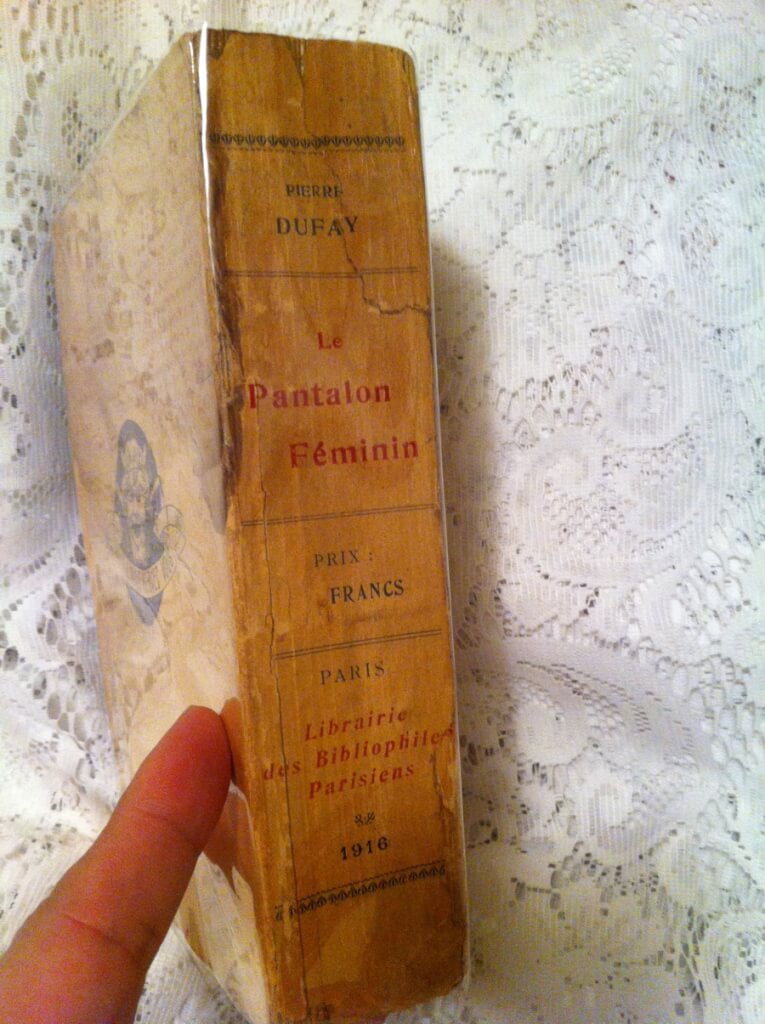
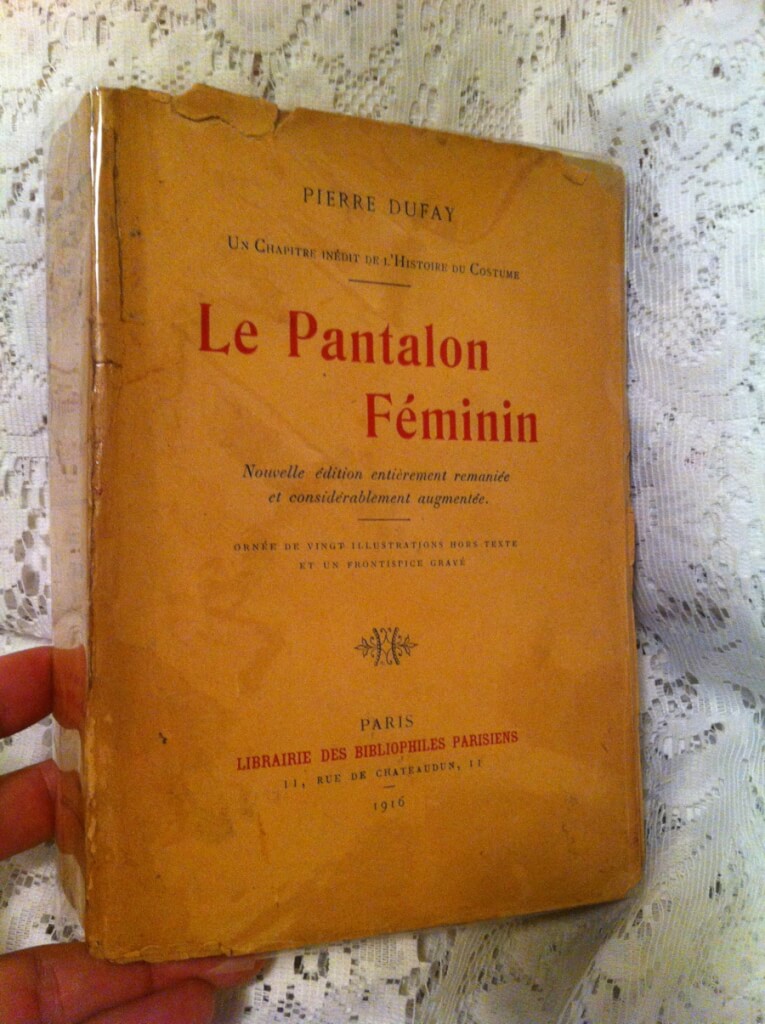 Le Pantalon Féminin (Un chapitre inédit de l'Histoire du Costume) by Pierre Dufay, preface by d'Armand Silvestre (Charles Carrington, Librairie Des Bibliophiles Parisiens, 1916, Paris) 7.75" X 5.75", xv 584pp., original soft wraps protected by a clear archival dust cover. Deckled edges. Some pages remain uncut. Index, table of contents, errata, and 5 pages of ads in the back. Good condition for age, some tears to the edges of cover, stain on the back. A rare find with it's illustrations intact.
Le Pantalon Féminin (Un chapitre inédit de l'Histoire du Costume) by Pierre Dufay, preface by d'Armand Silvestre (Charles Carrington, Librairie Des Bibliophiles Parisiens, 1916, Paris) 7.75" X 5.75", xv 584pp., original soft wraps protected by a clear archival dust cover. Deckled edges. Some pages remain uncut. Index, table of contents, errata, and 5 pages of ads in the back. Good condition for age, some tears to the edges of cover, stain on the back. A rare find with it's illustrations intact. -
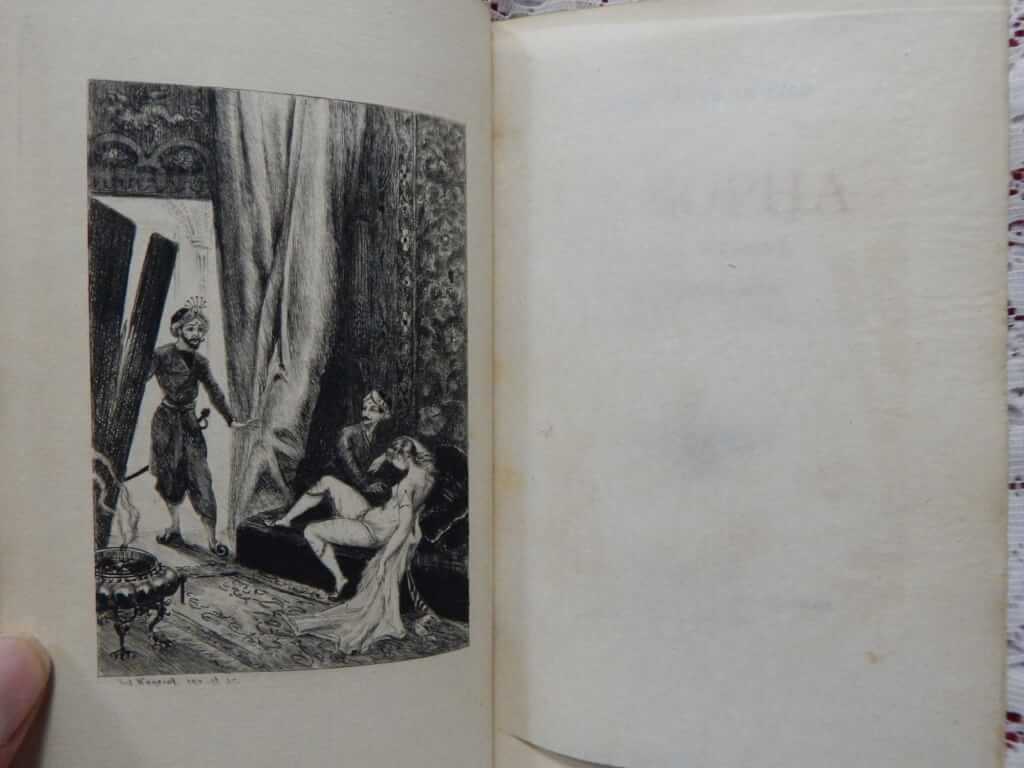
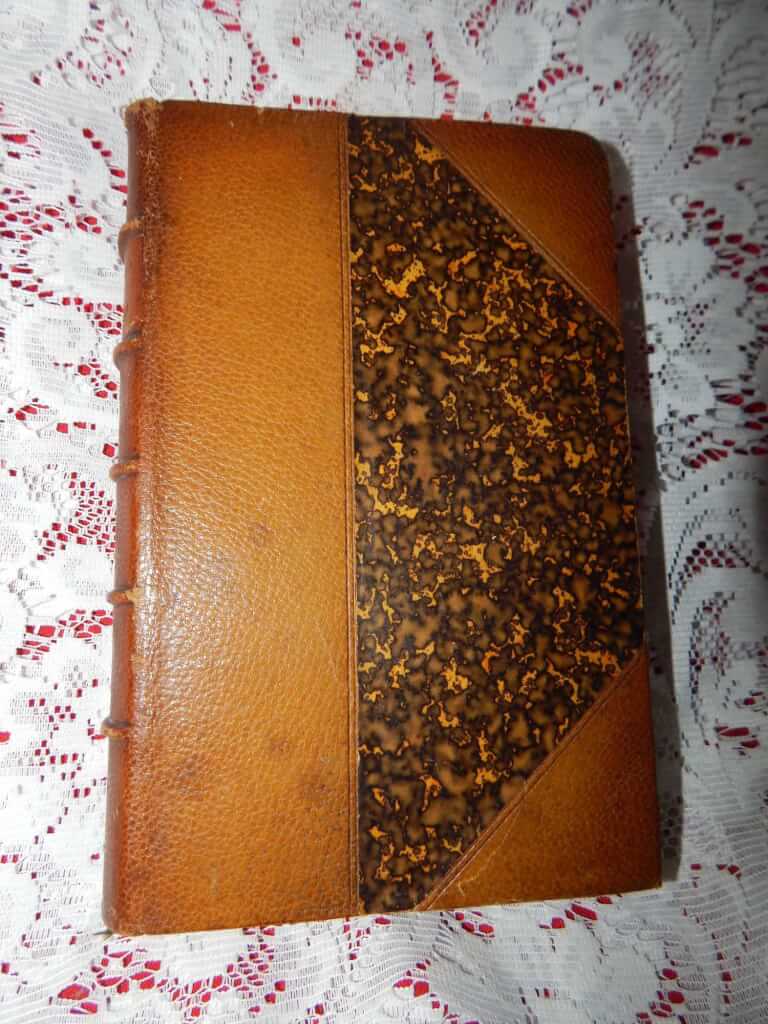 Le Sopha, conte moral by Crébillon fils, illus. Hanriot (Ch. Gilliet, Bruxelles, 1881, #380/550, Imprimerie Clerbaut & Cie.) 5"x7.5", 342pp, 3/4 morocco over marbled boards, 5 raised bands, gilt titles on spine (title worn), marbled endpapers, top-edge gilt, other edges deckled, printed on hand-laid "papier de Hollande", green ribbon intact, frontispiece with tissue guard and 2 small engravings by Hanriot, beautifully bound copy in very good+ condition with delicate engravings Le Sopha, conte moral is a 1742 libertine novel by Claude Prosper Jolyot de Crébillon (Crebillon fils). It was first translated into English in the spring of 1742. The story concerns a young courtier, Amanzéï, whose soul in a previous life was condemned by Brahma to inhabit a series of sofas, and not to be reincarnated in a human body until two virgin lovers had consummated their passion for him. The novel is structured as a frame story in an oriental setting, explicitly evocative of the Arabian Nights, in which Amanzéï recounts the adventures of seven couples, which he witnessed in his sofa form, to the bored sultan Shah Baham (grandson of Shehryār and Scheherazade). The longest episode, that of Zulica, takes up nine chapters; the final episode concerns the teenage Zéïnis et Phéléas. Amanzéï, witnessing their innocent pleasure, is edified and freed through the experience of virtuous love. Many of the characters in the novel are satirical portraits of influential and powerful Parisians of Crébillon’s time; the author takes the opportunity to ridicule hypocrisy in its different forms (worldly respectability, virtue, religious devotion). Claude Prosper Jolyot de Crébillon (1707-1777) was a French novelist. He was called "Crébillon fils" to distinguish him from his father, a famous tragedian, Prosper Jolyot de Crébillon. The publication of Tanzaï et Neadarne, histoire japonaise (1734), which contained thinly veiled attacks on the Papal bull Unigenitus, the cardinal de Rohan and others, landed him briefly in the prison at Vincennes. Although Le Sopha was published anonymously and with a false imprint, Crébillon was discovered to be the author and was exiled to a distance of thirty leagues from Paris on April 7, 1742. He was able to return on July 22, after claiming that the work had been commissioned by Frederick II of Prussia and that it had been published against his will. Jules-Armand Hanriot (1853-1930) was a French painter, engraver and illustrator.
Le Sopha, conte moral by Crébillon fils, illus. Hanriot (Ch. Gilliet, Bruxelles, 1881, #380/550, Imprimerie Clerbaut & Cie.) 5"x7.5", 342pp, 3/4 morocco over marbled boards, 5 raised bands, gilt titles on spine (title worn), marbled endpapers, top-edge gilt, other edges deckled, printed on hand-laid "papier de Hollande", green ribbon intact, frontispiece with tissue guard and 2 small engravings by Hanriot, beautifully bound copy in very good+ condition with delicate engravings Le Sopha, conte moral is a 1742 libertine novel by Claude Prosper Jolyot de Crébillon (Crebillon fils). It was first translated into English in the spring of 1742. The story concerns a young courtier, Amanzéï, whose soul in a previous life was condemned by Brahma to inhabit a series of sofas, and not to be reincarnated in a human body until two virgin lovers had consummated their passion for him. The novel is structured as a frame story in an oriental setting, explicitly evocative of the Arabian Nights, in which Amanzéï recounts the adventures of seven couples, which he witnessed in his sofa form, to the bored sultan Shah Baham (grandson of Shehryār and Scheherazade). The longest episode, that of Zulica, takes up nine chapters; the final episode concerns the teenage Zéïnis et Phéléas. Amanzéï, witnessing their innocent pleasure, is edified and freed through the experience of virtuous love. Many of the characters in the novel are satirical portraits of influential and powerful Parisians of Crébillon’s time; the author takes the opportunity to ridicule hypocrisy in its different forms (worldly respectability, virtue, religious devotion). Claude Prosper Jolyot de Crébillon (1707-1777) was a French novelist. He was called "Crébillon fils" to distinguish him from his father, a famous tragedian, Prosper Jolyot de Crébillon. The publication of Tanzaï et Neadarne, histoire japonaise (1734), which contained thinly veiled attacks on the Papal bull Unigenitus, the cardinal de Rohan and others, landed him briefly in the prison at Vincennes. Although Le Sopha was published anonymously and with a false imprint, Crébillon was discovered to be the author and was exiled to a distance of thirty leagues from Paris on April 7, 1742. He was able to return on July 22, after claiming that the work had been commissioned by Frederick II of Prussia and that it had been published against his will. Jules-Armand Hanriot (1853-1930) was a French painter, engraver and illustrator. -
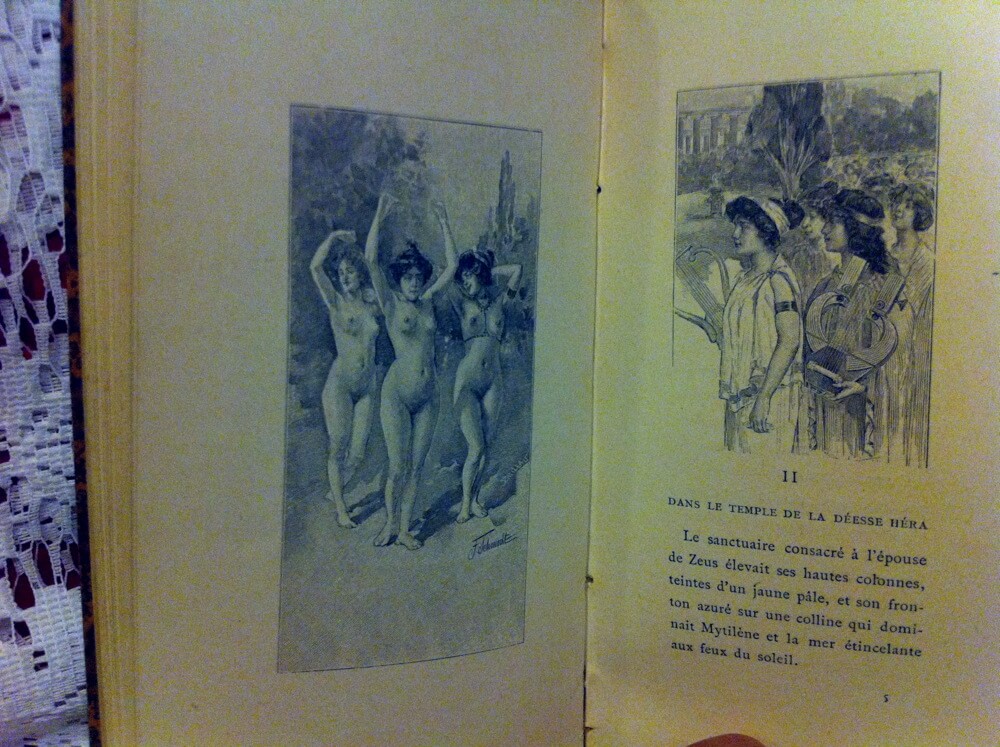
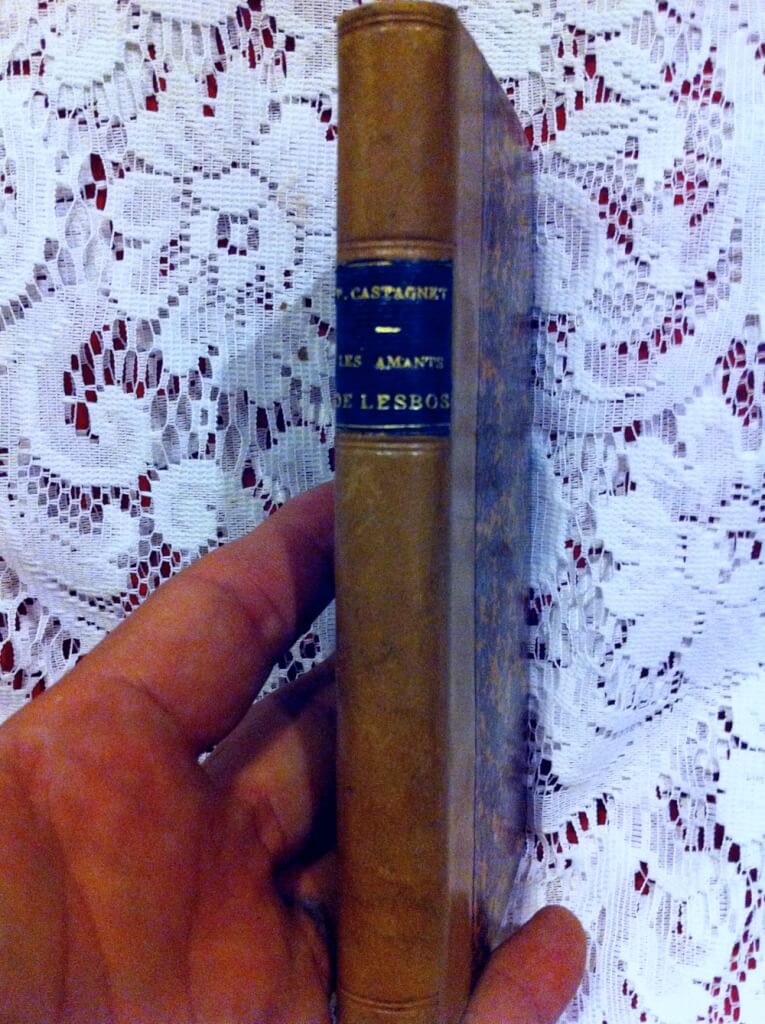 Les Amants de Lesbos, Prosper Castanier, illus. Franz Schmidt (Librairie L. Borel, Paris, 1900) 6" X 3.25", 116pp, Hardbound in 1/4 tan leather over marbled boards, marbled end-papers, glassine protective tissue for title page with gold emblem stamped on it. Very good condition. An imagination of the life and loves of the poet Sappho and her fight against the tyrant of Mytilene. The French author, poet, novelist and historian Prosper Castanier (1865-19??) was born in Saint-Ambroix (Gard). He was the editor-in-chief of the "Progrès du midi". He had made a specialty of novels set in antiquity. (Particularly after the success of Aphrodite by Pierre Louès, published in 1896)
Les Amants de Lesbos, Prosper Castanier, illus. Franz Schmidt (Librairie L. Borel, Paris, 1900) 6" X 3.25", 116pp, Hardbound in 1/4 tan leather over marbled boards, marbled end-papers, glassine protective tissue for title page with gold emblem stamped on it. Very good condition. An imagination of the life and loves of the poet Sappho and her fight against the tyrant of Mytilene. The French author, poet, novelist and historian Prosper Castanier (1865-19??) was born in Saint-Ambroix (Gard). He was the editor-in-chief of the "Progrès du midi". He had made a specialty of novels set in antiquity. (Particularly after the success of Aphrodite by Pierre Louès, published in 1896) -
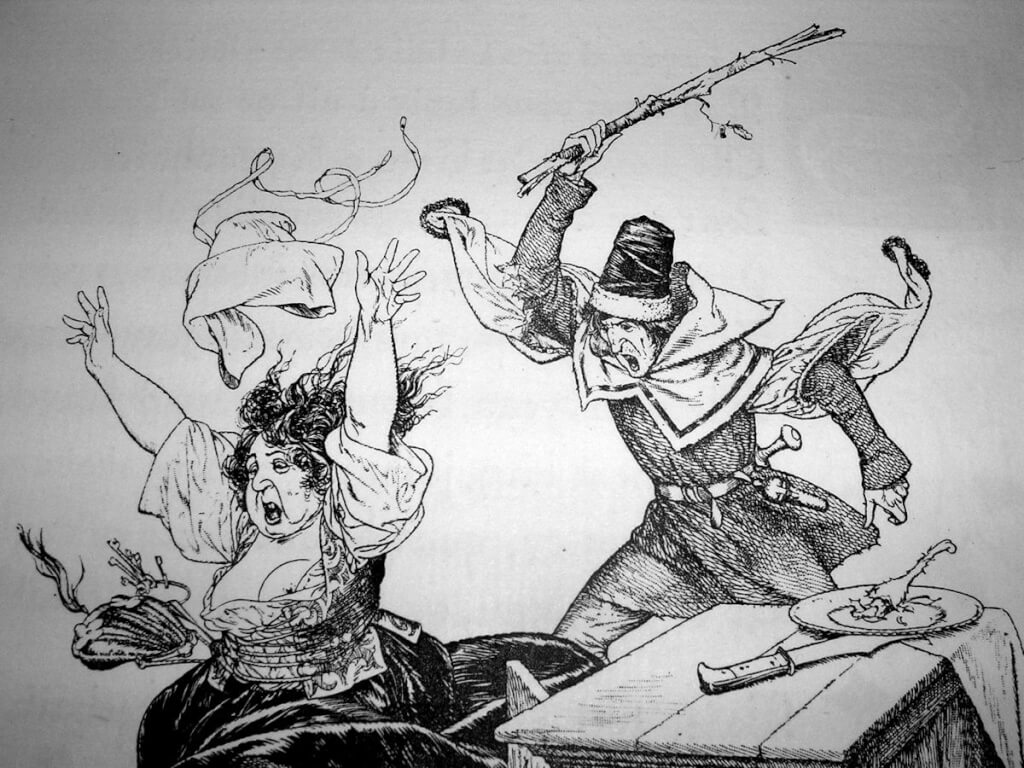
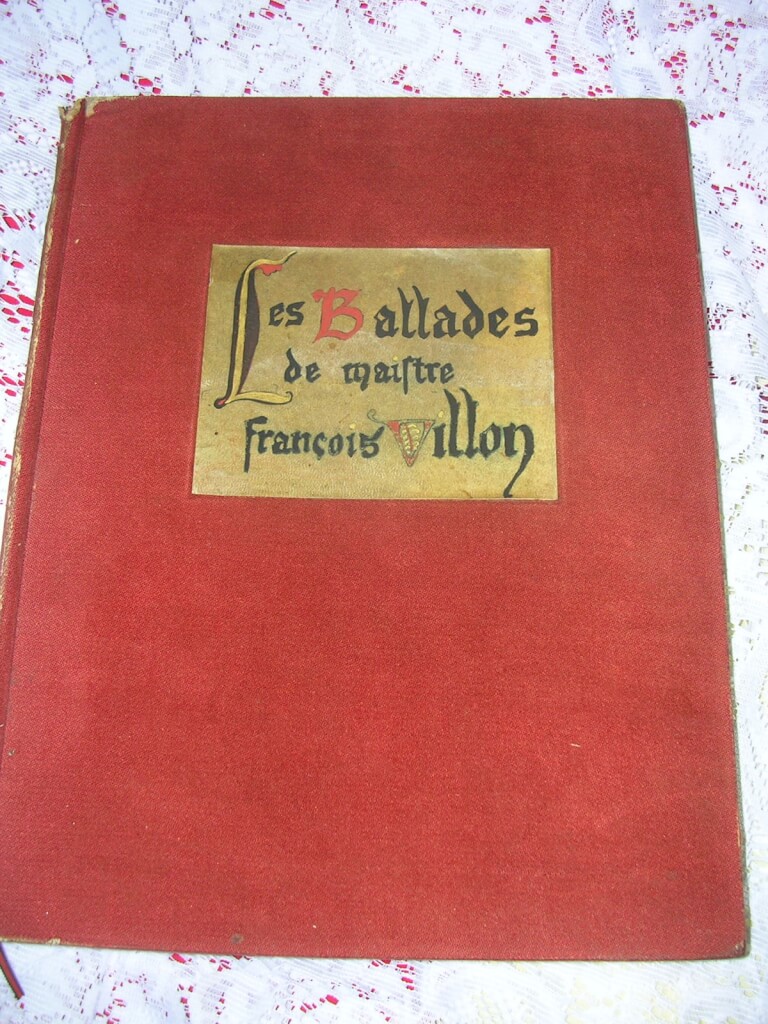 Les Ballades de Maistre Francois Villon, Francois Villon, illus. Chéri Hérouard, caligraphy ["escrites"] by Raymond de Rigné (chez Cres., Paris, 1919) 11.75" X 9.25", 169pp, rebound in red cloth boards with paper labels, decorated end papers. Original soft wraps intact. #450/550 signed by Hérouard. 31 full page drawings by Hérouard plus 31 small vignette type illustrations with a few "signed" by him. Beautifully printed on heavy deckle edged paper. good condition, wear to top and bottom of spine. ribbon intact. François Villon (c. 1431_1464) was a French poet. Most of what is known about Villon has been gathered from legal records and gleaned from his own writings. He was a thief, killer, barroom brawler, and vagabond. He is perhaps best known for his Testaments and his Ballades. He was the most famous realist poet of the Middle Ages. Chéri Hérouard (1881 - 1961) was a French illustrator who was most famously known for his forty-five-year work for French society magazine, La Vie Parisienne. Under the pseudonym of Herric, he also created erotic and sadomasochistic illustrations for various books including the Kama Sutra. This work was originally published with soft wraps. This copy has been beautifully rebound with it's original wraps intact.
Les Ballades de Maistre Francois Villon, Francois Villon, illus. Chéri Hérouard, caligraphy ["escrites"] by Raymond de Rigné (chez Cres., Paris, 1919) 11.75" X 9.25", 169pp, rebound in red cloth boards with paper labels, decorated end papers. Original soft wraps intact. #450/550 signed by Hérouard. 31 full page drawings by Hérouard plus 31 small vignette type illustrations with a few "signed" by him. Beautifully printed on heavy deckle edged paper. good condition, wear to top and bottom of spine. ribbon intact. François Villon (c. 1431_1464) was a French poet. Most of what is known about Villon has been gathered from legal records and gleaned from his own writings. He was a thief, killer, barroom brawler, and vagabond. He is perhaps best known for his Testaments and his Ballades. He was the most famous realist poet of the Middle Ages. Chéri Hérouard (1881 - 1961) was a French illustrator who was most famously known for his forty-five-year work for French society magazine, La Vie Parisienne. Under the pseudonym of Herric, he also created erotic and sadomasochistic illustrations for various books including the Kama Sutra. This work was originally published with soft wraps. This copy has been beautifully rebound with it's original wraps intact. -

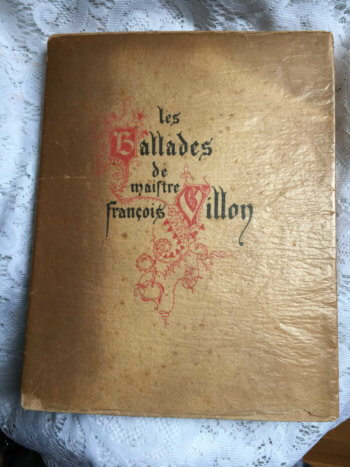 Les Ballades de Maistre Francois Villon, Francois Villon, illus. Chéri Hérouard, caligraphy ["escrites"] by Raymond de Rigné (chez Cres., Paris, 1919, #188/550 signed by Hérouard) 11.75" X 9.25", 169pp, original french wraps with glassine cover, 31 full page drawings by Hérouard plus 31 small vignette type illustrations. Beautifully printed on heavy deckle edged paper. good condition, all original, minor rubbing, slight foxing on outer pages, inner pages clean, rips in glassine cover at top and bottom of spine. François Villon (c. 1431_1464) was a French poet. Most of what is known about Villon has been gathered from legal records and gleaned from his own writings. He was a thief, killer, barroom brawler, and vagabond. He is perhaps best known for his Testaments and his Ballades. He was the most famous realist poet of the Middle Ages. Chéri Hérouard (1881 - 1961) was a French illustrator who was most famously known for his forty-five-year work for French society magazine, La Vie Parisienne. Under the pseudonym of Herric, he also created erotic and sadomasochistic illustrations for various books including the Kama Sutra.
Les Ballades de Maistre Francois Villon, Francois Villon, illus. Chéri Hérouard, caligraphy ["escrites"] by Raymond de Rigné (chez Cres., Paris, 1919, #188/550 signed by Hérouard) 11.75" X 9.25", 169pp, original french wraps with glassine cover, 31 full page drawings by Hérouard plus 31 small vignette type illustrations. Beautifully printed on heavy deckle edged paper. good condition, all original, minor rubbing, slight foxing on outer pages, inner pages clean, rips in glassine cover at top and bottom of spine. François Villon (c. 1431_1464) was a French poet. Most of what is known about Villon has been gathered from legal records and gleaned from his own writings. He was a thief, killer, barroom brawler, and vagabond. He is perhaps best known for his Testaments and his Ballades. He was the most famous realist poet of the Middle Ages. Chéri Hérouard (1881 - 1961) was a French illustrator who was most famously known for his forty-five-year work for French society magazine, La Vie Parisienne. Under the pseudonym of Herric, he also created erotic and sadomasochistic illustrations for various books including the Kama Sutra. -
 Les Confidences de Cherubin, G. Donville, illus. Herric [pseud. Chéri Herouard] np, nd, [a 2000 reprint of the 1939 edition] 8.5" x 6", 229pp, paperback, like new condition A classic spanking novel. The narrator, Pierre de Thiverny, tells us of his sexual exploits; from his introduction to the voyeuristic pleasures (his parents) and the discovery of the female buttocks (the young Monica on her swing) to various sexual practices including spanking with several companions. This nicely printed edition also has reproductions of the original Chéri Herouard (signed Herric) illustrations. Chéri Hérouard (1881 - 1961) was a French illustrator who was most famously known for his forty-five-year work for French society magazine, La Vie Parisienne. Under the pseudonym of Herric, he also created erotic and sadomasochistic illustrations for various books including the Kama Sutra.
Les Confidences de Cherubin, G. Donville, illus. Herric [pseud. Chéri Herouard] np, nd, [a 2000 reprint of the 1939 edition] 8.5" x 6", 229pp, paperback, like new condition A classic spanking novel. The narrator, Pierre de Thiverny, tells us of his sexual exploits; from his introduction to the voyeuristic pleasures (his parents) and the discovery of the female buttocks (the young Monica on her swing) to various sexual practices including spanking with several companions. This nicely printed edition also has reproductions of the original Chéri Herouard (signed Herric) illustrations. Chéri Hérouard (1881 - 1961) was a French illustrator who was most famously known for his forty-five-year work for French society magazine, La Vie Parisienne. Under the pseudonym of Herric, he also created erotic and sadomasochistic illustrations for various books including the Kama Sutra. -

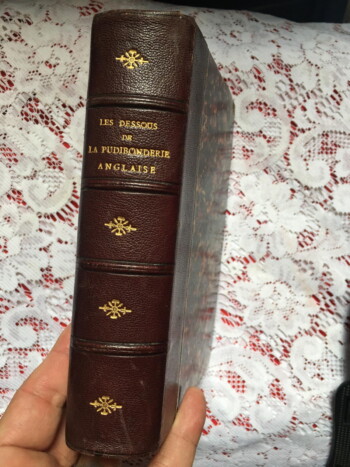 Les dessous de la pudibonderie anglaise expliqués dans les divorces anglais, ou procès en adultère jugés par le banc du Roi et la Cour Ecclésiastique d'Angleterre [trans. The Basics of English Prudishness Explained in English Divorces, or Adultery Trial Judged by the King's Bench and the Ecclesiastical Court of England], anonymous [most like Carrington himself as editor/compiler], illustrations Jacques Wely (Charles Carrington, Paris, 1898, first edition) 7.5"x5", 2 volumes in one, xxiv-108, xxx-287-xii, quarter morocco over marbled boards, 4 raised bands, gilt titles and decoration on spine, marbled endpapers, great condition, previous owners name on title page, some bumping to corners. According to the British Library this is a compilation of entries from "Trials for Adultry" [Trials for Adultery: or, the History of Divorces. Being Select Trials at Doctors Commons, for Adultery, Cruelty, Fornication, Impotence, &c. From the Year 1760, to the present Time. Including the whole of the Evidence on each Cause. Together with The Letters, &c. that have been intercepted between the amorous Parties… Taken in Short-Hand , by a Civilian. London: Printed for S. Bladon, 1779-1780] which, as the full title suggests, is considered one of the Earliest of "The Genre of Pornographic Trial Reports". Also present are excerpts from some English plays. According to Yale, this compillation also "Contains case histories from: Crim. con. biography attributed to Francis Plowden." London, 1798. Criminal conversation, commonly known as crim. con., is a tort arising from adultery, abolished in almost all jurisdictions. (Conversation is an old expression for sexual intercourse that is obsolete except as part of this term.) As far as we can tell, this is a book compiled and edited by Carrington. Carrington himself was an Englishman, a Londoner who was married to a woman from France. He published this book a few years after the couple left London and moved to Paris, presumably so he would have more freedom to publish books that London would have no doubt considered pornography. This book is a case study of the prudishness of the English and it uses salacious material taken from various sources listed above to prove the point.
Les dessous de la pudibonderie anglaise expliqués dans les divorces anglais, ou procès en adultère jugés par le banc du Roi et la Cour Ecclésiastique d'Angleterre [trans. The Basics of English Prudishness Explained in English Divorces, or Adultery Trial Judged by the King's Bench and the Ecclesiastical Court of England], anonymous [most like Carrington himself as editor/compiler], illustrations Jacques Wely (Charles Carrington, Paris, 1898, first edition) 7.5"x5", 2 volumes in one, xxiv-108, xxx-287-xii, quarter morocco over marbled boards, 4 raised bands, gilt titles and decoration on spine, marbled endpapers, great condition, previous owners name on title page, some bumping to corners. According to the British Library this is a compilation of entries from "Trials for Adultry" [Trials for Adultery: or, the History of Divorces. Being Select Trials at Doctors Commons, for Adultery, Cruelty, Fornication, Impotence, &c. From the Year 1760, to the present Time. Including the whole of the Evidence on each Cause. Together with The Letters, &c. that have been intercepted between the amorous Parties… Taken in Short-Hand , by a Civilian. London: Printed for S. Bladon, 1779-1780] which, as the full title suggests, is considered one of the Earliest of "The Genre of Pornographic Trial Reports". Also present are excerpts from some English plays. According to Yale, this compillation also "Contains case histories from: Crim. con. biography attributed to Francis Plowden." London, 1798. Criminal conversation, commonly known as crim. con., is a tort arising from adultery, abolished in almost all jurisdictions. (Conversation is an old expression for sexual intercourse that is obsolete except as part of this term.) As far as we can tell, this is a book compiled and edited by Carrington. Carrington himself was an Englishman, a Londoner who was married to a woman from France. He published this book a few years after the couple left London and moved to Paris, presumably so he would have more freedom to publish books that London would have no doubt considered pornography. This book is a case study of the prudishness of the English and it uses salacious material taken from various sources listed above to prove the point. -

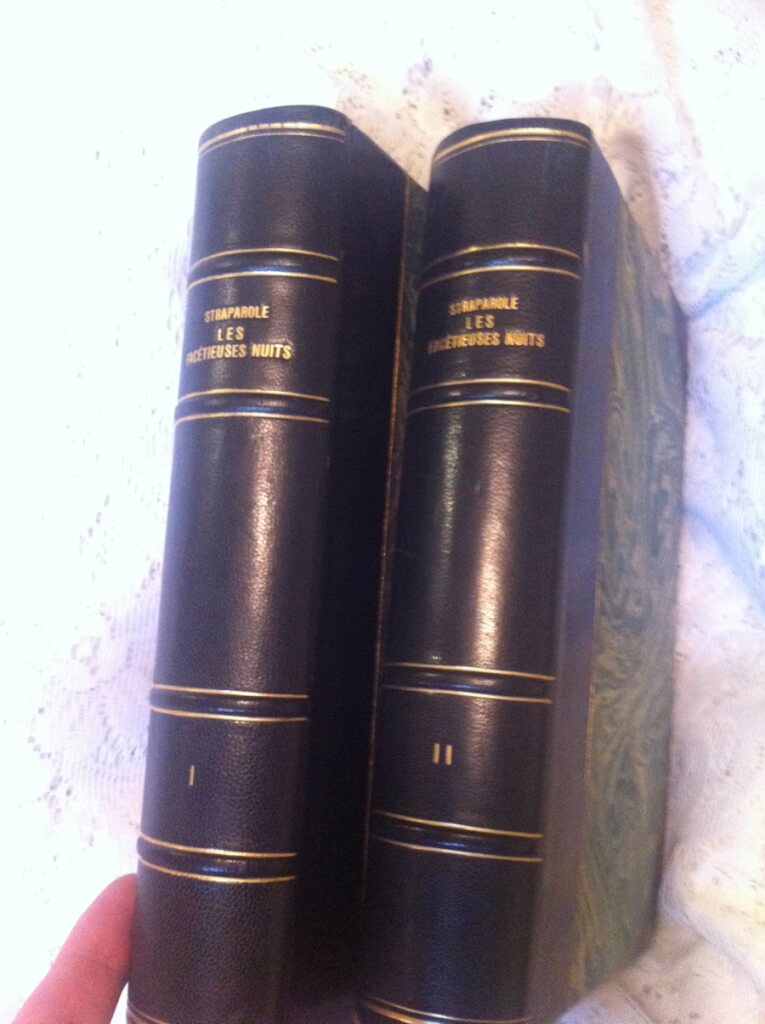 Les Facetieuses Nuits de Straparole, Giovanni Francesco Straparola, trans. Jean Louveau, illus. L_on Lebègue. Preface by Jules de Marthold (Charles Carrington, Paris, 1907 #213/800) 9.5" x 6.25", 2 vol. lxxxvii+312pp. vi+371pp. 1/2 leather over marbled boards, 4 raised bands on spine gilt lettering and decorations, marbled endpapers, gilted top-edge, others deckled, many color illustrations protected by tissues with descrptions printed on them, text decorations throughout, near fine condition, book binder tag for "Hans Uttinger, Buchbinderei, Einrahmungsgeschäft, Luzern" The Facetious Nights of Straparola (1550-1555; Italian: Le piacevoli notti), also known as The Nights of Straparola, is a two-volume collection of 75 stories by Italian author and fairy-tale collector Giovanni Francesco Straparola(c.1480-c.1557). Modeled after Bocaccio's Decameron, it has participants of a 13-night party in the island of Murano, near Venice, tell each other stories that vary from bawdy to fantastic. It contains the first known written versions of many fairy tales. It would influence later fairy-tale authors like Charles Perrault and Jacob and Wilhelm Grimm. This book is a very rare and famous (and famously illustrated) edition. A beautiful copy of a beautifully made book.
Les Facetieuses Nuits de Straparole, Giovanni Francesco Straparola, trans. Jean Louveau, illus. L_on Lebègue. Preface by Jules de Marthold (Charles Carrington, Paris, 1907 #213/800) 9.5" x 6.25", 2 vol. lxxxvii+312pp. vi+371pp. 1/2 leather over marbled boards, 4 raised bands on spine gilt lettering and decorations, marbled endpapers, gilted top-edge, others deckled, many color illustrations protected by tissues with descrptions printed on them, text decorations throughout, near fine condition, book binder tag for "Hans Uttinger, Buchbinderei, Einrahmungsgeschäft, Luzern" The Facetious Nights of Straparola (1550-1555; Italian: Le piacevoli notti), also known as The Nights of Straparola, is a two-volume collection of 75 stories by Italian author and fairy-tale collector Giovanni Francesco Straparola(c.1480-c.1557). Modeled after Bocaccio's Decameron, it has participants of a 13-night party in the island of Murano, near Venice, tell each other stories that vary from bawdy to fantastic. It contains the first known written versions of many fairy tales. It would influence later fairy-tale authors like Charles Perrault and Jacob and Wilhelm Grimm. This book is a very rare and famous (and famously illustrated) edition. A beautiful copy of a beautifully made book. -
 Les Idylles, Théocrite, J. A. Gullet trans., Méaulle illus. (A. Quantin, Imprimeur-Éditeur, Paris 1884) 5.75″ X 4", 192pp, three-quarter leather over marbled boards, gilt titles and decorations on spine, boards rubbed quite a bit, binding good, top-edge gilt, others deckled, ex-libris of Dr. phil. Rudolf Ludwig designed by Franz von Bayros (voluptuous naked woman surrounded by books with men in shackles enthusiastically bringing her more. A child with a magnifying glass astride a penis decorated with a world globe/map.) Theocritus (c 300 BC- c 260 BC) was a Greek poet from Sicily and the creator of Ancient Greek pastoral poetry. Unlike Homer, Theocritus did not engage in heroes and warfare. His idylls are limited to a small intimate world and describe scenes from everyday life.
Les Idylles, Théocrite, J. A. Gullet trans., Méaulle illus. (A. Quantin, Imprimeur-Éditeur, Paris 1884) 5.75″ X 4", 192pp, three-quarter leather over marbled boards, gilt titles and decorations on spine, boards rubbed quite a bit, binding good, top-edge gilt, others deckled, ex-libris of Dr. phil. Rudolf Ludwig designed by Franz von Bayros (voluptuous naked woman surrounded by books with men in shackles enthusiastically bringing her more. A child with a magnifying glass astride a penis decorated with a world globe/map.) Theocritus (c 300 BC- c 260 BC) was a Greek poet from Sicily and the creator of Ancient Greek pastoral poetry. Unlike Homer, Theocritus did not engage in heroes and warfare. His idylls are limited to a small intimate world and describe scenes from everyday life. -

 Les infortunes de la vertu, Marquis de Sade, introduction by Jean Paulhan (les editions du point du jour, 1946, "incidences" collection, #908/2000) 5.75" x 7.75", xlii+242pp, softcover "french wraps", good unread condition, many pages remain uncut. This edition appears to represent the original version of Justine that Sade wrote while imprisoned at the Bastille in 1787 (see below). The story is about Justine from age 12 to 26 and recounts all of her attempts to be virtuous no matter what life throws at her. She is constantly presented with sexual lessons hidden under a virtuous mask. She seeks refuge in a monastery but is forced to become a sex slave of the monks. After she helps a gentleman who is robbed in a field, he takes her back to his chateau on the pretext to have her help care for his wife. He confines her in a cave where she is subjected to more punishment. When she goes to a judge to beg for mercy in her case as an arsonist, she then finds herself openly humiliated in court, unable to defend herself. The moral(especially when juxtaposed with the "companion story", Juliette) seems to be that one should not resist a bit of vice if it is for the common good. The more Justine tries to resist temptation and be virtuous the further she was plunged into a life of vice and torture, while Juliette (her sister) submitted to a brief period of debauchery and vice and eventually lived a comfortable, happy existence. The Marquis de Sade wrote the first version of Justine (Les infortunes de la vertu, "The Misfortunes of Virtue") while imprisoned at the Bastille in 1787. In 1791 an expanded and more explicit version became Sade's first published work. In 1797, an even more detailed version was published along with a story of Juliette (Justine's sister) that comprised of 10 volumes and nearly 4000 pages. This final version, "La Nouvelle Justine", departed from the first-person narrative of the previous two versions, and included around 100 engravings. Most editions are taken from that 1797 Holland edition. Napoleon Bonaparte ordered the arrest of the anonymous author of Justine and Juliette, and as a result Sade was incarcerated for the last 13 years of his life. Napoleon called the work "the most abominable book ever engendered by the most depraved imagination". English titles: Justine, or the Misfortune(s) of Virtue; The Misfortunes of Virtue; Justine, or Good Conduct Well Chastised; Justine or Good Conduct Will Be Chastised
Les infortunes de la vertu, Marquis de Sade, introduction by Jean Paulhan (les editions du point du jour, 1946, "incidences" collection, #908/2000) 5.75" x 7.75", xlii+242pp, softcover "french wraps", good unread condition, many pages remain uncut. This edition appears to represent the original version of Justine that Sade wrote while imprisoned at the Bastille in 1787 (see below). The story is about Justine from age 12 to 26 and recounts all of her attempts to be virtuous no matter what life throws at her. She is constantly presented with sexual lessons hidden under a virtuous mask. She seeks refuge in a monastery but is forced to become a sex slave of the monks. After she helps a gentleman who is robbed in a field, he takes her back to his chateau on the pretext to have her help care for his wife. He confines her in a cave where she is subjected to more punishment. When she goes to a judge to beg for mercy in her case as an arsonist, she then finds herself openly humiliated in court, unable to defend herself. The moral(especially when juxtaposed with the "companion story", Juliette) seems to be that one should not resist a bit of vice if it is for the common good. The more Justine tries to resist temptation and be virtuous the further she was plunged into a life of vice and torture, while Juliette (her sister) submitted to a brief period of debauchery and vice and eventually lived a comfortable, happy existence. The Marquis de Sade wrote the first version of Justine (Les infortunes de la vertu, "The Misfortunes of Virtue") while imprisoned at the Bastille in 1787. In 1791 an expanded and more explicit version became Sade's first published work. In 1797, an even more detailed version was published along with a story of Juliette (Justine's sister) that comprised of 10 volumes and nearly 4000 pages. This final version, "La Nouvelle Justine", departed from the first-person narrative of the previous two versions, and included around 100 engravings. Most editions are taken from that 1797 Holland edition. Napoleon Bonaparte ordered the arrest of the anonymous author of Justine and Juliette, and as a result Sade was incarcerated for the last 13 years of his life. Napoleon called the work "the most abominable book ever engendered by the most depraved imagination". English titles: Justine, or the Misfortune(s) of Virtue; The Misfortunes of Virtue; Justine, or Good Conduct Well Chastised; Justine or Good Conduct Will Be Chastised -

 Les métamorphoses ou l'asne d'or de Luce Apulée philosophe platonique, Lucius Apuleius Madaurensis (124-170 AD), trans. Jules De Marthold, illust. [21 etchings] Martin van Maele (Charles Carrington, Librairie-Éditeur, 1905, Paris, #88/750) 9.25" X 6.25", xlviii+328pp., original soft wraps protected by glassine wraps, Chapter pieces in orange and black, tail pieces in black, large, decorative first letter of each chapter, frontispiece + 21 full-page b/w engravings with tissue guards and numerous in-text illustrations by Martin van Maele, very good condition for age. The Metamorphoses of Apuleius, which St. Augustine referred to as "The Golden Ass", is the only Ancient Roman novel in Latin to survive in its entirety. The plot Lucius and his curiosity and insatiable desire to see and practice magic. While trying to perform a spell to transform into a bird, he is accidentally transformed into an ass. This leads to a long journey, literal and metaphorical, filled with in-set tales. He finally finds salvation through the intervention of the goddess Isis, whose cult he joins. The date of the original work is uncertain. Scholars are not sure if he wrote it in his youth or at the end of his life. He adapted the story from a Greek story written by Lucius of Patrae, however his original Greek text has long been lost. Maurice François Alfred Martin van Miële (1863-5 - 1926), better known by his pseudonym Martin van Maële, was a French illustrator of early 20th century literature. Though he gained notoriety with his illustration for H. G. Wells in Les Premiers Hommes dans la Lune, and he worked as an illustrator for the Félix Juven's French translations of the Sherlock Holmes series, he is now most widely renowned and mostly remembered for his erotic illustrations. This is a beautiful and rare book in it's original paper wraps.
Les métamorphoses ou l'asne d'or de Luce Apulée philosophe platonique, Lucius Apuleius Madaurensis (124-170 AD), trans. Jules De Marthold, illust. [21 etchings] Martin van Maele (Charles Carrington, Librairie-Éditeur, 1905, Paris, #88/750) 9.25" X 6.25", xlviii+328pp., original soft wraps protected by glassine wraps, Chapter pieces in orange and black, tail pieces in black, large, decorative first letter of each chapter, frontispiece + 21 full-page b/w engravings with tissue guards and numerous in-text illustrations by Martin van Maele, very good condition for age. The Metamorphoses of Apuleius, which St. Augustine referred to as "The Golden Ass", is the only Ancient Roman novel in Latin to survive in its entirety. The plot Lucius and his curiosity and insatiable desire to see and practice magic. While trying to perform a spell to transform into a bird, he is accidentally transformed into an ass. This leads to a long journey, literal and metaphorical, filled with in-set tales. He finally finds salvation through the intervention of the goddess Isis, whose cult he joins. The date of the original work is uncertain. Scholars are not sure if he wrote it in his youth or at the end of his life. He adapted the story from a Greek story written by Lucius of Patrae, however his original Greek text has long been lost. Maurice François Alfred Martin van Miële (1863-5 - 1926), better known by his pseudonym Martin van Maële, was a French illustrator of early 20th century literature. Though he gained notoriety with his illustration for H. G. Wells in Les Premiers Hommes dans la Lune, and he worked as an illustrator for the Félix Juven's French translations of the Sherlock Holmes series, he is now most widely renowned and mostly remembered for his erotic illustrations. This is a beautiful and rare book in it's original paper wraps. -
 Les métamorphoses ou l’asne d’or de Luce Apulée philosophe platonique, Lucius Apuleius Madaurensis (124-170 AD), trans. Jules De Montlyald, preface by Jules de Marthold, illust. [21 etchings] Martin van Maele (Charles Carrington, Librairie-Éditeur, 1905, Paris, #115/750) 6.25" X 9.25", xlviii+328pp, beautifully bound in three-quarter morocco over marbled boards with gilt titles and decorations on the spine, top-edge gilt, others uncut, fine condition overall, 21 full-page tipped-in B/W engravings with tissue guards and numerous in-text illustrations by Martin van Meale, red ribbon intact. The Metamorphoses of Apuleius, which St. Augustine referred to as “The Golden Ass”, is the only Ancient Roman novel in Latin to survive in its entirety. The plot Lucius and his curiosity and insatiable desire to see and practice magic. While trying to perform a spell to transform into a bird, he is accidentally transformed into an ass. This leads to a long journey, literal and metaphorical, filled with in-set tales. He finally finds salvation through the intervention of the goddess Isis, whose cult he joins. The date of the original work is uncertain. Scholars are not sure if he wrote it in his youth or at the end of his life. He adapted the story from a Greek story written by Lucius of Patrae, however his original Greek text has long been lost. Maurice François Alfred Martin van Miële (1863-5 – 1926), better known by his pseudonym Martin van Maële, was a French illustrator of early 20th century literature. Though he gained notoriety with his illustration for H. G. Wells in Les Premiers Hommes dans la Lune, and he worked as an illustrator for the Félix Juven’s French translations of the Sherlock Holmes series, he is now most widely renowned and mostly remembered for his erotic illustrations.
Les métamorphoses ou l’asne d’or de Luce Apulée philosophe platonique, Lucius Apuleius Madaurensis (124-170 AD), trans. Jules De Montlyald, preface by Jules de Marthold, illust. [21 etchings] Martin van Maele (Charles Carrington, Librairie-Éditeur, 1905, Paris, #115/750) 6.25" X 9.25", xlviii+328pp, beautifully bound in three-quarter morocco over marbled boards with gilt titles and decorations on the spine, top-edge gilt, others uncut, fine condition overall, 21 full-page tipped-in B/W engravings with tissue guards and numerous in-text illustrations by Martin van Meale, red ribbon intact. The Metamorphoses of Apuleius, which St. Augustine referred to as “The Golden Ass”, is the only Ancient Roman novel in Latin to survive in its entirety. The plot Lucius and his curiosity and insatiable desire to see and practice magic. While trying to perform a spell to transform into a bird, he is accidentally transformed into an ass. This leads to a long journey, literal and metaphorical, filled with in-set tales. He finally finds salvation through the intervention of the goddess Isis, whose cult he joins. The date of the original work is uncertain. Scholars are not sure if he wrote it in his youth or at the end of his life. He adapted the story from a Greek story written by Lucius of Patrae, however his original Greek text has long been lost. Maurice François Alfred Martin van Miële (1863-5 – 1926), better known by his pseudonym Martin van Maële, was a French illustrator of early 20th century literature. Though he gained notoriety with his illustration for H. G. Wells in Les Premiers Hommes dans la Lune, and he worked as an illustrator for the Félix Juven’s French translations of the Sherlock Holmes series, he is now most widely renowned and mostly remembered for his erotic illustrations.

